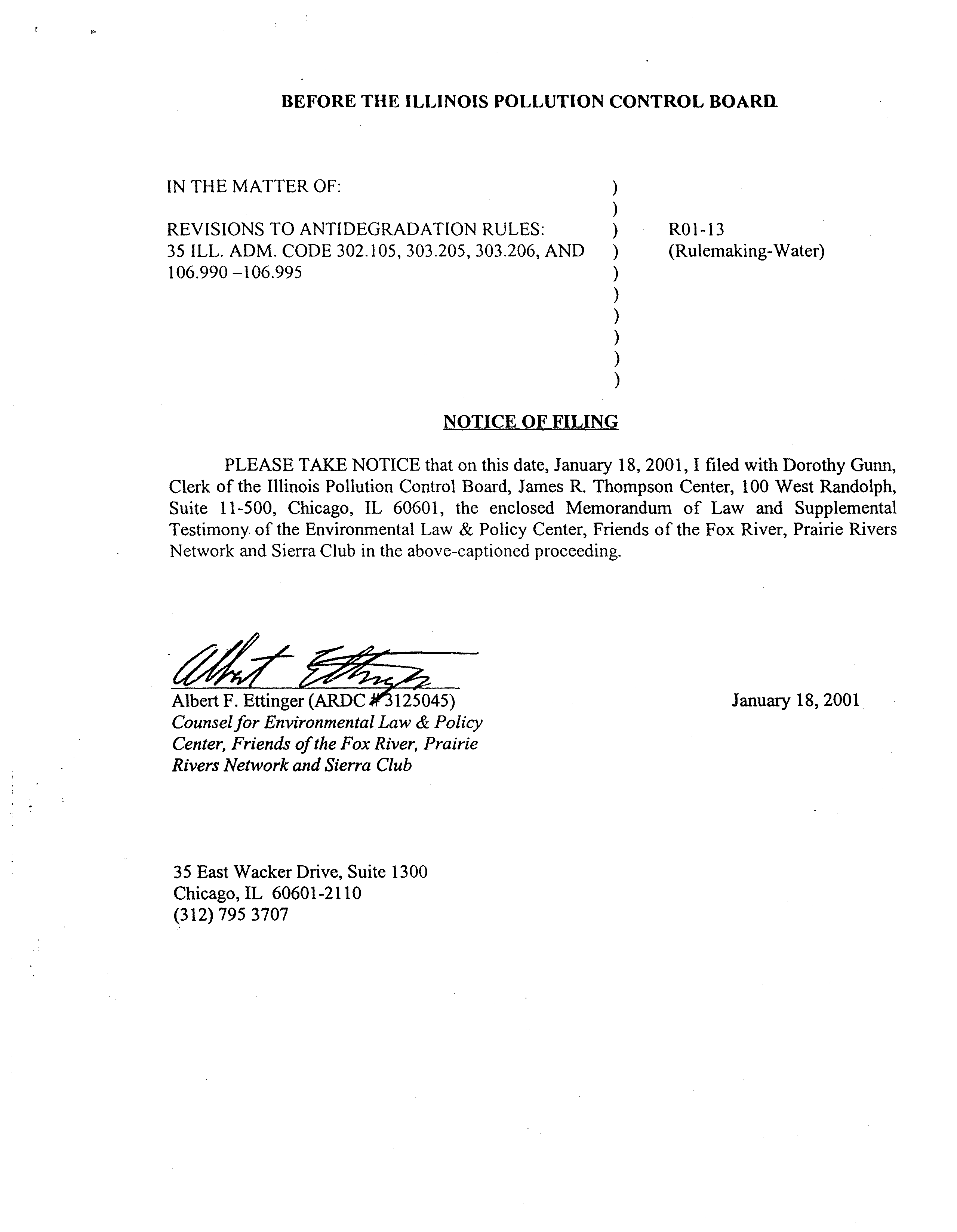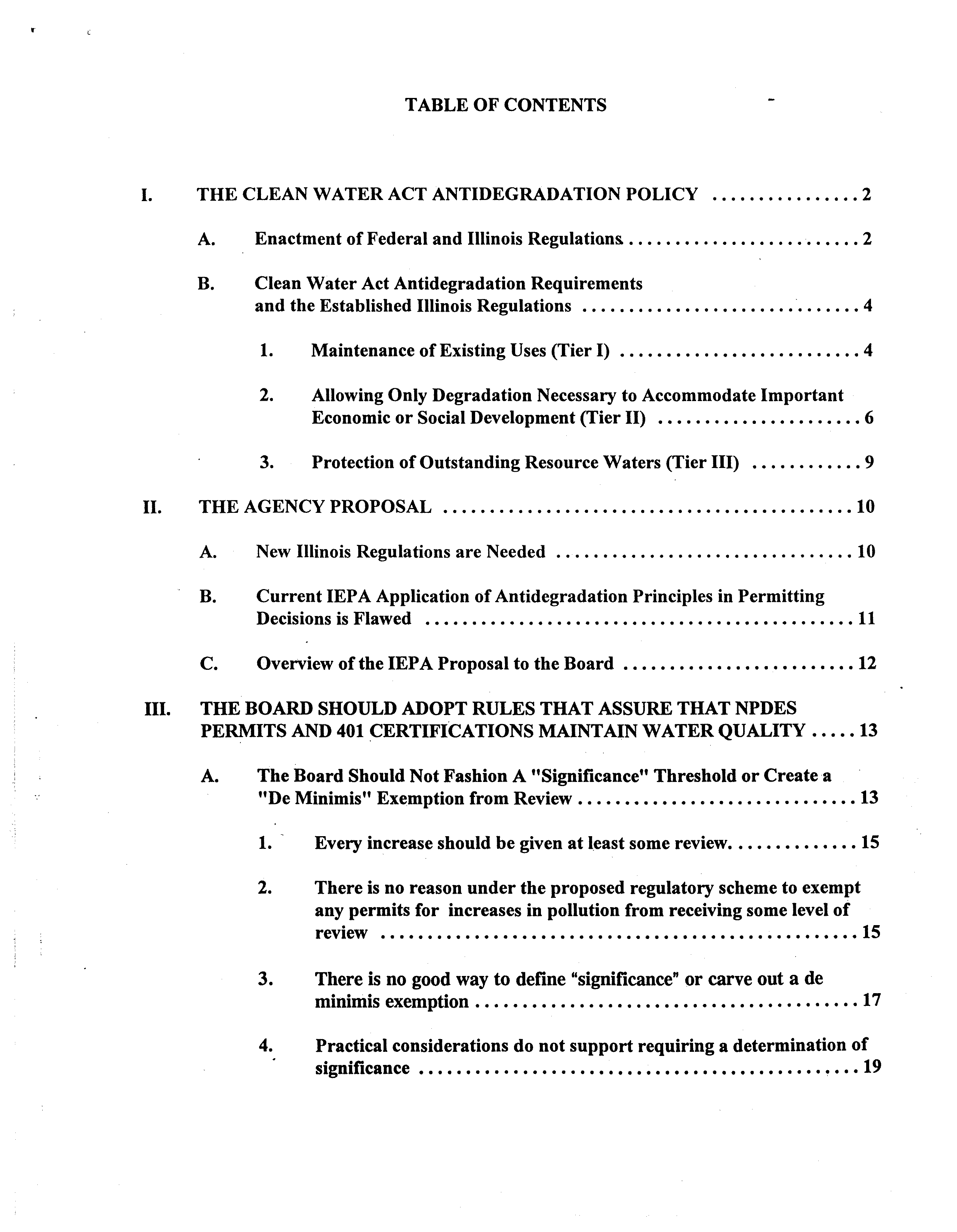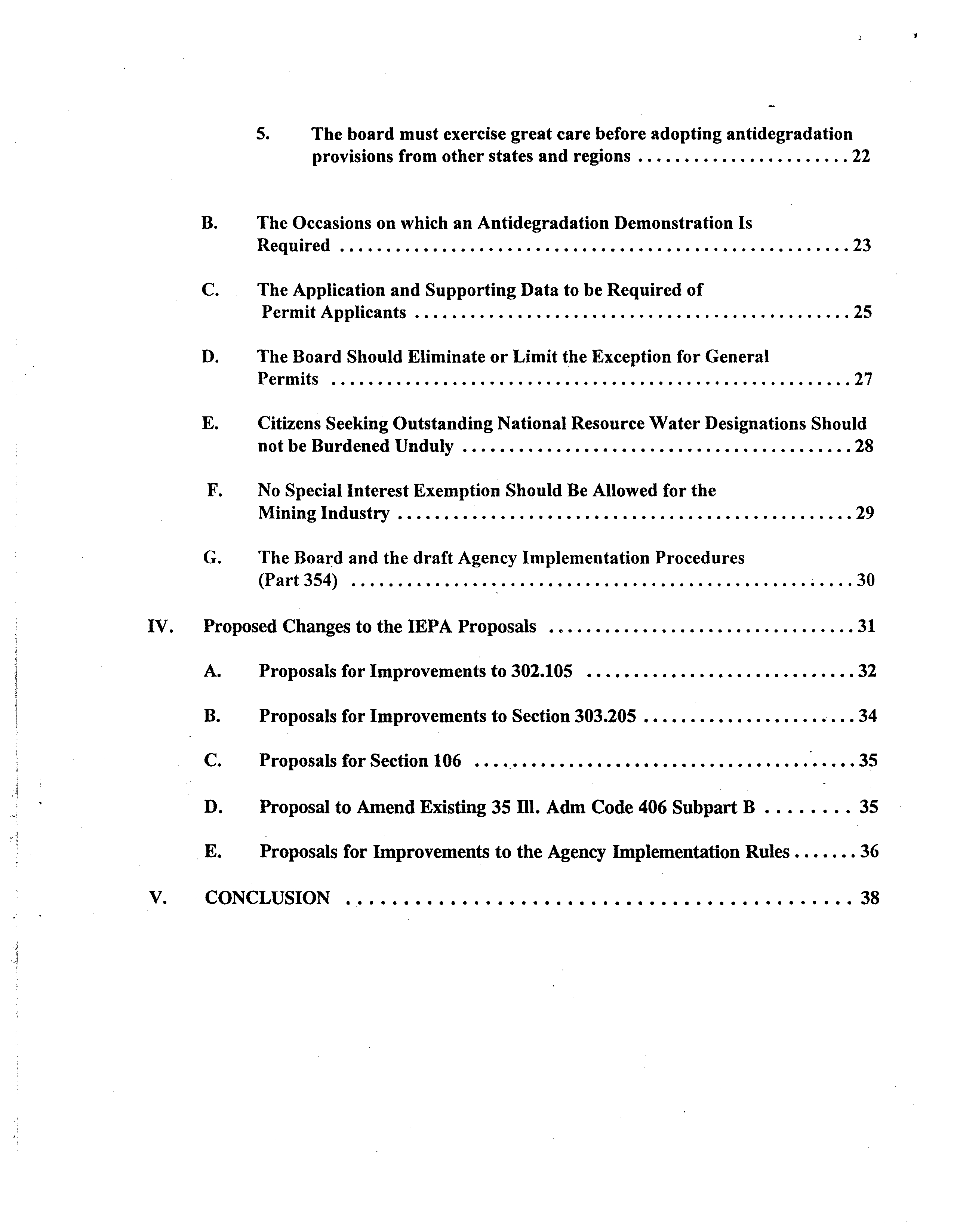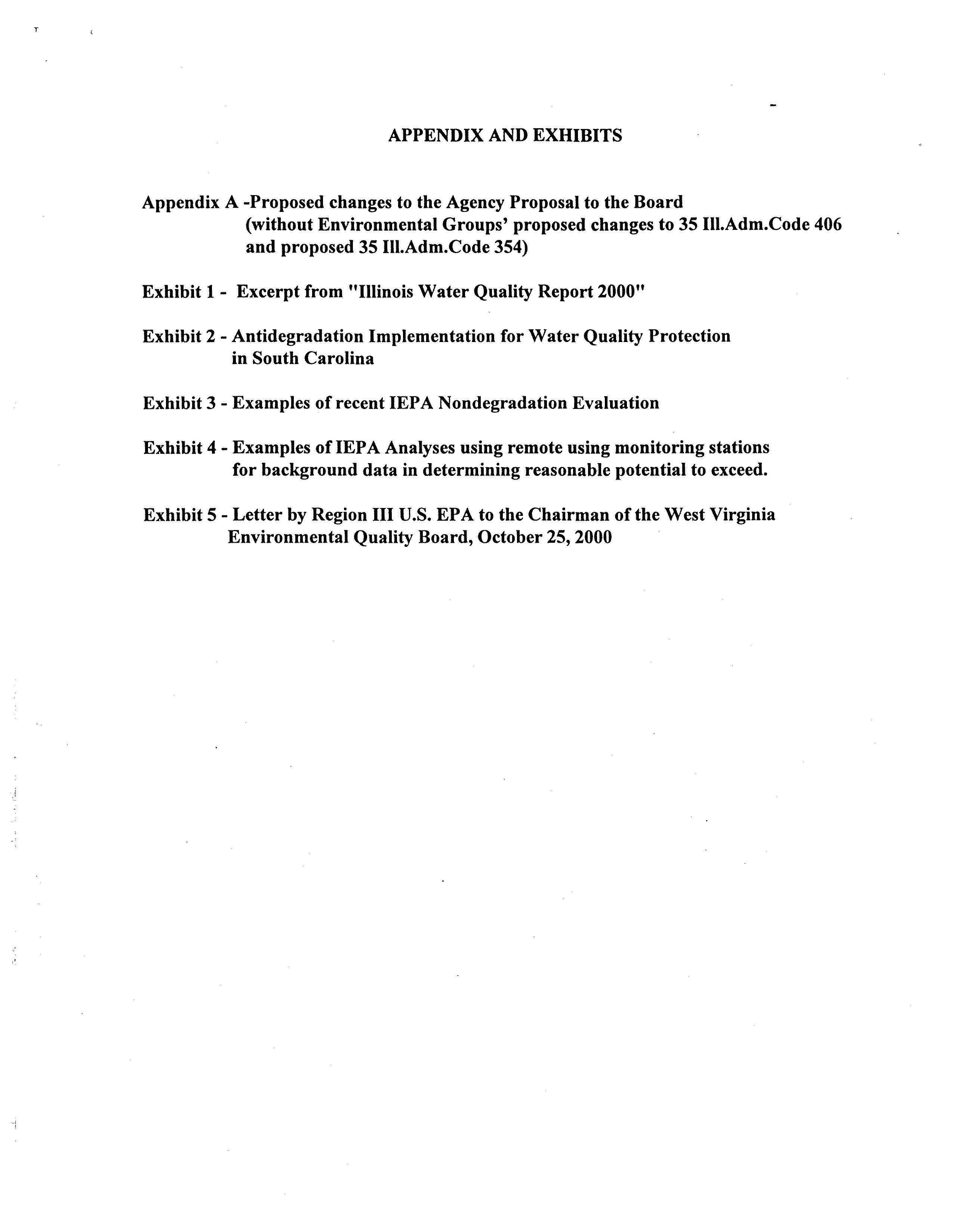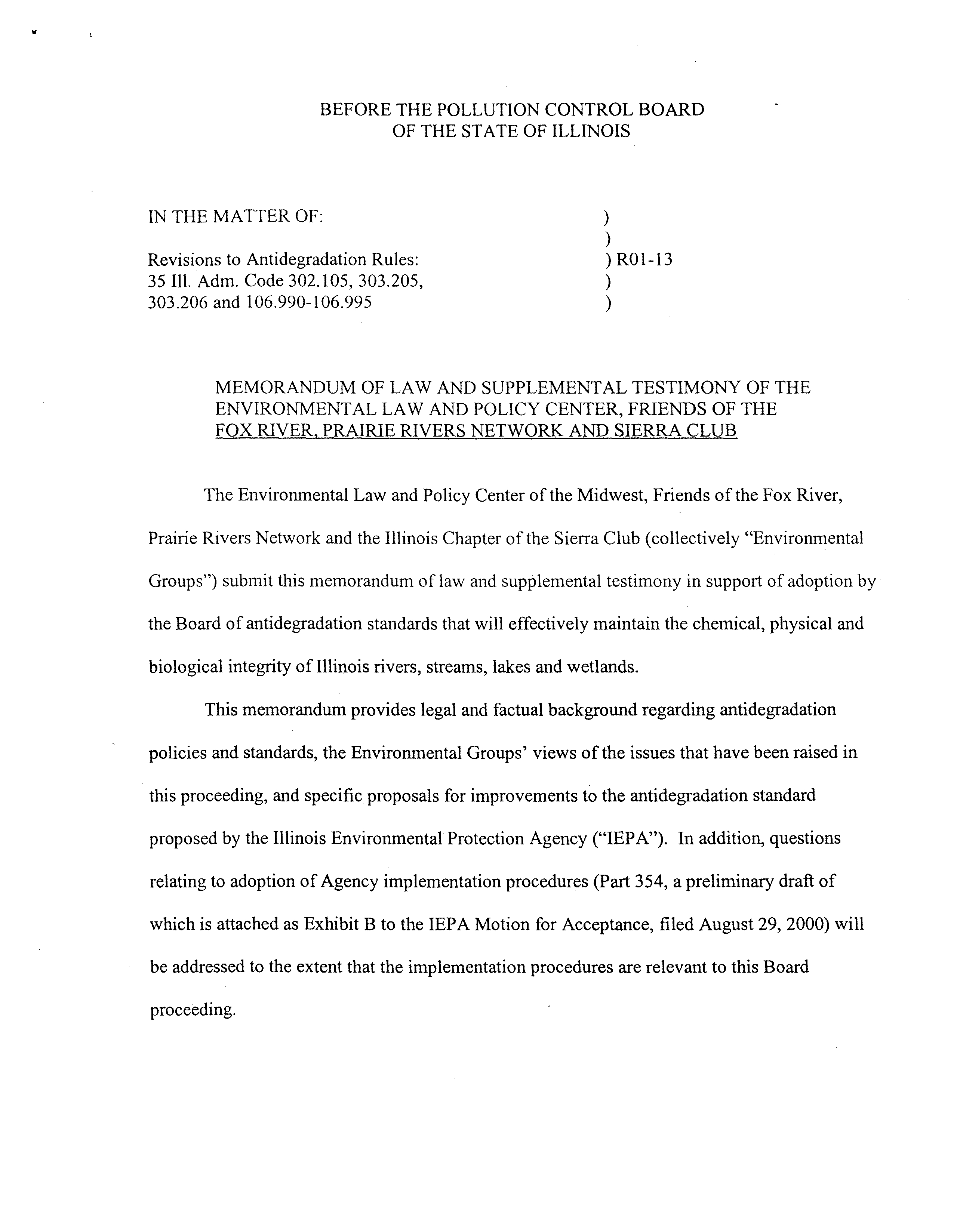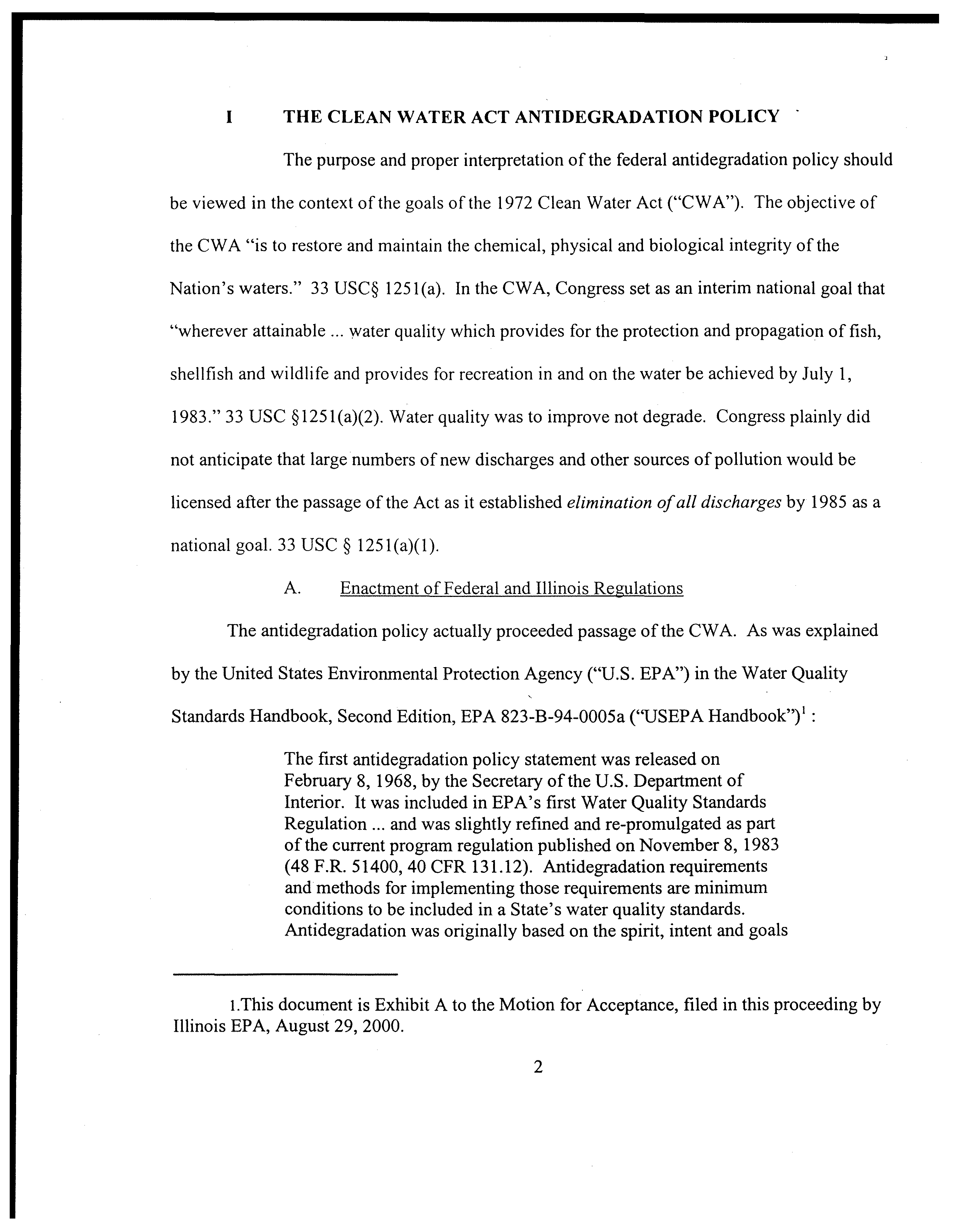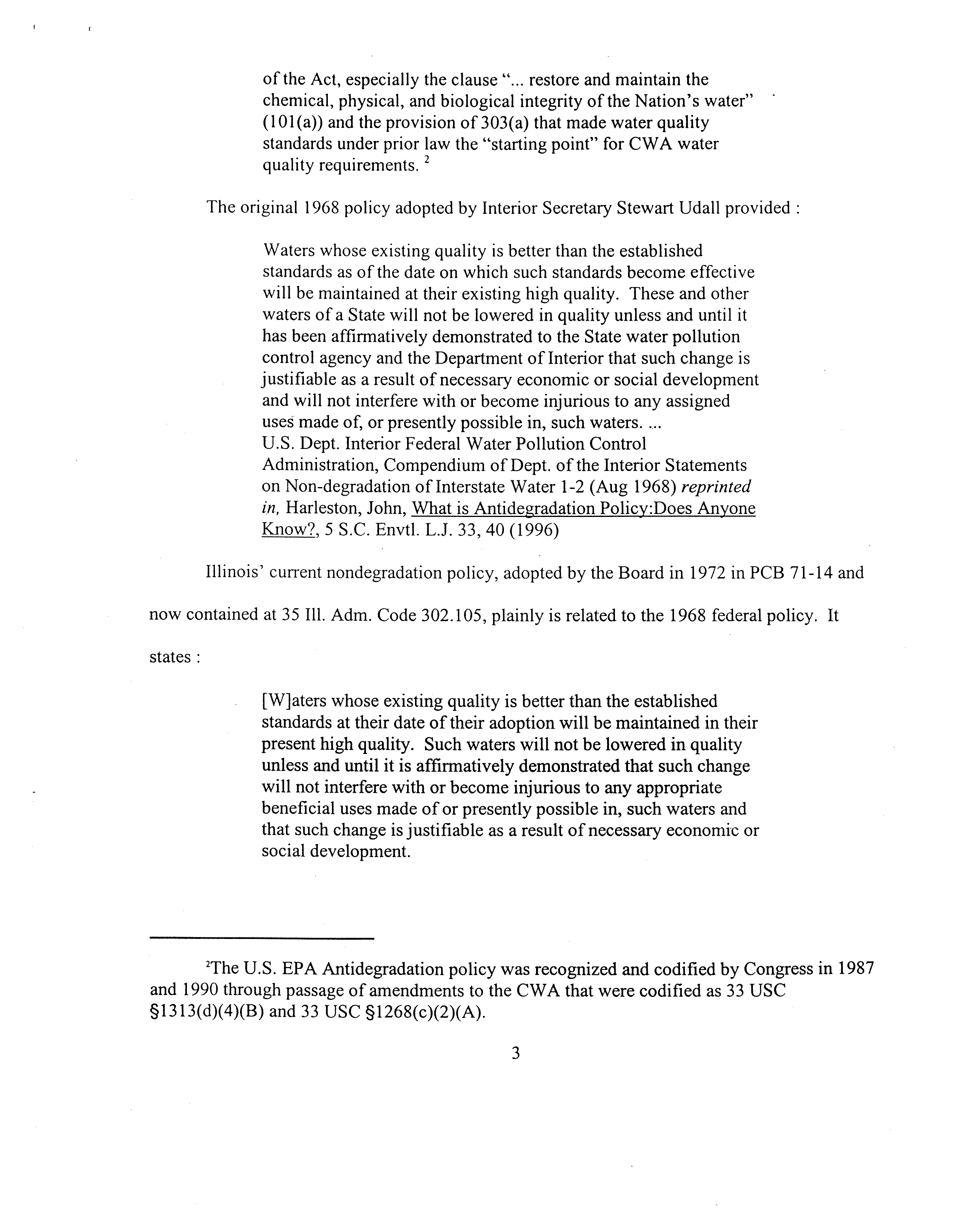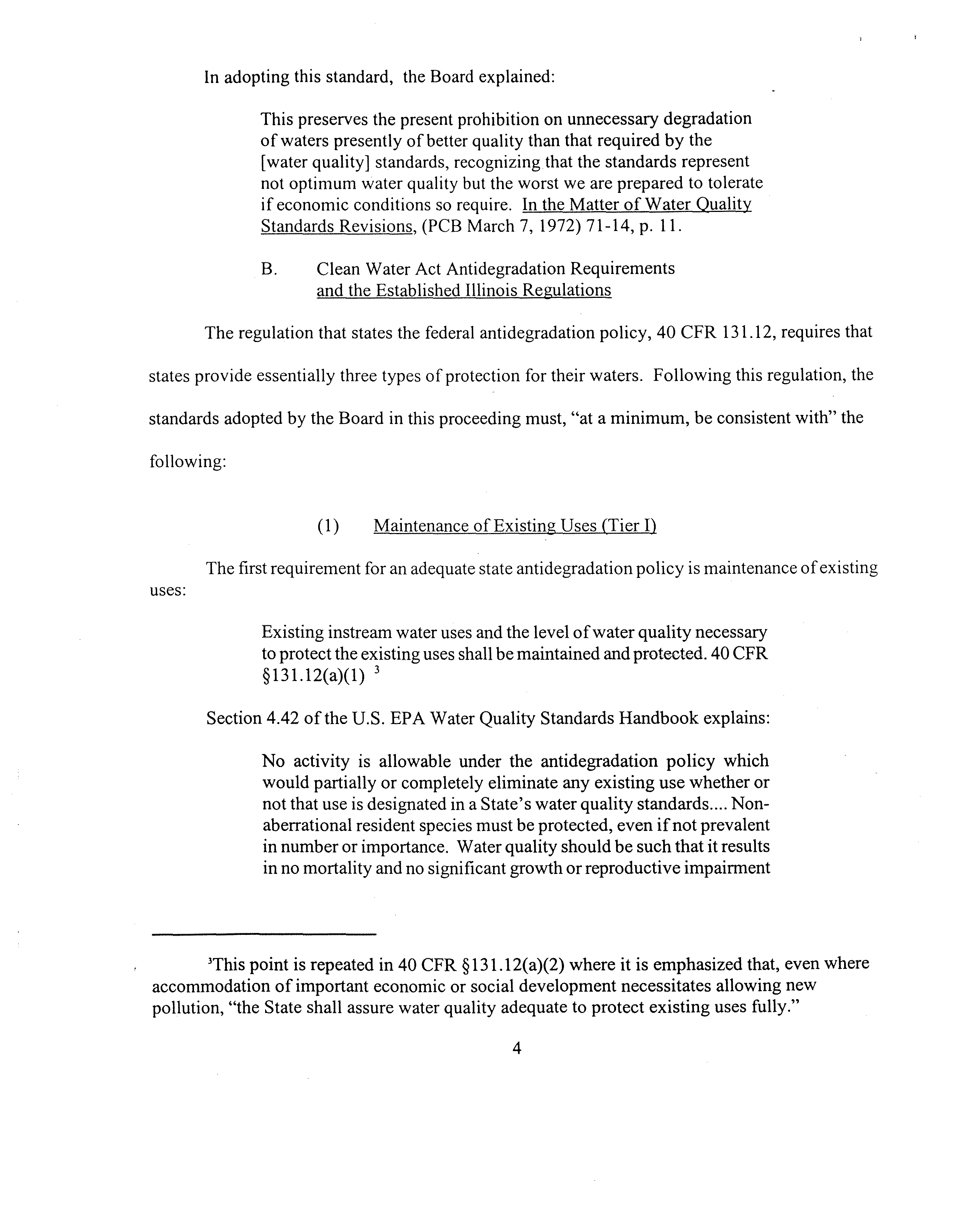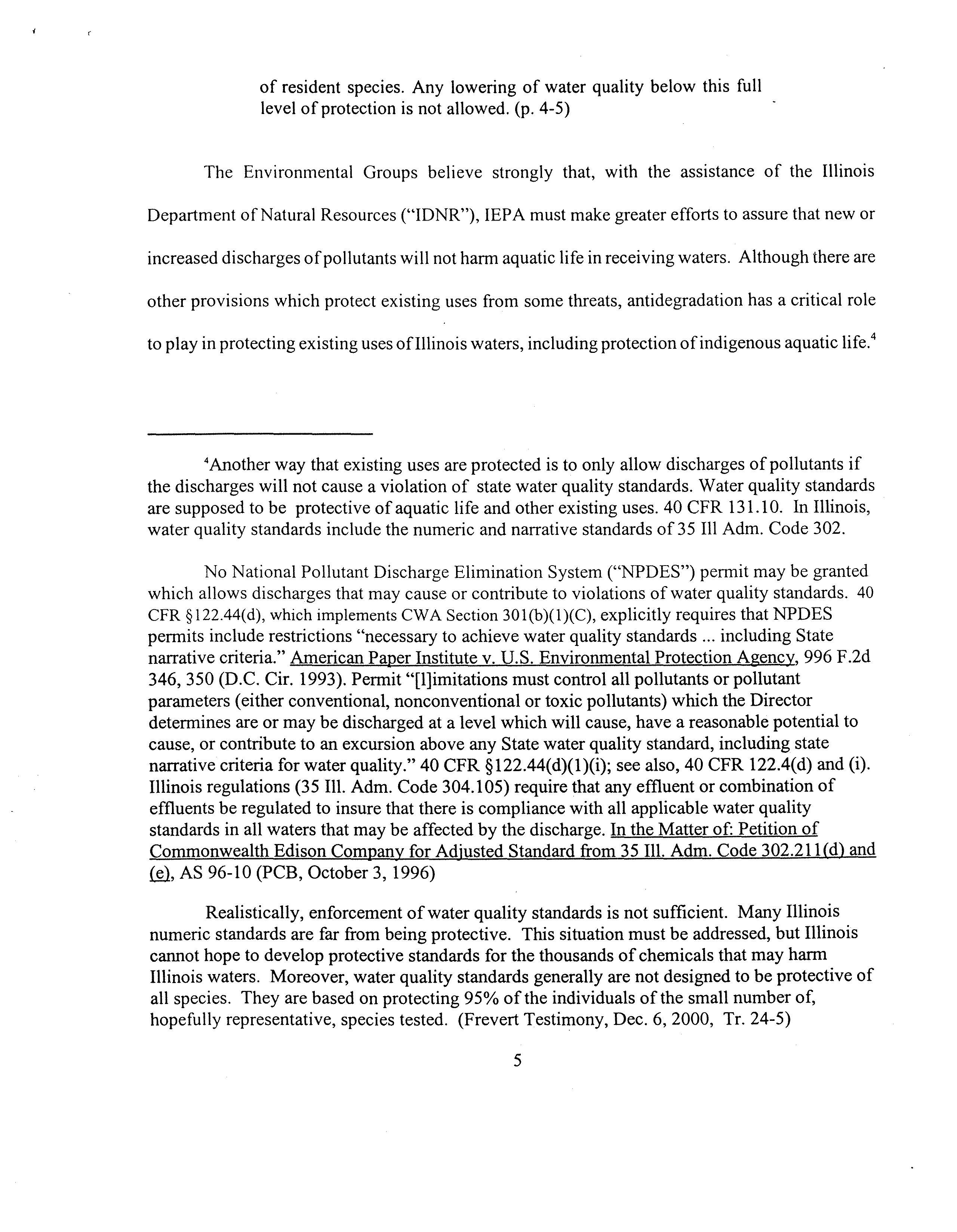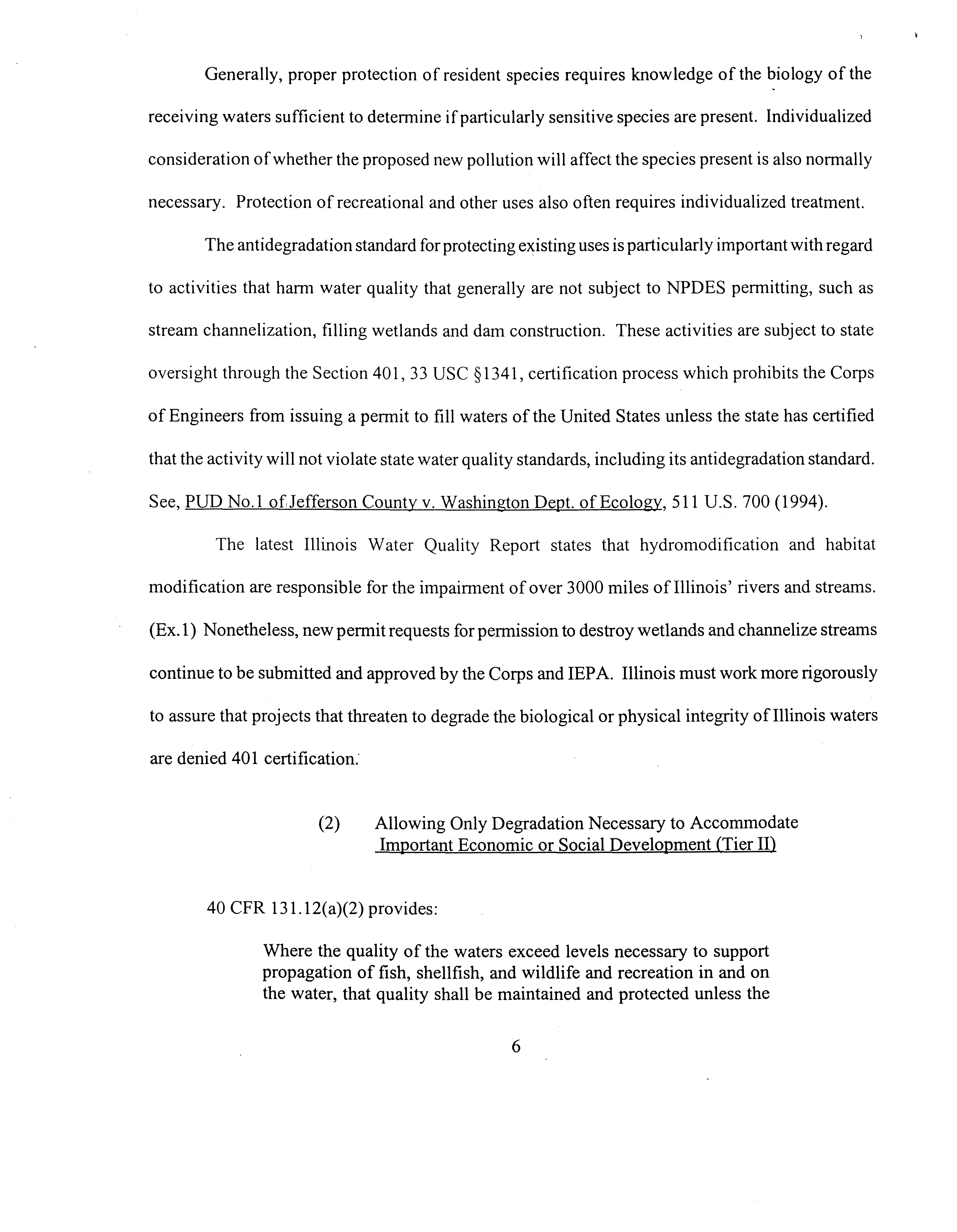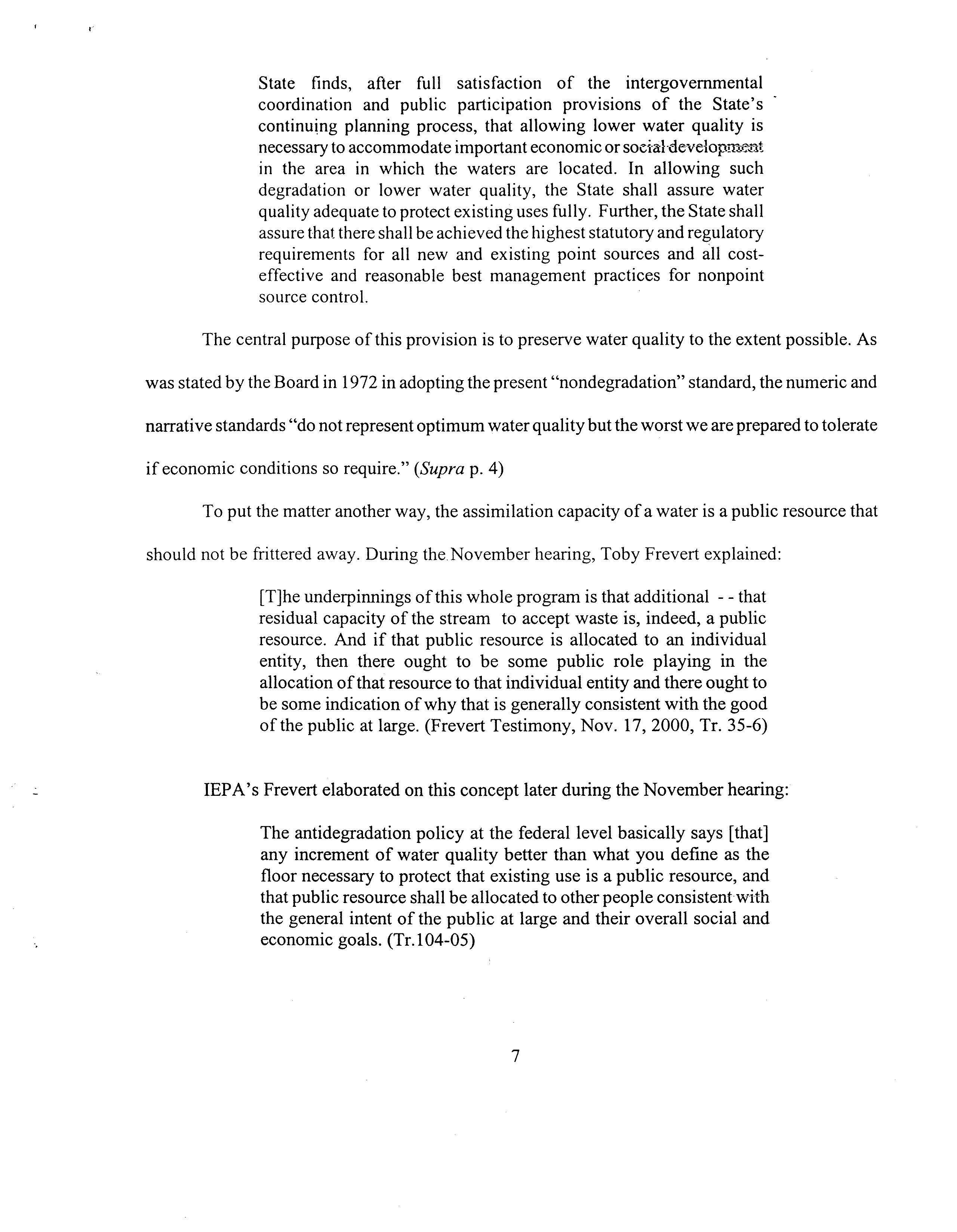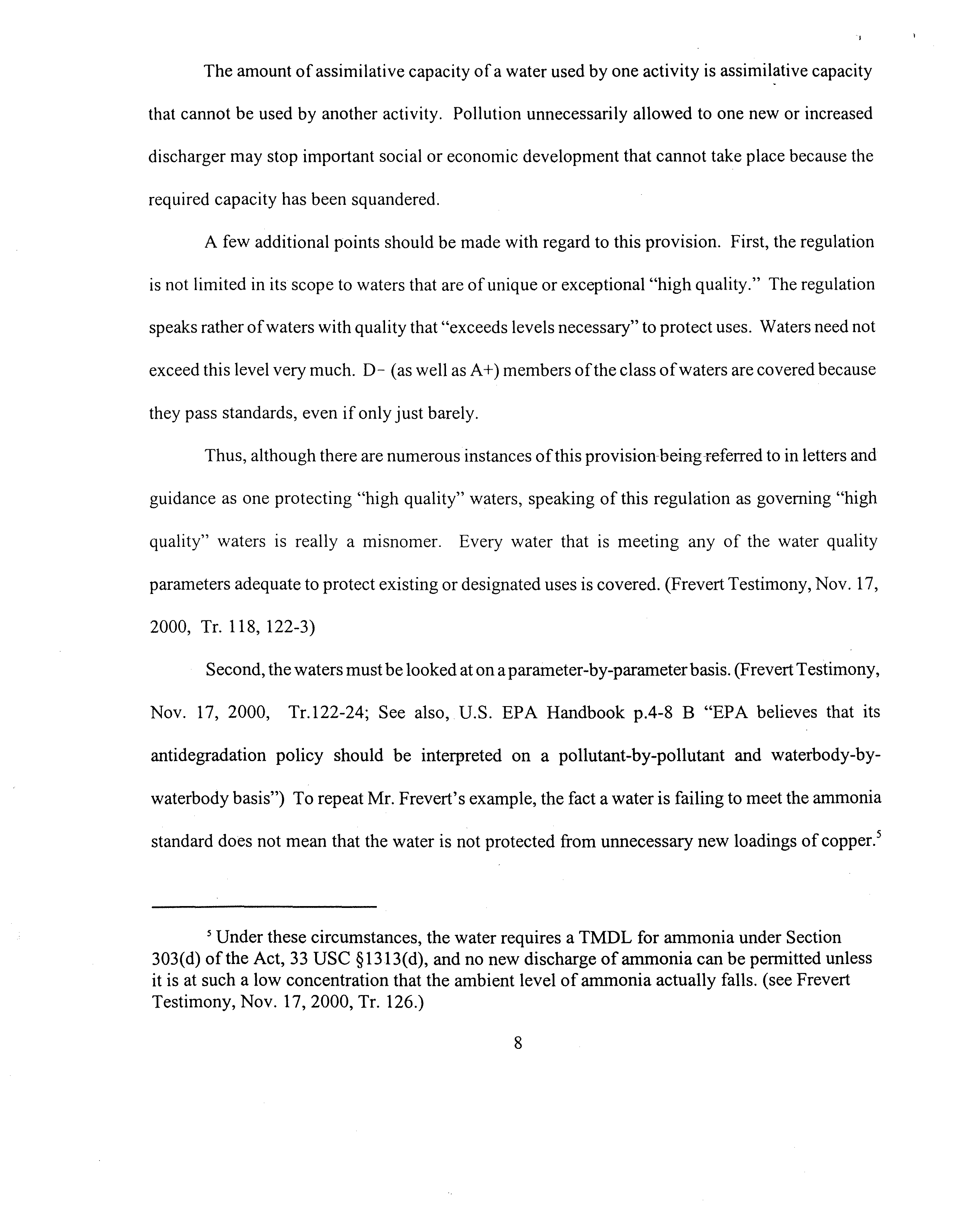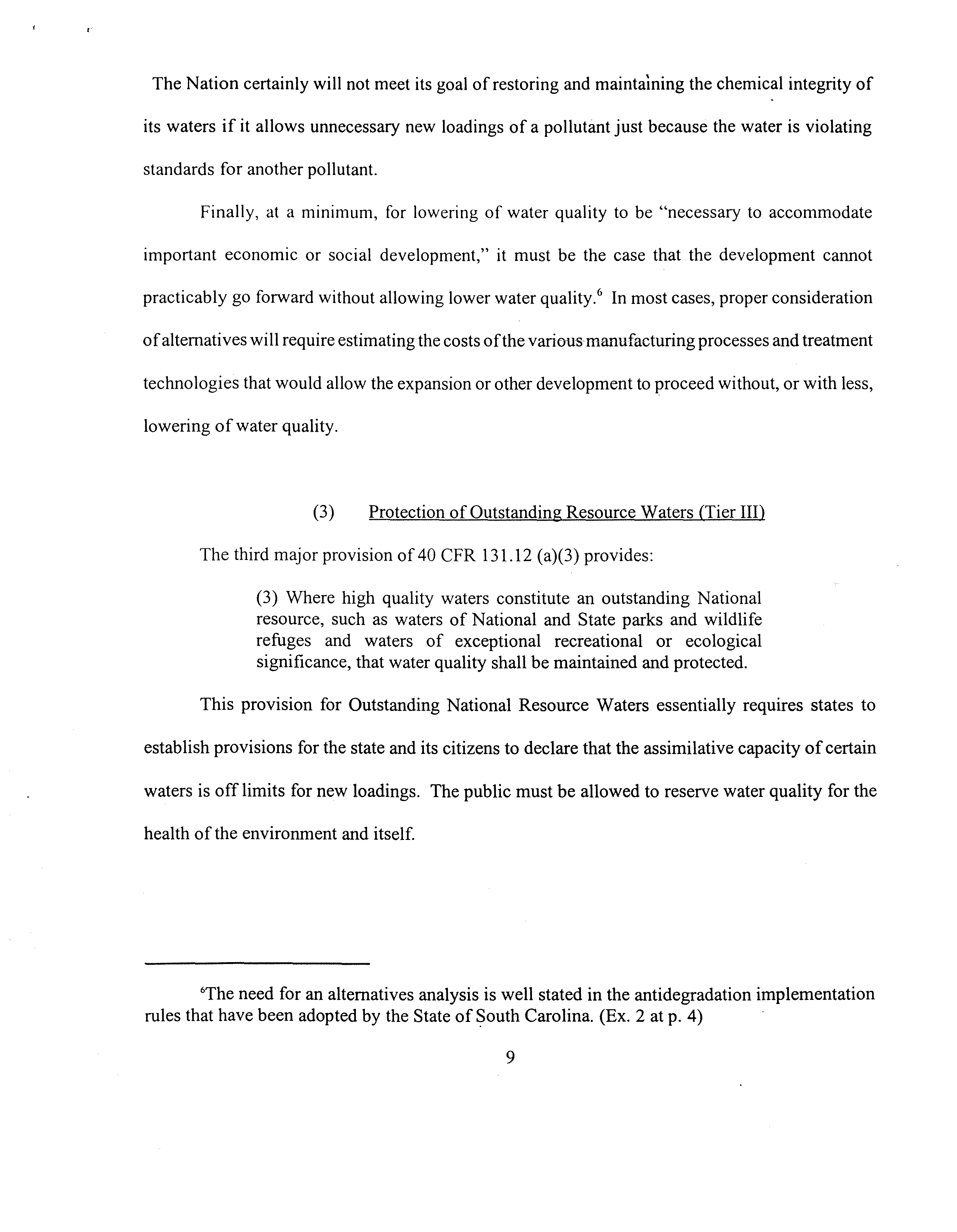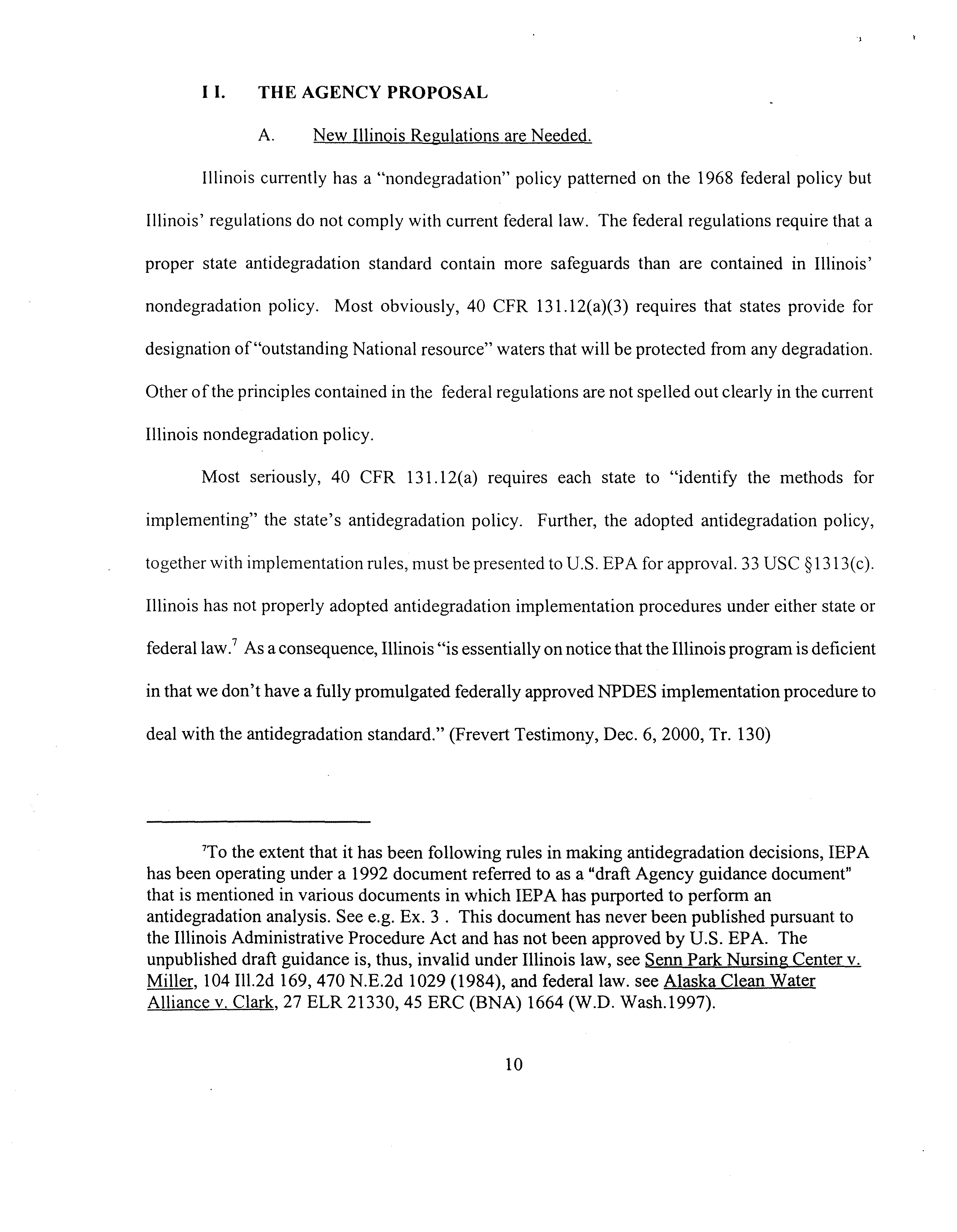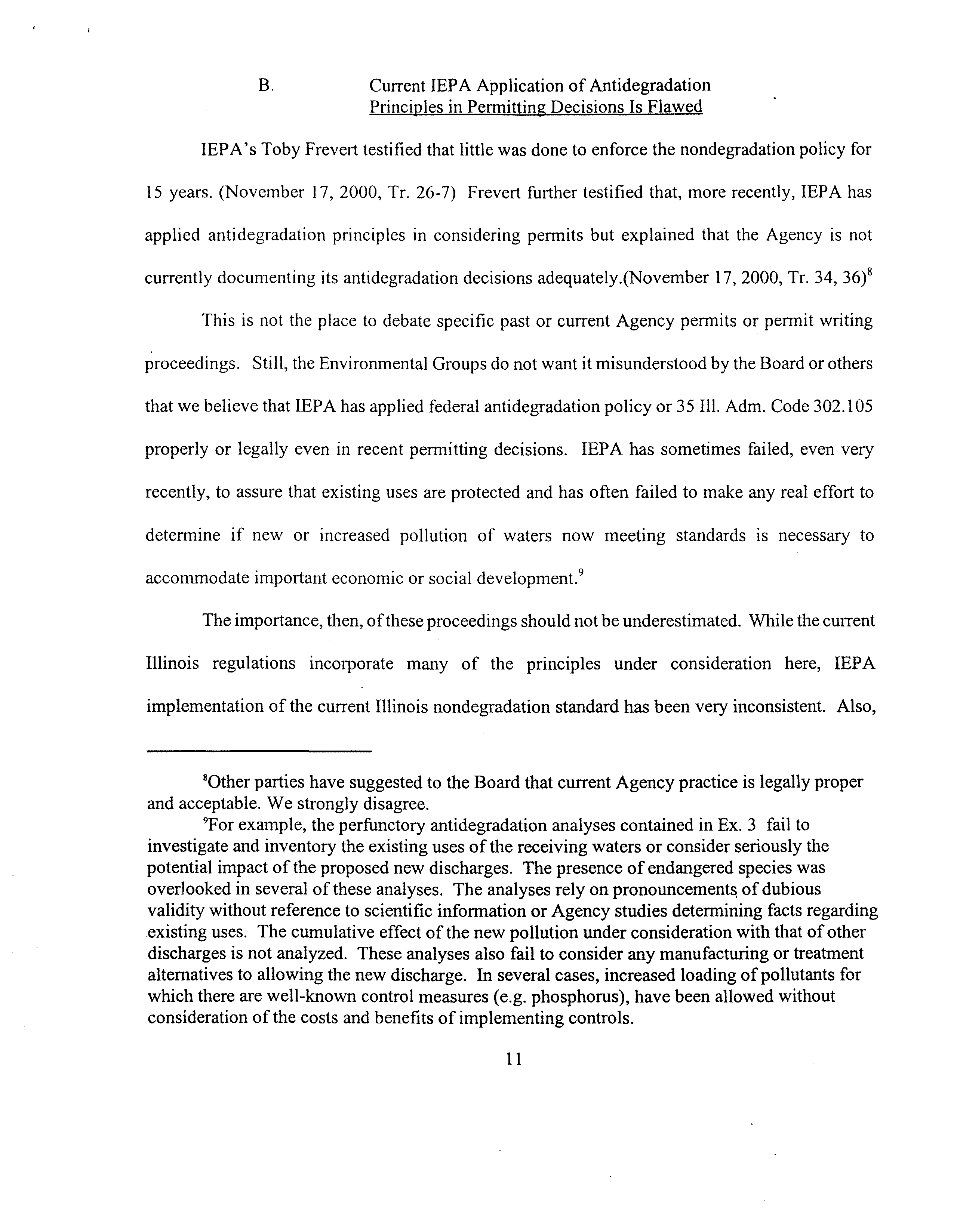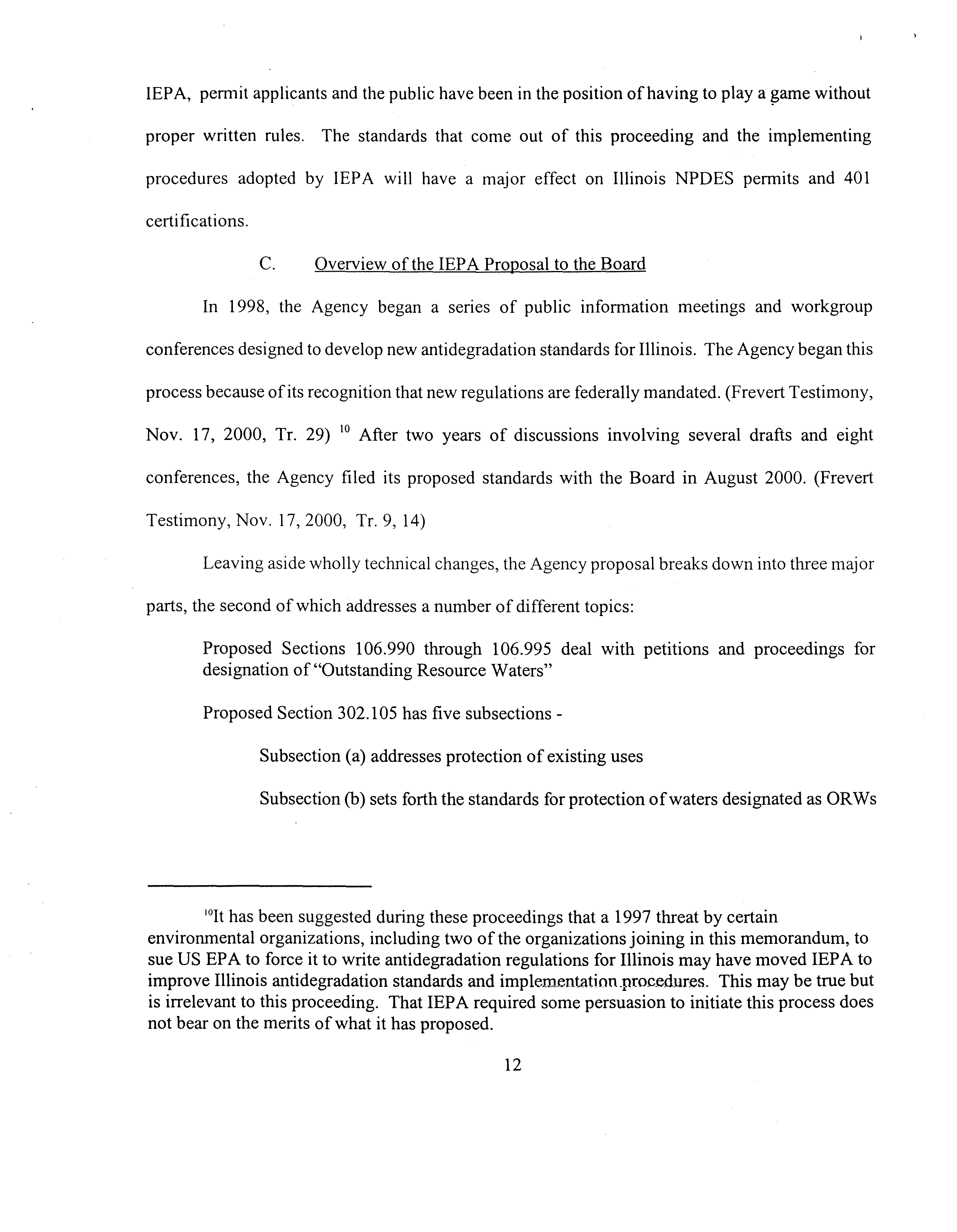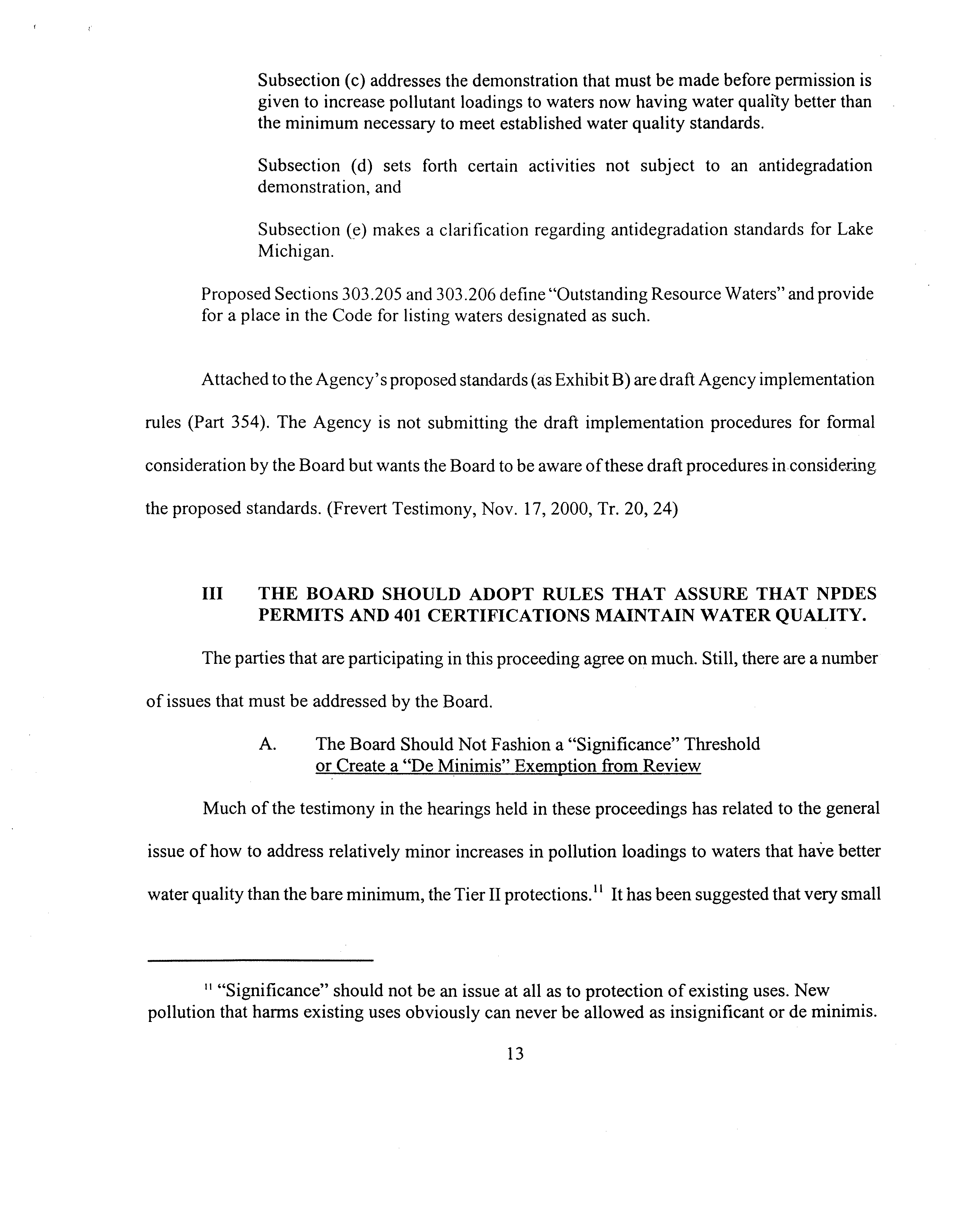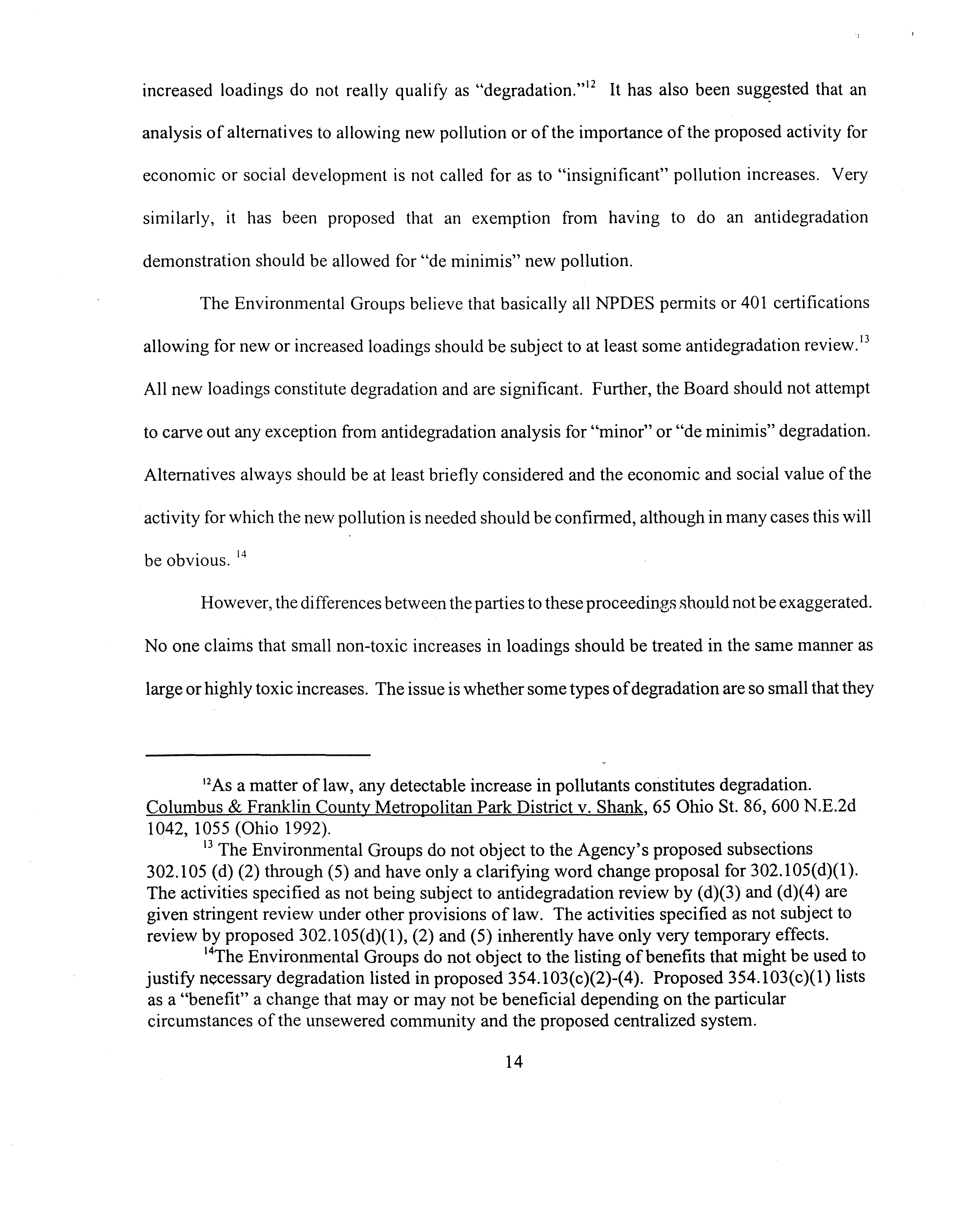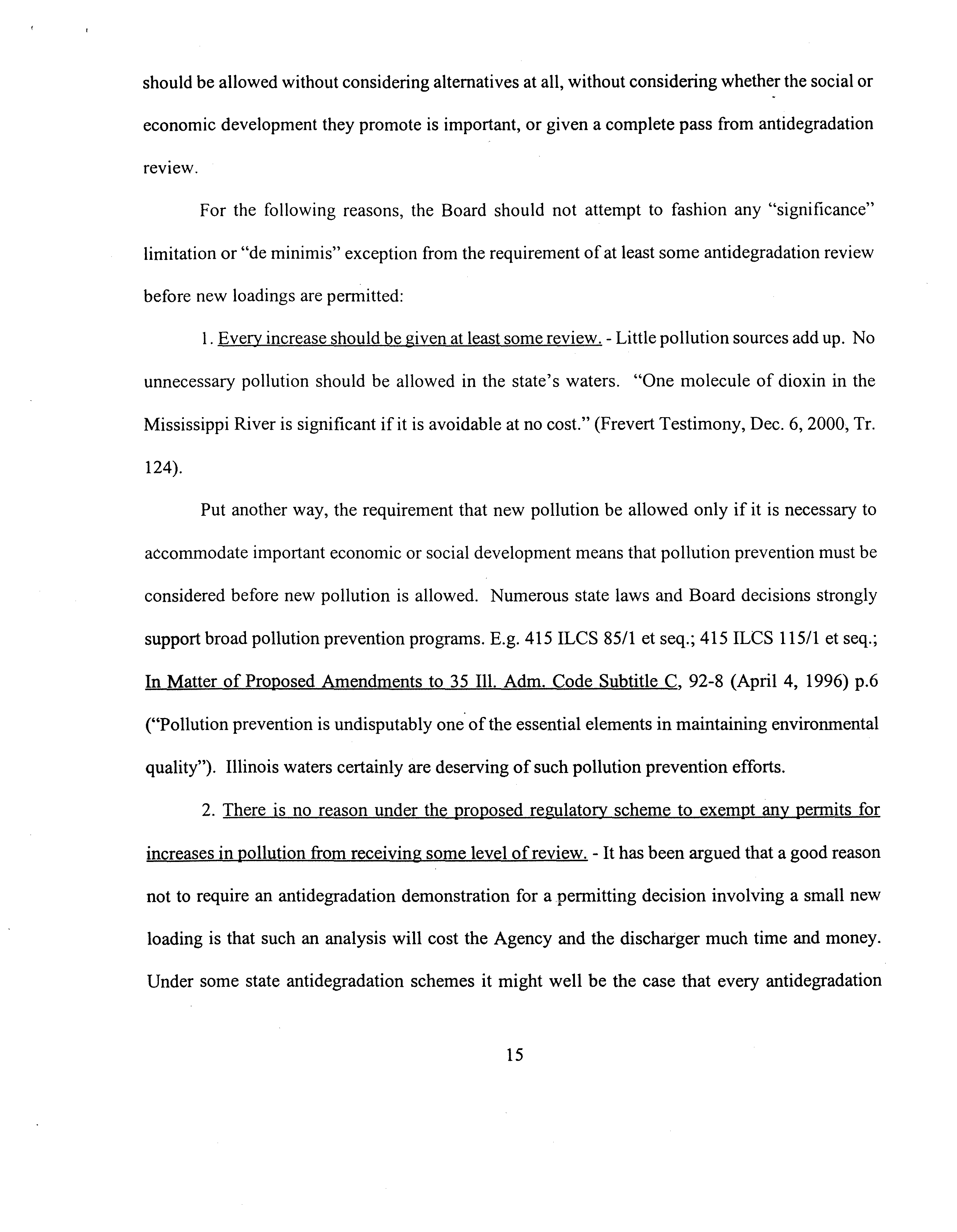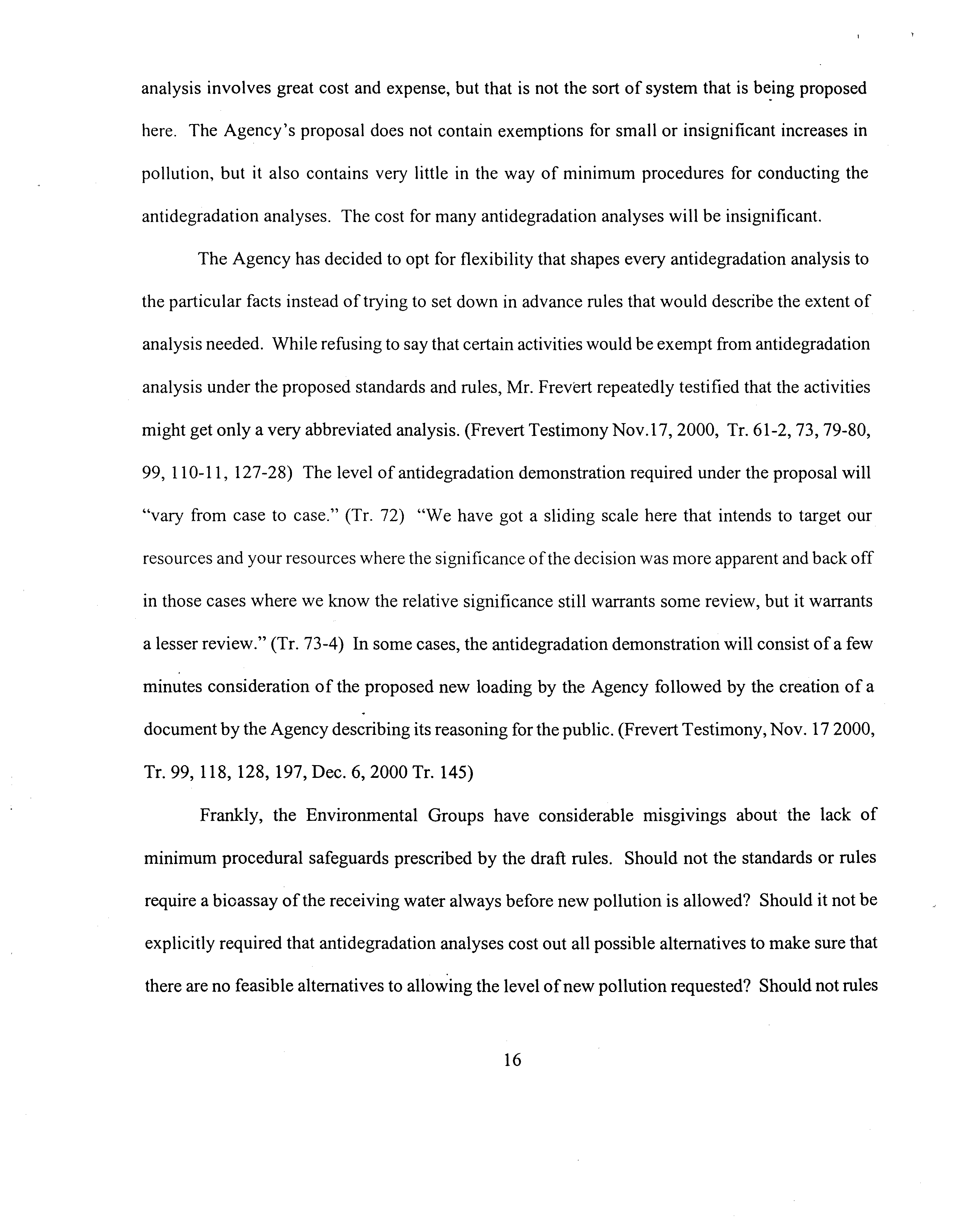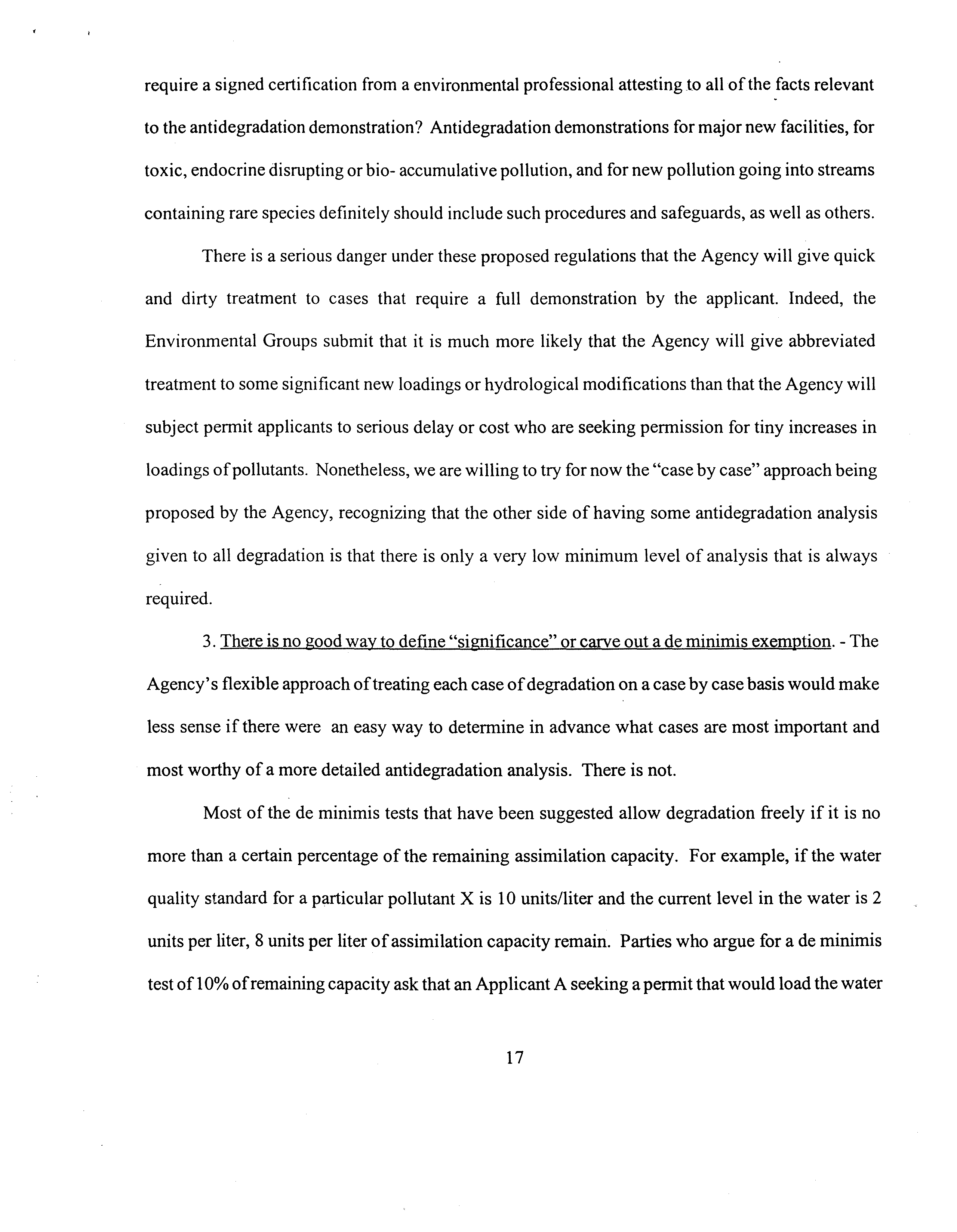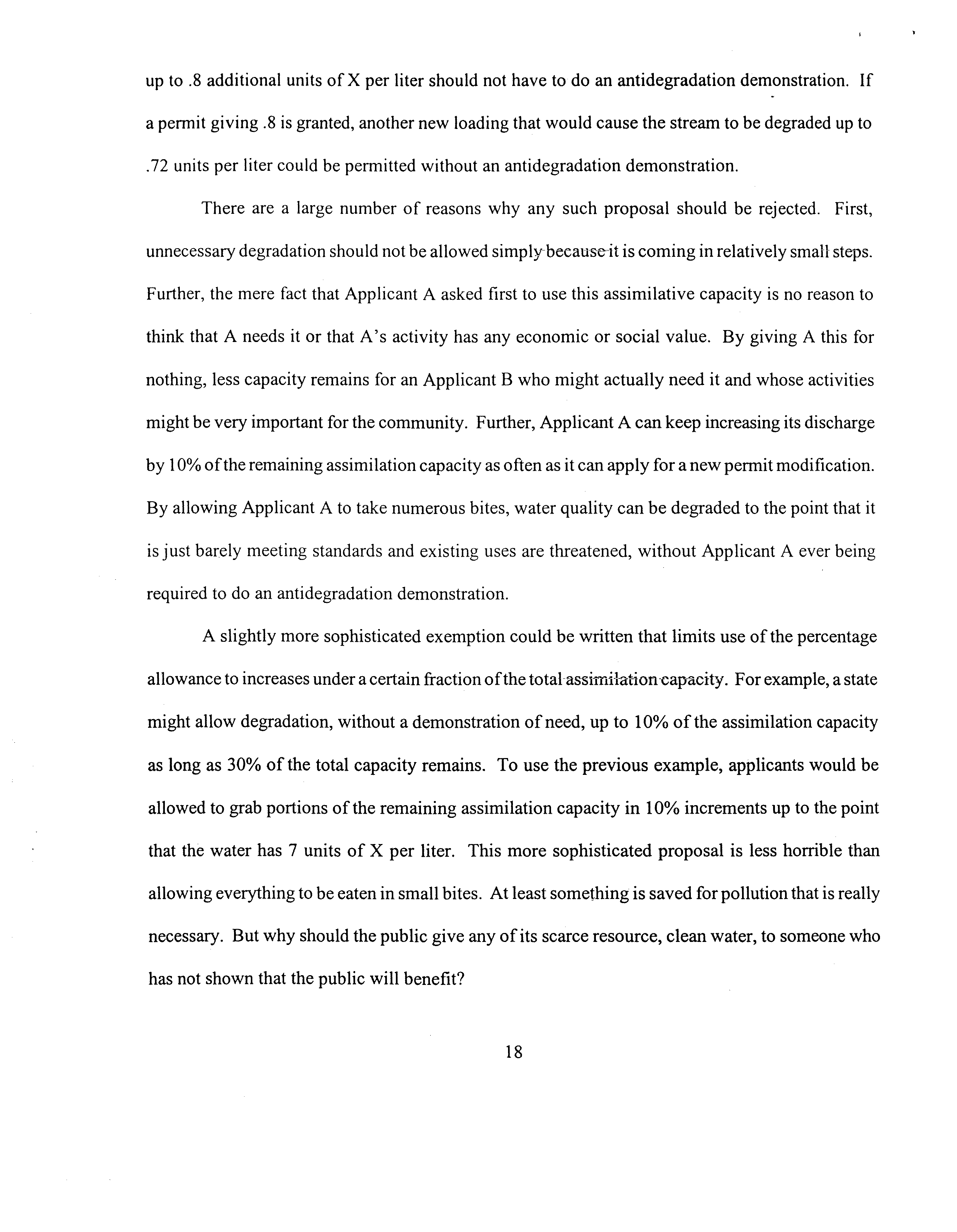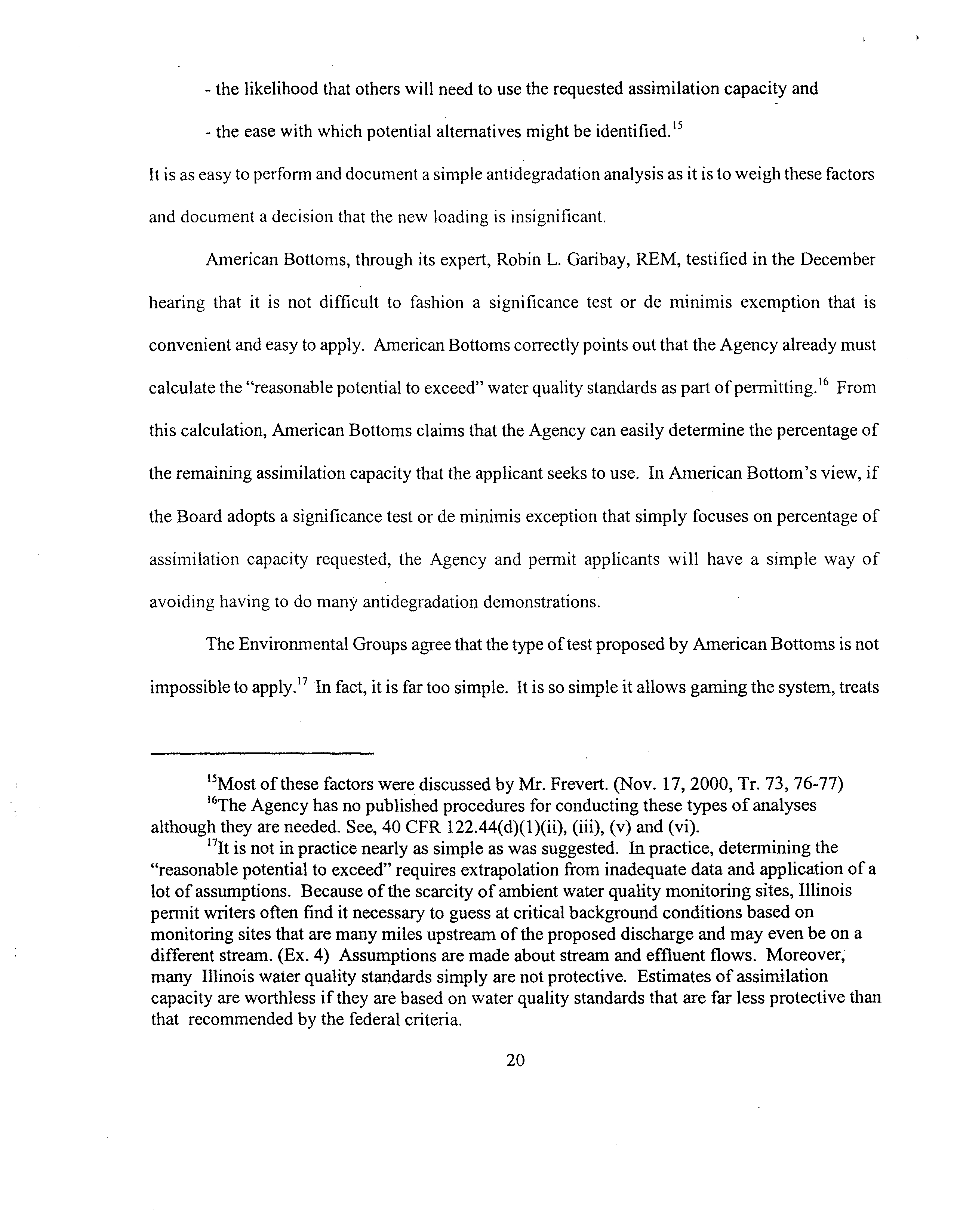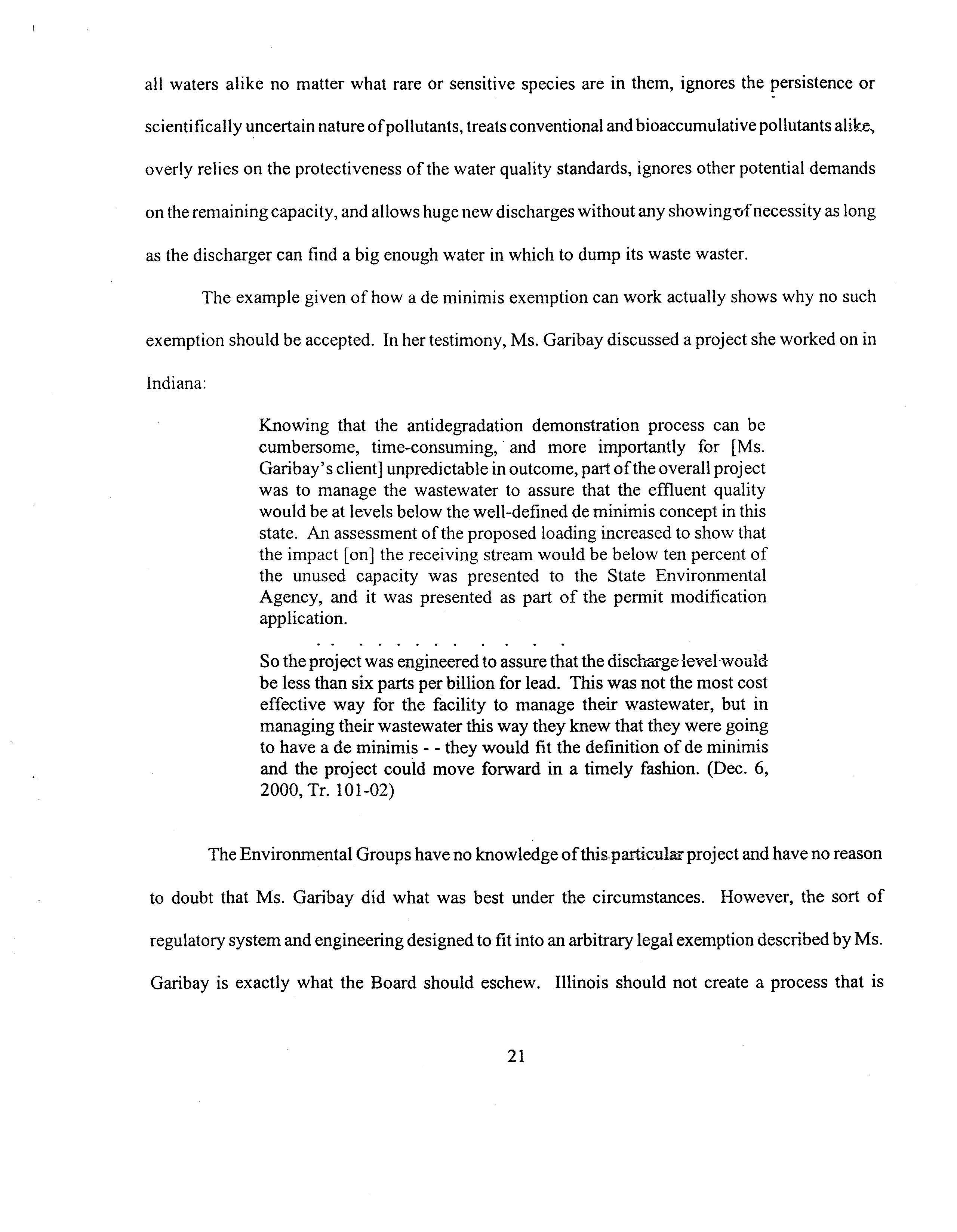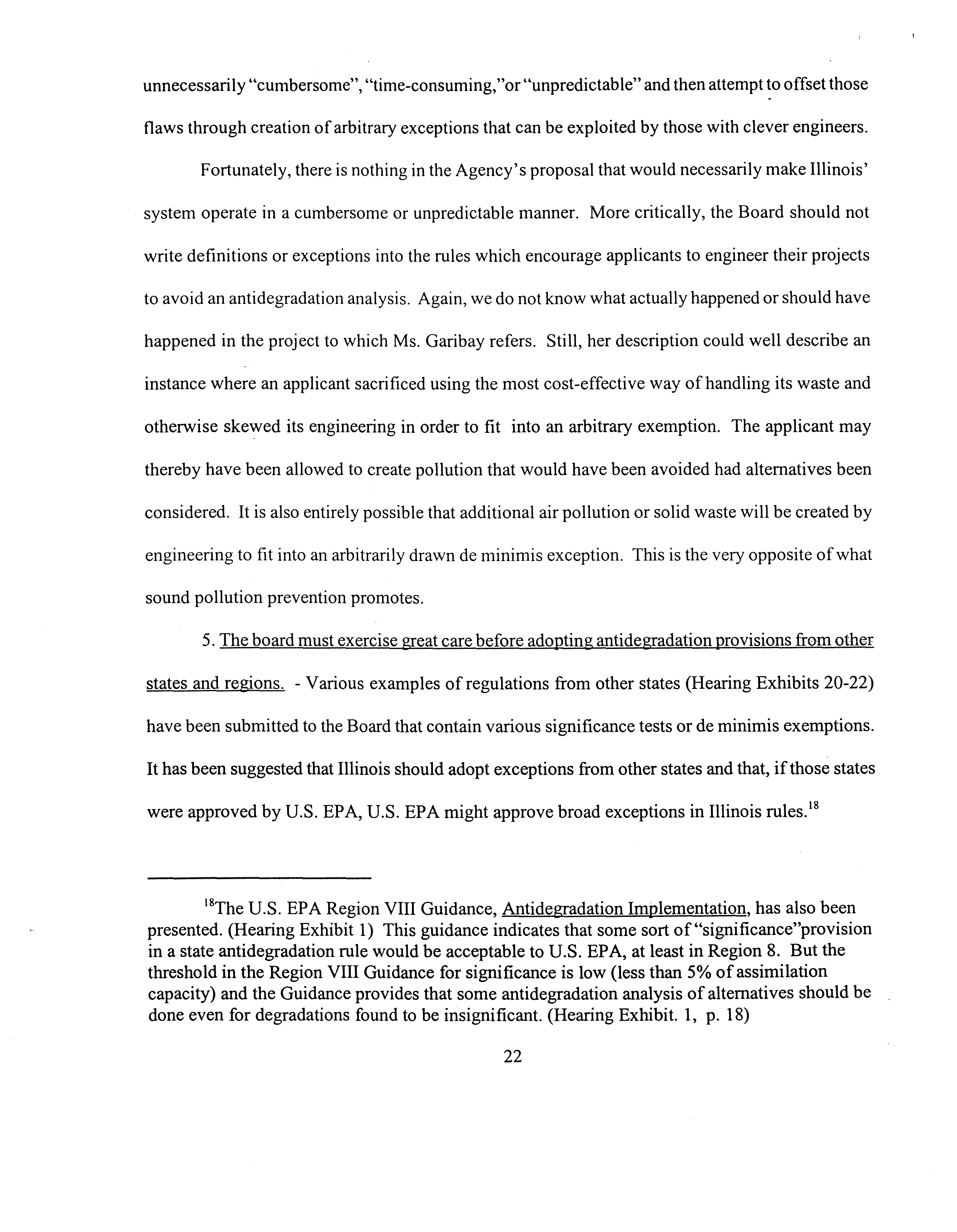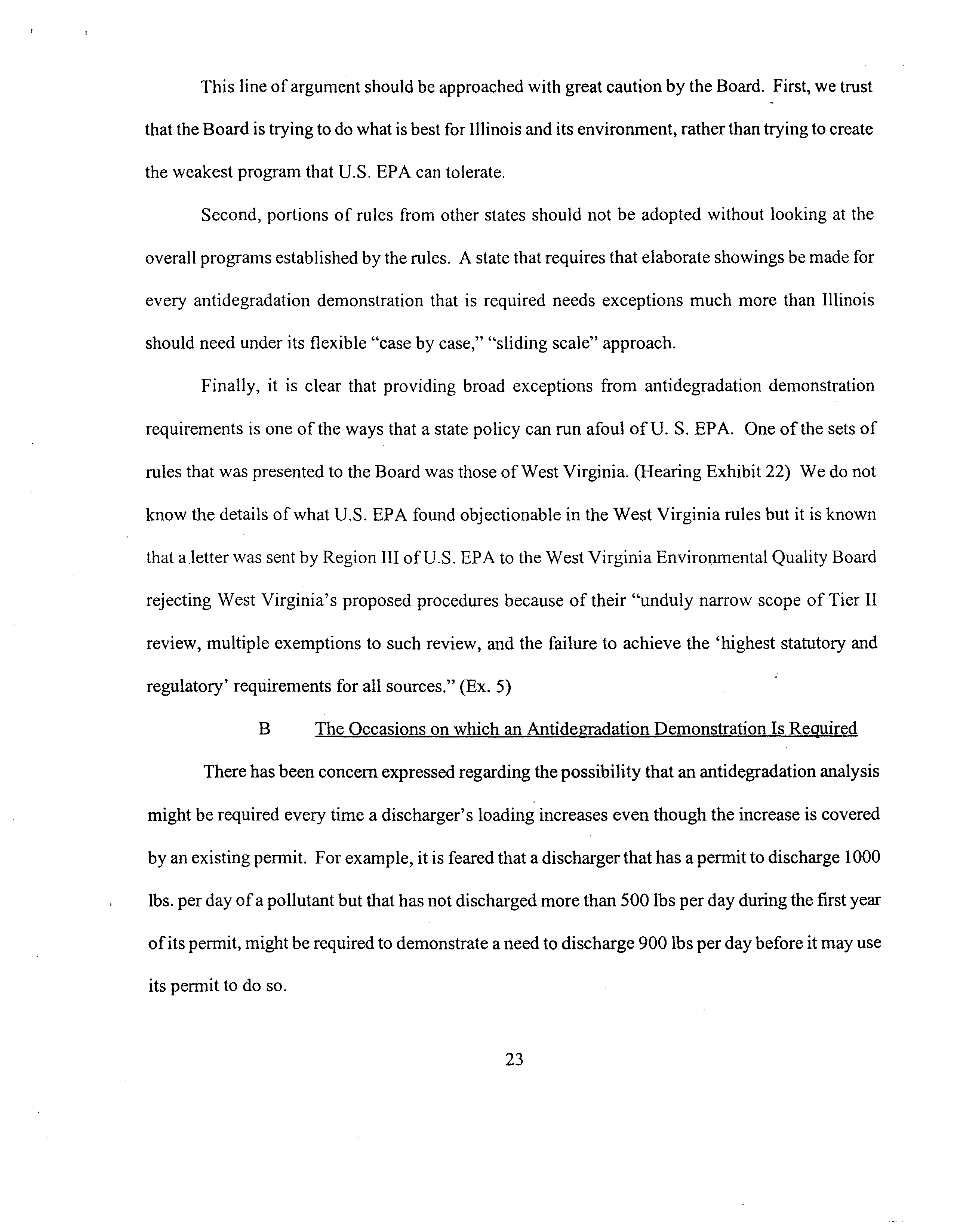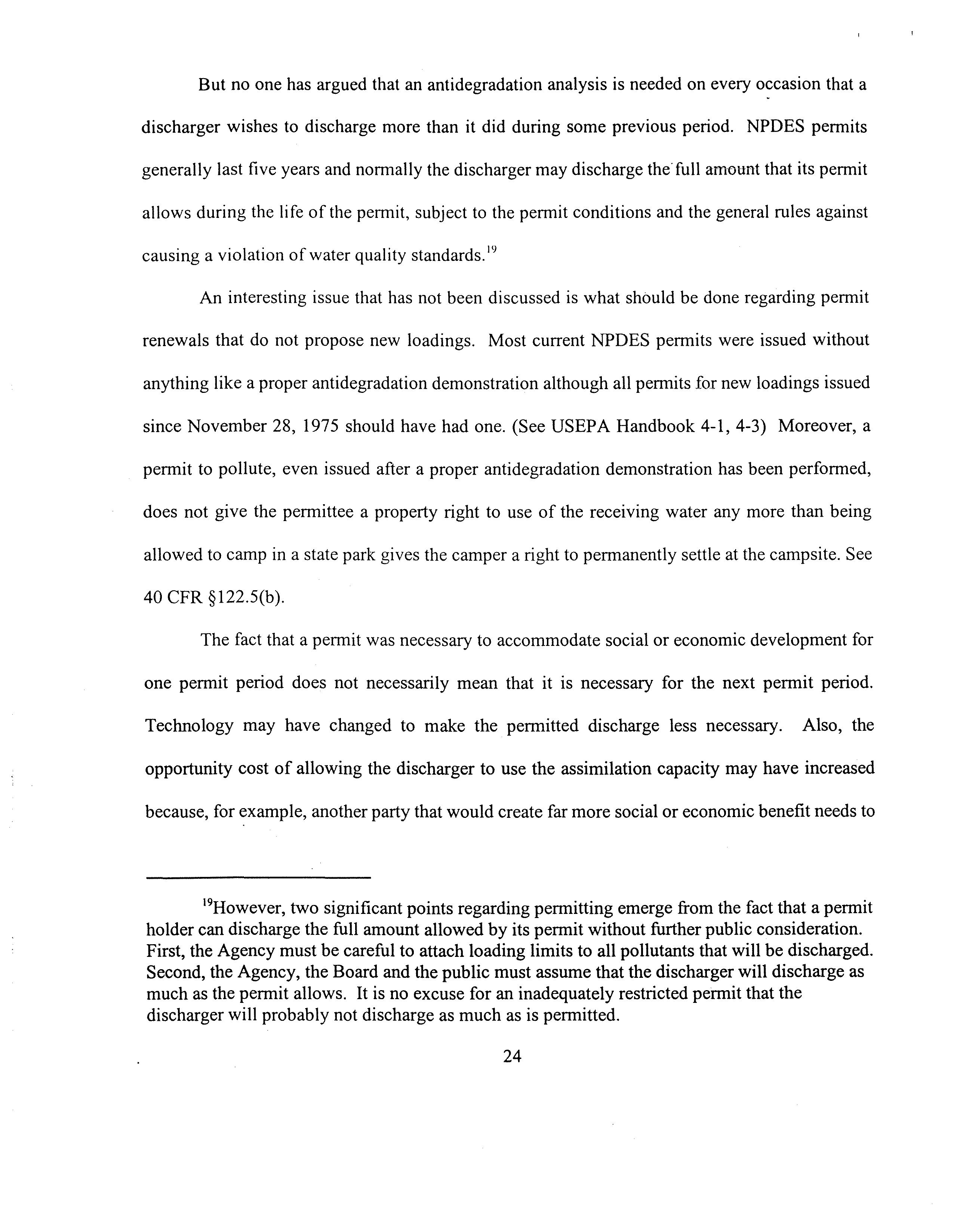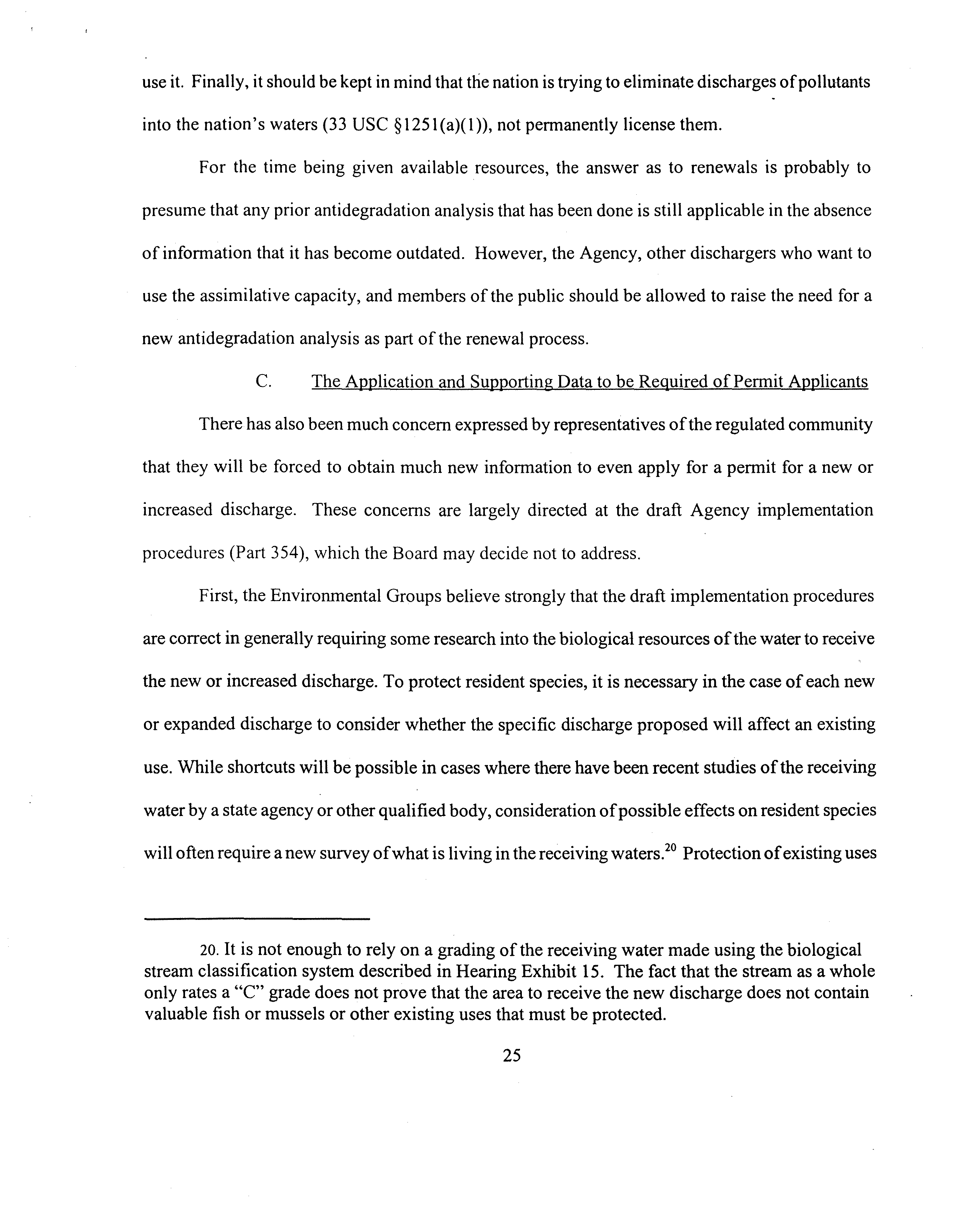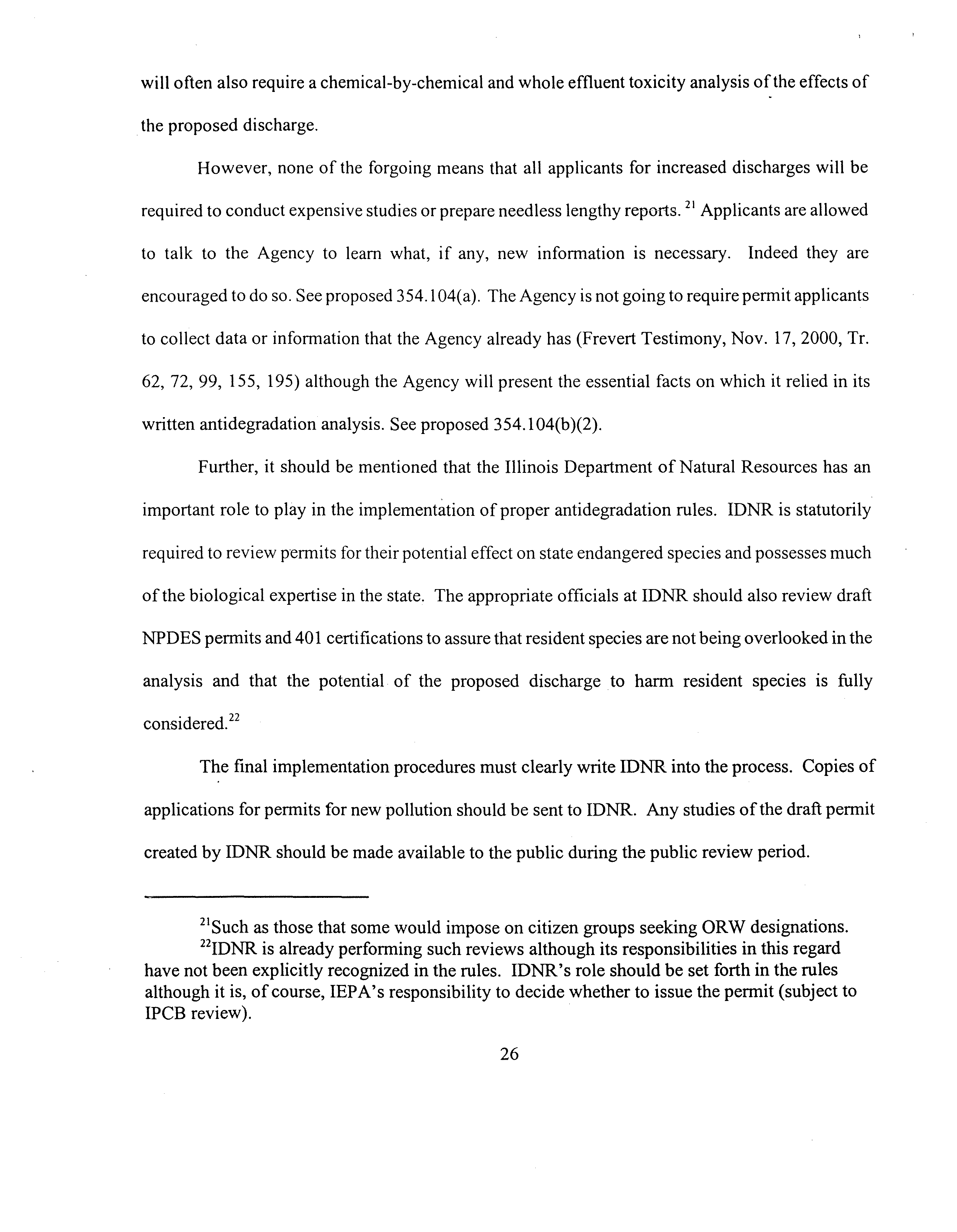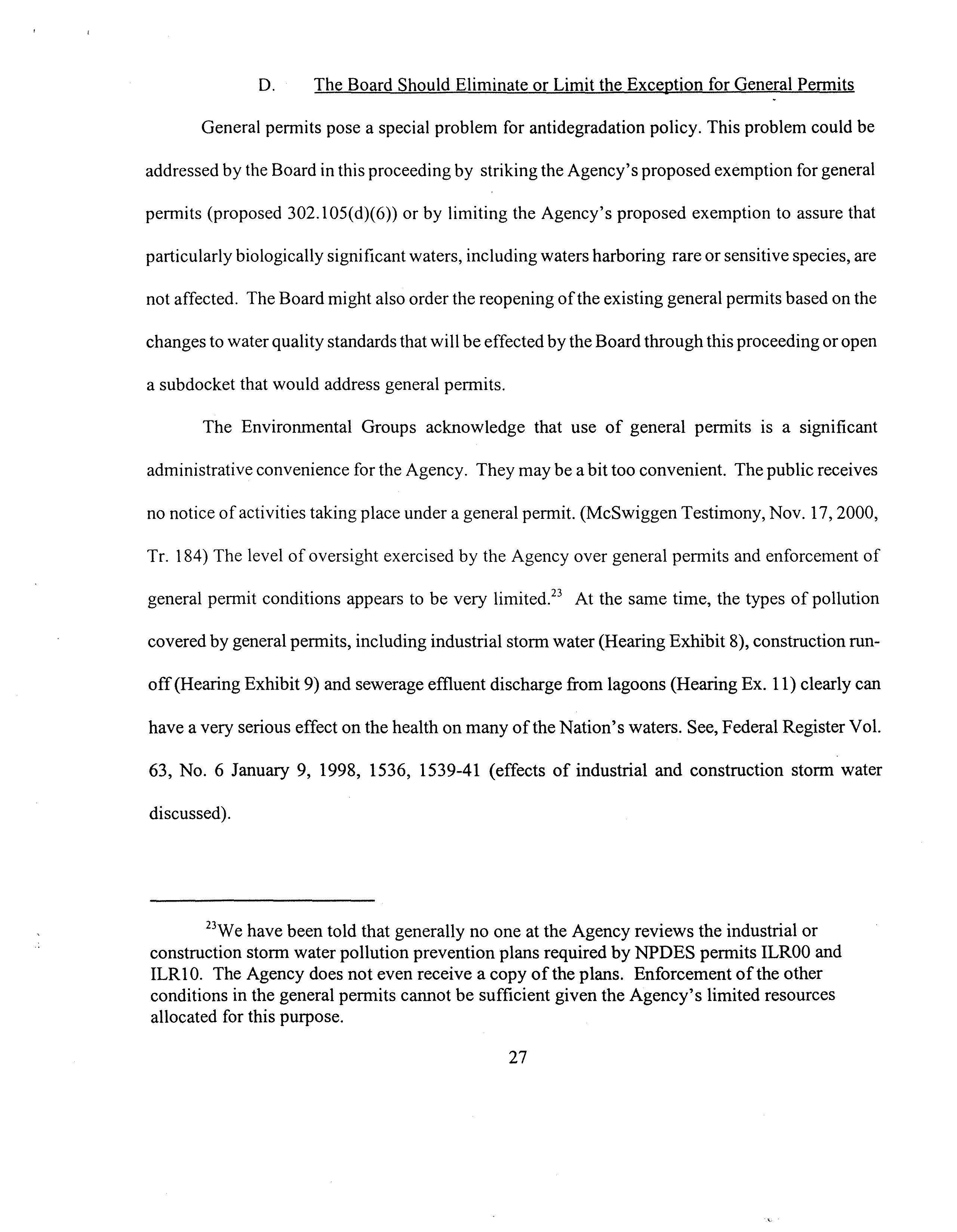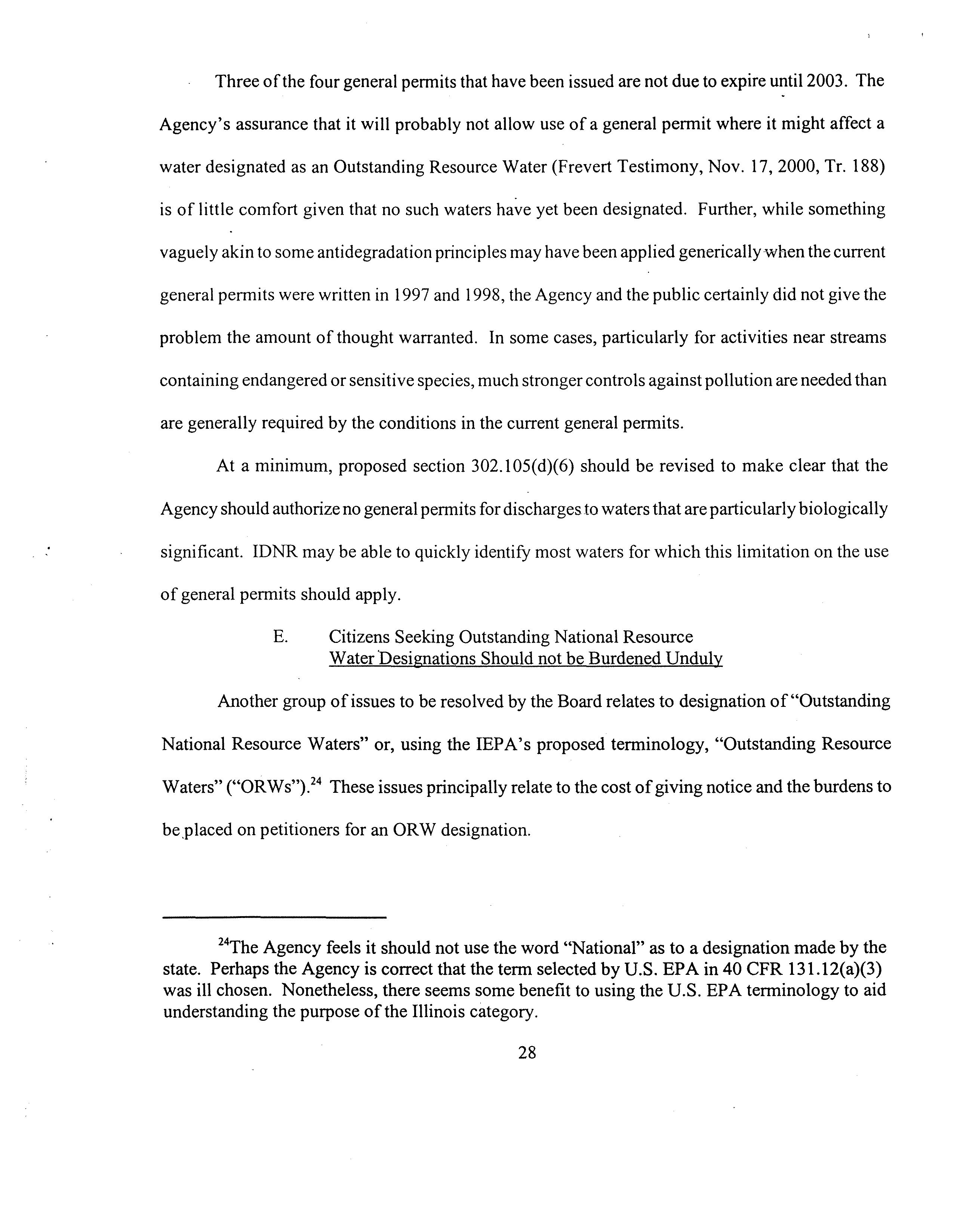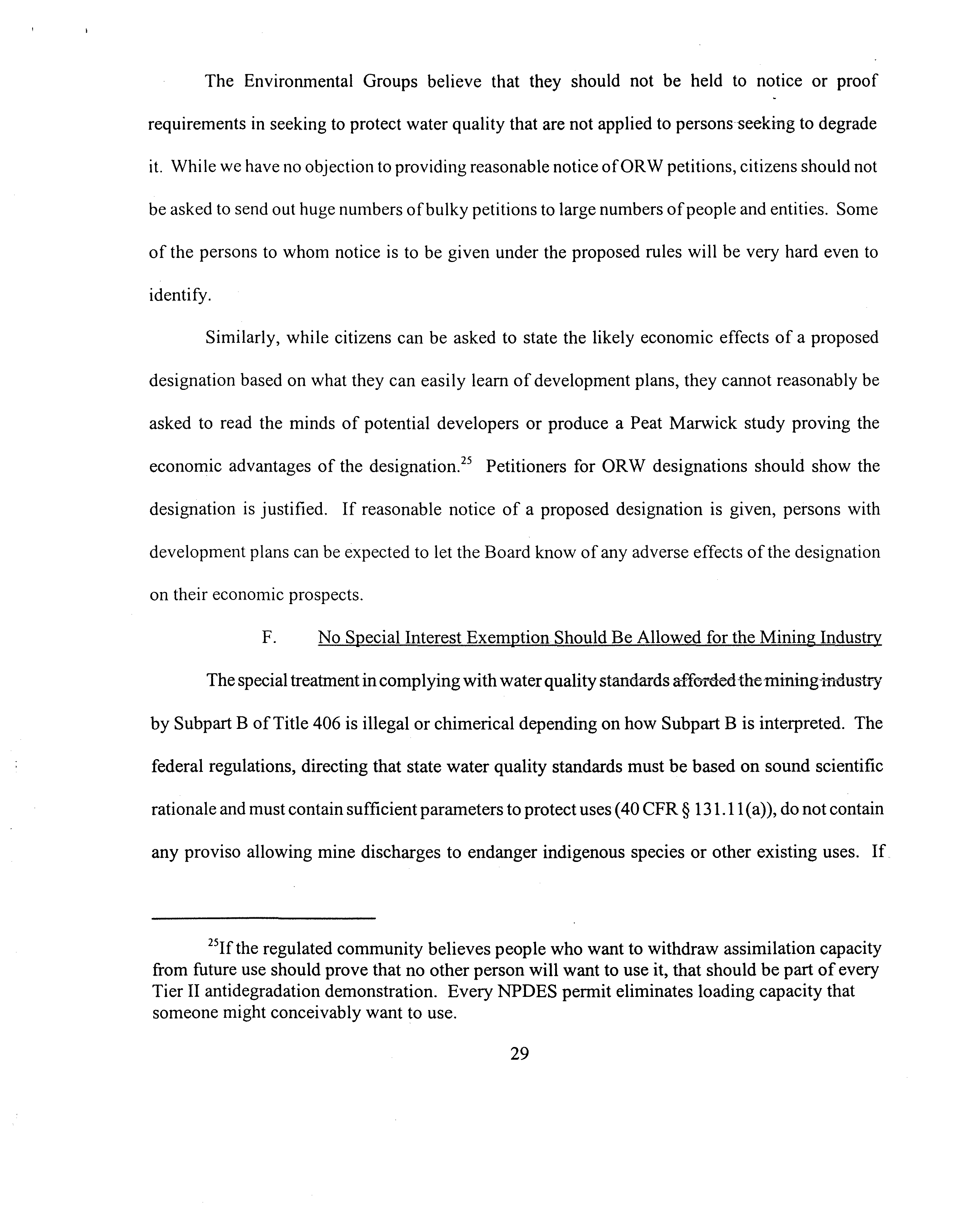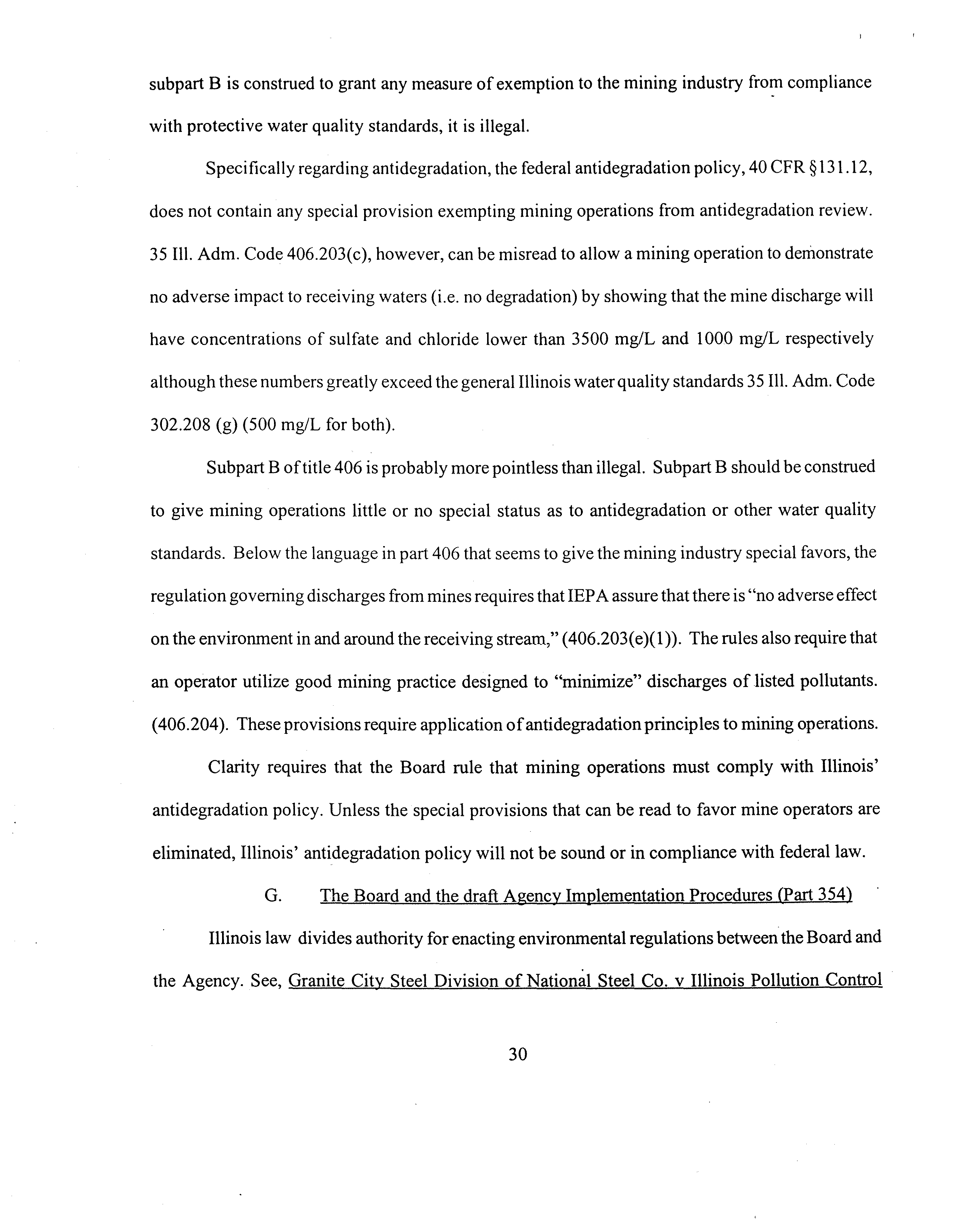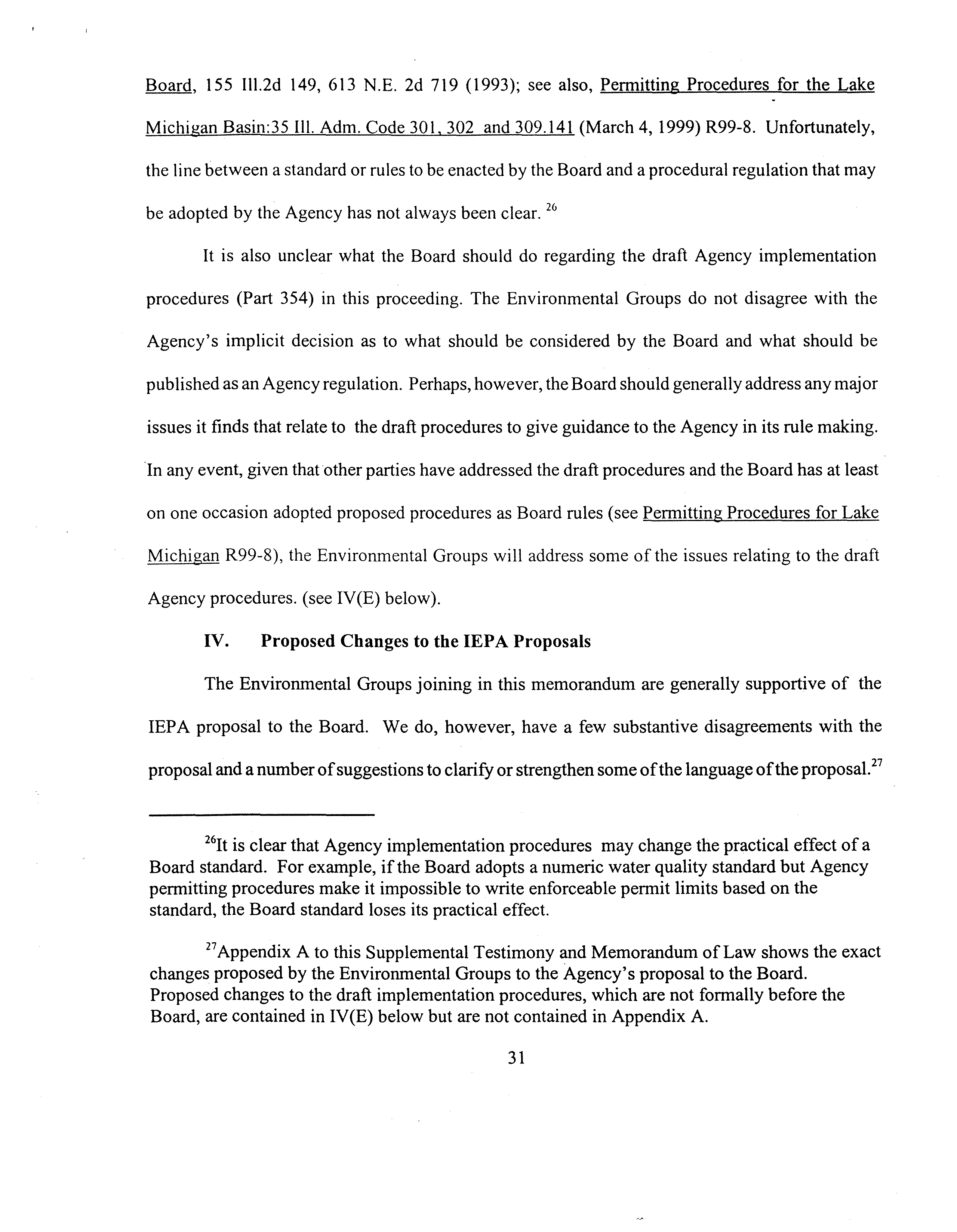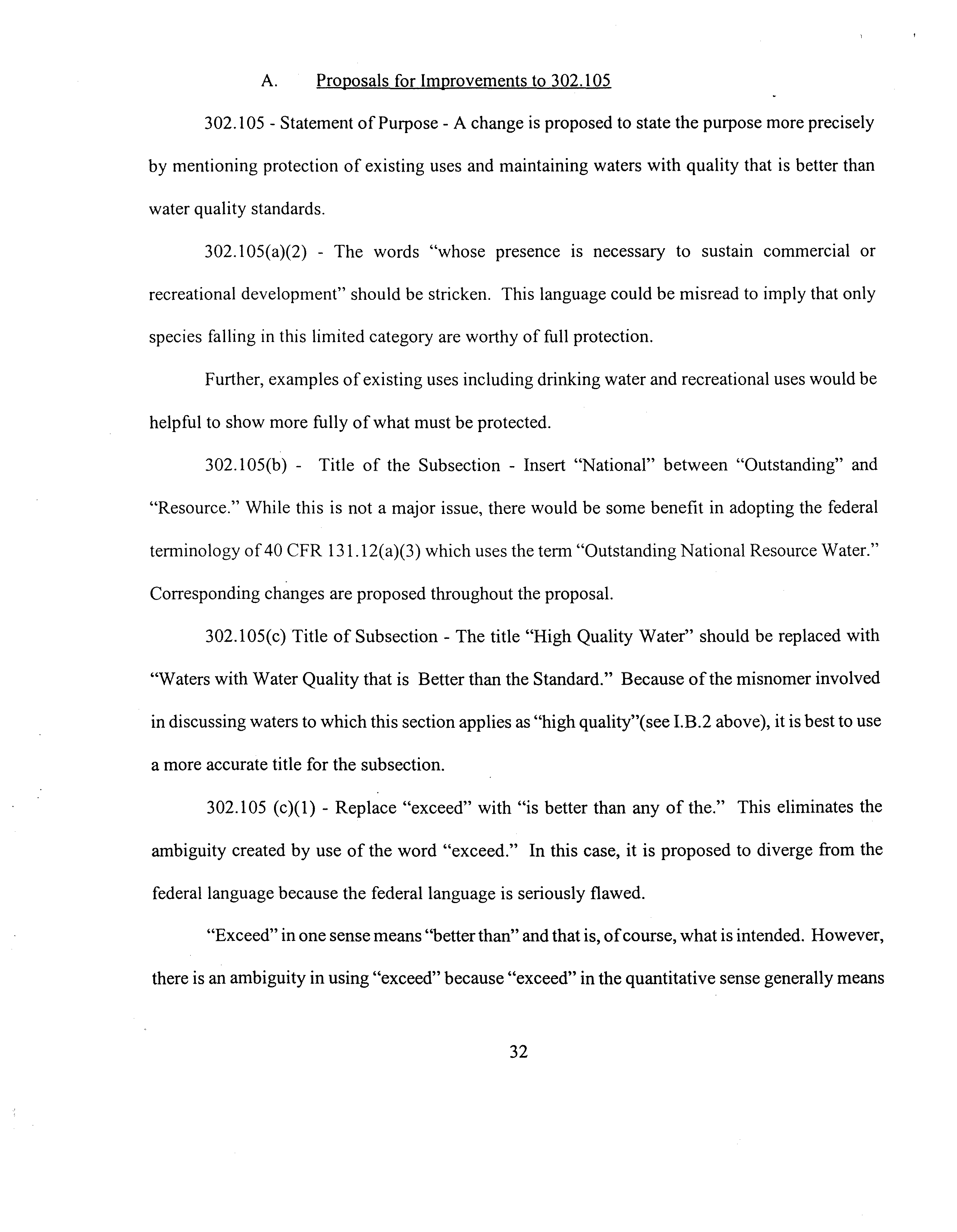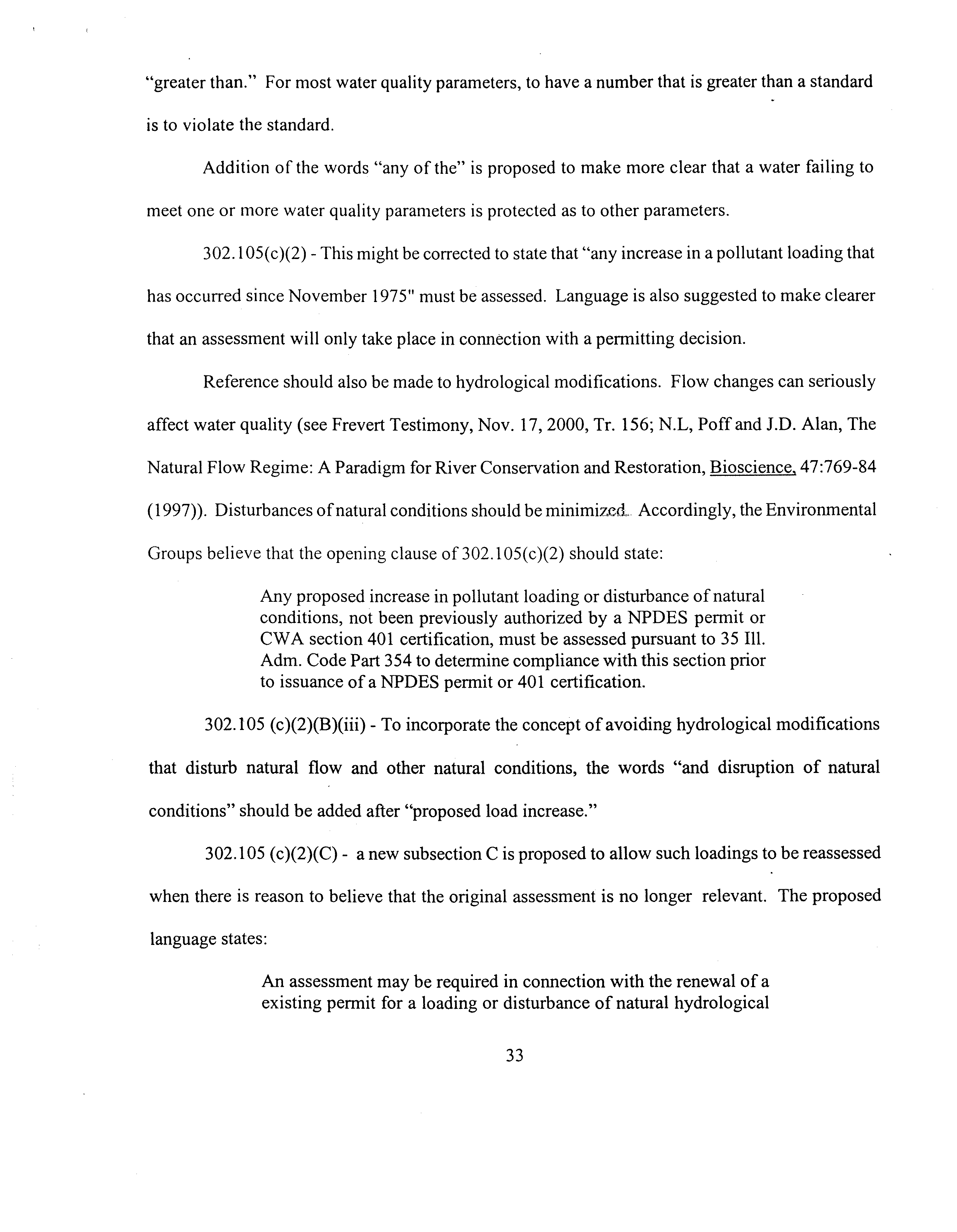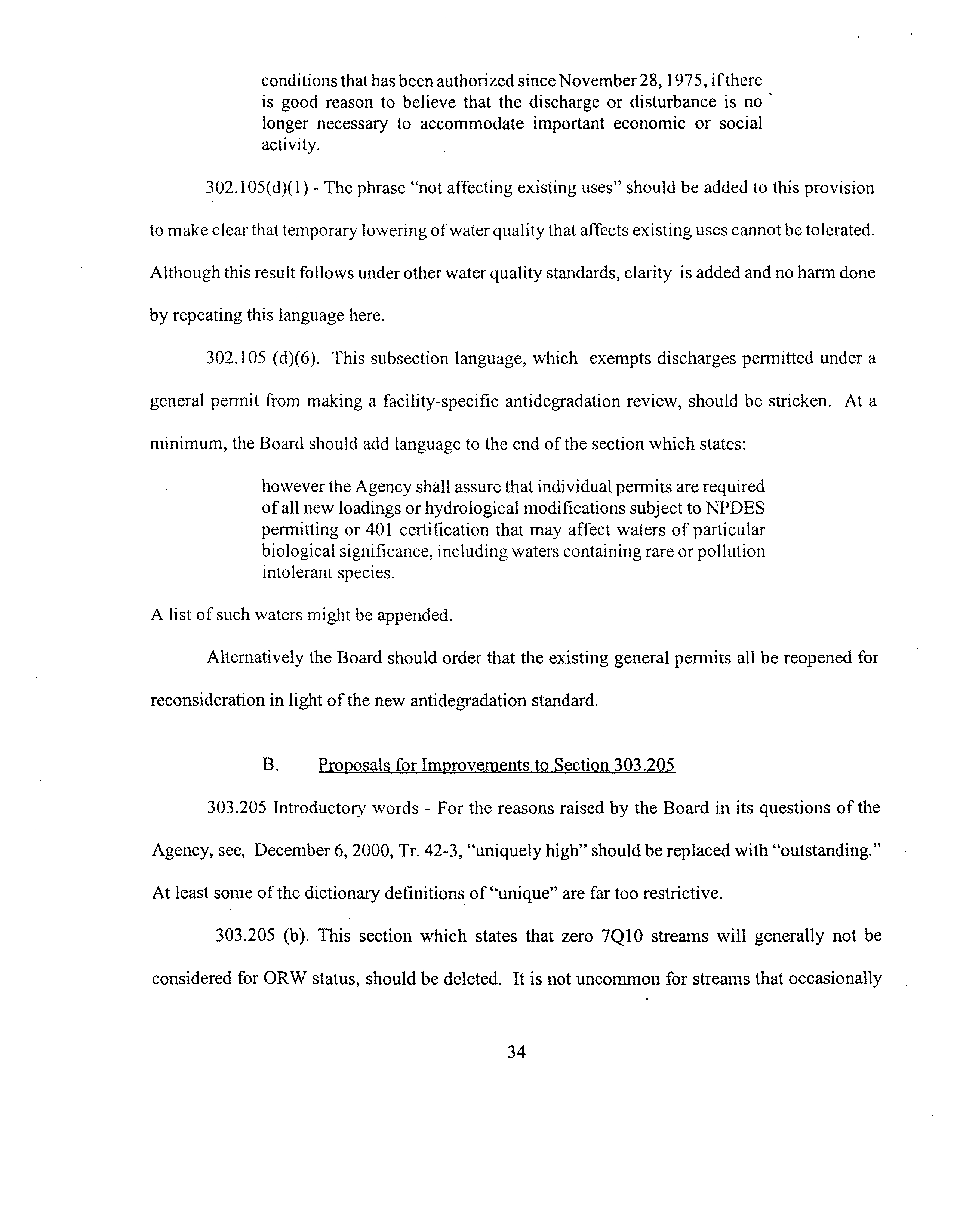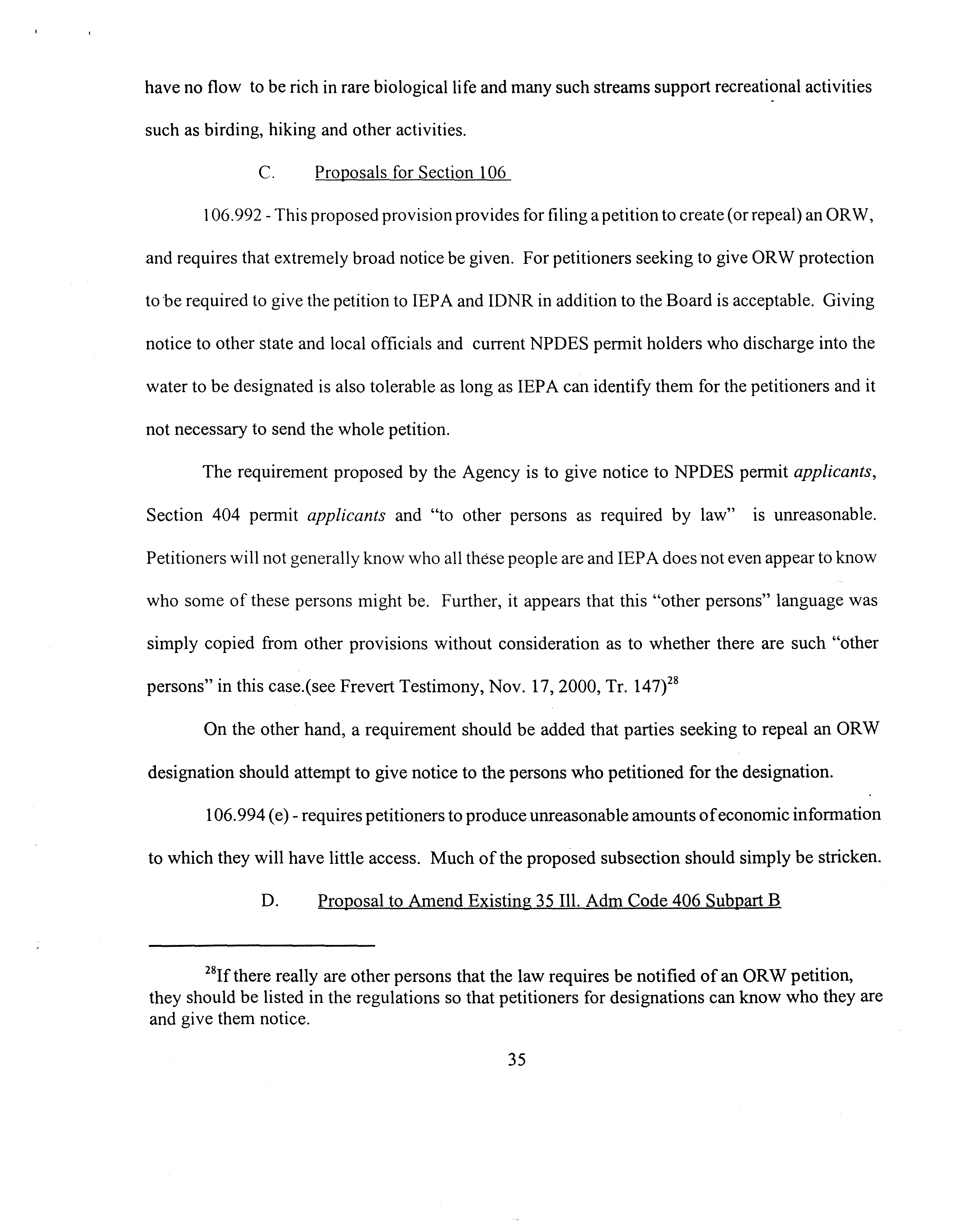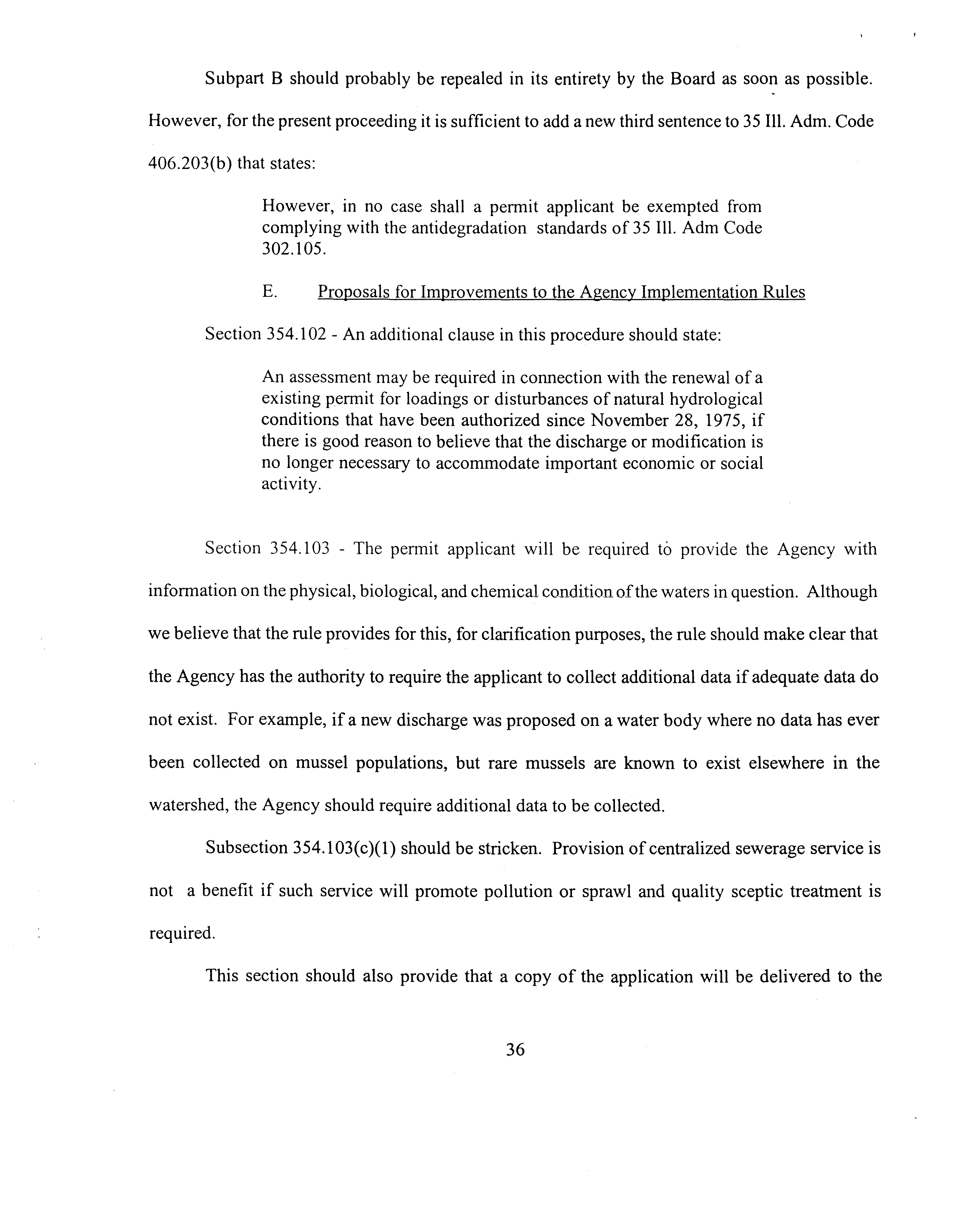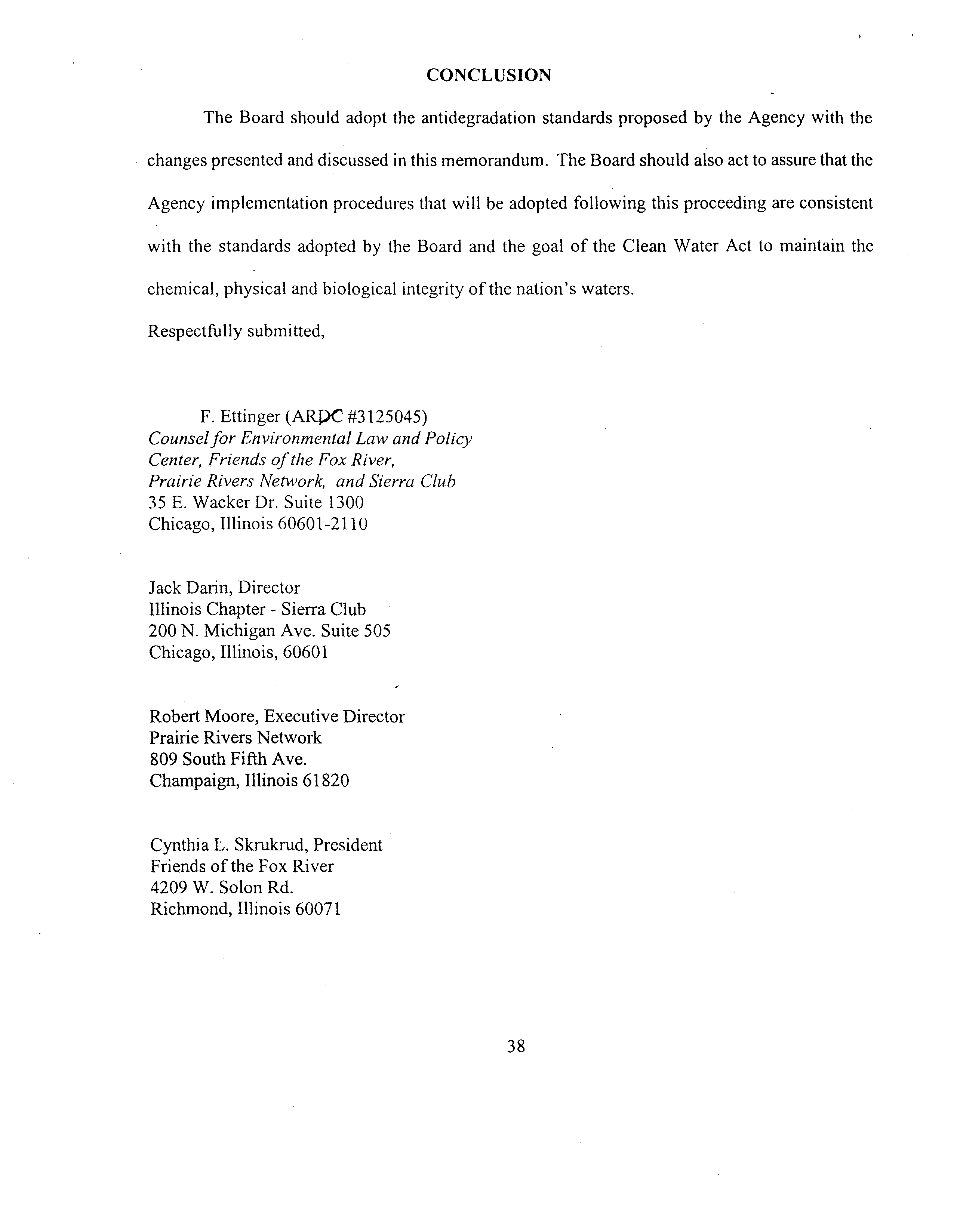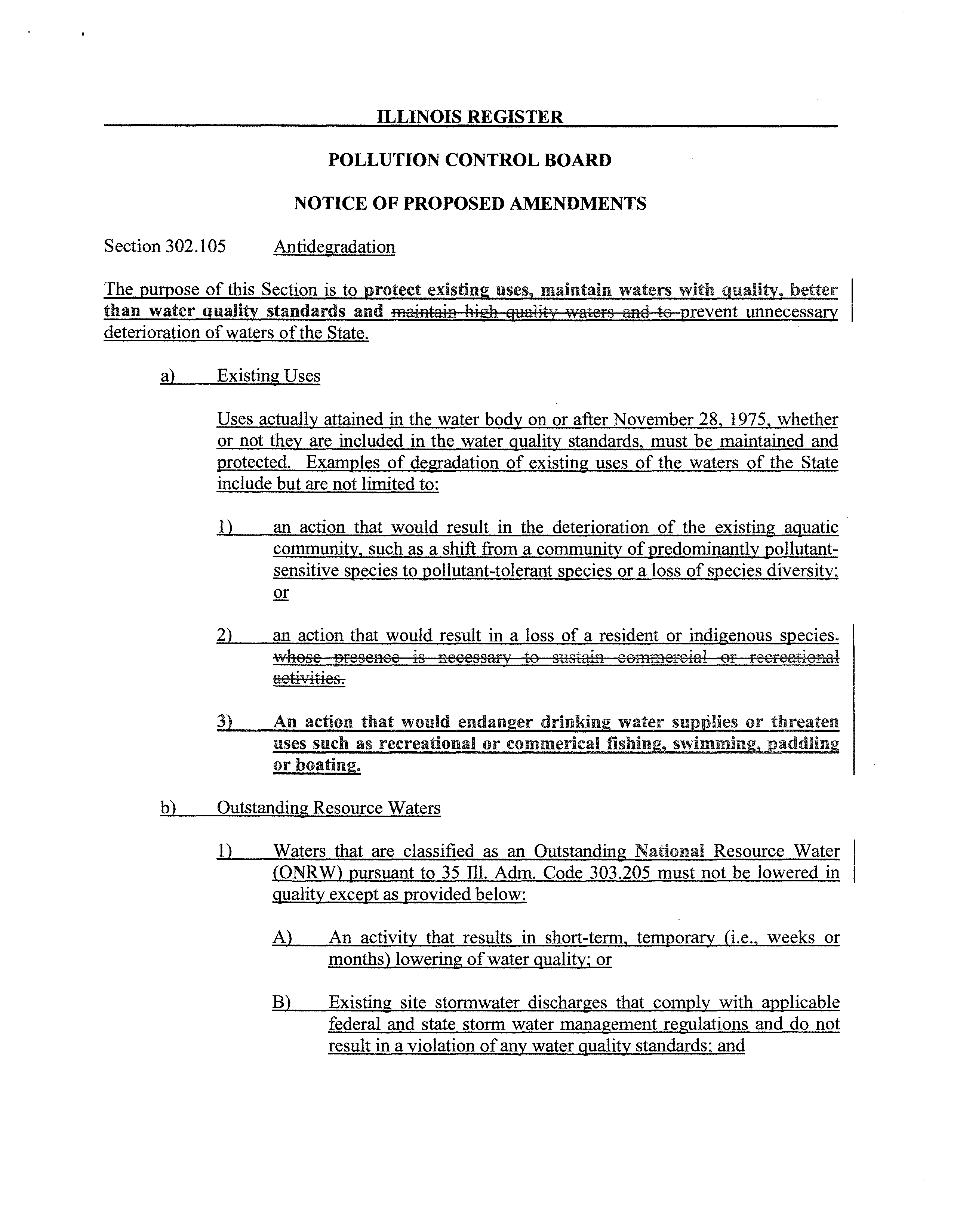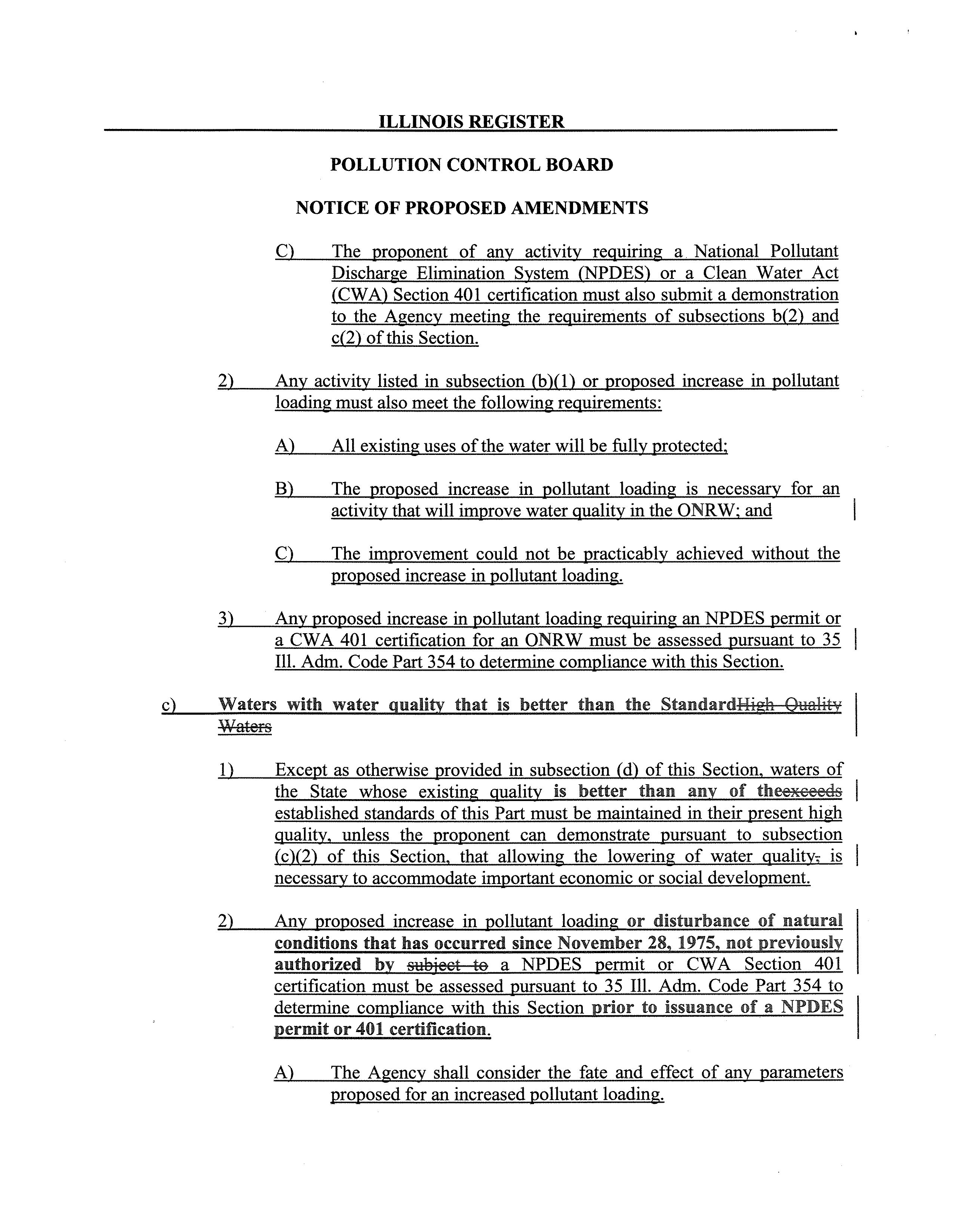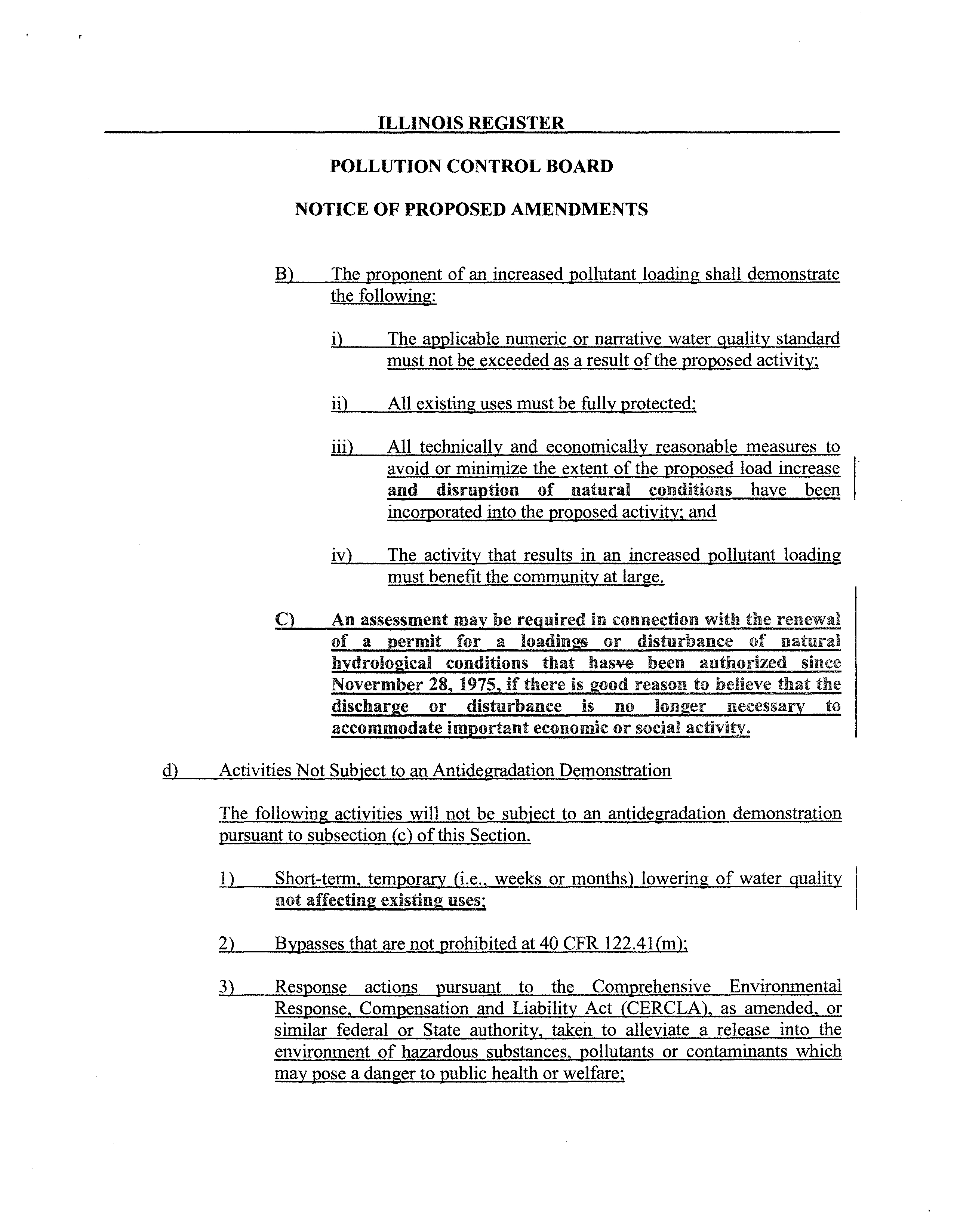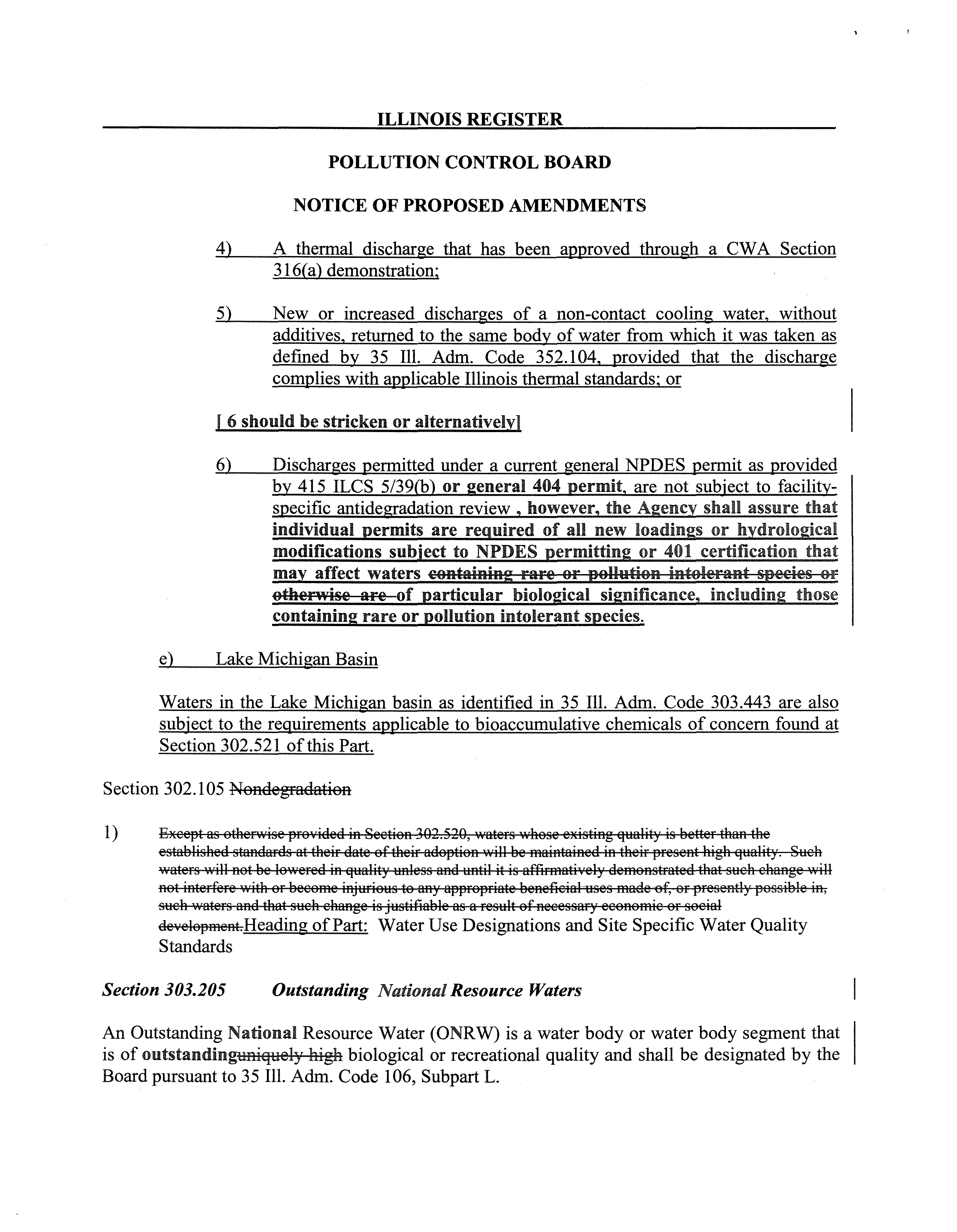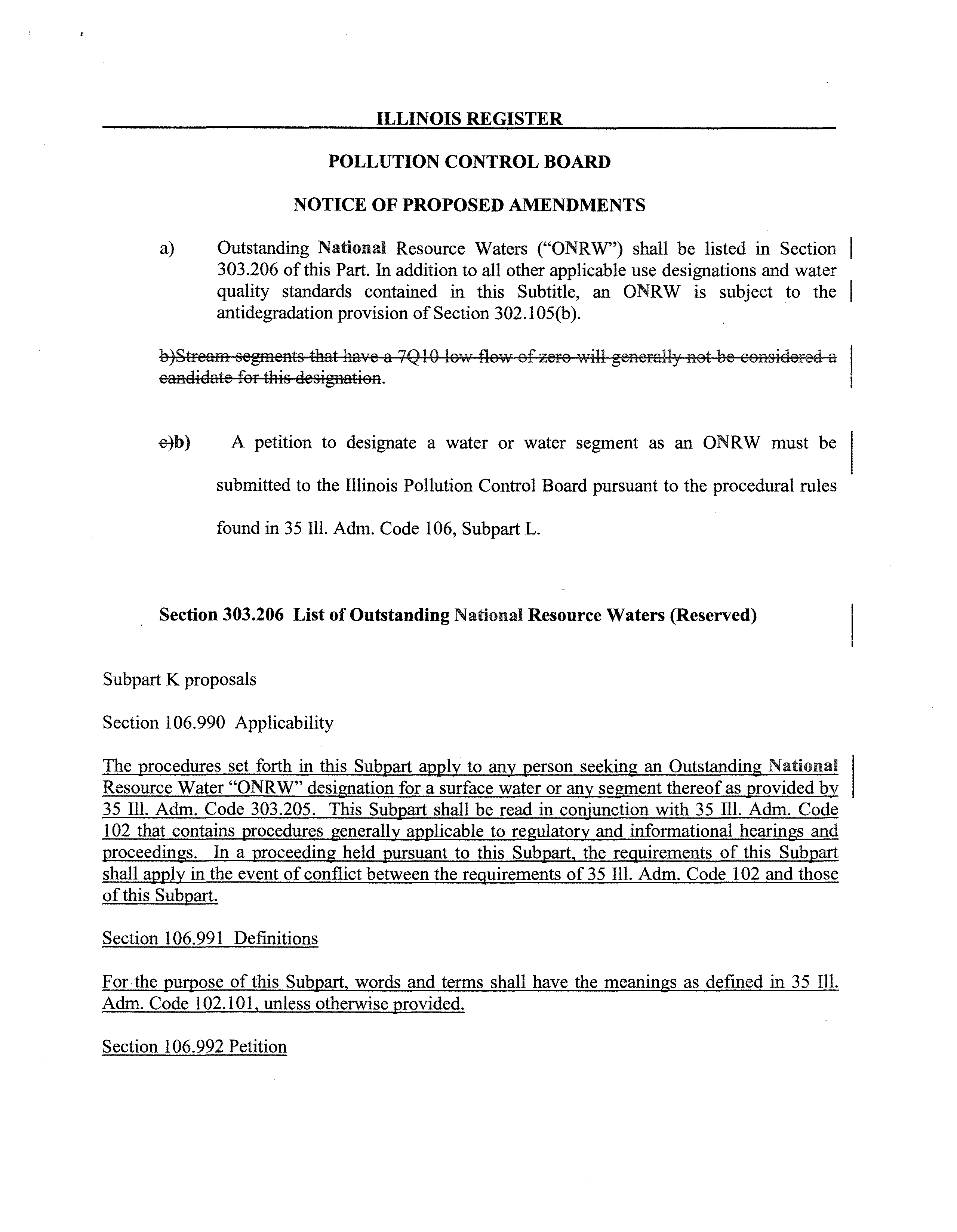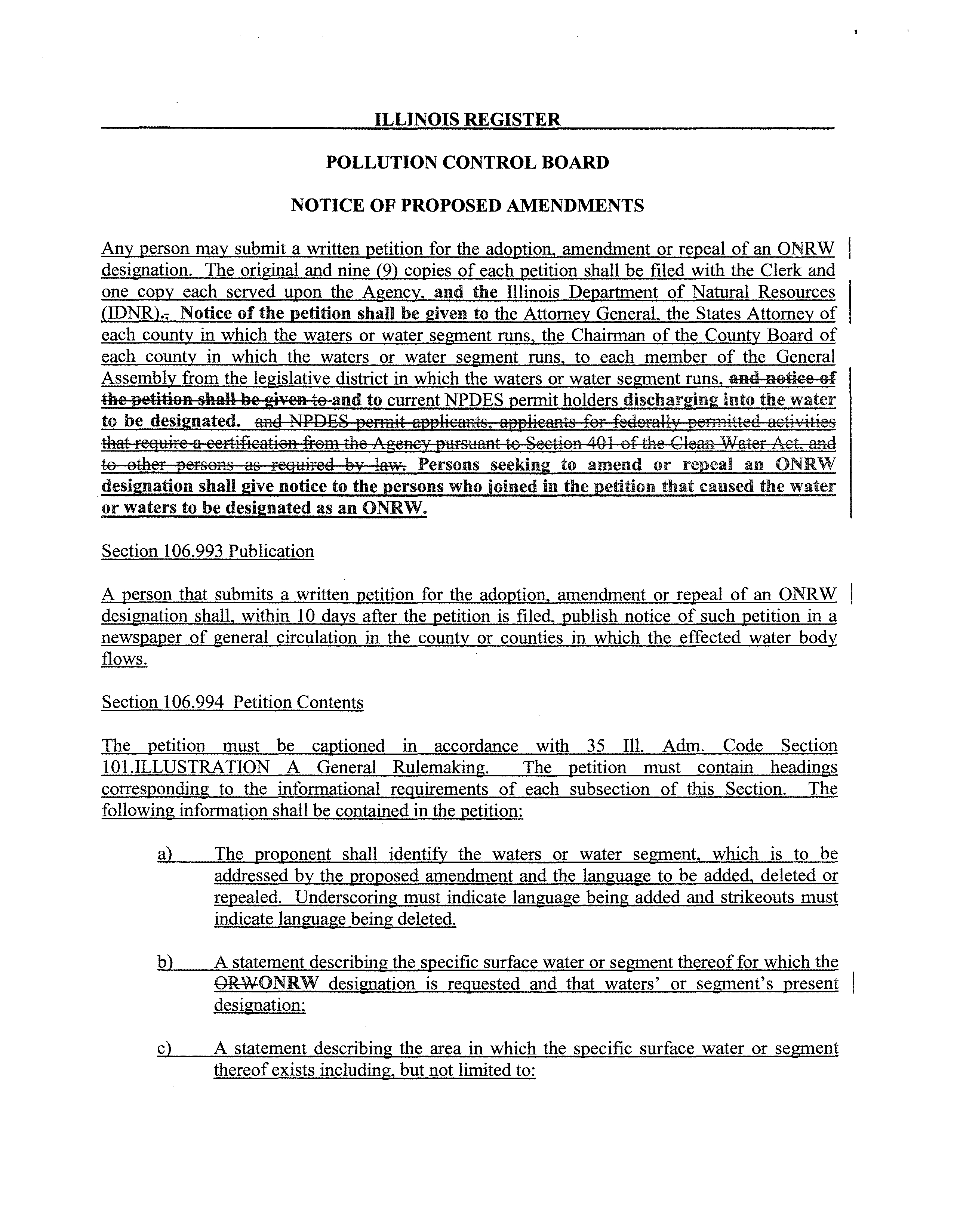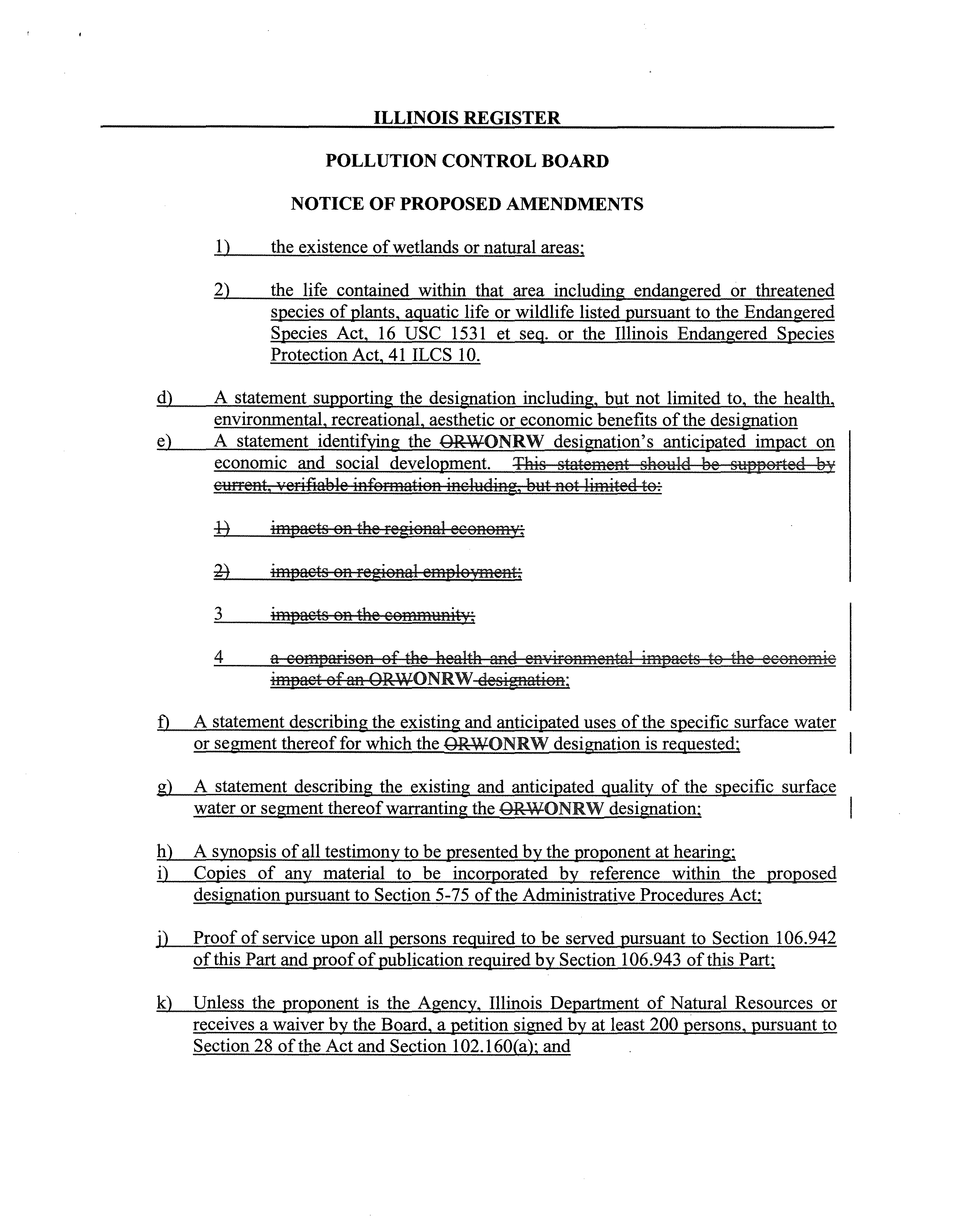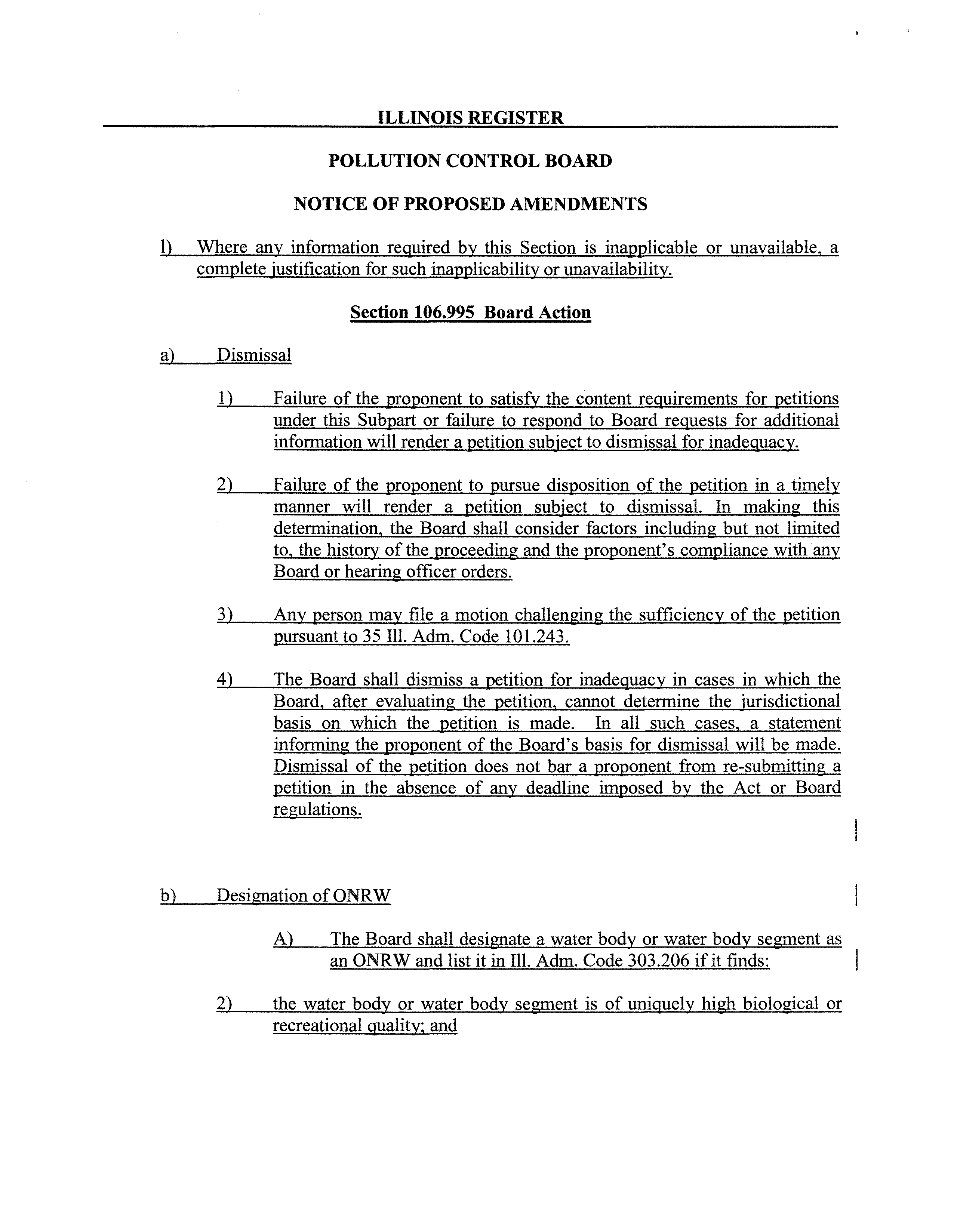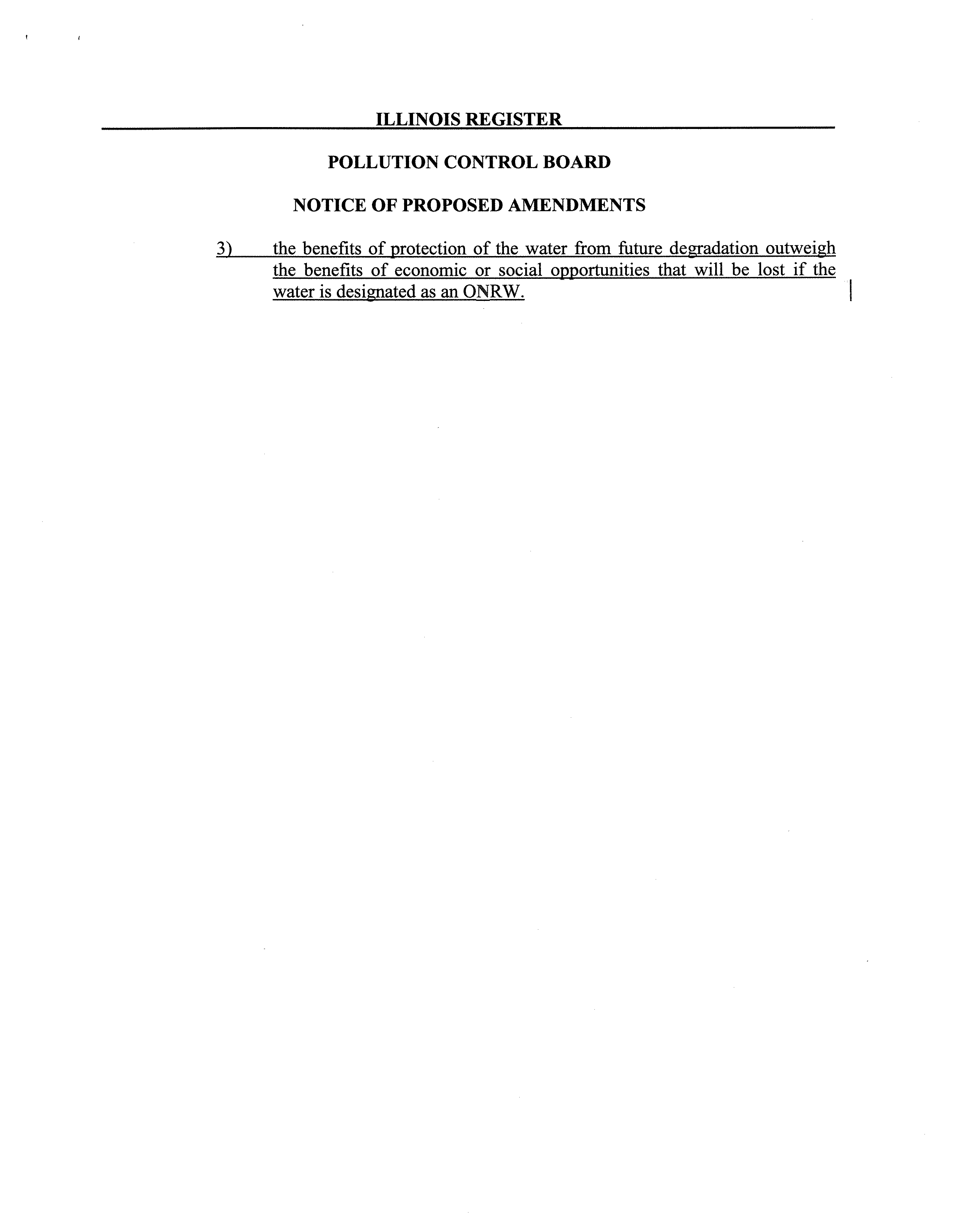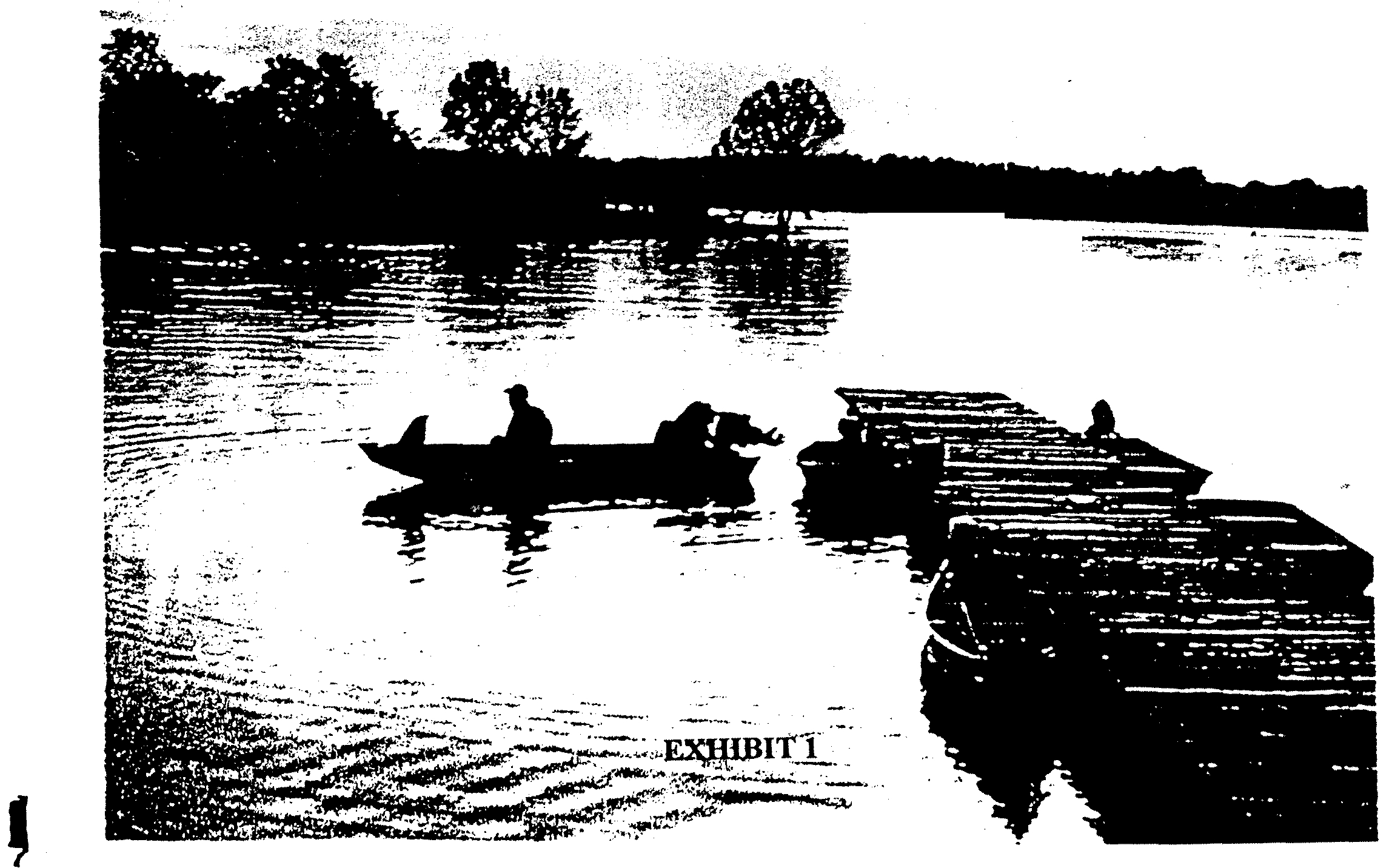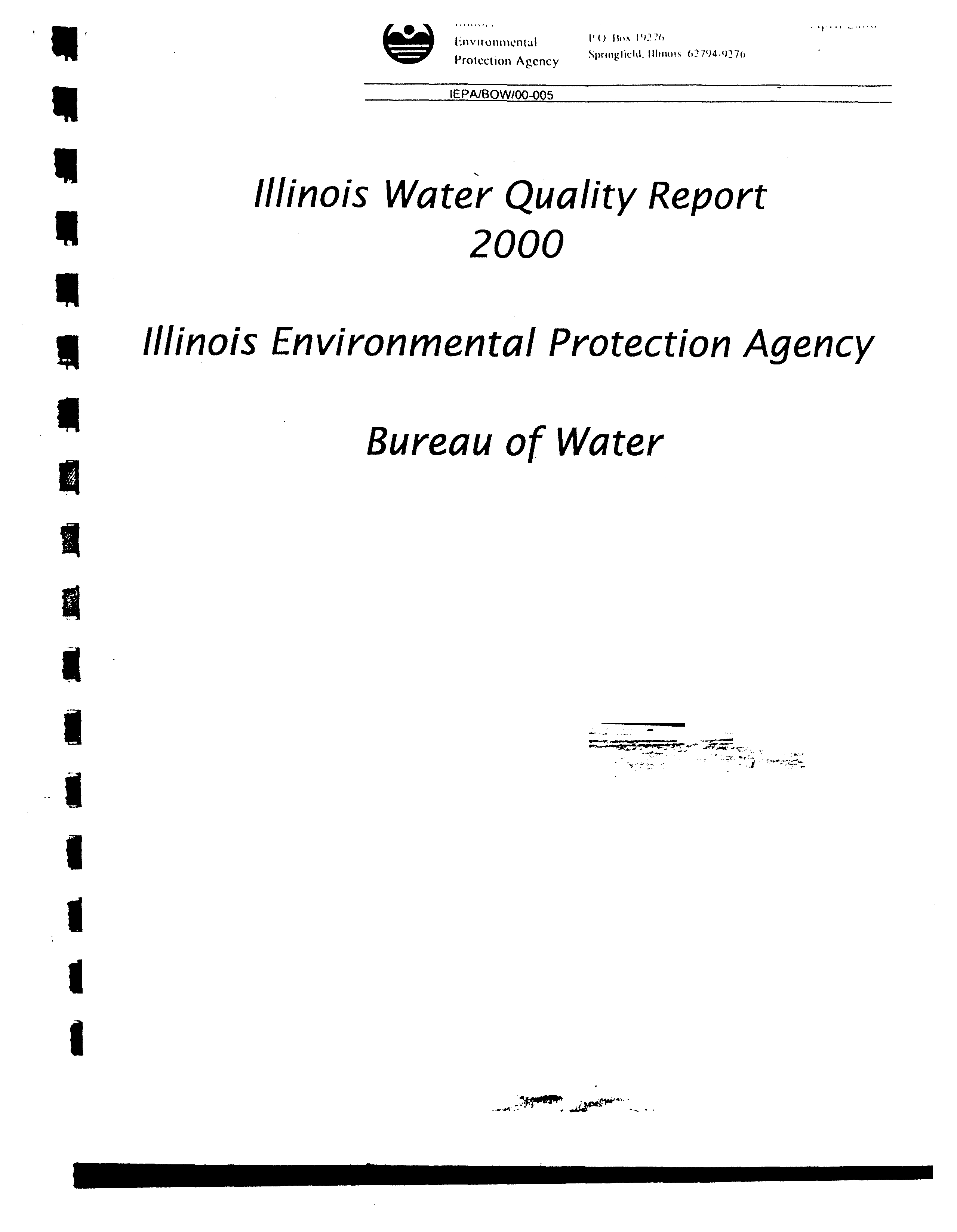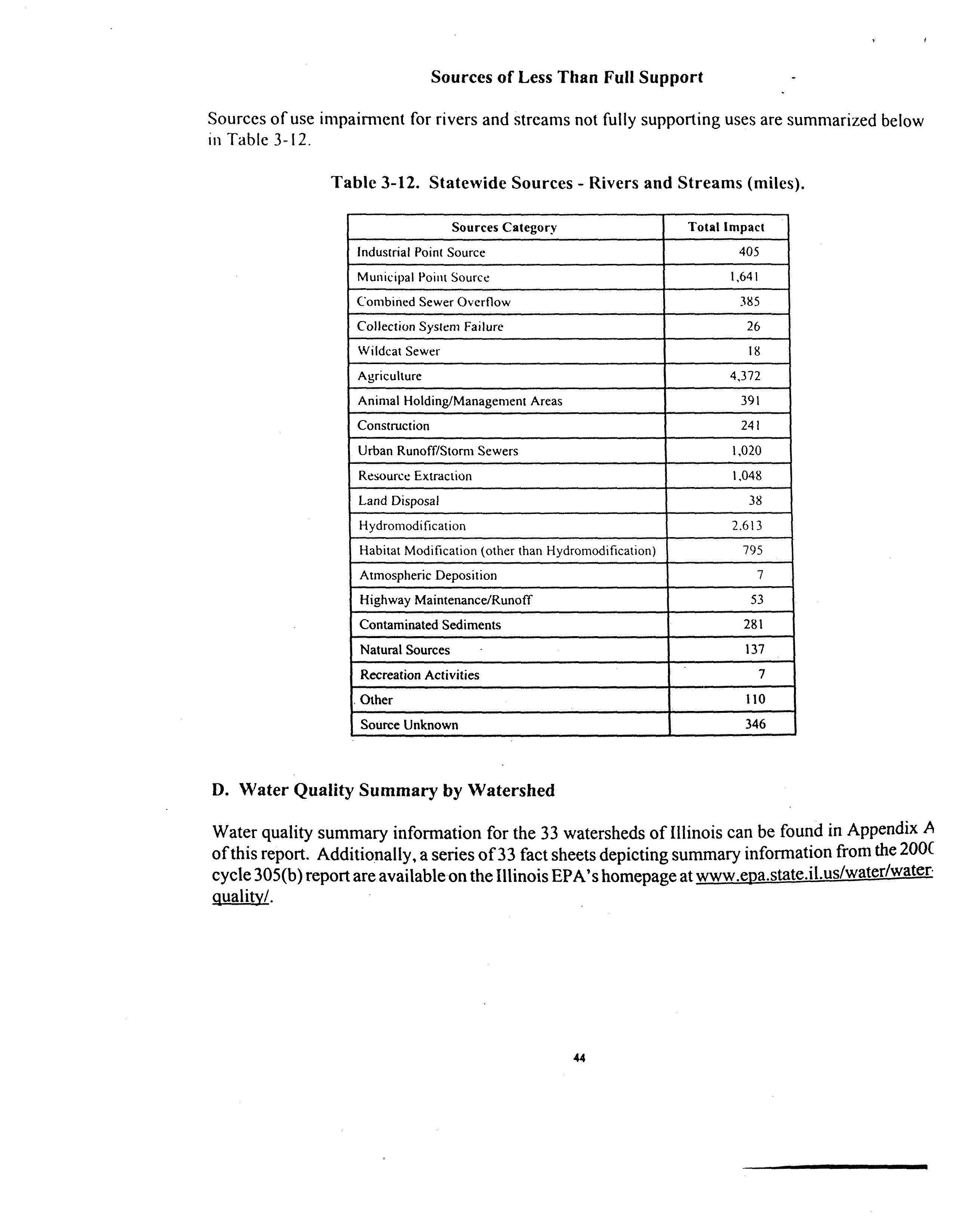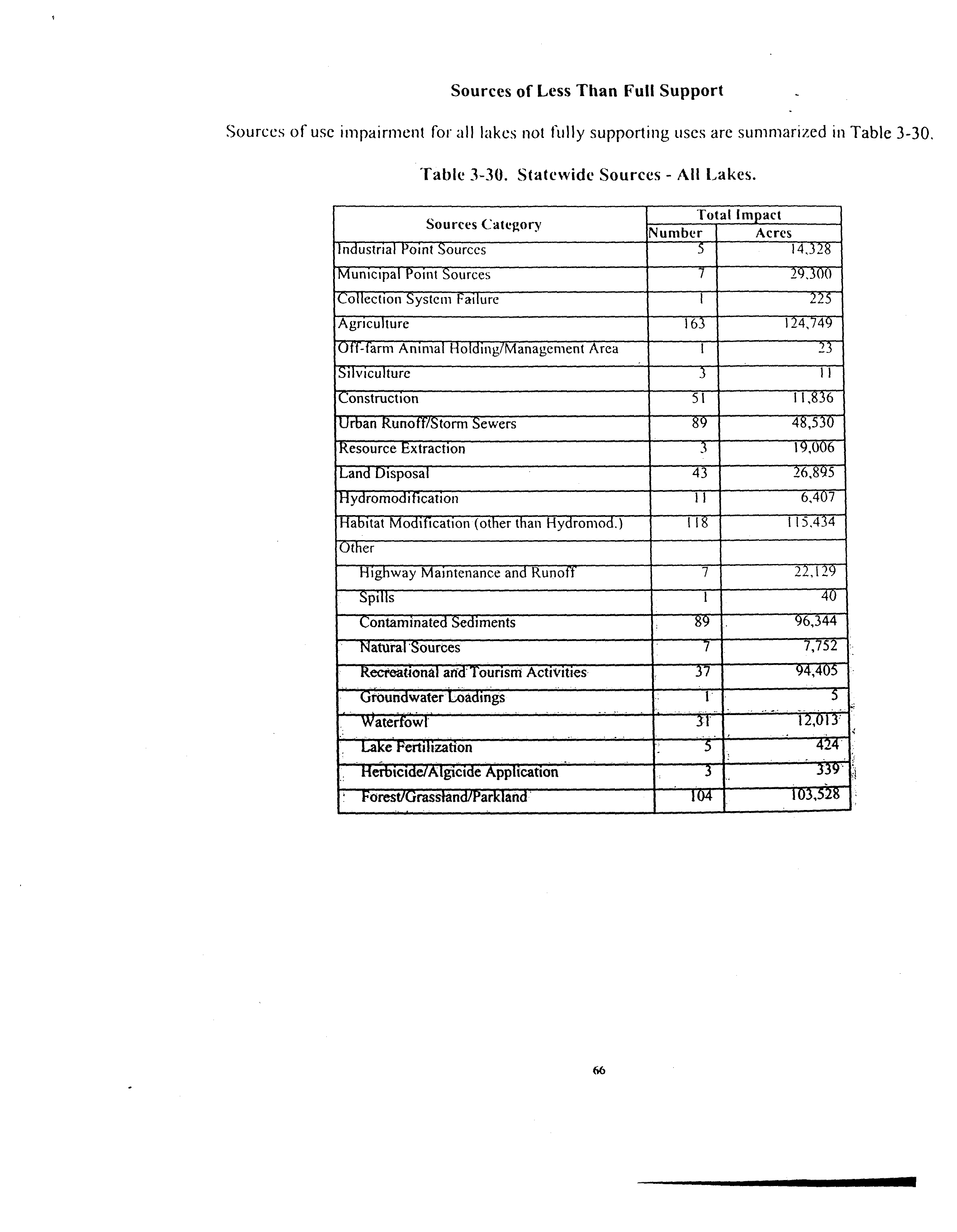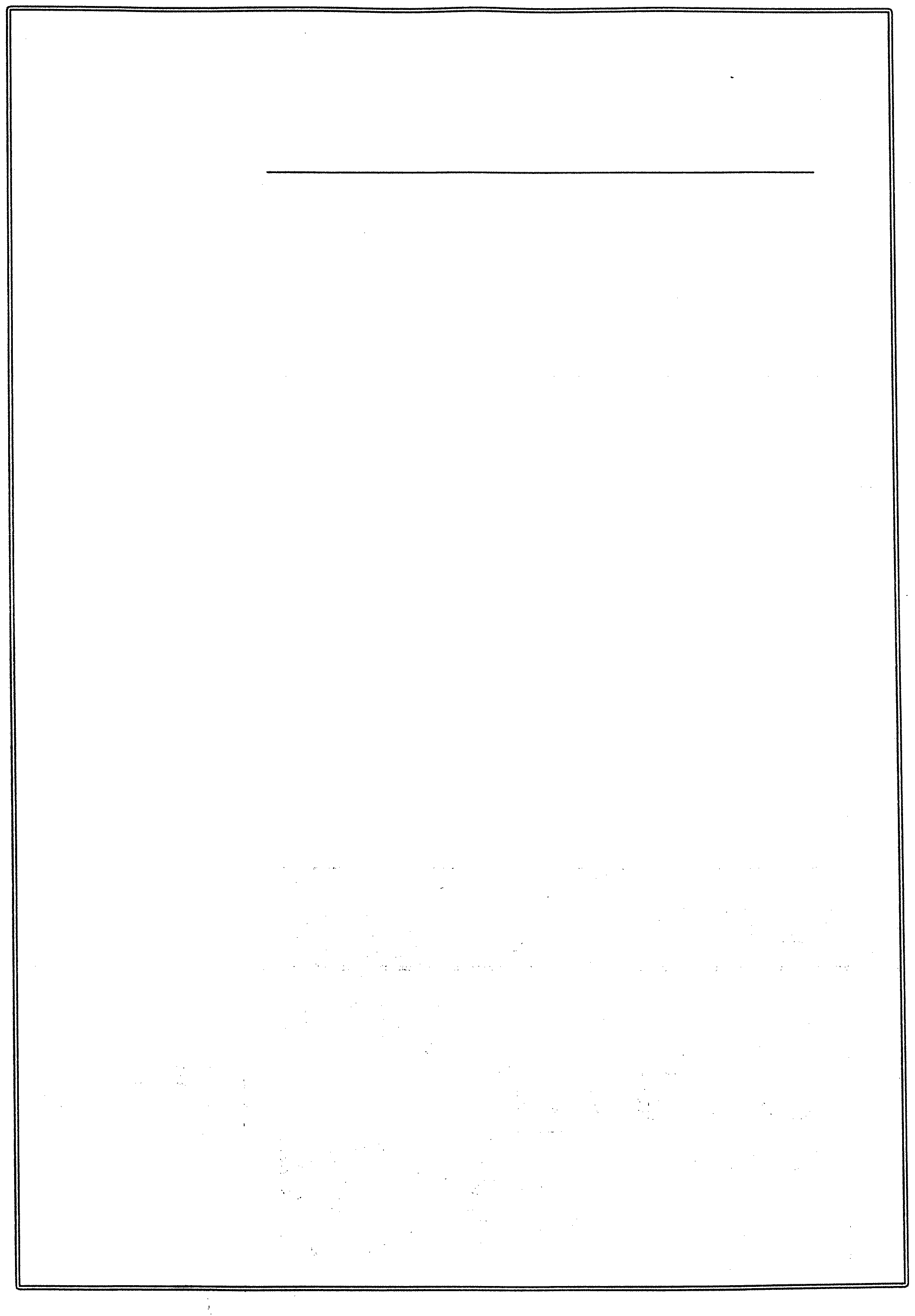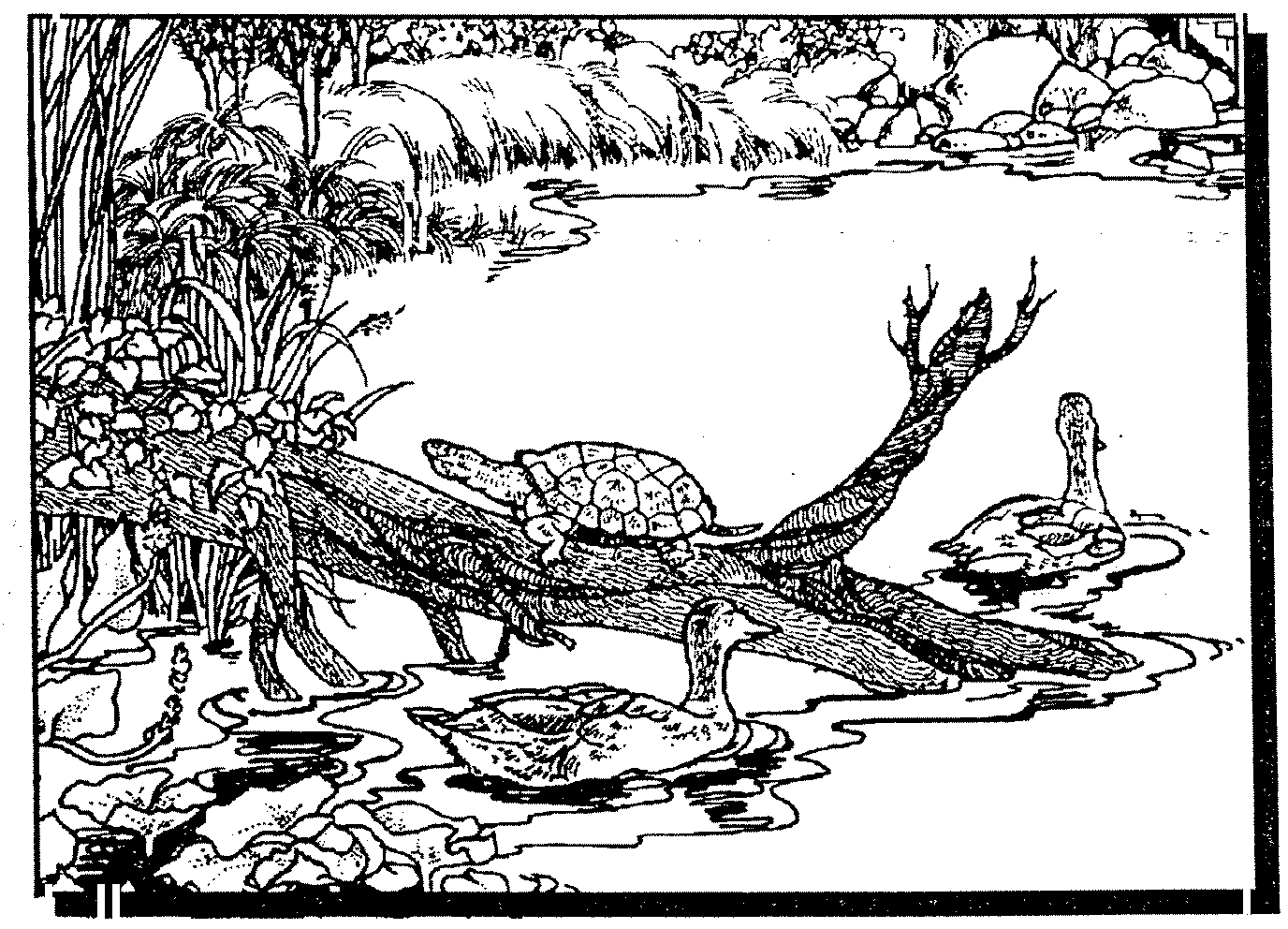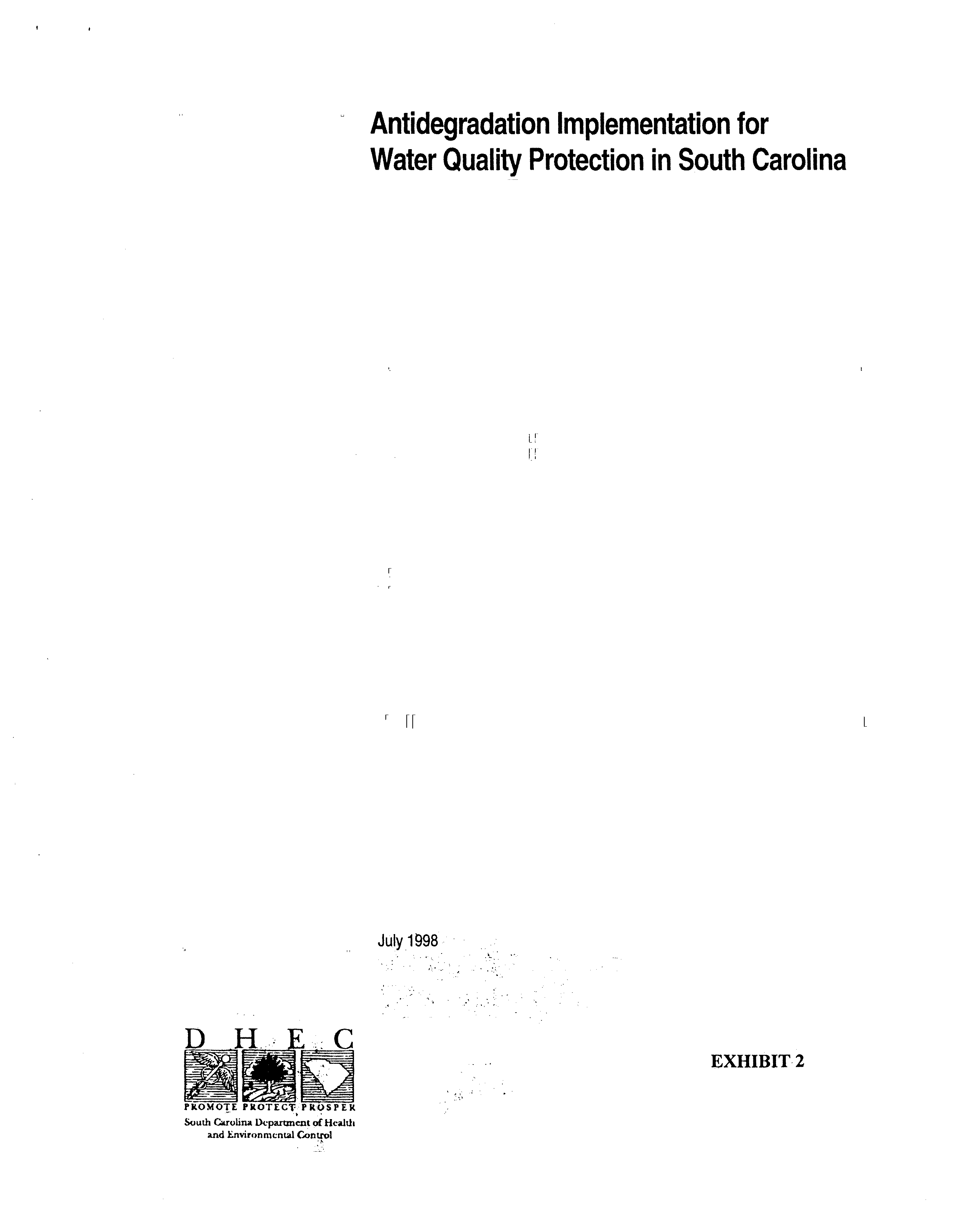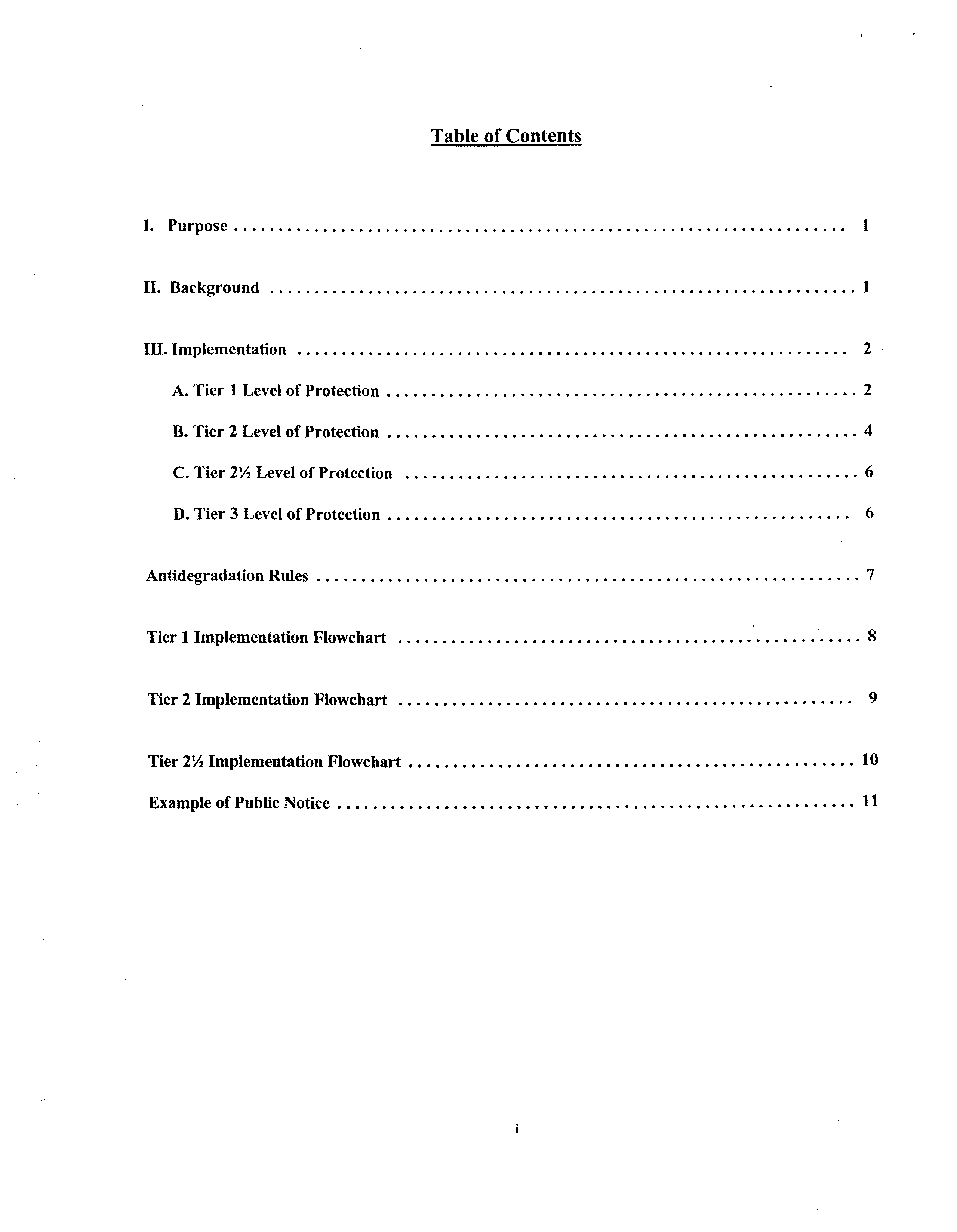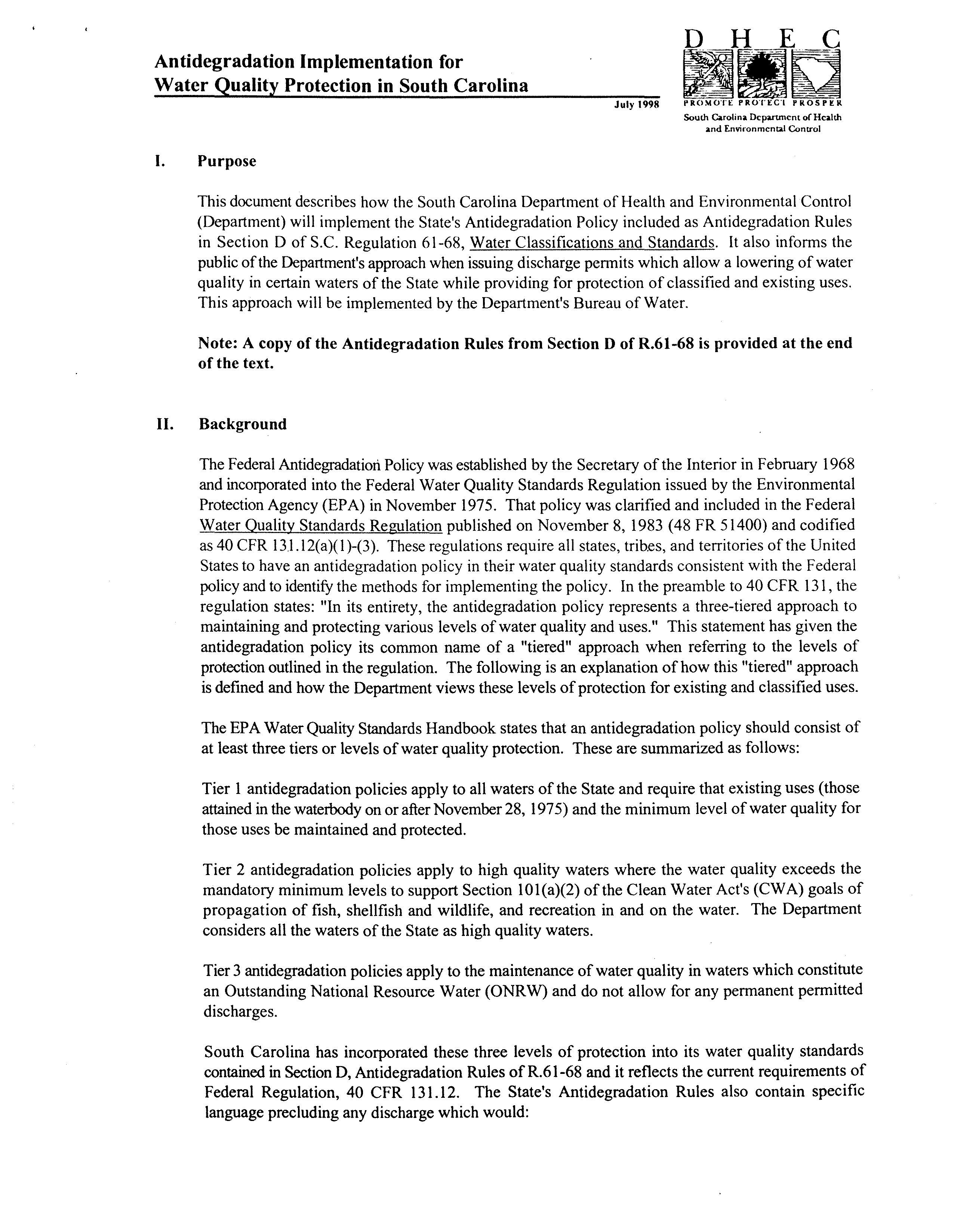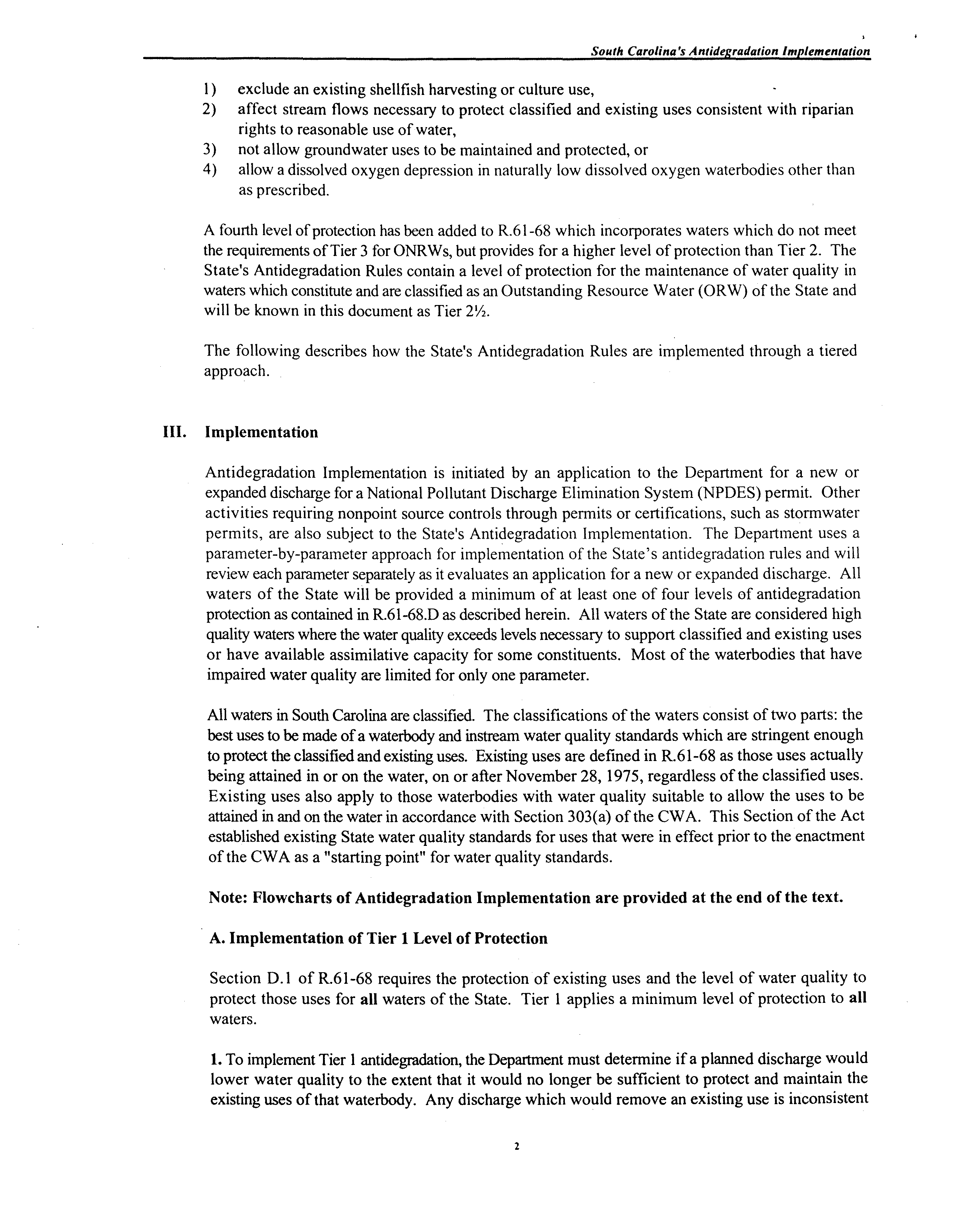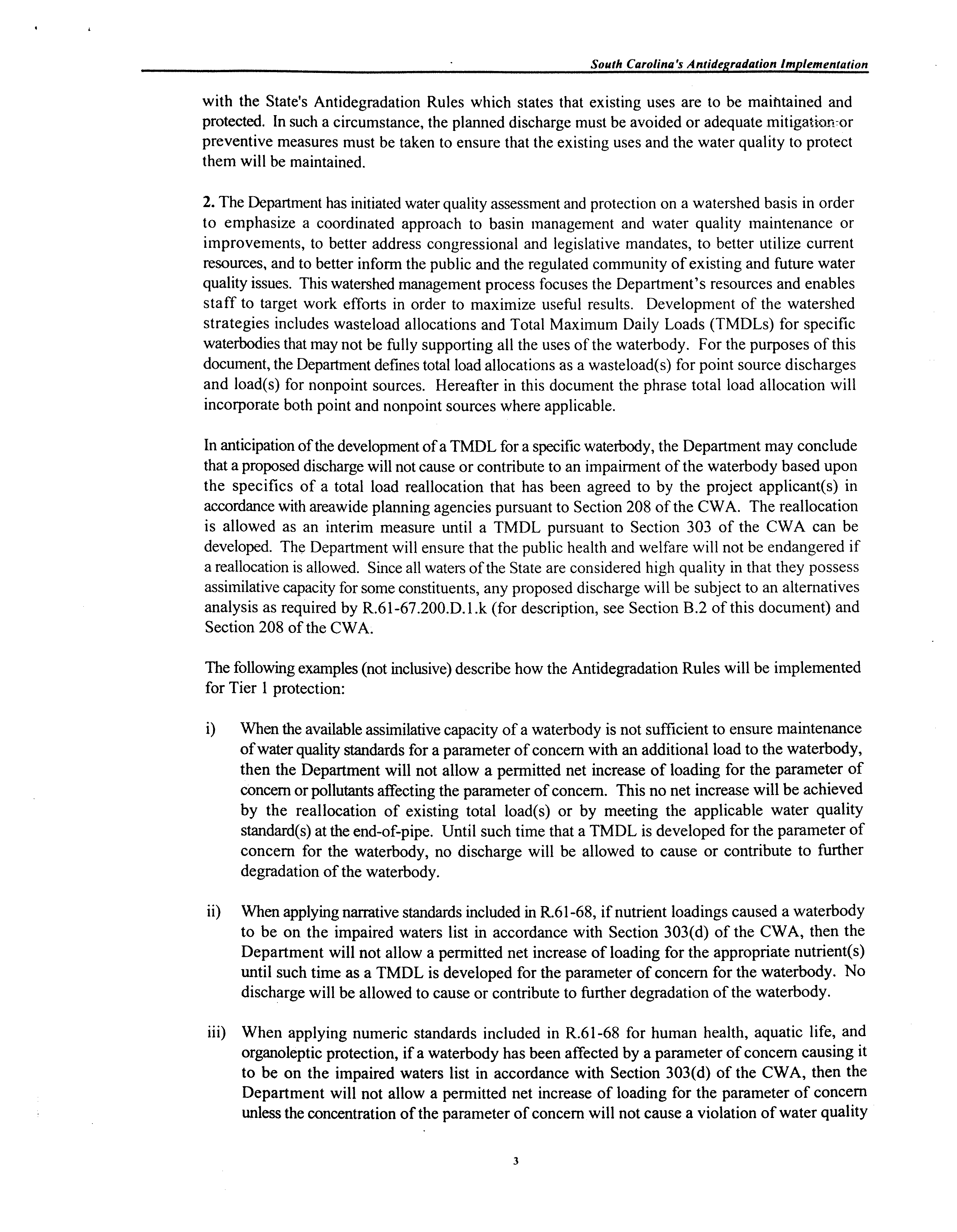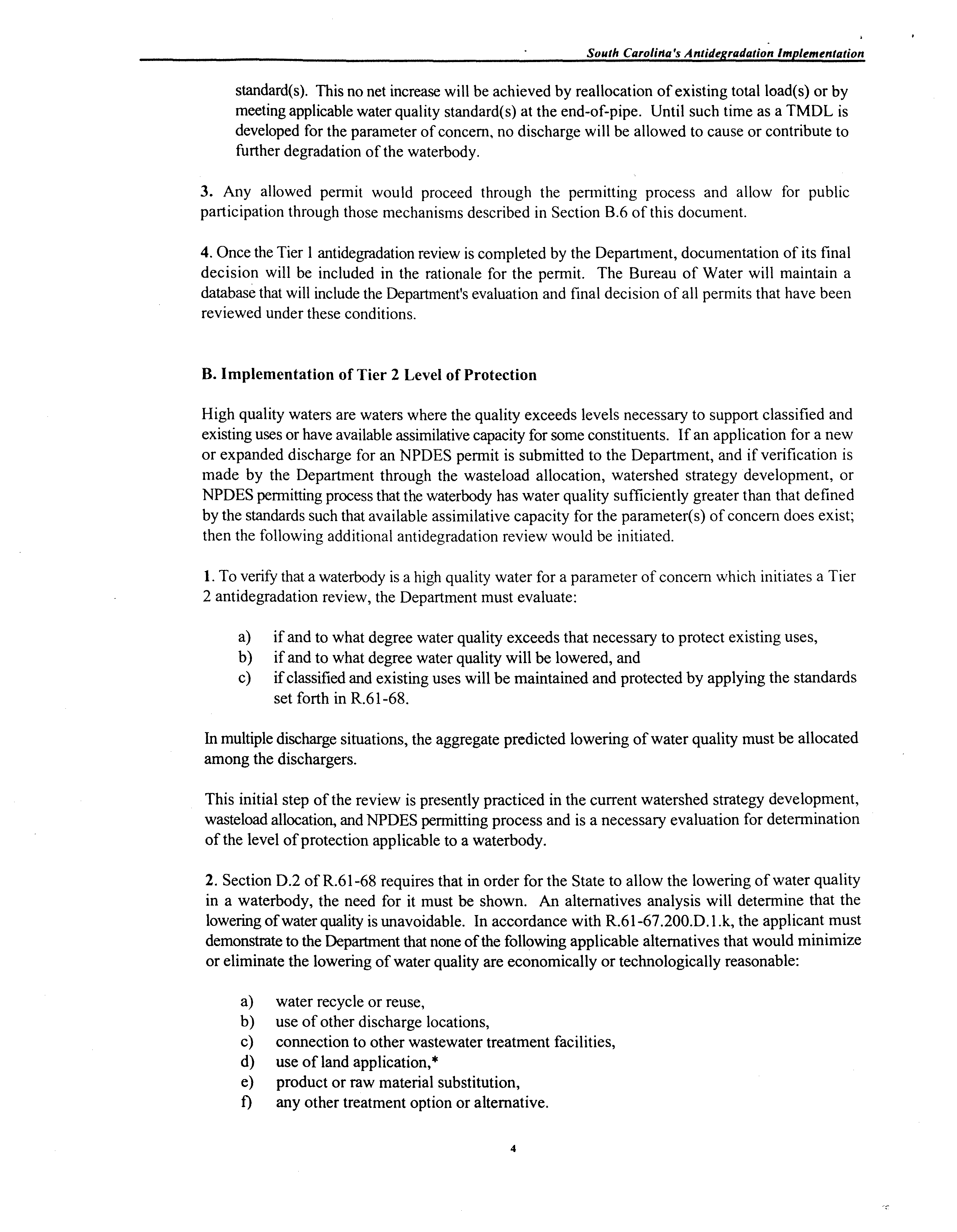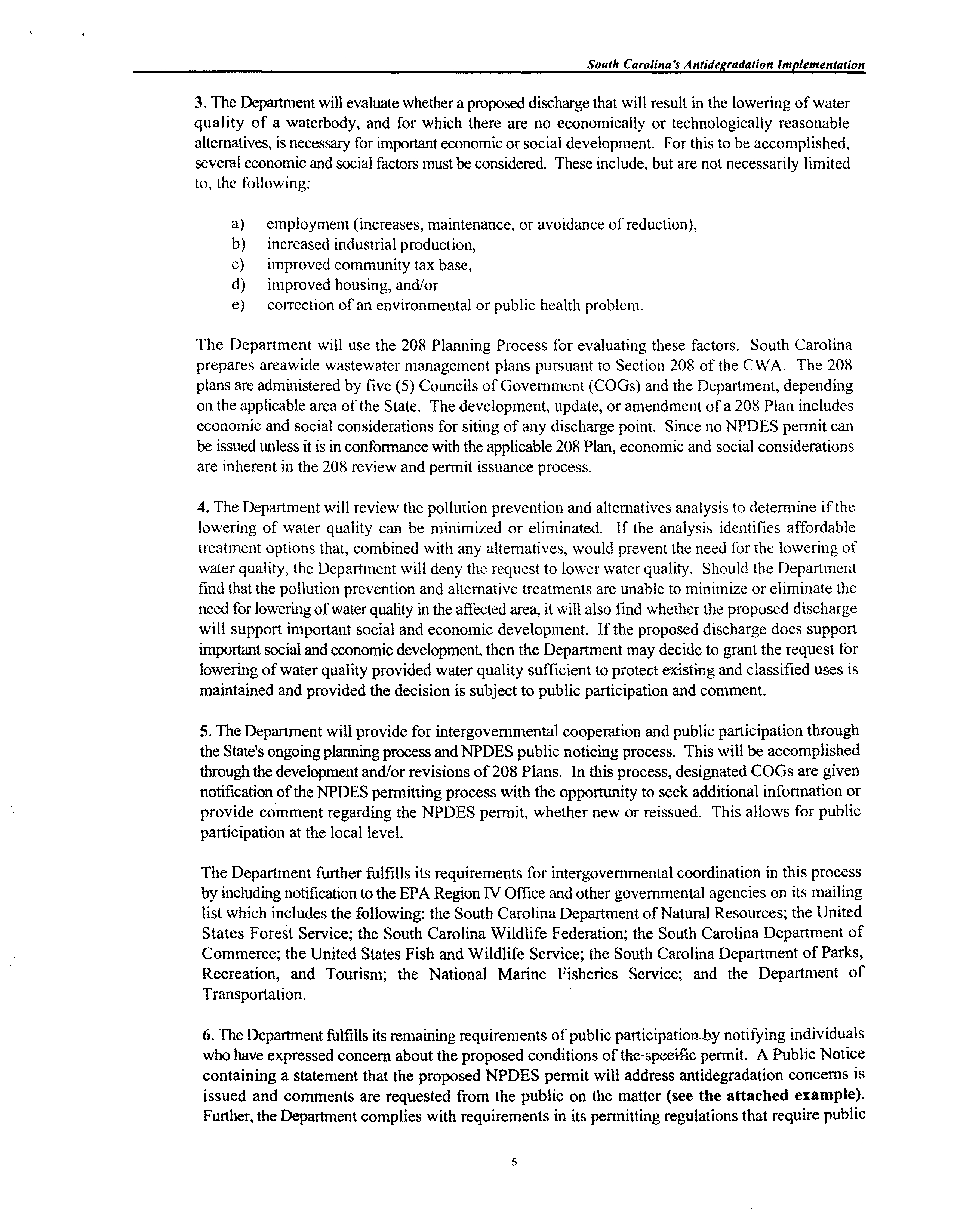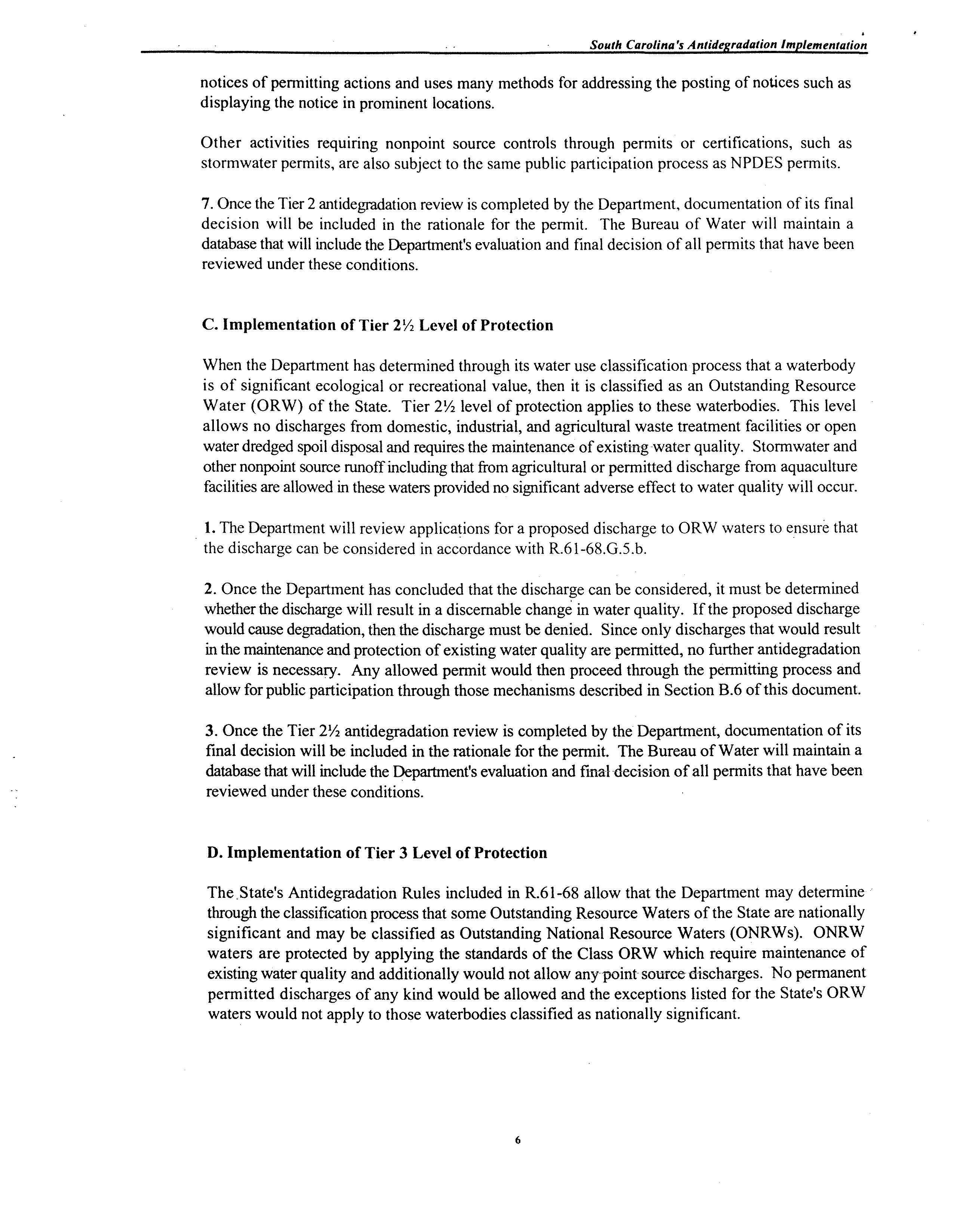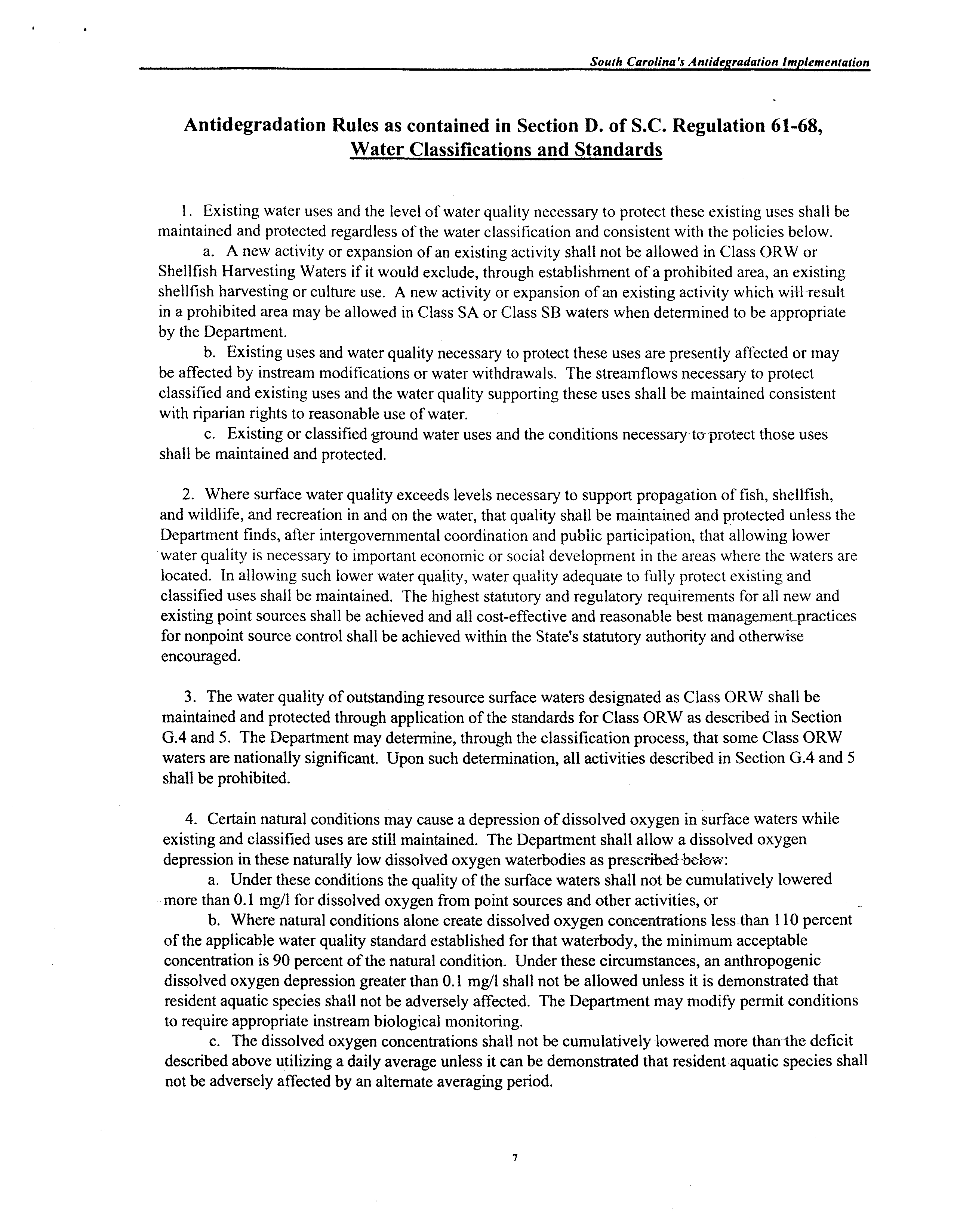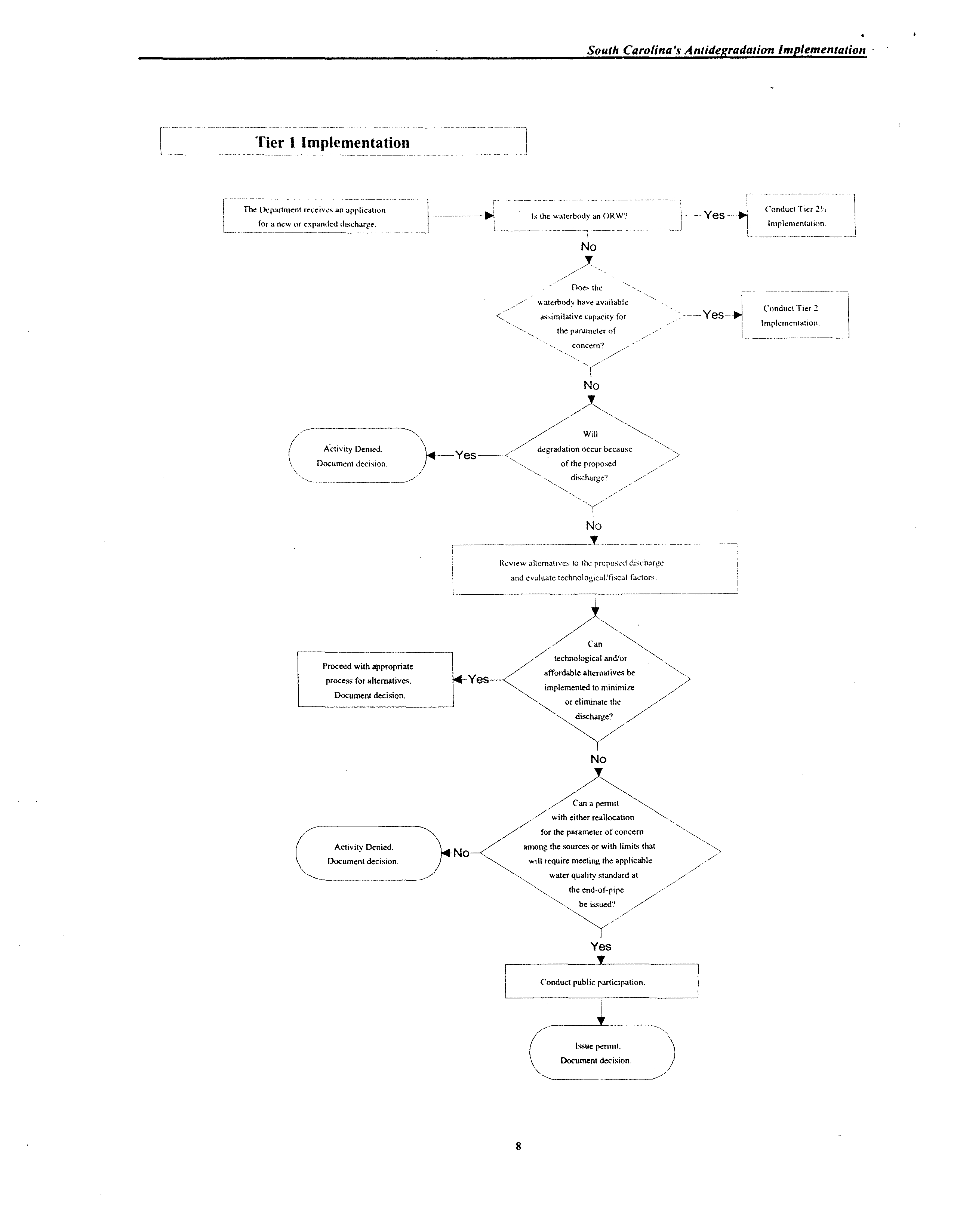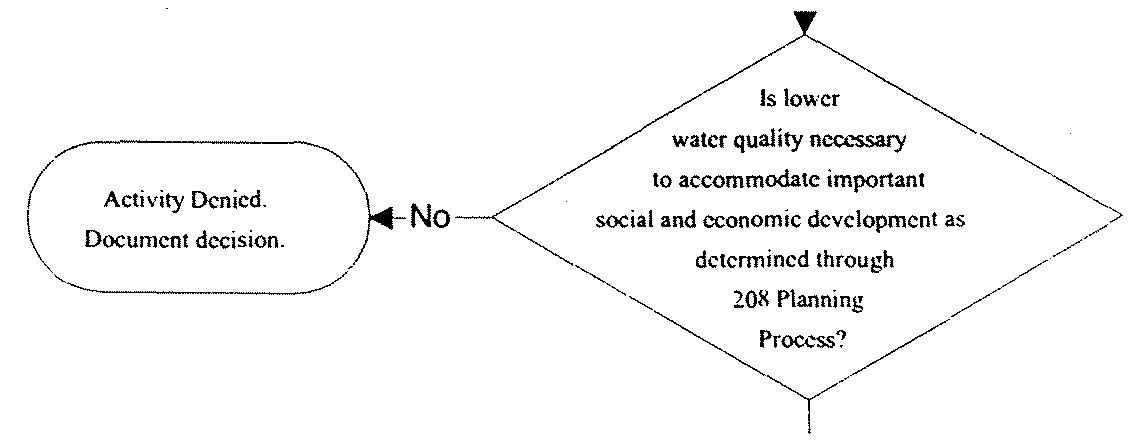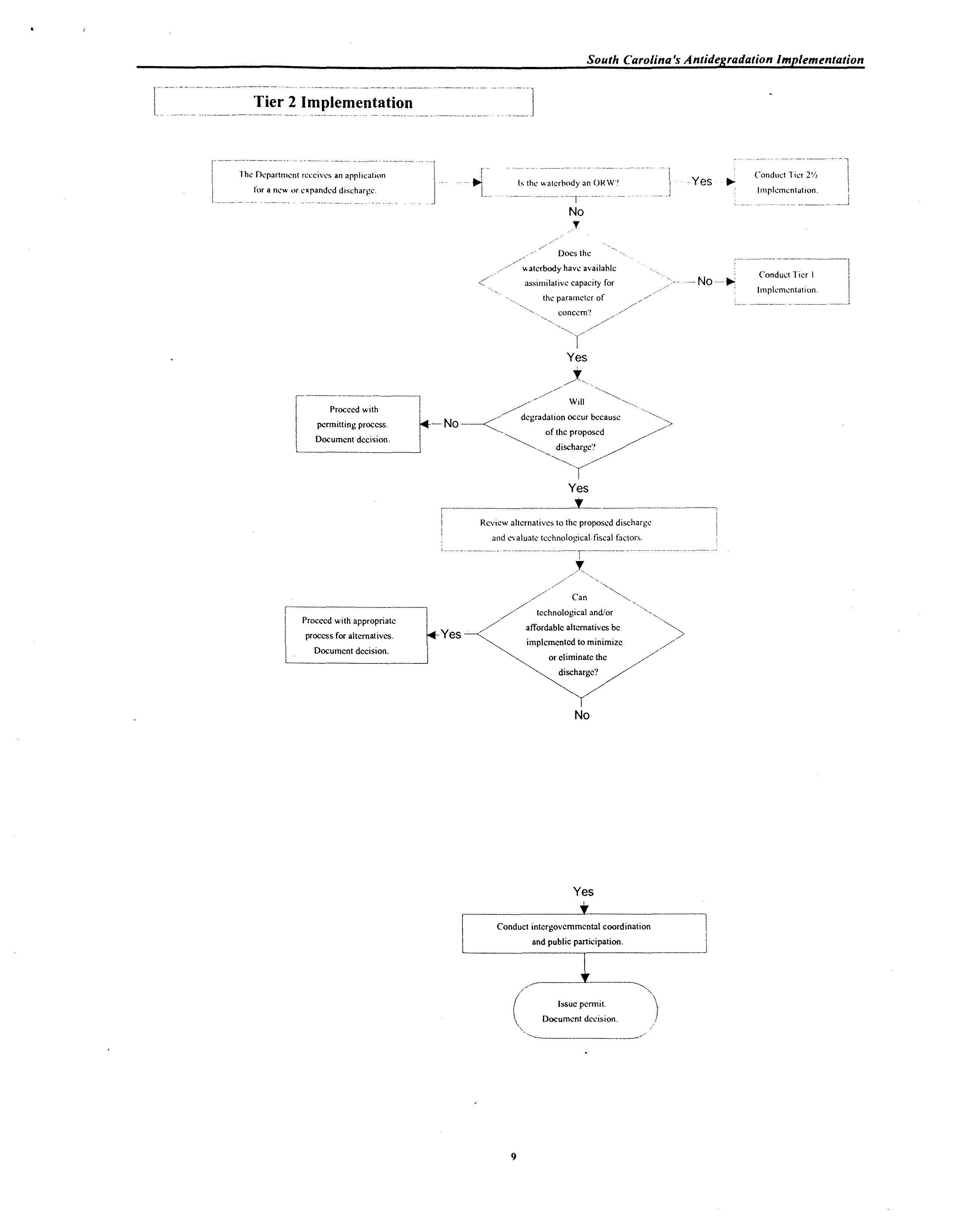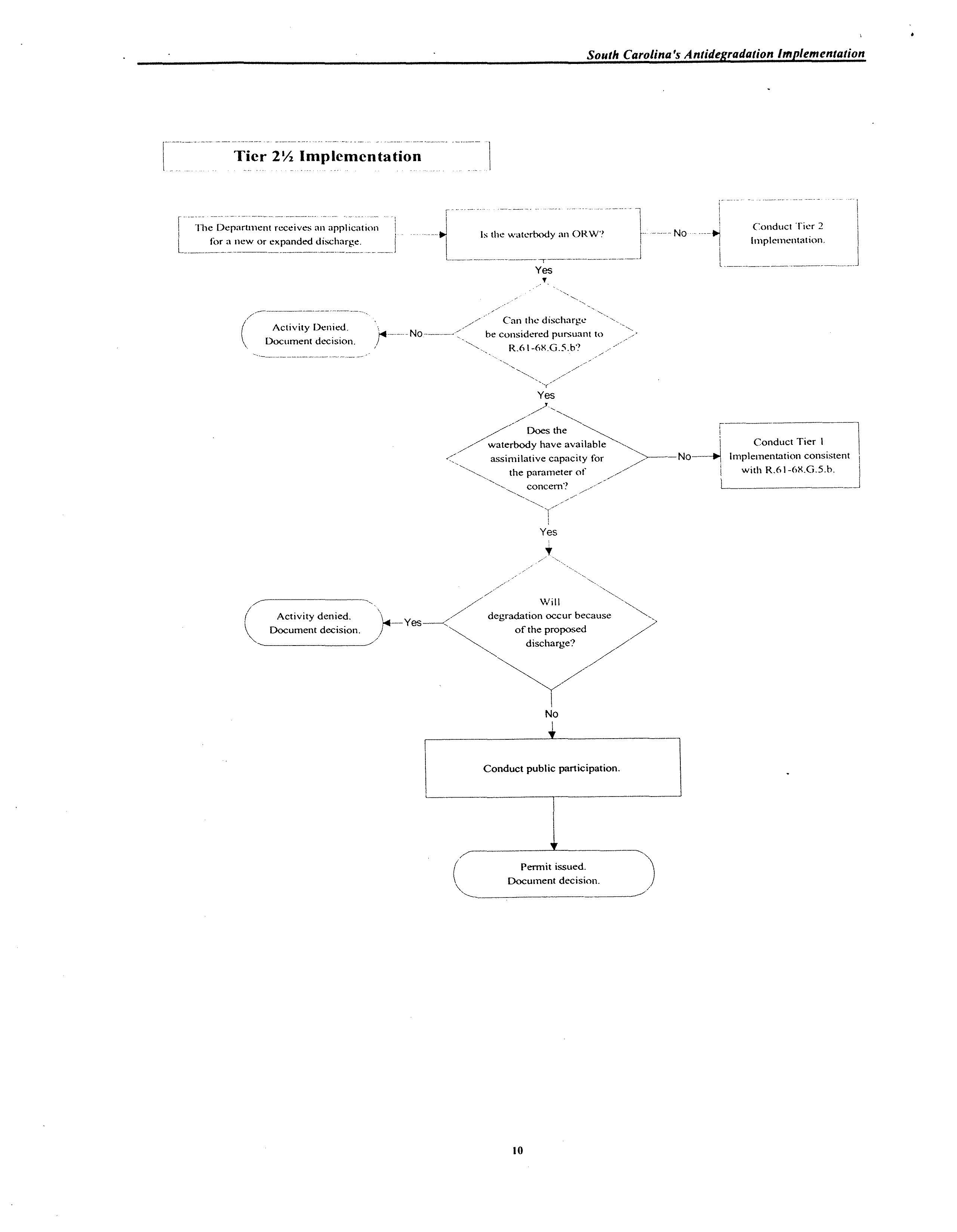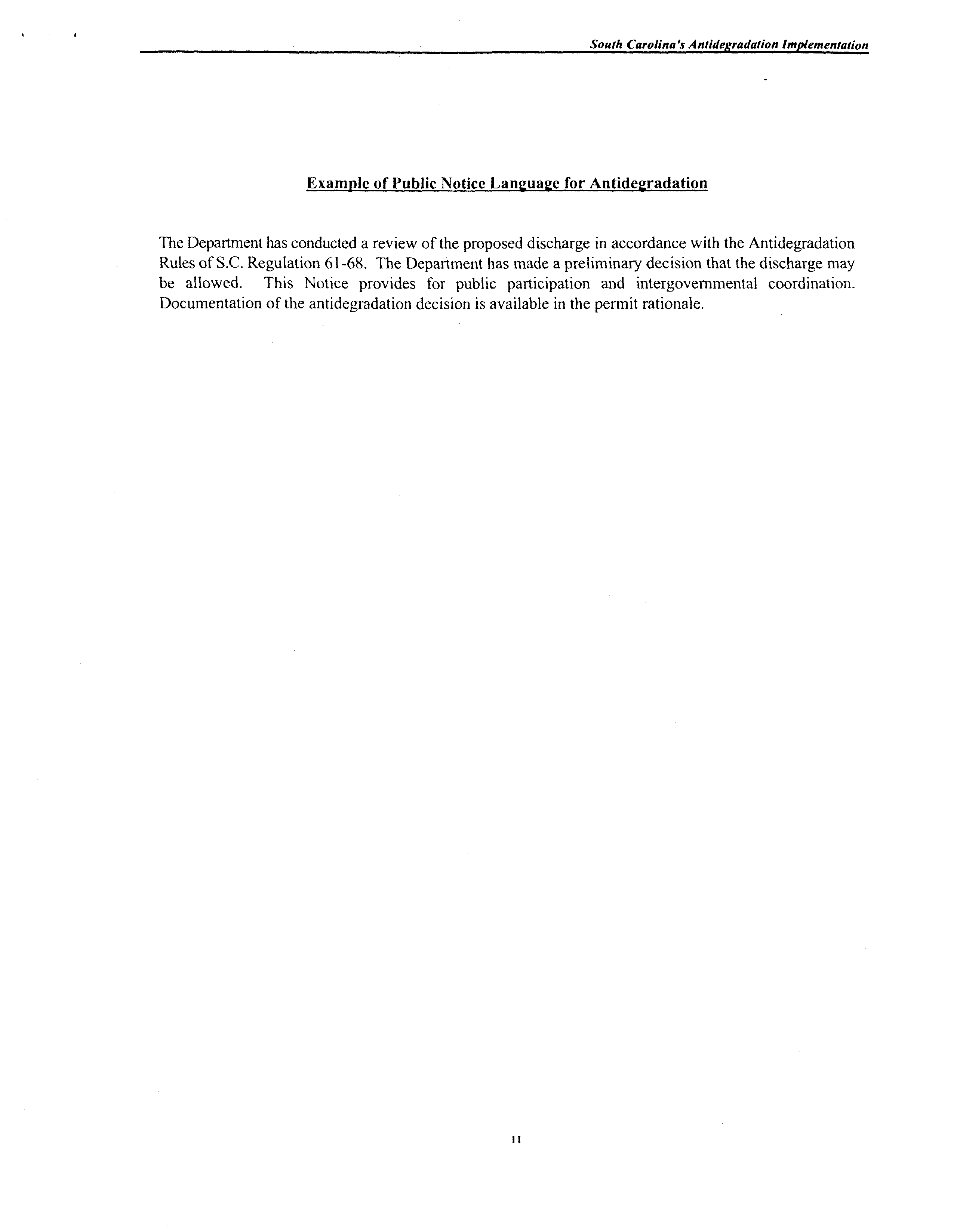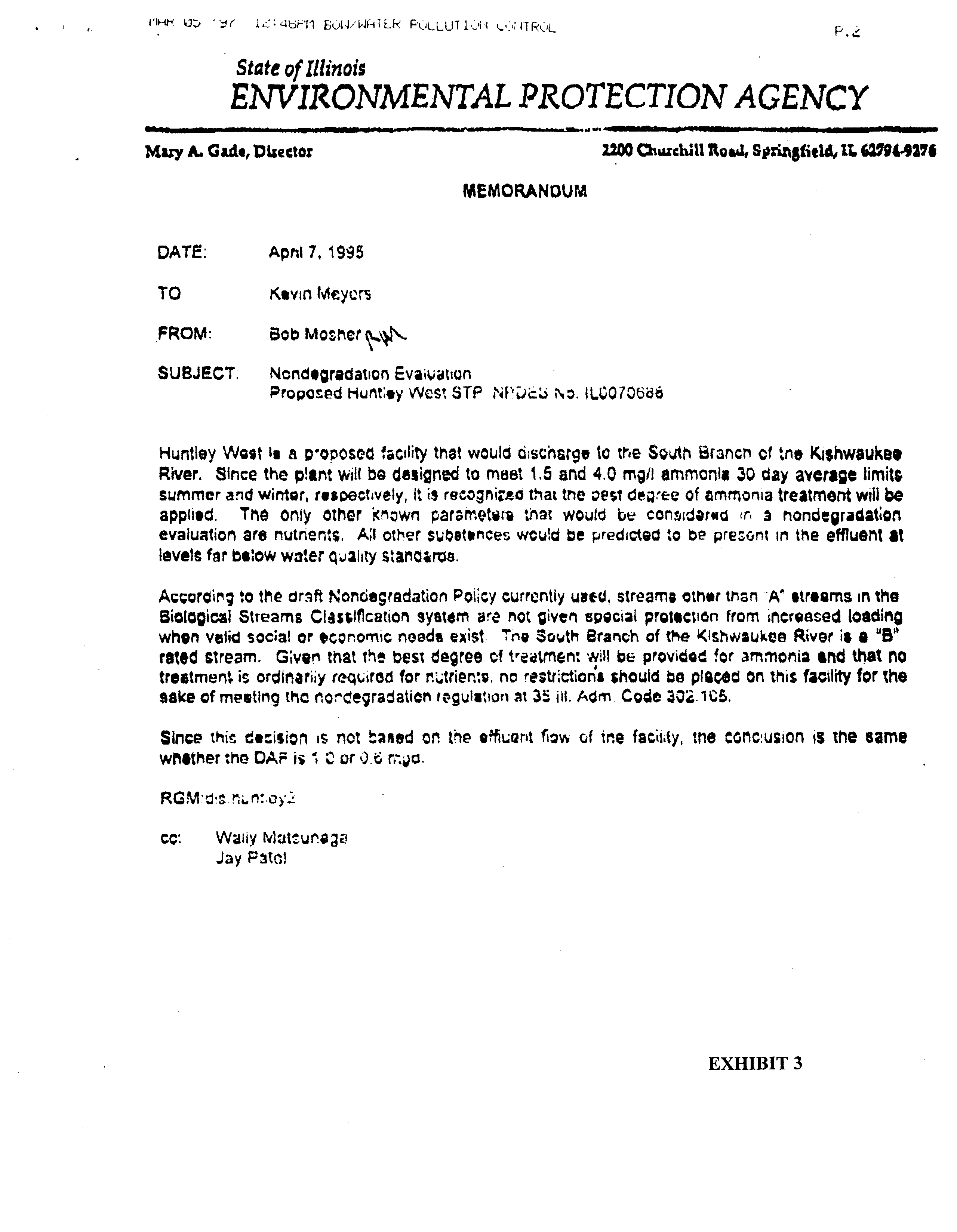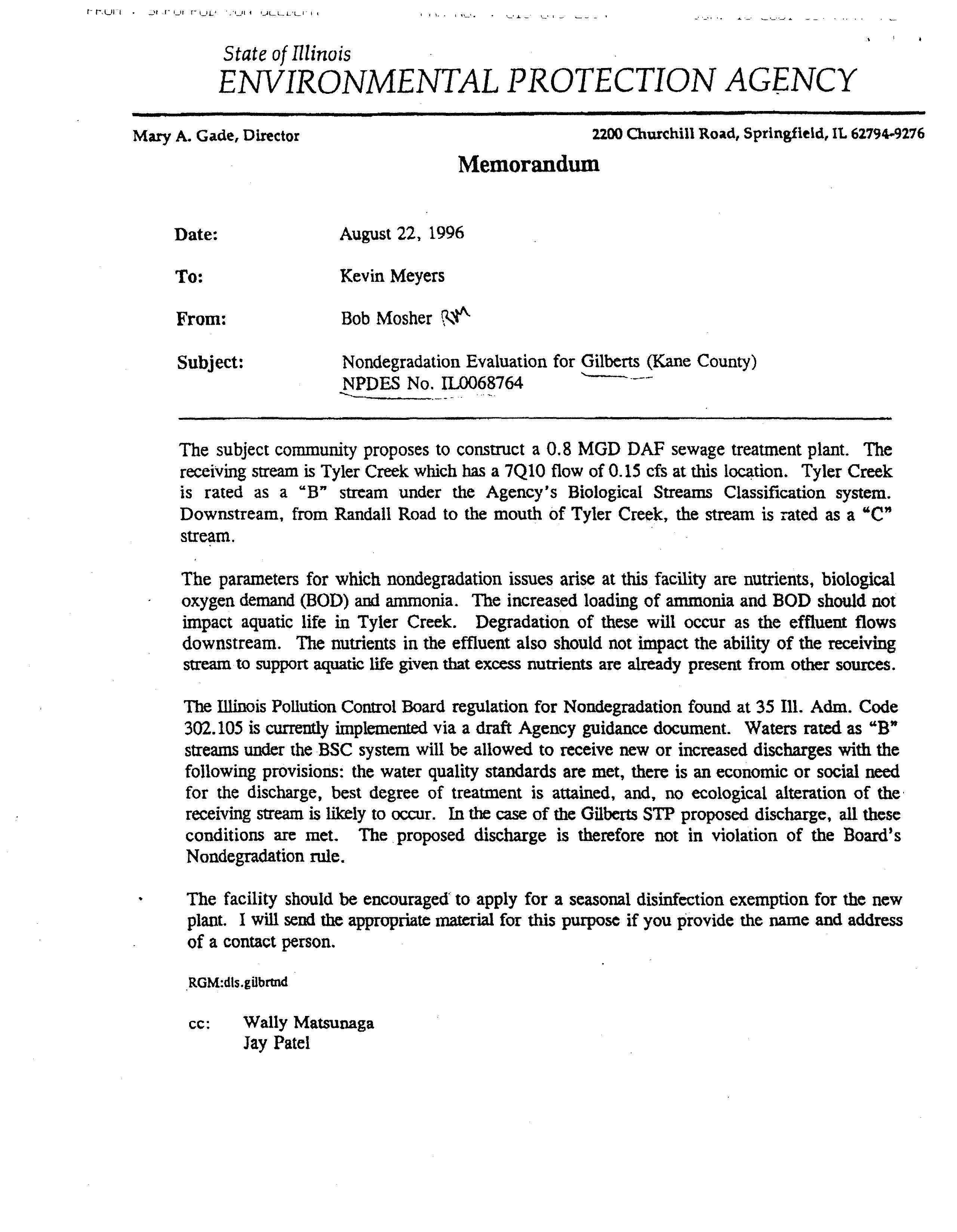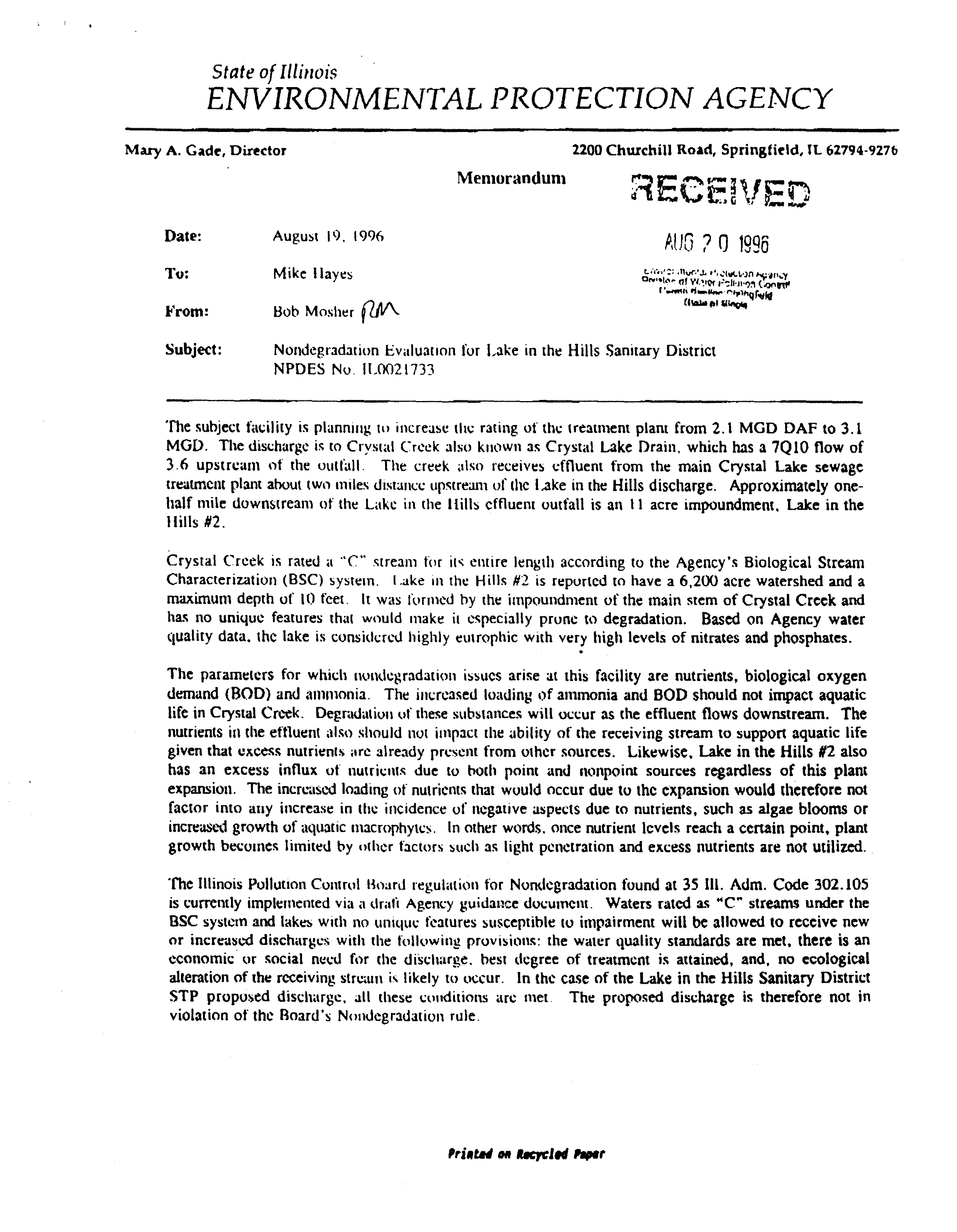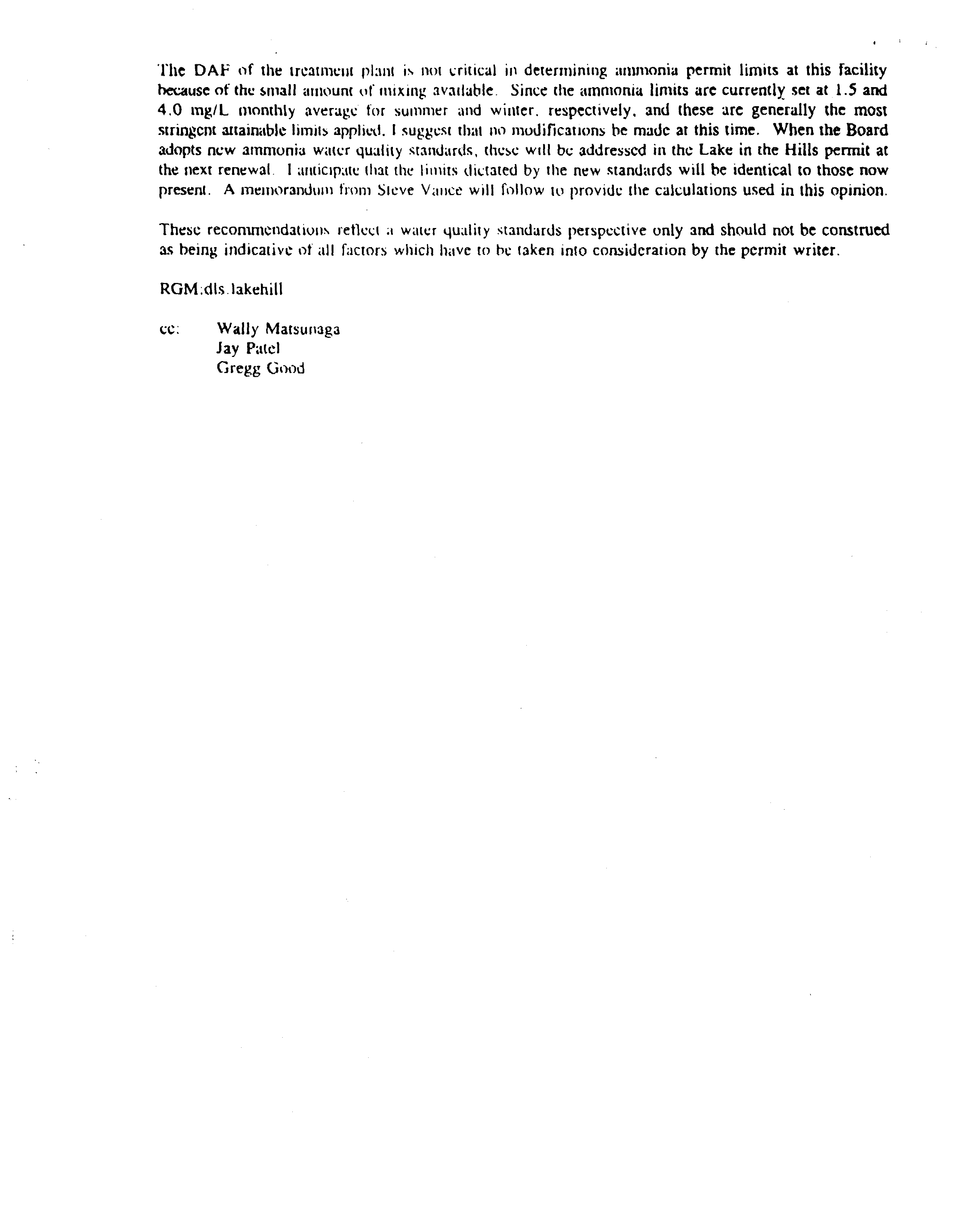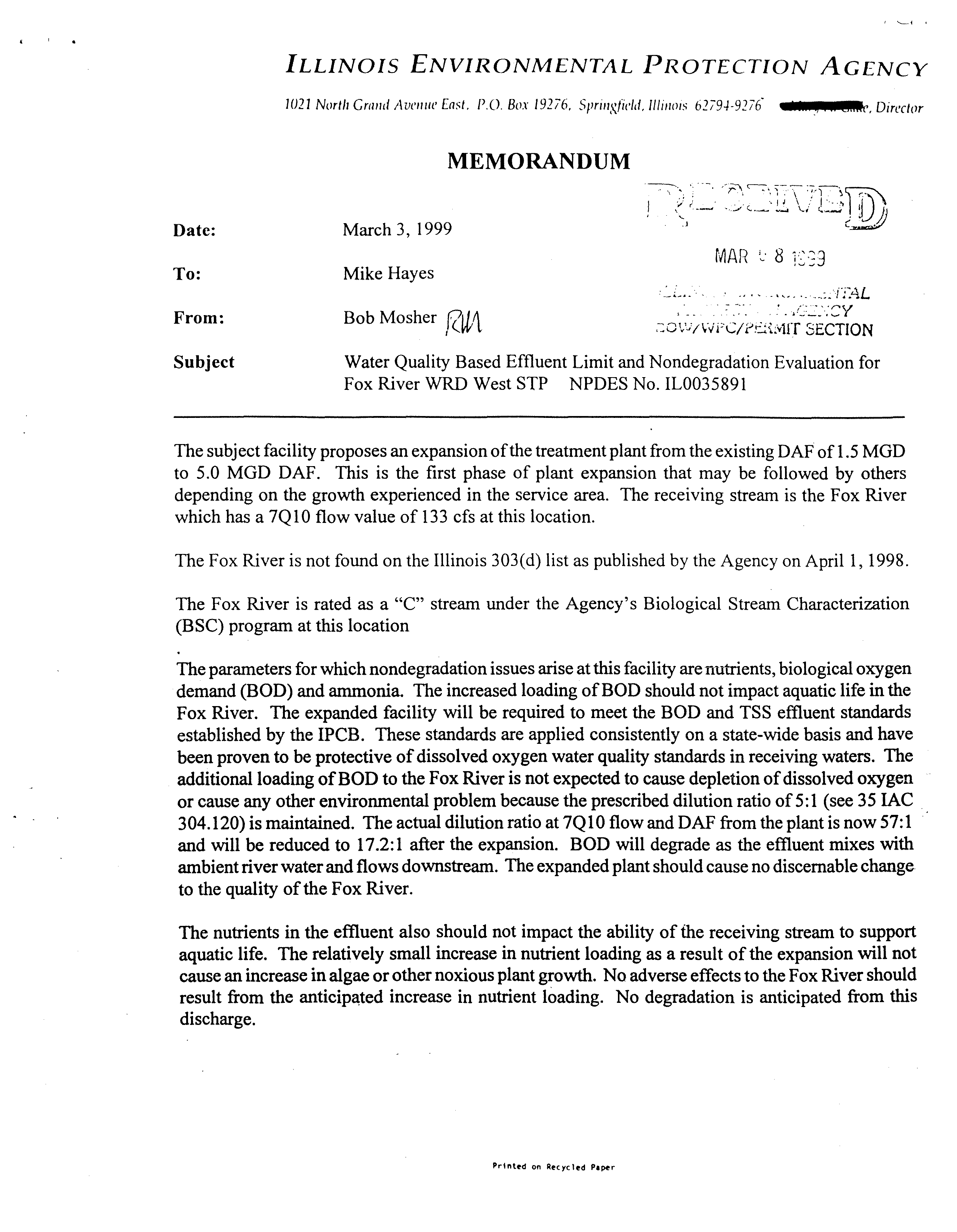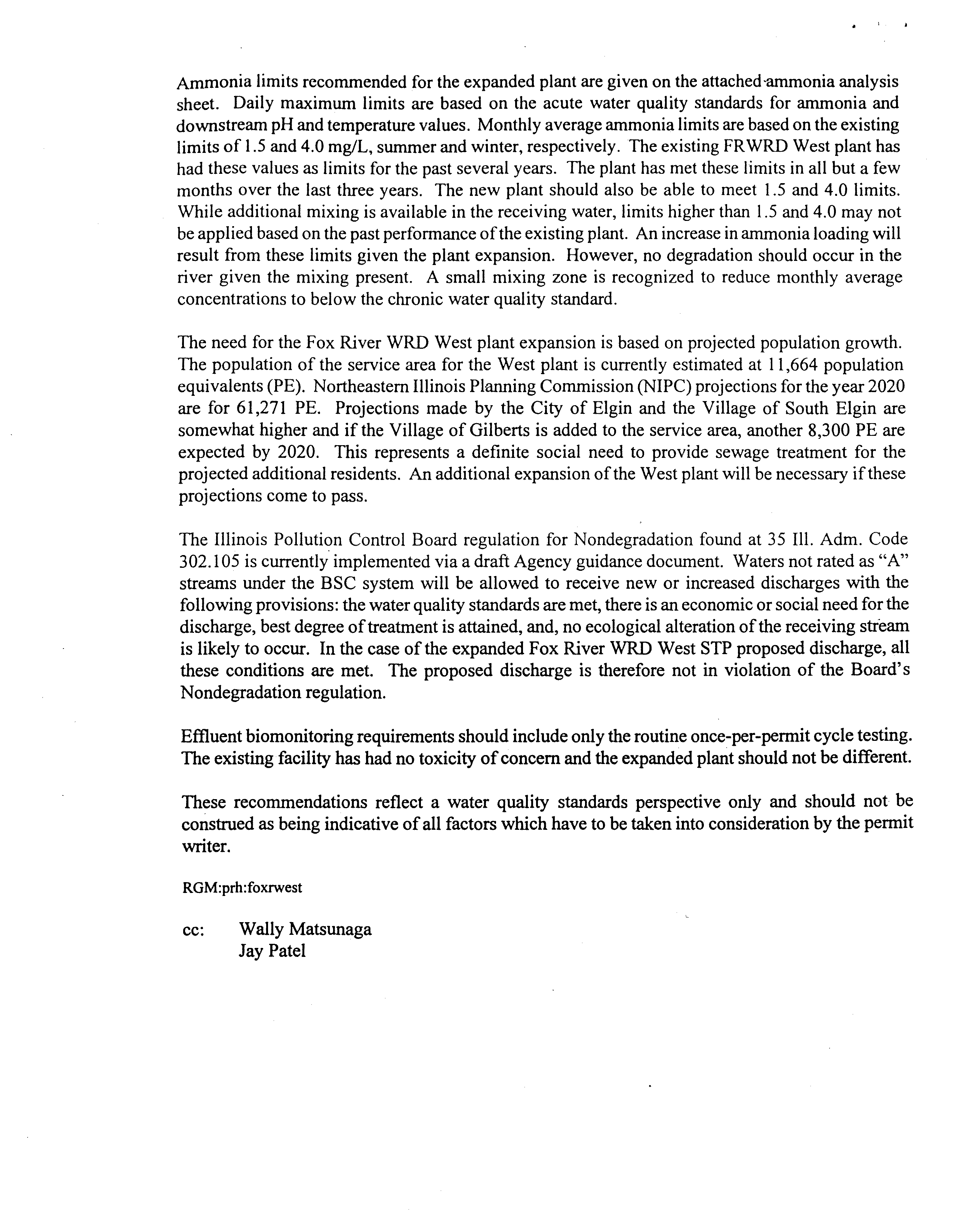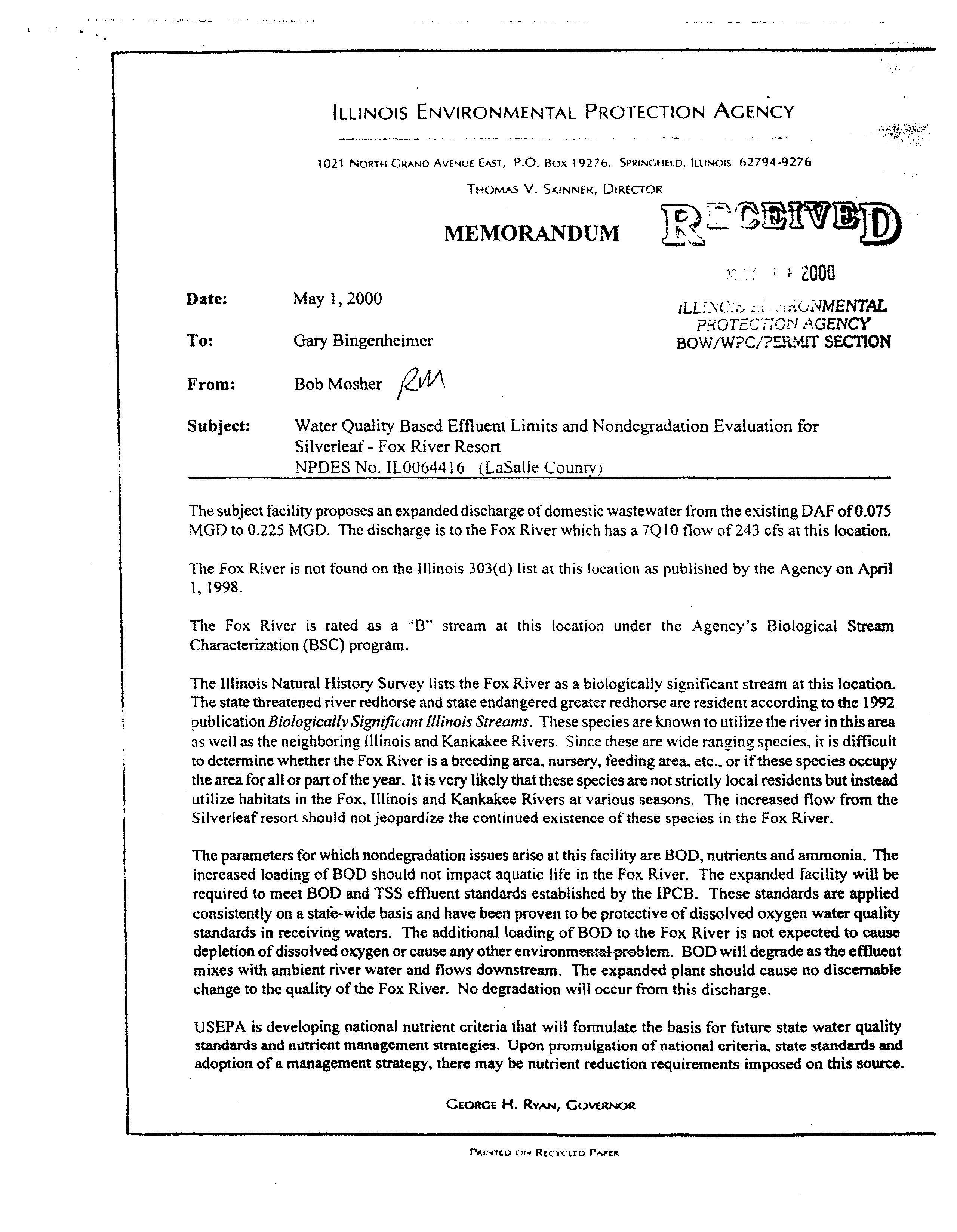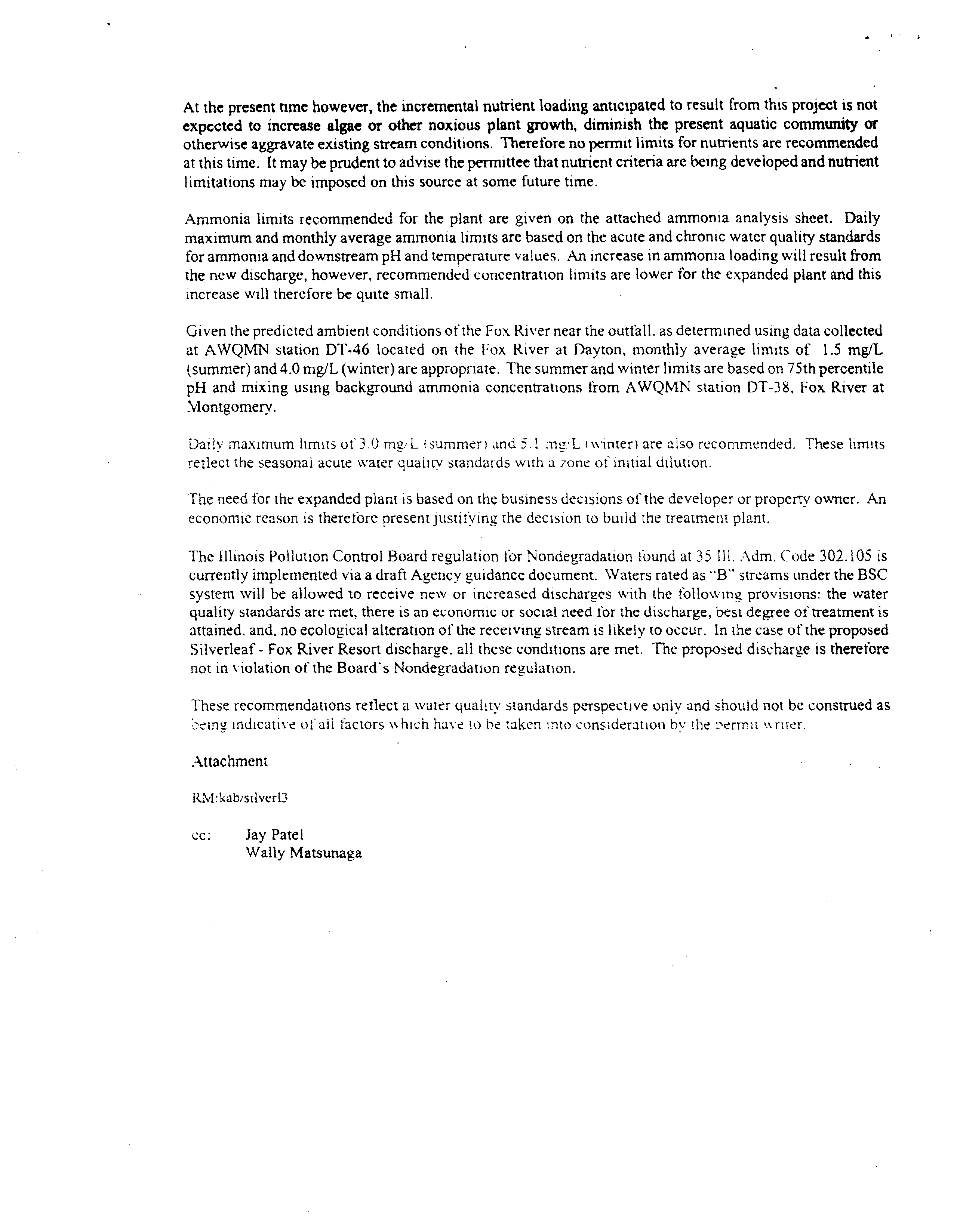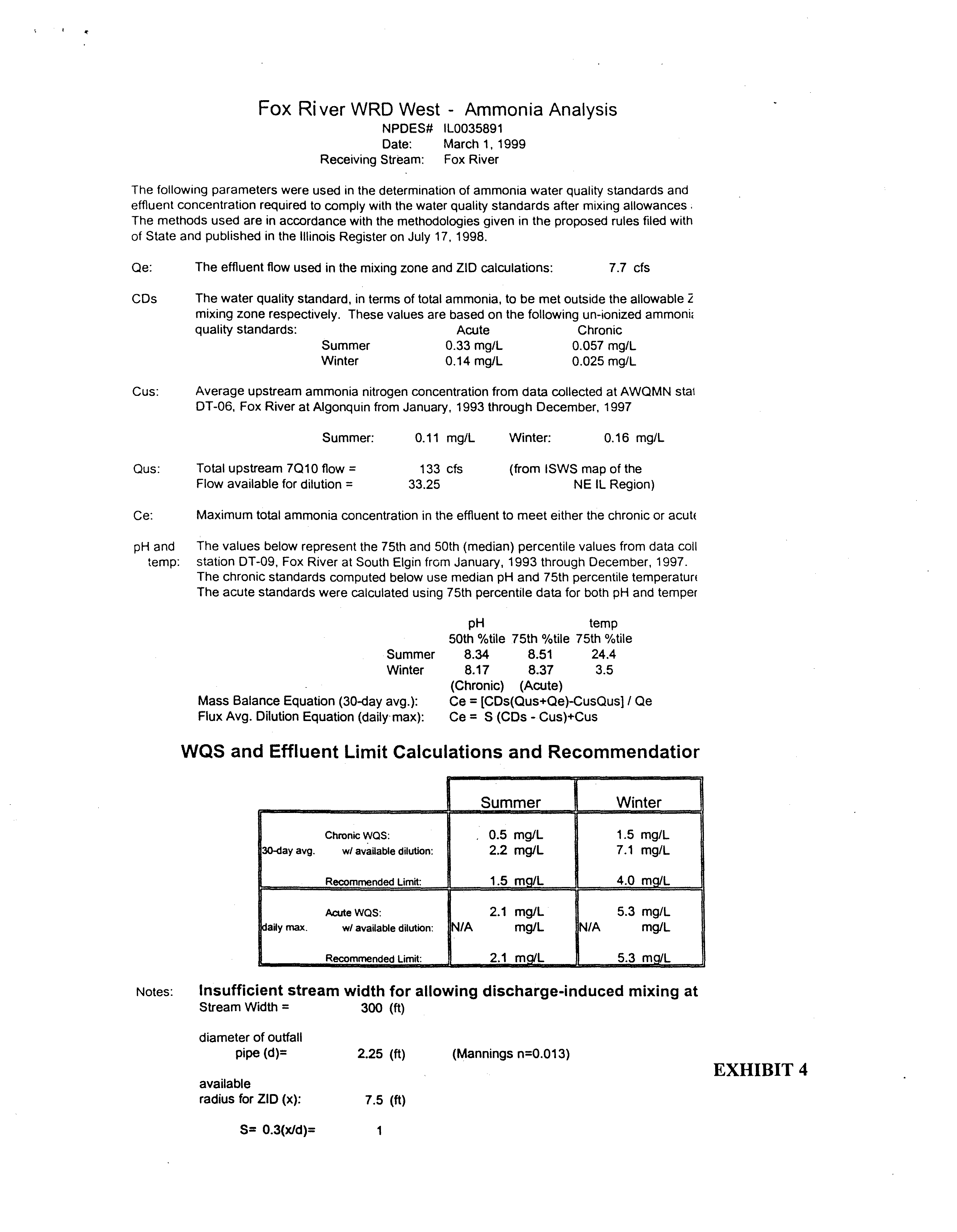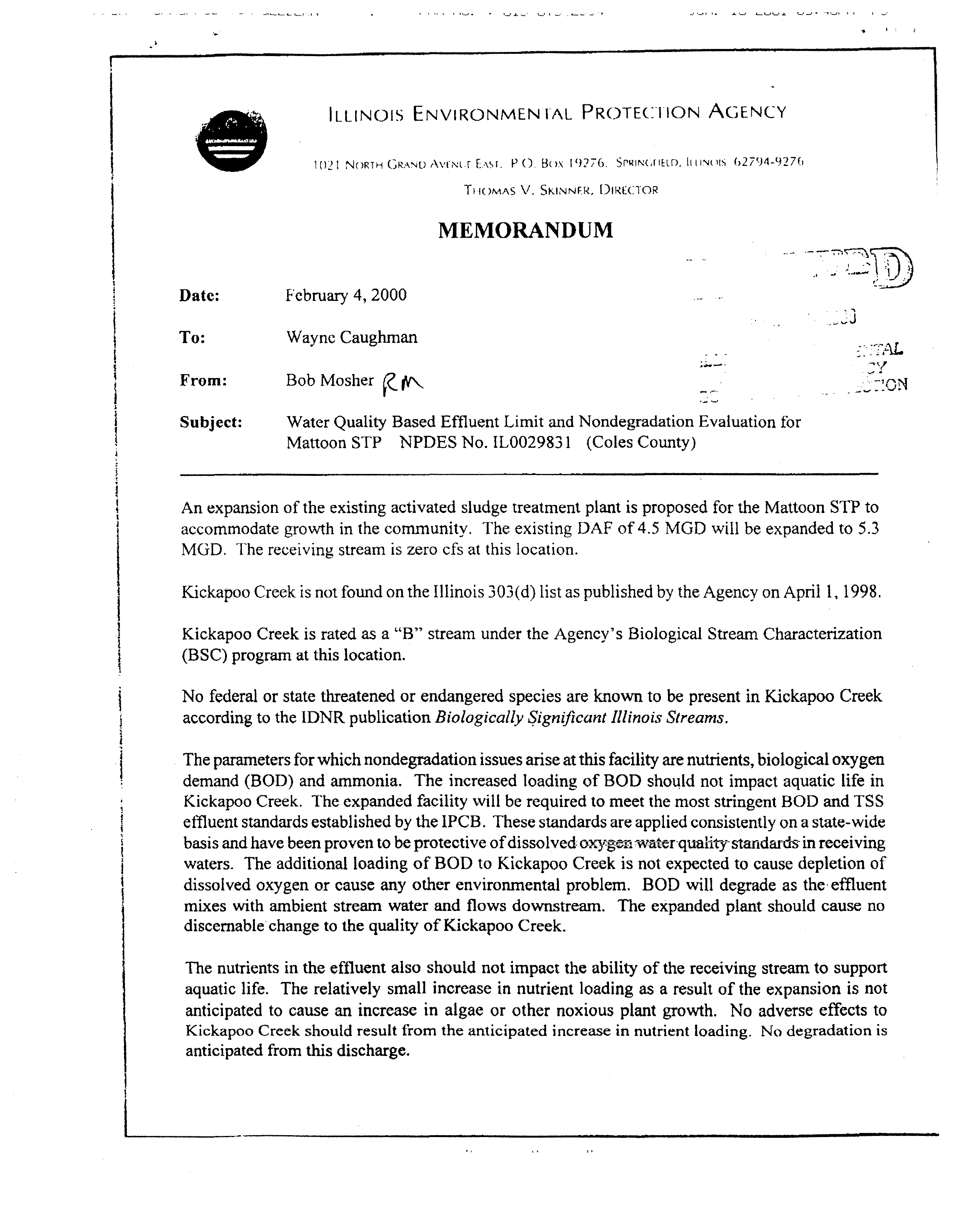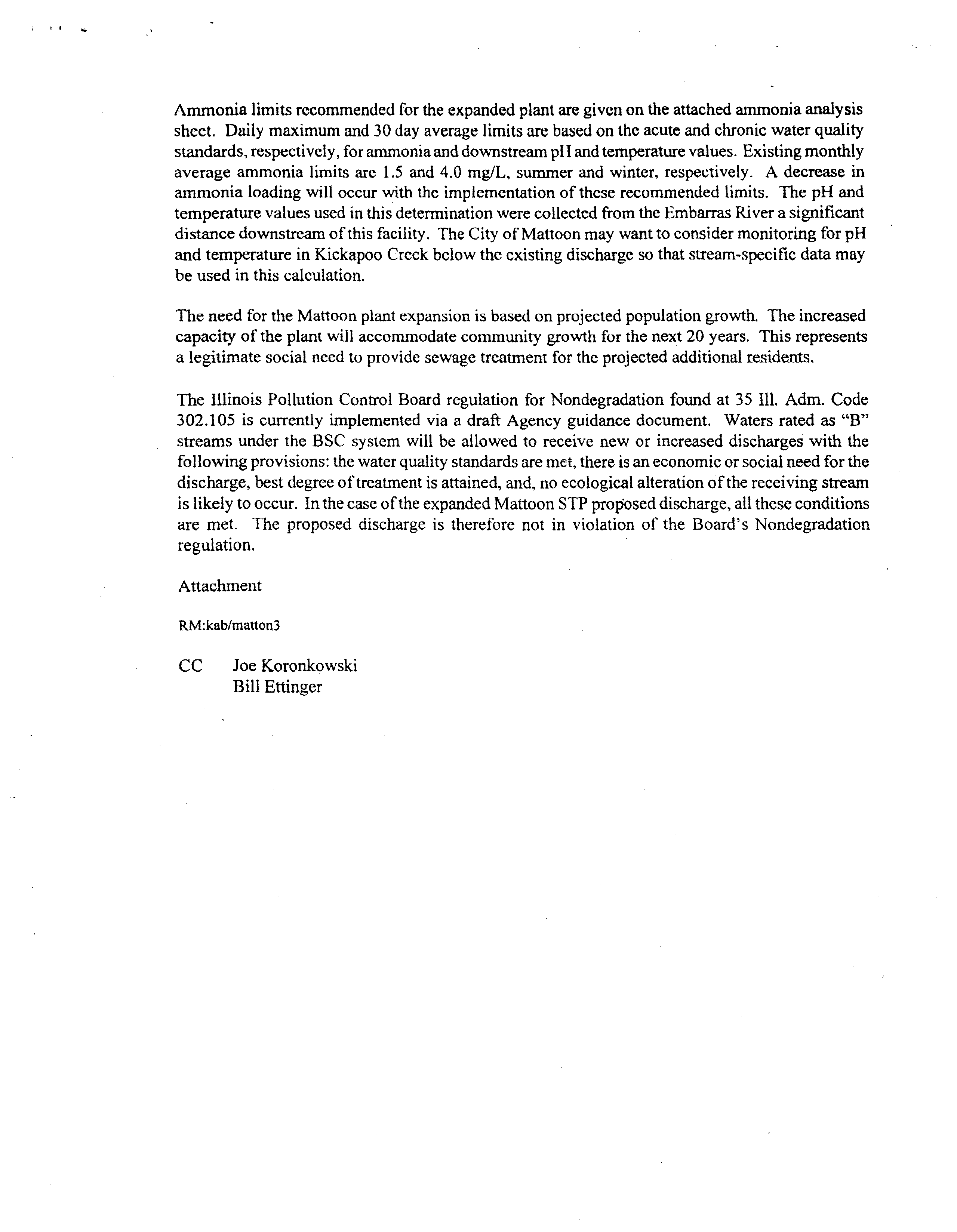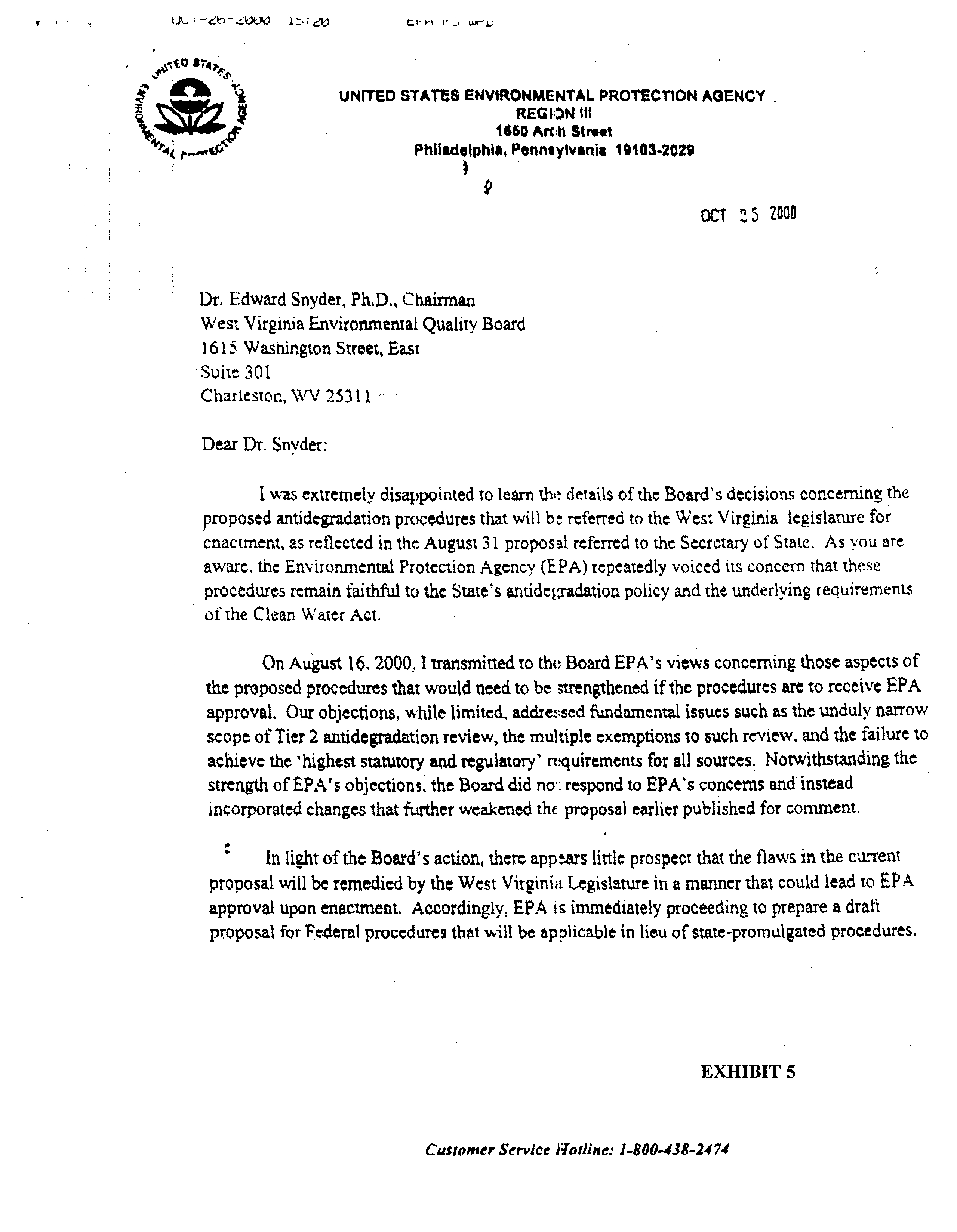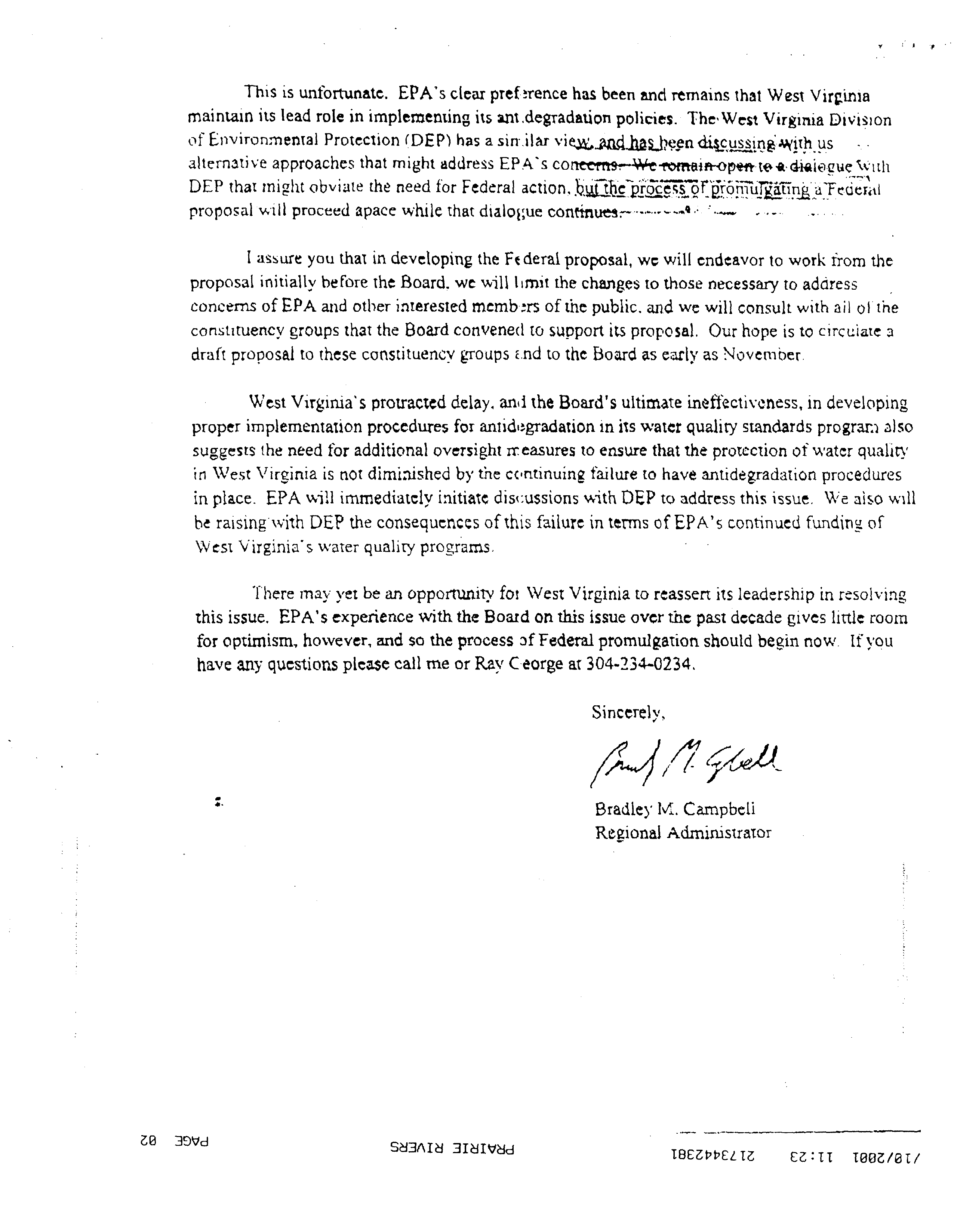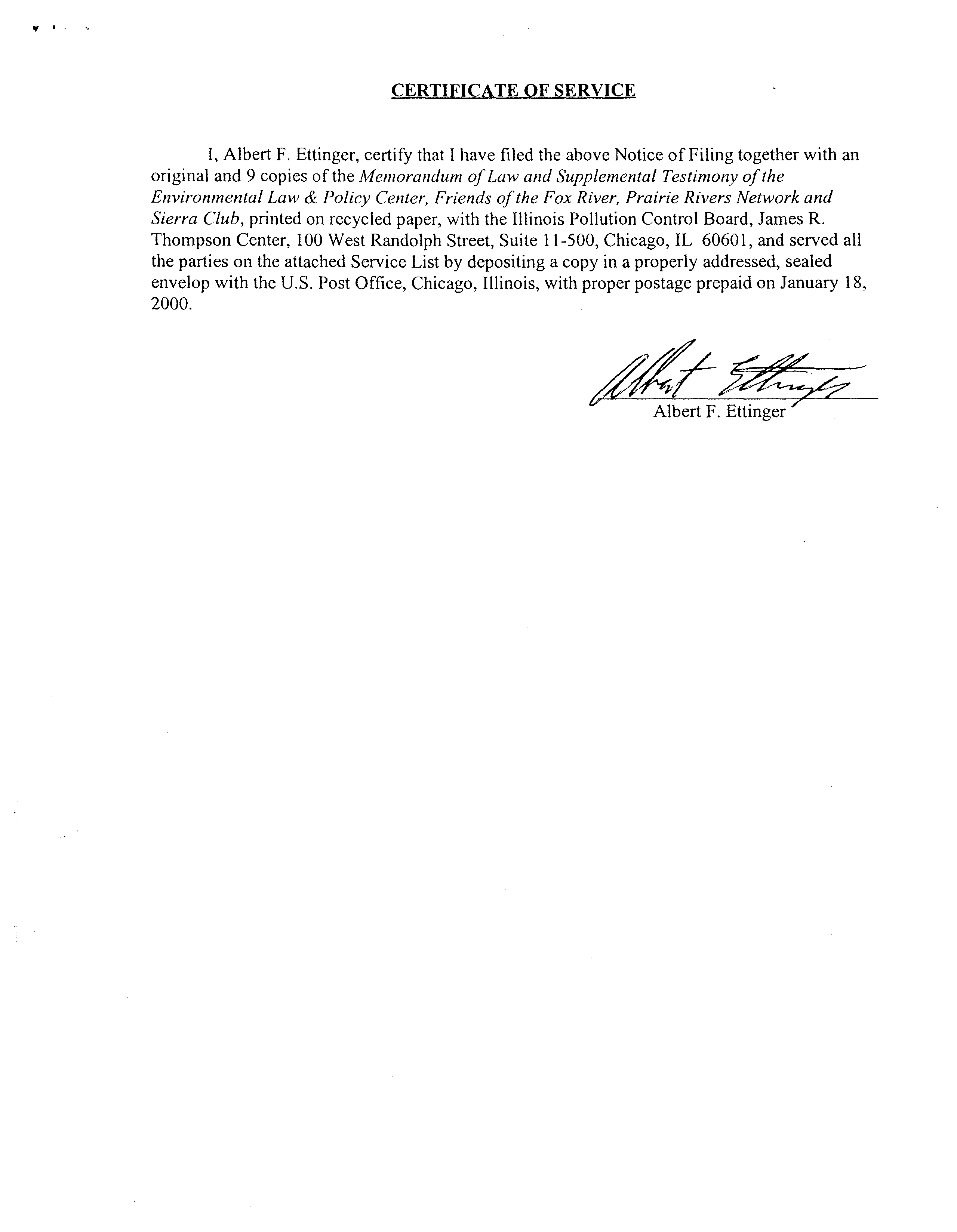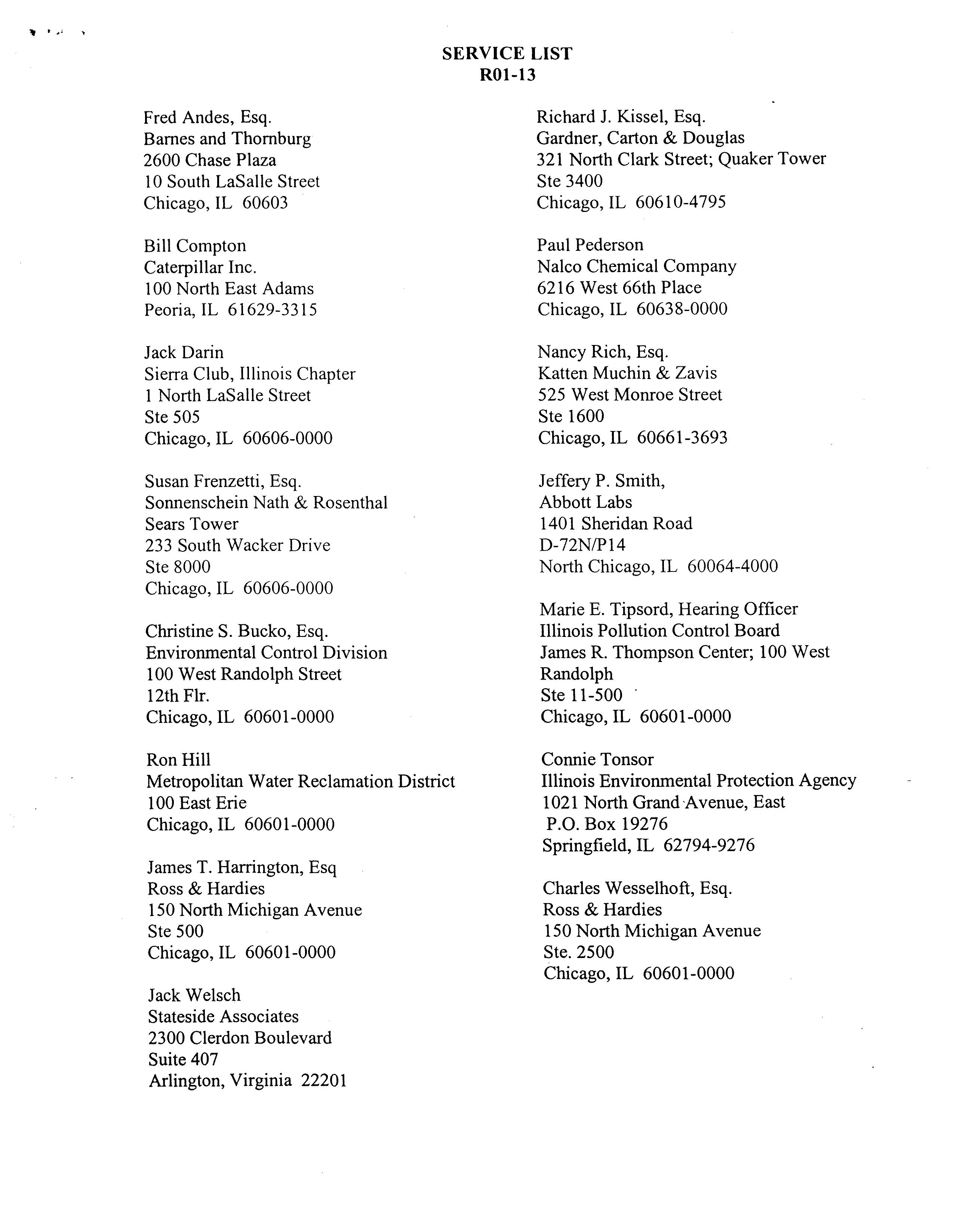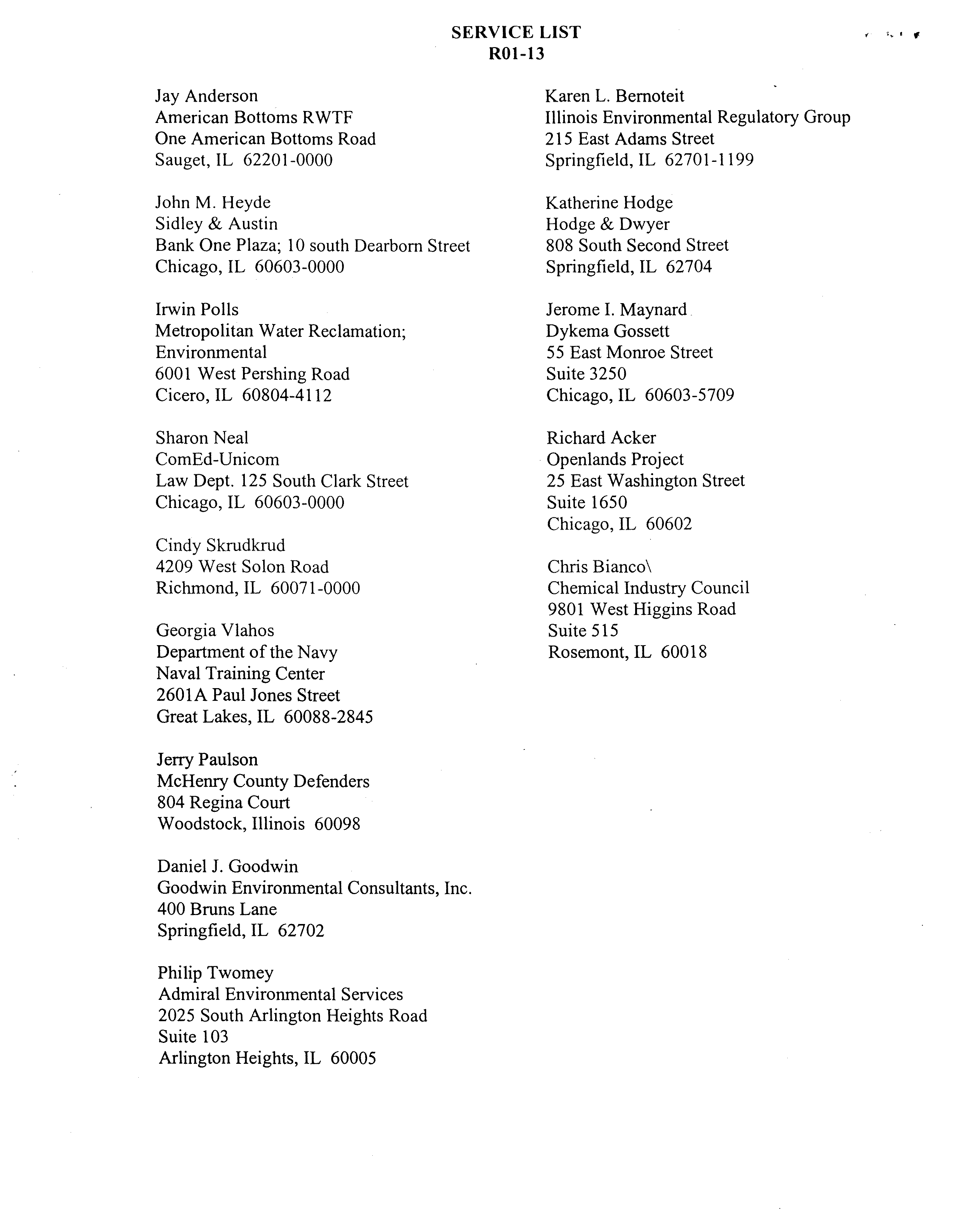BEFORE
THE
ILLINOIS
POLLUTION CONTROL
BOARD.
IN THE
MATTER OF:
REVISIONS TO ANTIDEGRADATION
RULES:
35
ILL.
ADM. CODE 302.105,
303.205, 303.206, AND
106.990 —106.995
)
)
)
R01-13
)
(Rulemaking-Water)
)
)
)
)
)
)
NOTICE OF FILING
PLEASE TAKE NOTICE that on this
date, January 18, 2001,
I filed with Dorothy Gunn,
Clerk of the Illinois
Pollution Control
Board,
James
R. Thompson
Center,
100
West Randolph,
Suite
11-500,
Chicago,
IL
60601,
the
enclosed
Memorandum
of
Law
and
Supplemental
Testimony. of the Environmental
Law
& Policy Center, Friends of the Fox River, Prairie Rivers
Network and Sierra Club in the above-captioned proceeding.
Albert F. Ettinger (ARDC
125045)
Counselfor Environmental Law & Policy
Center, Friends oftheFox River, Prairie
Rivers Network and Sierra
Club
35 East Wacker Drive, Suite
1300
Chicago, IL
60601-2110
(312) 795 3707
January
18,
2001
TABLE OF CONTENTS
THE
CLEAN WATER ACT ANTIDEGRADATION POLICY
2
A.
Enactment ofFederal and Illinois Regulations
2
B.
Clean Water Act Antidegradation Requirements
and the Established Illinois Regulations
4
1.
Maintenance of Existing Uses (Tier I)
4
2.
Allowing Only Degradation Necessary to Accommodate Important
Economic or Social Development (Ifier II)
6
3.
Protection ofOutstanding Resource Waters (Tier III)
9
II.
THE
AGENCY PROPOSAL
10
A.
New Illinois
Regulations are Needed
10
B.
Current IEPA Application of Antidegradation Principles in Permitting
Decisions is Flawed
11
C.
Overviewof theIEPA Proposal to theBoard
12
III.
THE BOARD SHOULDADOPTRULES THAT
ASSURE THAT NPDES
PERMITS AND
401
CERTIFICATIONS MAINTAIN WATER QUALITY
13
A.
The Board Should Not Fashion A “Significance” Threshold or Create a
“DeMinimis”ExemptionfromReview
13
1.
Every increase should be given at Least some review
15
2.
There is no reason under the proposed regulatory scheme to exempt
any permits for
increases in pollution from receiving some level of
review
15
3.
There is no
good way to define “significance” or carve out a de
inininiis exemption
17
4.
Practical considerations do not support requiring a determination of
-
significance
.
.
.
.
.
.
.
.
.
•
.
.
.
19
5.
The board
must exercise great care before adopting antidegradation
provisions from other states and regions
22
B.
The Occasions on which an Antidegradation Demonstration Is
Required
23
C.
The Application and Supporting Data to be Required of
Permit Applicants
25
D.
The Board Should Eliminate or Limit the Exception for General
Permits
27
E.
Citizens
Seeking Outstanding National Resource Water Designations Should
notbe Burdened Unduly
28
F.
No Special Interest Exemption Should Be Allowed for the
Mining
Industry
29
G.
The Board and the draft Agency Implementation Procedures
(Part 354)
30
IV.
Proposed Changes to the IEPA Proposals
31
A.
Proposalsforlmprovementsto302.105
32
B.
Proposals for Improvements
to Section 303.205
34
C.
ProposalsforSectionlO6
35
D.
Proposal to Amend Existing 35 III.
Adm
Code 406 Subpart
B
35
-
E.
Proposals for Improvements to the Agency Implementation Rules
36
\T~
CONCLUSION
.
.
38
APPENDIX AND EXHIBITS
Appendix A -Proposed changes to the Agency Proposal to the Board
(without Environmental Groups’ proposed changes to 35 Ill.Adm.Code 406
and proposed 35 Ill.Adm.Code 354)
Exhibit
1
-
Excerpt from
“Illinois Water Quality
Report 2000”
Exhibit
2
-
Antidegradation Implementation for Water Quality Protection
in South Carolina
Exhibit
3
-
Examples of recent IEPA Nondegradation
Evaluation
Exhibit 4- Examples of IEPA Analyses using remote using monitoring stations
for background data in determining reasonable potential to exceed.
Exhibit
5
-
Letter by Region III U.S. EPA to the Chairman ofthe West Virginia
Environmental Quality Board, October 25, 2000
-
BEFORE THE
POLLUTION CONTROL BOARD
-
OF THE STATE OF ILLINOIS
IN THE
MATTER
OF:
)
)
Revisions
to Antidegradation Rules:
)
R01-13
35
Ill.
Adm. Code
302.105,
303.205,
)
303.206 and
106.990-106.995
)
MEMORANDUM OF LAW AND SUPPLEMENTAL TESTIMONY OF THE
ENVIRONMENTAL LAW AND POLICY CENTER, FRIENDS OF
THE
FOX RIVER, PRAIRIE RIVERS NETWORK AND SIERRA CLUB
The Environmental Law and Policy Center ofthe Midwest, Friends ofthe Fox River,
Prairie Rivers Network and
the Illinois Chapter of the Sierra Club (collectively “Environmental
Groups”) submit this
memorandum of law and supplemental testimony in support ofadoption by
the Board of antidegradation standards that will effectively maintain the chemical, physical and
biological
integrity ofIllinois rivers,
streams, lakes and wetlands.
This memorandum provides legal and
factual background regarding antidegradation
policies and standards, the Environmental Groups’
views ofthe issues that have been raised in
this proceeding, and specific proposals for improvements to the antidegradation standard
proposed by the Illinois Environmental Protection Agency (“IEPA”).
In addition, questions
relating to adoption ofAgency implementation procedures (Part 354, a preliminary draft of
which is attached as Exhibit B to the IEPA Motion for Acceptance, filed August 29, 2000) will
be addressed to the extent that the implementation procedures are relevant to this Board
proceeding.
I
THE CLEAN WATER ACT ANTIDEGRADATION POLICY
-
The purpose and proper interpretation ofthe federal antidegradation policy
should
be
viewed in
the context ofthe goals of the
1972 Clean Water Act (“CWA”).
The objective of
the CWA “is to
restore and maintain the chemical, physical and biological integrity of the
Nation’s waters.”
33 USC~125 1(a).
In the CWA, Congress set as an
interim national goal that
“wherever attainable
...
water
quality which provides for the protection and propagation offish,
shellfish and
wildlife and provides for recreation in and on the water be achieved by July
1,
1983.” 33
USC §1251(a)(2).
Water quality was to
improve not degrade.
Congress plainly did
not anticipate that large numbers of new discharges and other sources of pollution would be
licensed after the passage of the Act
as it established
elimination ofall discharges
by
1985 as a
national goal. 33
USC
§
1251(a)(1).
A.
Enactment of Federal and Illinois Regulations
The antidegradation policy actually proceeded passage ofthe CWA.
As was explained
by the United States Environmental Protection Agency (“U.S. EPA”) in the Water Quality
Standards Handbook, Second Edition, EPA 823-B-94-0005a (“USEPA Handbook”)’:
The
first antidegradation policy statement was released on
February 8,
1968,
by the Secretary ofthe U.S.
Department of
Interior.
It was included in EPA’s first Water Quality
Standards
Regulation
...
and was slightly refined and re-promulgated as part
ofthe current program regulation published on November 8,
1983
(48 F.R. 51400, 40 CFR 131.12).
Antidegradation requirements
and methods for implementing those requirements are minimum
conditions to
be included in a State’s water quality standards.
Antidegradation was originally based on the spirit, intent and
goals
1
.This document is Exhibit A to
the Motion
for Acceptance, filed in this proceeding by
Illinois EPA, August 29, 2000.
2
ofthe Act, especially the clause
“...
restore and maintain the
chemical, physical, and biological
integrity of the Nation’s water”
-
(101(a)) and the provision of 303(a) that
made water quality
standards under prior
law the “starting point” for CWA water
quality requirements.
2
The original
1968 policy adopted by
Interior Secretary Stewart Udall provided:
Waters whose existing quality
is better than the established
standards as of the date on which
such standards become effective
will be
maintained at their existing high quality.
These and other
waters of a State will not be
lowered in quality unless
and until it
has been affirmatively demonstrated to
the State waterpollution
control agency and the Department ofInterior that such change is
justifiable as a result ofnecessary economic or social development
and
will not interfere with or become injurious to
any assigned
uses made of, or presently possible in, such waters.
U.S.
Dept. Interior Federal Water Pollution Control
Administration, Compendium ofDept. ofthe Interior Statements
on Non-degradation ofInterstate Water 1-2 (Aug
1968)
reprinted
in,
Harleston, John, What is Antidegradation Policy:Does Anyone
Know?,
5
S.C. Envtl.
L.J.
33, 40 (1996)
Illinois’
current nondegradation policy, adopted by the Board in 1972 in
PCB 71-14 and
now contained at 35
Ill. Adm. Code
302.105, plainly is related to the
1968
federal policy.
It
states
Waters
whose existing
quality is better than the established
standards at their date oftheir adoption will be maintained in their
present high quality.
Such waters will not be lowered in quality
unless and until it is affirmatively demonstrated that such change
will not interfere with or become injurious to any appropriate
beneficial uses made ofor presently possible in, such waters and
that such change is justifiable as a result ofnecessary economic or
social development.
2The U.S.
EPA Antidegradation policy was recognized and codified by Congress in
1987
and
1990 through passage ofamendments to
the CWA that were codified
as 33
USC
§13l3(d)(4)(B) and 33
USC §l268(c)(2)(A).
3
In adopting this standard,
the Board explained:
This
preserves the present prohibition on
unnecessary degradation
of waters presently of better quality than that required by the
water
quality
standards, recognizingthat the standards represent
not optimum water quality but the worst we are prepared to tolerate
if economic conditions so require.
In the Matter ofWater Quality
Standards Revisions, (PCB March 7,
1972) 71-14, p.
II.
B.
Clean Water Act Antidegradation Requirements
and
the Established Illinois Regulations
The regulation that states the federal antidegradation policy,
40 CFR 131.12, requires that
states provide essentially three types ofprotection for their waters.
Following this regulation, the
standards adopted by the Board in this proceeding must, “at a minimum, be consistent with” the
following:
(1)
Maintenance of Existing Uses (Tier I)
The first requirementfor an adequatestate antidegradationpolicy
is maintenance ofexisting
uses:
Existing instream water uses and the level ofwater quality necessary
to protect the existing usesshall be maintained and protected. 40 CFR
§131.12(a)(1)
~
Section 4.42 ofthe U.S.
EPA Water Quality Standards Handbook explains:
No
activity
is
allowable under
the
antidegradation policy
which
would partially or completely eliminate any existing use whether or
not that use is designated in a State’s water quality standards.... Non-
aberrational resident species must be protected, even ifnot prevalent
in number orimportance.
Water quality should be suchthat itresults
in no mortality and no significantgrowth orreproductive impairment
3This point
is repeated in 40 CFR
§
131.1 2(a)(2) where it is emphasized that, even where
accommodation ofimportant economic or social development necessitates allowing new
pollution, “the State shall assure water quality adequate to
protect existing uses fully.”
4
of resident
species.
Any lowering of water quality
below this
full
level of protection is not allowed. (p. 4-5)
-
The
Environmental
Groups
believe
strongly
that,
with
the
assistance
of the
Illinois
Department ofNatural Resources (“IDNR”), IEPA
must make greater efforts to
assure that new or
increased discharges ofpollutants will not harm aquatic life in receiving waters.
Although there are
other provisions which protect
existing uses from
some threats, antidegradation has a critical role
to play in protecting existing usesofIllinois waters, including protection ofindigenous aquatic life.4
4Another way that existing uses are protected is to
only allow discharges ofpollutants if
the discharges will not cause a violation of state water quality standards. Water quality standards
are supposed to
be
protective ofaquatic life and other existing uses.
40 CFR
131.10.
In Illinois,
water quality standards
include the numeric and narrative standards of35
Ill Adm.
Code 302.
No National Pollutant Discharge Elimination System (“NPDES”) permit may be granted
which allows discharges that may cause or contribute to violations ofwater quality standards.
40
CFR
§ 122.44(d), which implements CWA Section 301 (b)(I )(C), explicitly requires that NPDES
permits include restrictions “necessary to achieve water quality standards
...
including State
narrative criteria.” American Paper Institute v.
U.S. Environmental Protection Agency, 996 F.2d
346,
350 (D.C. Cir.
1993). Permit “~limitations must control all pollutants or pollutant
parameters (either conventional, nonconventional or toxic pollutants) which the Director
determines are or may be discharged at a level which will cause, have a reasonable potential to
cause, or contribute to an excursion above any State water quality standard, including state
narrative criteria for water quality.” 40 CFR §122.44(d)(1)(i); see also,
40 CFR 122.4(d) and (i).
Illinois regulations (35 Ill. Adm. Code 304.105) require that any effluent or combination of
effluents be regulated to
insure that there is compliance with all applicable water quality
standards in
all waters that may be affected by the discharge. In the Matter of: Petition of
Commonwealth Edison Company forAdjusted
Standard from 35 Ill. Adm. Code 302.211(d) and
~,
AS 96-10 (PCB, October 3, 1996)
Realistically,
enforcement of water quality standards is not sufficient.
Many Illinois
numeric standards are far from being protective.
This situation must be addressed, but Illinois
cannot hope to develop protective standards for the thousands ofchemicals that may harm
Illinois waters.
Moreover, water quality standards generally are not designed to be protective of
all species.
They are based on protecting 95
ofthe individuals of the small number of,
hopefully representative, species tested.
(Frevert Testimony, Dec. 6, 2000,
Tr.
24-5)
5
Generally, proper
protection of resident species requires knowledge ofthe biology of the
receiving waters sufficient to determine if particularly sensitive species are present.
Individualized
consideration ofwhether the proposed new pollution will affect the species present is also normally
necessary.
Protection ofrecreational
and other
uses also often requires
individualized treatment.
The antidegradation standard for protectingexisting uses is particularly importantwith regard
to
activities
that harm water quality that generally are not
subject to NPDES
permitting, such as
stream channelization, filling wetlands and dam construction.
These activities are subject to state
oversight through the Section 401,
33
USC
§
1341, certification process which prohibits the Corps
ofEngineers from issuing
a permit to
fill waters ofthe United States unless the state has certified
that the activity will not violate state waterquality standards, including its antidegradation standard.
See, PUD No.1 ofJefferson County v. Washington Dept. ofEcology, 511
U.S.
700 (1994).
The
latest
Illinois
Water
Quality
Report
states
that
hydromodification
and
habitat
modification are responsible for the impairment of over 3000 miles ofIllinois’ rivers and streams.
(Ex. 1)
Nonetheless, new permit requests forpermissionto destroy wetlands and channelize streams
continue to be submitted and approved by the Corps and IEPA.
Illinois must workmorerigorously
to assure that projects that threaten to degrade the biological or physical integrity ofIllinois waters
are denied 401
certification:
(2)
Allowing Only Degradation Necessary to
Accommodate
Important Economic or Social Development(Tier II)
40 CFR l3l.l2(a)(2) provides:
Where the quality of the waters exceed levels necessary to support
propagation of fish, shellfish, and
wildlife and recreation in and
on
the water, that quality shall be maintained and protected unless the
6
State
finds,
after
full
satisfaction
of
the
intergovernmental
coordination
and
public
participation
provisions
of
the
State’s
-
continuing
planning
process, that
allowing
lower water
quality
is
necessary to accommodate important economicorsocial-development
in
the
area
in
which
the
waters
are
located.
In
allowing
such
degradation
or
lower
water
quality,
the
State
shall
assure
water
quality adequate to protect existing uses fully. Further, the State shall
assurethat there shall be achieved thehighest statutory and regulatory
requirements
for
all
new
and
existing
point
sources
and
all
cost-
effective and
reasonable
best
management
practices
for
nonpoint
source control.
-
The central purpose of this provision is to preserve water quality to
the extent possible. As
was statedby the Board in
1972 in adopting thepresent “nondegradation” standard, the numeric and
narrative standards “do not represent optimum waterquality but the worst weareprepared to tolerate
if economic conditions so require.”
(Supra
p. 4)
To put the matter another way, the assimilation capacity of a water is a public
resource that
should not
be frittered away.
During the.November hearing, Toby Frevert explained:
The
underpinnings ofthis whole program is that additional
-
-
that
residual capacity ofthe stream
to accept waste is,
indeed, a public
resource.
And if that
public
resource
is
allocated
to
an
individual
entity,
then
there
ought
to
be
some
public
role
playing
in
the
allocationofthat resource to that individual entity and there ought to
be some indication ofwhy that is generally consistent with the good
ofthe public
at large. (Frevert Testimony, Nov.
17, 2000, Tr.
35-6)
IEPA’s Frevert elaborated on this concept later during the November hearing:
The antidegradation policy
at the federal
level basically says
that
any
increment of water quality
better than what
you
define as the
floor necessary
to protect that existing use is a public resource, and
that public resource shall be allocated to other people consistentwith
the general intent of the public at large and their overall social and
economic goals.
(Tr.104-05)
7
The amount of assimilative capacity ofa water used by one activity
is assimilative capacity
that cannot be used by
another activity.
Pollution unnecessarily
allowed to one new or increased
discharger may stop important social or economic development that cannot take place because the
required capacity has been squandered.
-
A few additional points should be made with regard to this provision.
First, the regulation
is not limited in
its scope to waters that areof unique or exceptional “high quality.”
The regulation
speaks rather ofwaters with quality that “exceeds levelsnecessary” to protect uses.
Waters need not
exceed this level very much.
D—
(as well as A+) members ofthe classofwaters are coveredbecause
they pass standards, even if only just barely.
Thus, although there are numerous instances ofthis provision-being-re-ferred to in letters and
guidance as one protecting “high quality” waters,
speaking of this regulation as governing “high
quality”
waters
is
really
a
misnomer.
Every
water
that
is
meeting
any
of the
water
quality
parameters adequate to protect existing or designated uses is covered. (Frevert Testimony, Nov.
17,
2000,
Tr.
118,
122-3)
Second, the waters must be lookedaton a parameter-by-parameterbasis. (Frevert Testimony,
Nov.
17,
2000,
Tr.122-24;
See
also,
U.S.
EPA
Handbook
p.4-8
B
“EPA
believes
that
its
antidegradation
policy
should
be
interpreted
on
a
pollutant-by-pollutant
and
waterbody-by-
waterbodybasis”)
To repeat Mr. Frevert’s example, the fact a wateris failing to meet the ammonia
standard does not
mean that the water is not protected from unnecessary new loadings ofcopper.5
‘Under these circumstances, the water requires a TMDL for ammonia under Section
303(d) ofthe Act, 33 USC §1313(d), and no new discharge ofammonia can be permitted unless
it is at such a low concentration that the ambient level ofammonia actually falls.
(see Frevert
Testimony,
Nov.
17,
2000, Tr.
126.)
8
The Nation certainly will not meet its goal of restoring and maintaIning the chemical integrity of
its
waters if it allows unnecessary new loadings of a pollutant just because the water is
violating
standards for another pollutant.
Finally,
at
a
minimum,
for
lowering of water quality
to
be
“necessary
to
accommodate
important
economic
or social
development,”
it
must
be
the case
that
the development
cannot
practicably go
forward without allowing lower water quality.6
In most cases, proper consideration
ofalternatives will require estimating thecosts ofthe various-manufacturing processes and treatment
technologies that would allow the expansion or otherdevelopment to proceed without, or with less,
lowering of water quality.
(3)
Protection of Outstanding Resource Waters (Tier III)
The third major provision of40 CFR
131.12 (a)(3) provides:
(3) Where
high
quality
waters
constitute
an
outstanding
National
resource, such as
waters of National
and
State parks
and
wildlife
refuges
and
waters
of
exceptional
recreational
or
ecological
significance, that water quality shall be maintained and protected.
This
provision
for Outstanding National
Resource
Waters essentially
requires states to
establish provisions for the state and its citizens to declare that the assimilative capacity ofcertain
waters is off limits for new loadings.
The public must be allowed to reserve water quality for the
health ofthe environment and itself.
6The need for an alternatives analysis is well stated in the antidegradation implementation
rules that
have been adopted by the State ofSouth Carolina.
(Ex. 2 at p. 4)
9
II.
THEAGENCY
PROPOSAL
-
A.
New
Illinois Regulations are Needed.
Illinois currently
has
a “nondegradation”
policy patterned
on
the
1968
federal
policy but
Illinois’
regulations
do not comply with current federal law.
The federal regulations require that a
proper
state
antidegradation
standard
contain
more
safeguards
than
are
contained
in
Illinois’
nondegradation
policy.
Most obviously,
40
CFR
l3l.12(a)(3) requires
that
states
provide for
designation of“outstanding National resource” waters that will be protected from any degradation.
Other ofthe principles contained in the
federal regulations are not spelled out clearly in the current
Illinois nondegradation policy.
Most
seriously,
40
CFR
131.12(a)
requires
each
state
to
“identify
the
methods
for
implementing”
the state’s
antidegradation policy.
Further,
the adopted
antidegradation policy,
together with implementation rules, must be presented to U.S. EPA for approval. 33 USC §131 3(c).
Illinois has not properly adopted antidegradation implementation procedures under either
state or
federal law.7
As a consequence, Illinois “is essentially on notice that the Illinois program is deficient
in that wedon’t have a fullypromulgated federally approved NPDES implementation procedure to
deal with the antidegradation standard.” (Frevert Testimony,
Dec. 6, 2000, Tr.
130)
7To the extent that it has been following rules in making antidegradation decisions, IEPA
has been operating under a 1992 document referred to as a “draft Agency guidance document”
that
is mentioned in various documents in which IEPA has purported to perform an
antidegradation analysis. See e.g.
Ex. 3.
This document has never been published pursuant to
the Illinois Administrative Procedure Act and has not been approved by U.S. EPA.
The
unpublished draft guidance is, thus,
invalid under Illinois
law, see Senn Park Nursing Center v.
Miller,
104 Ill.2d 169, 470 N.E.2d 1029
(1984), and federal law. see Alaska Clean Water
Alliance v.
Clark, 27 ELR 21330,
45
ERC (BNA)
1664 (W.D. Wash.1997).
10
B.
Current IEPA Application ofAntidegradation
-
Principles
in Permitting Decisions Is Flawed
IEPA’s Toby Frevert testified that little was done to enforce the nondegradation policy for
15
years.
(November
17, 2000,
Tr.
26-7)
Frevert
further testified
that,
more recently,
IEPA has
applied
antidegradation
principles
in
considering
permits
but
explained
that
the
Agency
is
not
currently documenting its
antidegradation decisions adequately.(November
17,
2000, Tr.
34,
36)8
This
is
not
the place
to
debate
specific past or current Agency
permits
or permit writing
proceedings.
Still, the Environmental Groups do not want itmisunderstood by the Board or others
that we believe that IEPA has applied federal antidegradation policy or 35 Ill. Adm.
Code 302.105
properly or legally even
in
recent
permitting
decisions.
IEPA has sometimes
failed,
even very
recently, to assure that existing uses are protected and has often
failed to make any real effort to
determine
if
new
or
increased
pollution
of waters
now
meeting
standards
is
necessary
to
accommodate important economic or social development.9
The importance, then, oftheseproceedings should not be underestimated. While thecurrent
Illinois
regulations
incorporate
many
of
the
principles
under
consideration
here,
IEPA
implementation ofthe current Illinois nondegradation standard has been very inconsistent.
Also,
8Other parties have suggested to
the Board that current Agency practice is legally proper
and acceptable. We strongly disagree.
9For example, the perfunctory antidegradation analyses contained in Ex. 3
fail to
investigate and inventory the existing uses ofthe receiving waters or consider seriously the
potential
impact ofthe proposed new discharges.
The presence ofendangered species was
overlooked in several ofthese analyses.
The analyses rely on pronouncements ofdubious
validity without reference to scientific information- or Agency studies determining facts regarding
existing uses.
The cumulative effect ofthe new pollution
under consideration with that ofother
discharges is not analyzed.
These analyses also fail to
consider any manufacturing or treatment
alternatives to allowing the new discharge.
In several cases, increased loading ofpollutants for
which there are well-known control measures (e.g. phosphorus), have been allowed without
consideration ofthe costs and benefits of implementing controls.
11
IEPA,
permit applicants and the public have been in the position ofhaving to play a game without
proper
written
rules.
The
standards
that
come
out
of this
proceeding
and
the
implementing
procedures
adopted
by
IEPA
will
have
a
major
effect
on
Illinois
NPDES
permits
and
401
certifications.
C.
Overview ofthe IEPA Proposal to the Board
In
1998,
the
Agency
began
a
series
of
public
information
meetings
and
workgroup
conferences designed to develop new antidegradationstandards for Illinois.
The Agency began this
process because ofits recognition that new regulations are federally mandated. (Frevert Testimony,
Nov.
17,
2000,
Tr.
29)
~°
After
two
years
of discussions
involving
several
drafts
and
eight
conferences,
the
Agency
filed
its
proposed
standards
with
the Board
in
August
2000.
(Frevert
Testimony, Nov.
17,
2000,
Tr. 9,
14)
Leaving aside wholly technical changes, the Agency proposal breaks down into three major
parts,
the second ofwhich addresses a number ofdifferent topics:
Proposed
Sections
106.990
through
106.995
deal
with
petitions
and
proceedings
for
designation of“Outstanding Resource Waters”
Proposed Section 302.105 has five subsections
-
Subsection (a) addresses protection ofexisting uses
Subsection (b) sets forth the standards for protection ofwaters designated as ORWs
‘°Ithas been suggested during these proceedings that a 1997 threat by certain
environmental organizations, including
two ofthe organizations joining in this memorandum, to
sue US EPA to force it to
write antidegradation regulations for Illinois may have moved IEPA to
improve Illinois antidegradation standards and implementatinnprocedures.
This may be true but
is
irrelevant to this proceeding.
That IEPA required some persuasion to
initiate this process does
not bear on the merits ofwhat it has proposed.
12
Subsection (c) addresses the demonstration that must be made before permission is
given to
increase pollutant loadings to waters now having water qualiTy better than
the minimum necessary to meet established water quality standards.
Subsection
(d)
sets
forth
certain
activities
not
subject
to
an
antidegradation
demonstration,
and
Subsection
(e)
makes
a clarification regarding antidegradation standards
for Lake
Michigan.
Proposed Sections 303.205 and 303.206 define“Outstanding Resource Waters” and provide
for a place in the Code for listing waters designated as such.
Attached to the Agency’sproposed standards (asExhibit B) aredraft Agency implementation
rules
(Part
354).
The Agency
is
not
submitting
the draft implementation
procedures for formal
consideration by the Board but wants the Board to be aware ofthese draft procedures- in-considering
the proposed standards.
(Frevert Testimony, Nov.
17, 2000, Tr.
20, 24)
III
THE
BOARD
SHOULD ADOPT
RULES
THAT
ASSURE
THAT
NPDES
PERMITS
AND 401
CERTIFICATIONS MAINTAIN WATER QUALITY.
The parties that are participating in this proceeding agree on much. Still, there are a number
ofissues that must be addressed by the Board.
A.
The Board Should Not Fashion a “Significance” Threshold
or Create a “De Minimis” Exemption from Review
Much of the testimony in
the hearings held in
these proceedings has related to the general
issue ofhow to address relatively minor increases in pollution loadings to waters that have better
waterquality than the bare minimum, the TierII protections.“It has beensuggested that very small
“Significance” should not be an issue at all as to
protection ofexisting uses. New
pollution that harms existing uses obviously can never be allowed as insignificant or de minimis.
13
increased
loadings
do
not
really
qualify as
“degradation.”2
It
has also
been
suggested
that
an
analysis ofalternatives to allowing new pollution or ofthe importance of the proposed activity for
economic or social
development
is not called
for as to
“insignificant” pollution
increases.
Very
similarly,
it
has
been
proposed
that
an
exemption
from
having
to
do
an
antidegradation
demonstration should be
allowed for “de minimis” new pollution.
The Environmental Groups believe
that basically all NPDES
permits or 401
certifications
allowing
for new or increased loadings should be subject to at leastsome antidegradation review.’3
All new loadings constitute degradation and are significant.
Further, the Board should not attempt
to
carve out any exception from antidegradation analysis for “minor” or “de minimis” degradation.
Alternatives always
should be
at least briefly considered and the economic and social value ofthe
activity for which the new pollution is neededshould be confirmed, although in manycases this will
be obvious.
‘~
-
However, thedifferences betweenthe parties to theseproceedings shouldnc tbe exaggerated.
No one claims that small non-toxic increases in loadings should be treated in the same manner as
largeorhighly toxic increases. The issue is whether sometypes ofdegradation areso small that they
‘2As a matter oflaw, any detectable increase in pollutants constitutes degradation.
Columbus &
Franklin County Metropolitan Park District
v. Shank, 65 Ohio St.
86, 600 N.E.2d
1042,
1055
(Ohio 1992).
‘~
The Environmental Groups do not object to the Agency’s proposed subsections
302.105 (d) (2) through (5) and have only a clarifying word change proposal for 302.105(d)(l).
The activities specified as not being subject to antidegradation review by (d)(3) and (d)(4) are
given stringent review under otherprovisions oflaw.
The activities specified as not subject to
review by proposed 302.105(d)(1), (2) and (5) inherently have only very temporary effects.
‘4The Environmental Groups do not object to
the listing ofbenefits that might be used to
justify necessary degradation listed in proposed 354.103(c)(2)-(4).
Proposed 354.103(c)(1)
lists
as a “benefit” a change that may or may not be beneficial depending on the particular
circumstances ofthe unsewered community and the proposed centralized system.
14
should be allowed without considering alternatives at all, without considering whetherthe social or
economic development they promote is important, or given a complete pass
from antidegradation
review.
For the
following reasons,
the Board
should
not
attempt
to
fashion
any
“significance”
limitation or “de minimis” exception from the requirement ofat least some antidegradation review
before new loadings are permitted:
1. Every increase should be given at least some review.
-
Little pollution sources add up.
No
unnecessary pollution
should
be
allowed
in
the state’s waters.
“One
molecule of dioxin in
the
Mississippi River is significant if it
is avoidable at no cost.” (Frevert Testimony, Dec. 6, 2000, Tr.
124).
Put
another way, the requirement that new pollution be allowed only if it is
necessary to
accommodate
important economic or social development means that pollution prevention must be
considered before new pollution
is
allowed.
Numerous state laws and Board
decisions strongly
support broad pollution prevention programs. E.g.
415 ILCS
85/1 et seq.; 415
ILCS
115/1
et seq.;
In Matter of Proposed Amendments to
35
Ill.
Adm.
Code
Subtitle
C,
92-8
(April
4,
1996) p.6
(“Pollution prevention is undisputably one ofthe essential elements in maintaining environmental
quality”).
Illinois waters certainly are deserving of suchpollution prevention efforts.
2.
There
is
no
reason
under
the proposed regulatory
scheme to
exempt
any
permits
for
increases in pollution
from receiving some level ofreview.
-
It has been argued that a good reason
not to require an antidegradation demonstration for a permitting decision involving a small new
loading
is
that such an
analysis will cost the Agency and the discharger much time and money.
Under some
state antidegradation
schemes it might well be the case that
every antidegradation
15
analysis involves great cost and
expense, but that
is
not the sort ofsystem that
is being proposed
here.
The Agency’s proposal does not contain
exemptions
for small
or insignificant increases in
pollution,
but
it
also
contains very
little
in
the way of minimum procedures for conducting
the
antidegradation analyses.
The cost for many antidegradation analyses will
be insignificant.
The Agency has decided to
opt for flexibility that shapes every antidegradation analysis to
the particular facts instead oftrying to set down in advance rules that would describe the extent of
analysis needed.
While refusing to say that certain activities would be exempt from antidegradation
analysis under the proposed standards and rules, Mr. Frevert repeatedly testified that the activities
might get only a very abbreviated analysis. (Frevert Testimony Nov.17, 2000,
Tr. 6 1-2, 73, 79-80,
99,
110-11, 127-28)
The level of antidegradation demonstration required under the proposal will
“vary
from
case
to
case.” (Tr.
72)
“We have got a sliding scale here
that
intends
to
target our
resources and your resources where the significanceof thedecision was more apparent and back off
in
those cases where we know the relative significance still
warrants some review, but it warrants
a lesser review.” (Tr. 73-4)
In some cases, the antidegradation demonstration will consist ofa few
minutes consideration of the proposed new loading by the Agency followed
by the creation of a
document by the Agency describing its reasoning forthe public. (Frevert Testimony, Nov. 17 2000,
Tr.99,
118,
128,
197,Dec.6,2000Tr.
145)
Frankly,
the
Environmental
Groups
have
considerable
misgivings
about
the
lack of
minimum procedural safeguards prescribed by the draft rules.
Should not the standards or rules
require a bioassay ofthe receiving water always before new pollution is allowed?
Should it not be
explicitly required that antidegradation analyses cost out all possible alternatives to make sure that
there areno feasible alternatives to allowing the level ofnew pollution requested?
Should not rules
16
require a signed certification from a environmental professional attesting to all ofthe facts relevant
to the antidegradation demonstration? Antidegradation demonstrations formajornew facilities, for
toxic, endocrine disruptingor bio- accumulative pollution, and fornew pollution going into streams
containing rare species definitely should include such procedures and safeguards, as well as others.
There is
a serious danger under these proposed regulations that the Agency will give quick
and
dirty
treatment
to
cases
that
require
a
full
demonstration by
the
applicant.
Indeed,
the
Environmental
Groups
submit
that it
is
much more
likely that the Agency will give abbreviated
treatment to some significant new loadings orhydrological modifications than that the Agency will
subject permit applicants to serious delay or cost who are seeking permission for tiny increases in
loadings ofpollutants.
Nonetheless,we are willing to try fornow the “case by case” approach being
proposed by the Agency, recognizing that the other side of having some antidegradation analysis
given to
all degradation is that there is
only a very low minimum
level of analysis that
is
always
required.
3. Thereis no good wayto define “significance” orcarve out a de minimis exemption.
-
The
Agency’s flexibleapproach oftreating eachcase ofdegradation on a case by casebasis would make
less
sense if there were
an easy way to
determine in advance what cases are most important and
most worthy ofa more detailed antidegradation analysis.
There is not.
Most ofthe de minimis tests that have been suggested allow degradation freely if it
is no
more than a certain percentage ofthe remaining assimilation capacity.
For example, if the water
quality standard for a particular pollutant X is
10
units/liter and the current level
in the water is
2
units per liter,
8 units per liter ofassimilation capacity remain.
Parties who argue for a de minimis
test of10
ofremainingcapacity askthat an Applicant A seeking a permit that would load thewater
17
up to
.8
additional units of X per liter should not
have to
do an antidegradation demonstration.
If
a permit giving .8
is granted, another new loading that would cause the stream to be degraded up to
.72
units per liter could be
permitted without an antidegradation demonstration.
There
are
a
large number of reasons why any such proposal
should
be
rejected.
First,
unnecessary degradation should not be allowed simply-because--it is coming in relatively small steps.
Further,
the mere fact that
Applicant A asked
first to
use this
assimilative capacity is no reason to
think that A needs
it or that A’s
activity has any economic or social value.
By giving A this
for
nothing, less capacity remains for an Applicant
B who might actually need it and whose activities
might be very important for the community.
Further, Applicant A cankeep increasing its discharge
by 10
oftheremaining assimilation capacity asoften as it can applyfora new permit modification.
By allowing Applicant A to take numerous bites, water quality can be degraded to the point that it
is just barely meeting standards and existing
uses are threatened, without Applicant
A ever being
required
to do an antidegradation demonstration.
A slightly more sophisticated exemption could be written that limits use ofthe percentage
allowanceto increases under a certain fraction ofthetotal-assimilation-capacity.
Forexample, a state
might allow degradation, without a demonstration ofneed, up to
10
of the assimilation capacity
as long as 30
ofthe
total capacity remains.
To use the previous
example, applicants would be
allowed to grab portions ofthe remaining assimilation capacity in
10
increments up to the point
that
the water has
7 units of X per
liter.
This
more sophisticated proposal
is less
horrible than
allowing everything to be eaten in small bites. At least something is saved forpollution that is really
necessary.
But why should the public give any ofits scarce resource, clean water, to someone who
has not shown that the public will benefit?
18
Moreover,
focusing on assimilation
capacity introduces other problems for environmental
policy and fairness and encourages unnecessary and dangerous discharges into large waterbodies.
Allowing
an
unnecessary
discharge of 10
(or even
5)
of the assimilation
capacity of the
Mississippi River would allow a huge unnecessary new discharge ofmany pollutants.
Also, what
should be done regardingpersistent pollutants, bioaccumulative pollutants, andpollutants for which
there are no numeric standards but there exists credible evidence that they disrupt hormones or are
otherwise harmful to human or aquatic life?
4.
Practical
considerations
do
not
support
requiring
a
determination
of significance
or
establishing a de minimis exemption
-
It has been argued that minor increased loadings should not
be
subjected
to
an
antidegradation analysis due to practical considerations.
But allowing
totally
unjustified newpollution up to some arbitrarily drawn level is a not good for the environment, state
government, or even for many dischargers.
A limitation orexceptionfrom the antidegradation demonstration requirement:doesnot help
the Agency or applicants at all if it is as hard to
determine whether something is “insignificant” or
fits into an exemption, as it is to do an antidegradation demonstration. (FrevertTestimony, Nov.
17,
2000, Tr.
82-3, 133) A proper analysis ofwhether something is significant or de minimis involves
gauging at least seven factors:
-
the assimilation capacity ofthe stream that will be removedby the proposed new pollution
-
the assimilation capacity of the stream that will remain if the new pollution is allowed
-
the total amount ofthe discharge
-
-
the sensitivity and rarity of the aquatic species that might be affected
-
the toxicity and scientific uncertainly associated with the pollutants involved
19
-
the likelihood that others will need to use the requested assimilation capacity and
-
the ease with which potential alternatives might be
identified.’5
It is as easy to perform and document a simple antidegradation analysis as it is to weigh these factors
and document a decision that the new loading
is insignificant.
American Bottoms, through
its expert, Robin L.
Garibay, REM, testified in the December
hearing
that
it
is
not
difficult
to
fashion
a
significance test
or de
minimis
exemption
that
is
convenient and easy to apply.
American Bottoms correctly points out that the Agency already must
calculate the “reasonable potential to exceed” water quality standards as part ofpermitting.’6
From
this calculation,
American Bottoms claims that the Agency can easily determine the percentage of
the remaining assimilation capacity that the applicant seeks to use.
In American Bottom’s view, if
the Board adopts a significance test or de minimis exception that simply focuses on percentage of
assimilation
capacity requested, the
Agency
and
permit
applicants
will
have
a
simple
way
of
avoiding having to
do many antidegradation demonstrations.
The Environmental Groups agree that the type oftestproposed by American Bottoms is not
impossible to apply.’7
Infact, it is far too simple.
It is so simple it allows gaming the system, treats
‘5Most ofthese factors were discussed by Mr. Frevert. (Nov.
17, 2000, Tr. 73,
76-77)
‘6The Agency has no published procedures for conducting these types ofanalyses
although they are needed.
See, 40
CFR
1 22.44(d)(I)(ii), (iii), (v) and (vi).
‘7It is not in practice nearly as simple
as was suggested.
Inpractice, determining the
“reasonable potential to exceed” requires extrapolation from inadequate data and application ofa
lot ofassumptions.
Because ofthe scarcity ofambient water quality monitoring sites, Illinois
permit writers often find it necessary to guess at critical background conditions based on
monitoring sites that are many miles upstream ofthe proposed discharge and may even be on a
different stream. (Ex.
4)
Assumptions are made about stream and effluent flows.
Moreover,
-
many
Illinois water quality standards simply are not protective.
Estimates of assimilation
capacity are worthless if they are based on water quality standards that are far less protective than
that
recommended by the federal criteria.
20
all
waters
alike
no
matter what
rare or sensitive
species are
in
them,
ignores
the persistence or
scientifically uncertain natureofpollutants,treats conventional and bioaccumulative pollutants alike~,
overly relies on the protectiveness of the water quality standards, ignores other potential demands
on the remainingcapacity, and allows huge newdischarges without any showing-ofnecessityas long
as the discharger can find a big enough water in
which to dump its waste waster.
The example given ofhow a de
minimis exemption can work actually shows why no such
exemption should be accepted.
In her testimony, Ms. Garibay discussed a project she worked on in
Indiana:
-
Knowing
that
the
antidegradation
demonstration
process
can
be
cumbersome,
time-consuming,
and
more
importantly
for
Ms.
Garibay’s client
unpredictable in outcome, part ofthe overall project
was
to
manage
the
wastewater to
assure
that
the effluent
quality
would be at levels below the well-defined de minimis concept in this
state.
An assessment ofthe proposed loading increased to show that
the impact on
the receiving stream would be below ten percent of
the
unused
capacity
was
presented
to
the
State
Environmental
Agency,
and
it was
presented as
part of the
permit
modification
application.
So theproject was engineeredto assure that the disch-argelevelwould
be less than six parts per billion for lead.
This was not the most cost
effective way
for the
facility
to
manage
their wastewater,
but
in
managing their wastewaterthis way theyknew that theywere going
to have a de minimis
-
-
they would fit the definition ofde minimis
and
the project could move
forward in a
timely
fashion.
(Dec.
6,
2000,Tr.
101-02)
The Environmental Groups have no knowledge ofthis- particular project and have no reason
to
doubt
that
Ms.
Garibay
did
what
was
best
under
the circumstances.
However,
the
sort of
regulatory system and engineeringdesigned to fit into-an-arbitrary legal- exemptioftdescribed by Ms.
Garibay
is
exactly what
the Board
should
eschew.
Illinois
should
not
create a
process that
is
21
unnecessarily “cumbersome”, “time-consuming,”or“unpredictable”and then attempt to offset those
flaws through creation ofarbitrary exceptions that can be exploited by those with clever engineers.
Fortunately, there is nothing in theAgency’s proposal that would necessarily make Illinois’
system operate in
a cumbersome or unpredictable manner.
More critically, the Board should not
write definitions or exceptions into the
rules which encourage applicants to engineer their projects
to avoid an antidegradation analysis.
Again, we do not know what actuallyhappened orshould have
happened in
the project to
which Ms.
Garibay refers.
Still, her description
could well describe an
instance where an applicant sacrificed using the most cost-effective way ofhandling its
waste and
otherwise skewed its engineering in order to
fit
into an arbitrary exemption.
The applicant may
thereby have been allowed to create pollution that would have been avoided had alternatives been
considered.
It is also entirely possible that additional air pollution or solid waste will be created by
engineering to fit into an arbitrarily drawn de minimis exception.
This is the very opposite of what
sound pollution prevention promotes.
5.
Theboard must exercise great carebefore adopting antidegradationprovisions from other
states
and regions.
-
Various examples ofregulations from other states (Hearing Exhibits 20-22)
have been submitted to the Board that contain various significance tests or de minimis exemptions.
It has been suggested that Illinois should adopt exceptions from other states and that, if those states
were approved by U.S. EPA, U.S. EPA might approve broad exceptions in Illinois rules.’8
‘8The U.S.
EPA Region VIII Guidance, Antidegradation Implementation, has also been
presented. (Hearing Exhibit
1)
This guidance indicates that
some sort of“significance”provision
in a state antidegradation rule would be acceptable to U.S. EPA, at least in Region
8.
But the
threshold in the Region VIII Guidance for significance is low (less than
5
ofassimilation
capacity) and the Guidance provides that some antidegradation analysis ofalternatives should be
done
even for degradations found to be insignificant. (Hearing Exhibit.
1,
p.
18)
22
This line ofargument should be approached with great caution by the Board.
First, we trust
that the Board is trying to do what is best for Illinois and its environment, rather thantrying to create
the weakest program that U.S.
EPA can tolerate.
Second,
portions of rules
from
other states
should
not be
adopted without looking at the
overall programs established by the rules.
A state that requires that elaborate showings be made for
every
antidegradation demonstration that
is
required needs
exceptions
much more than Illinois
should need under its
flexible “case by case,” “sliding scale” approach.
Finally,
it
is
clear
that
providing
broad
exceptions
from
antidegradation
demonstration
requirements is one ofthe ways that a state policy can run afoul of U.
S.
EPA.
One ofthe sets of
rules that was presented to
the Board was those of WestVirginia. (Hearing Exhibit 22)
We do not
know the details ofwhat U.S. EPA found objectionable in the West Virginia rules but it is known
that a.letter was sent by Region III ofU.S. EPA to the West Virginia Environmental Quality Board
rejecting West Virginia’s proposed procedures because oftheir “unduly narrow scope of Tier II
review, multiple exemptions to such review,
and the failure to achieve the ‘highest statutory and
regulatory’ reqUirements for all sources.” (Ex.
5)
B
The Occasions on which an Antidegradation Demonstration Is Required
There has been concern expressed regardingthe possibility that an antidegradation analysis
might be required every time a discharger’s loading increases even though the increase is covered
by an existing permit.
For example, it is feared that a dischargerthat has a permit to discharge 1000
lbs. per day ofa pollutant but that has not dischargedmore than 500 lbs per day during the first year
ofits permit, might be required to demonstrate a need to discharge 900 lbs per day before it may use
its
permit to do so.
23
But no
one has argued
that an antidegradation analysis is needed on every occasion that a
discharger wishes to
discharge more than it did
during
some previous
period.
NPDES
permits
generally last
five years and normally the discharger may discharge the full amount that its permit
allows during the life of the permit,
subject to
the permit conditions and
the general rules
against
causing a violation of water quality standards.’9
An interesting
issue
that has not been discussed is
what shOuld be done regarding permit
renewals that do
not
propose new loadings.
Most current NPDES
permits
were
issued
without
anything
like a proper antidegradation demonstration although all permits for new loadings issued
since November 28,
1975
should have
had
one.
(See USEPA
Handbook 4-1, 4-3)
Moreover,
a
permit
to
pollute,
even issued
after a proper antidegradation demonstration has been performed,
does
not
give the permittee
a
property right
to
use of the receiving water any more than being
allowed to
camp in
a state park gives
the camper a right to
permanently settle at the campsite.
See
40
CFR
§
122.5(b).
The fact that a permit was necessary to accommodate
social or economic development for
one
permit
period
does not
necessarily
mean
that
it
is
necessary
for the next
permit
period.
Technology
may
have
changed
to
make
the
permitted
discharge
less
necessary.
Also,
the
opportunity cost of allowing
the discharger to use the assimilation capacity may have increased
because, for example, another party that would create far more social or economic benefit needs to
‘9However, two significant points regarding permitting emerge from the fact that a permit
holder can discharge the full amount
allowed by its permit without further public consideration.
First, the Agency must be careful to attach loading limits to all pollutants that will be discharged.
Second, the Agency, the Board and the public must assume that the discharger will discharge as
much as the permit allows.
It is no excuse for an inadequately restricted permit that the
discharger will probably not discharge as much as is permitted.
24
useit.
Finally, itshould be kept in mindthat the nation is trying to eliminate discharges ofpollutants
into the nation’s waters (33 USC
§1251(a)(l)),
not permanently license them.
For
the time
being
given
available
resources,
the answer
as to
renewals
is
probably
to
presume that any prior antidegradation analysis that has been done is still applicable in the absence
ofinformation that it has become outdated.
However, the Agency, other dischargers who want to
use the assimilative capacity, and members ofthe public should be allowed to raise the need for a
new antidegradation analysis as part of the renewal process.
C.
The Application and Supporting Data to be Required ofPermit Applicants
There has also been much concern expressed by representatives ofthe regulated community
that they will be
forced to obtain much new information to even apply for a permit for a new or
increased
discharge.
These
concerns
are largely
directed
at the
draft
Agency
implementation
procedures (Part 354), which the Board may decide not
to address.
First, the Environmental Groups believe strongly that the draft implementation procedures
are correct in generally requiring some research into the biological resources ofthe water to receive
the new or increased discharge. To protect resident species, it is necessary in the case of each new
or expanded discharge to
consider whether the specific discharge proposed will affect an existing
use. While shortcuts will be possible in cases where there havebeen recent studies ofthe receiving
water by a state agency orotherqualified body, consideration ofpossible effects on resident species
will oftenrequire a new survey ofwhat is living in the receivingwaters.2°Protectionofexisting uses
20.
It is not enough to rely on a grading ofthe receiving water made using the biological
stream classification system described in Hearing Exhibit 15.
The fact that the stream as a whole
only rates a “C” grade does not prove that the area to receive the new discharge does not contain
valuable fish ormussels or other existing uses that must be protected.
25
will often also require a chemical-by-chemical and whole effluent toxicity analysis ofthe effects of
the proposed discharge.
However, none of the
forgoing
means that
all
applicants for increased discharges will be
required to conduct expensivestudies or prepare needless lengthy reports.
21
Applicants are allowed
to
talk
to
the
Agency
to
learn
what,
if any,
new
information
is
necessary.
Indeed
they
are
encouraged to do so. See proposed 354.104(a).
TheAgency is not going to requirepermit applicants
to collect data or information that the Agency already has (Frevert Testimony, Nov.
17,
2000,
Tr.
62,
72,
99,
155,
195) although the Agency will present the essential facts on which it relied in its
written antidegradation analysis. See proposed 354.l04(b)(2).
Further,
it should be mentioned that
the Illinois
Department of Natural Resources has an
important role to
play in the implementation of proper antidegradation rules.
IDNR is statutorily
requiredto review permits fortheirpotential effect on state endangered speciesand possesses much
ofthe biological expertise in the state.
The appropriate officials at IDNR should also review draft
NPDES permits and 401 certifications to assurethat resident species arenot being overlookedin the
analysis
and
that
the
potential
-
of
the
proposed
discharge
to
harm
resident
species
is
fully
considered.22
The final implementation procedures must clearly write IDNR into the process.
Copies of
applications for permits for new pollution should be sent to IDNR.
Any studies ofthe draft permit
created by IDNR should be made available to
the public during the public review period.
21Such as those that some would impose on citizen groups seeking ORW designations.
22IDNR is already performing such reviews although its responsibilities in this regard
have not been explicitly recognized in the rules.
IDNR’s role should be set forth in the rules
although it is, of course, IEPA’s responsibility to
decide whether to issue the permit (subject to
IPCB
review).
26
D.
The Board Should Eliminate or Limit the Exception for General Permits
General permits pose a special
problem for antidegradation policy. This problem could be
addressed by the Board in this proceeding by
striking the Agency’s proposed exemption for general
permits (proposed 302.l05(d)(6))
or by
limiting the Agency’s proposed exemption to
assure that
particularly biologically significant waters, including waters harboring rare orsensitive species, are
not affected.
The Board might also order the reopening ofthe existing general permits based on the
changes to water quality standards that will be effectedby the Board through this proceeding or open
a subdocket that would address general permits.
The
Environmental
Groups
acknowledge
that
use of general
permits
is
a
significant
administrative convenience for the Agency.
They may be a bittoo convenient.
The public receives
no notice of activities taking place under a general permit. (McSwiggen Testimony, Nov.
17, 2000,
Tr.
184) The level ofoversight exercised
by the Agency
over general permits and
enforcement of
general
permit conditions appears to
be very
limited.23
At the same time, the
types ofpollution
covered by general permits, including industrial storm water(Hearing Exhibit 8),construction run-
off(Hearing Exhibit 9) and sewerage effluent discharge from lagoons (Hearing Ex.
11) clearly can
have a very serious effect on the health on many ofthe Nation’s waters. See, Federal Register Vol.
63,
No.
6
January
9,
1998,
1536,
1539-41
(effects of industrial
and
construction storm
water
discussed).
23We have been told that
generally no one at the Agency reviews
the industrial or
construction storm water pollution prevention plans required by NPDES permits
ILROO and
ILRIO.
The Agency does not even receive a copy ofthe plans.
Enforcement of the other
conditions in the general permits cannot be sufficient given the Agency’s limited resources
allocated for this purpose.
27
-
Three ofthe fourgeneral permits that havebeen issued are not due to expire until 2003.
The
Agency’s assurance that it will probably not
allow use ofa general permit where it might affect
a
water designated
as an Outstanding Resource Water (Frevert Testimony, Nov.
17, 2000, Tr.
188)
is of little comfort given that no such waters have yet been designated.
Further, while something
vaguelyakin to some antidegradationprinciples may havebeenapplied genericallywhen the current
general permits were written in
1997 and
1998, the Agency and the public certainly did not givethe
problem the amount of thought warranted.
In some
cases, particularly
for activities near streams
containing endangered orsensitive species, much stronger controlsagainst pollution areneededthan
are generally required by the conditions in the current general permits.
At
a minimum, proposed section 302.l05(d)(6)
should be revised to make
clear that the
Agency should authorizeno general permits fordischargesto waters that are particularly biologically
significant.
IDNR may be able to
quickly identify most waters for which this limitation on the use
ofgeneral permits should apply.
E.
Citizens
Seeking Outstanding National Resource
Water ‘Designations Should not be Burdened Unduly
Another group ofissues
to be resolved by the Board relates to designation of “Outstanding
National Resource Waters”
or, using
the IEPA’s proposed terminology, “Outstanding Resource
Waters” (“ORWs”).24
These issues principallyrelate to the cost ofgiving notice and the burdens to
be placed
on petitioners for an
ORW designation.
24The Agency feels it should not use the word “National” as to a designation made by the
state.
Perhaps the Agency is correct that the term selected by U.S. EPA in 40 CFR 131.12(a)(3)
was ill chosen.
Nonetheless, there seems some benefit to
using the U.S.
EPA terminology to aid
understanding the purpose ofthe Illinois category.
28
-
The
Environmental
Groups
believe
that
they
should
not
be
held
to
notice
or
proof
requirements in
seeking to protect water quality that are not applied to persons-seeking to
degrade
it.
While we haveno objection to providing reasonable notice ofORW petitions, citizens should not
be asked to send out huge numbers ofbulky petitions to large numbers ofpeople and entities.
Some
of the persons
to
whom notice
is to
be
given under the proposed rules
will be very hard even to
identify.
Similarly, while citizens can
be
asked
to
state the likely
economic effects of a proposed
designation based on what they can easily learn of development plans, they cannot reasonably be
asked
to
read
the minds of potential
developers or produce a
Peat Marwick
study
proving
the
economic advantages of the
designation.25
Petitioners for ORW
designations
should
show
the
designation
is justified.
If reasonable
notice
of a proposed designation
is
given,
persons with
development plans can be expected to
let the Board know of any adverse effects of the designation
on
their economic prospects.
F.
No Special Interest Exemption Should Be Allowed for the Mining Industry
Thespecial treatment in complying with waterquality standards affo’rdedthe-miniiig-industry
by Subpart B ofTitle 406
is illegal or chimerical depending on how Subpart B is interpreted.
The
federal regulations, directing that state water quality standards
must be based
on sound scientific
rationale and must contain sufficient parametersto protect uses(40CFR
§
131.11(a)), do not contain
any proviso
allowing mine discharges to
endanger indigenous species or other existing uses.
If
251f the regulated community believes people who want to withdraw assimilation capacity
from future use should prove that no other person will want to use it, that should be part ofevery
Tier II antidegradation demonstration.
Every NPDES permit eliminates loading capacity that
someone might conceivably want to
use.
29
subpart B is construed to
grant any measure ofexemption to the mining industry from
compliance
with protective water quality standards, it is illegal.
Specifically regarding antidegradation, the federal antidegradation policy, 40 CFR
§
131.12,
does not contain any special provision exempting mining operations from antidegradation review.
35
Ill. Adm. Code 406.203(c), however, can be misread to allow a mining operation to demonstrate
no adverse impact to receiving waters (i.e. no degradation) by showing that the mine discharge will
have concentrations of sulfate and
chloride
lower than
3500
mg!L and
1000
mg/L respectively
although thesenumbers greatly exceed thegeneral Illinois waterquality standards 35 Ill. Adm. Code
302.208 (g) (500 mgIL for both).
Subpart B oftitle406 is probably morepointlessthan illegal.
Subpart B should be construed
to
give mining operations
little or no
special
status
as to
antidegradation or other water quality
standards.
Below the language in part406 that seems to givethe mining industry special favors, the
regulationgoverning discharges from mines requiresthat IEPAassurethat there is “no adverse effect
on the environment in and around the receiving stream,” (406.203(e)(1)). The rules also requirethat
an operator utilize
good mining practice designed
to
“minimize” discharges oflisted pollutants.
(406.204).
Theseprovisions require application ofantidegradation principles to mining operations.
Clarity
requires
that
the Board
rule that
mining
operations must
comply
with
Illinois’
antidegradation policy. Unless the special provisions that can be read to
favor mine operators are
eliminated, Illinois’ antidegradation policy will not be sound or in compliance with federal law.
G.
The Board and the draft Agency Implementation Procedures (Part 354)
-
Illinois law
divides authority for enacting environmental regulations betweenthe Board and
the Agency.
See,
Granite
City
Steel
Division of National
Steel
Co.
v
Illinois
Pollution
Control
30
Board,
155
Ill.2d
149,
613
N.E.
2d
719
(1993);
see
also,
Permitting
Procedures
for
the
Lake
Michigan Basin:35
Ill. Adm.
Code 301,
302
and 309.141
(March 4,
1999) R99-8.
Unfortunately,
the line between a standard or rules to be enacted by the Board and a procedural regulation that may
be adopted by the Agency has not always been clear.
26
It
is
also
unclear
what the Board
should
do
regarding the
draft Agency
implementation
procedures
(Part
354)
in
this
proceeding.
The Environmental
Groups
do
not
disagree with
the
Agency’s implicit
decision
as to
what
should
be
considered by
the Board
and
what
should
be
published as an Agencyregulation. Perhaps, however, the Board should generallyaddress any major
issues it finds that relate to
the draft procedures to
give guidance to the Agency in its rule making.
In any event, given that other parties have addressed the draft procedures and the Board has at least
on one occasion adopted proposed procedures as Board rules (see Permitting Procedures for Lake
Michigan R99-8), the Environmental Groups will address some of the issues relating to the draft
Agency procedures. (see
IV(E) below).
IV.
Proposed
Changes to the IEPA Proposals
The Environmental Groups joining in this memorandum are generally supportive of
the
IEPA proposal
to
the Board.
We do,
however,
have a
few substantive disagreements with
the
proposal and a numberofsuggestions to clarify orstrengthen someofthe languageofthe proposal.27
26It
is clear that Agency implementation procedures
may change the practical effect ofa
Board standard.
For example, if the Board adopts a numeric water quality standard but Agency
permitting procedures make it impossible to write enforceable permit limits based on the
standard, the Board standard loses its practical effect.
27Appendix A to this
Supplemental Testimony and Memorandum ofLaw
shows the
exact
changes proposed by the Environmental Groups to the Agency’s proposal to the Board.
Proposed changes to the draft implementation procedures, which are not formally before the
Board, are contained in IV(E) below but are not contained in Appendix A.
31
A.
Proposals for Improvements
to 302.105
302.105
-
Statement ofPurpose
-
A change is proposed to state the purpose more precisely
by mentioning protection of existing uses and
maintaining waters with
quality that
is better than
water quality standards.
302.l05(a)(2)
-
The
words
“whose
presence
is
necessary
to
sustain
commercial
or
recreational development” should
be stricken.
This language could be misread to imply that only
species
falling in
this
limited category
are worthy of full protection.
Further, examples ofexisting uses including drinking water and recreational uses would be
helpful to show more fully of what must be protected.
302.105(b)
-
Title
of the
Subsection
-
Insert
“National”
between
“Outstanding”
and
“Resource.”
While this
is
not a major issue,
there would be some benefit
in adopting the federal
terminology of40 CFR 131.1 2(a)(3) which uses the term “Outstanding National Resource Water.”
Corresponding changes
are proposed throughout the proposal.
302.105(c)
Title of Subsection
-
The title “High
Quality Water” should be replaced with
“Waters with Water Quality that
is
Better than the Standard.”
Because ofthe misnomer involved
in discussing waters to which this section applies as “high quality”(seeI.B.2 above), it is best to use
a more accurate title for the subsection.
302.105
(c)(I)
-
Replace “exceed” with “is
better than any of the.”
This
eliminates
the
ambiguity created by use of the word “exceed.”
In this
case, it is proposed
to
diverge from the
federal language because the federal language is seriously flawed.
“Exceed”in one sense means “betterthan” and that is, ofcourse, what is intended.
However,
there is an ambiguity in using “exceed” because “exceed” in the quantitative sense generallymeans
32
“greater than.”
For most water quality parameters, to have a number that
is greater than a standard
is to
violate the standard.
Addition ofthe words “any of the” is proposed to
make more clear that a water failing
to
meet one or more water quality parameters is protected as to other parameters.
302.
l05(c)(2)
-
This might be corrected to state that “any increase in a pollutant loading that
has occurred since November 1975” must be assessed.
Language is also suggested to make clearer
that
an assessment will only take place in connection with a permitting decision.
Reference should also be made to hydrological modifications.
Flow changes can seriously
affect water quality (see Frevert Testimony, Nov.
17, 2000, Tr.
156;
N.L, Poffand J.D. Alan, The
Natural Flow Regime: A Paradigm for River Conservation and Restoration, Bioscience, 47:769-84
(1997)). Disturbances ofnatural conditions should be minimizecL. Accordingly, the Environmental
Groups believe that the opening clause of 302.105(c)(2) should
state:
Any proposed increase in pollutant loading or disturbance ofnatural
-
conditions, not been previously authorized by
a NPDES
permit or
CWA section 401
certification, must be assessed pursuant to
35
Ill,
Adm. Code Part 354 to determine compliance with this section prior
to
issuance ofa NPDES permit or401
certification.
302.105
(c)(2)(B)(iii)
-
To incorporate the concept ofavoiding hydrological modifications
that
disturb
natural
flow
and
other natural
conditions,
the
words
“and
disruption
of natural
conditions” should be added after “proposed load increase.”
302.105 (c)(2)(C)
-
a new subsection C is proposed to allow such loadings to be reassessed
when there is reason
to believe that the original assessment is no
longer
relevant.
The proposed
language states:
An assessment may be required
in connection with the renewal ofa
existing permit for a loading or disturbance ofnatural
hydrological
33
conditions that hasbeenauthorized sinceNovember28, 1975,
1fthere
is
good
reason
to
believe
that
the discharge
or disturbance
is
no
longer
necessary
to
accommodate
important
economic
or
social
activity.
-
302.l05(d)(l)
-
The phrase “not affecting existing uses” should be added to this provision
to make clear that temporary loweringof waterquality that affects existing uses cannot be tolerated.
Although this result
follows under other water quality standards, clarity
is added and no harm done
by repeating this language here.
302.105
(d)(6).
This
subsection language,
which
exempts discharges permitted under a
general
permit
from
making
a facility-specific
antidegradation review, should
be stricken.
At
a
minimum, the Board should add
language to the end ofthe section which states:
however the Agency shall assure that individual permits are required
of all new loadings or hydrological modifications subject to NPDES
permitting or 401
certification that may affect waters of particular
biological significance, including waters containing rare or pollution
intolerant species.
A list of such waters might be appended.
Alternatively the Board
should order that the existing general permits
all be reopened for
reconsideration in
light ofthe new antidegradation standard.
-
B.
Proposals for Improvements to
Section 303.205
303.205
Introductory words
-
For the reasons raised by the Board in
its questions ofthe
Agency, see,
December 6, 2000,
Tr. 42-3, “uniquely high” should be replaced with “outstanding.”
At least some of the dictionary definitions of“unique” are
far too restrictive.
303.205
(b).
This
section which
states
that
zero
7Q10
streams
will
generally
not
be
considered for ORW status,
should be
deleted.
It is
not uncommon for streams that occasionally
34
have no flow
to
be rich in rare biological life and many such streams support recreational activities
such as birding, hiking and other activities.
C.
Proposals
for Section
106
106.992
-
This proposed provision provides for filing a petition to create (orrepeal) an ORW,
and requires that extremely broad notice be given.
For petitioners seeking to give ORW protection
to
-be required to
givethe petition to IEPA and
IDNR in addition to the Board is acceptable.
Giving
notice to
other state and local officials and
current NPDES permit holders who discharge into the
water to be designated is also tolerable as long
as IEPA can identify them for the petitioners and it
not necessary to
send the whole petition.
The requirement proposed by the Agency is to
give notice
to NPDES
permit
applicants,
Section
404
permit
applicants
and
“to
other
persons
as
required
by
law”
is
unreasonable.
Petitioners will not generallyknow who all these people areand IEPAdoes not even appear to know
who some ofthese persons might be.
Further,
it appears that this “other persons” language was
simply copied
from other provisions
without consideration as to
whether there are such “other
persons” in this
case.(see Frevert Testimony, Nov.
17, 2000, Tr.
147)28
On the other hand,
a requirement should be added that parties seeking to
repeal an ORW
designation should attempt to give notice to the persons who petitioned for the designation.
106.994 (e)
-
requires petitioners to produce unreasonable amountsofeconomicinformation
to which they will have little access.
Much ofthe proposed subsection should simply be stricken.
D.
Proposal to Amend Existing 35
Ill. Adm Code 406 Suboart B
28Ifthere really are other persons that the law requires be notified ofan ORW petition,
they should be listed
in the regulations so that petitioners for designations can know who they are
and give them notice.
35
Subpart
B
should
probably
be
repealed
in
its
entirety
by
the Board as soon
as possible.
However, for the present proceeding it is sufficient to add a new third sentence to 35 Ill. Adm.
Code
406.203(b) that
states:
However,
in
no
case
shall
a
permit
applicant
be
exempted
from
complying
with the antidegradation
standards of35
Ill.
Adm Code
302. 105.
E.
Proposals for Improvements to
the Agency Implementation Rules
Section 354.102
-
An additional clause in this
procedure should state:
An assessment may be required in connection with the renewal ofa
existing permit
for loadings or disturbances ofnatural hydrological
conditions
that have been authorized since November 28,
1975,
if
there is good reason to believe that the discharge or modification is
no
longer necessary to
accommodate important economic or social
activity.
Section
354.103
-
The
permit
applicant
will
be
required
to
provide
the
Agency
with
information on the physical, biological, and chemical- condition ofthe waters in question.
Although
we believe that the rule provides forthis, for clarification purposes, the rule should make clear that
the Agency has the authority to
require the applicant to
collect additional data if adequate data do
not exist.
For example, if a new discharge was proposed on a water body where no data has ever
been
collected
on
mussel
populations,
but
rare
mussels
are known
to
exist elsewhere
in the
watershed, the Agency should require additional data to be collected.
Subsection 354.103(c)(1)
should be stricken.
Provision ofcentralized sewerage service is
not
a benefit if such
service will
promote pollution or sprawl and
quality
sceptic
treatment
is
required.
This
section
should
also
provide that
a
copy of the application
will
be
delivered
to
the
36
appropriate office ofthe Illinois Department of Natural Resources.
-
Section
354.104
-
The rule should clearly state that other agencies will have input into the
demonstration review. In determining theexistence ofexisting uses orimpacts to existing uses other
agencies
may
be
able
to
provide information
and
expertise
unavailable
within the Agency.
In
addition to
IDNR,
local park districts may be able
to provide information on existing recreational
uses of waters.
Section 354.105
-
Paragraph (b) should be changed to, “Identification ofthe affected water
segment, any downstream water segment also expected to
experience a lowering of water quality,
characterization
of
the
designated
and
cuiiei1t
existing
uses
of
the
affected
segments
and
identification of which uses are most sensitive to the proposed load increase...”
This
change
will
make
354.105
consistent
with
Part
302
and
with
the
intent
of the
antidegradation policy to
protect existing
uses.
354.1 04(a)(2)
-
provides for disappointed permit
applicants to take an immediate review.
It
is unclear how citizens could get involved in the process if they agree that the permit should be
denied.
Procedures
are not
acceptable which have the
effect of allowing
only
the
polluter
to
participate in an appeal.
Some sort ofnotice to the public ofappeals should be required if the IPCB
rules do not already provide for such notice.
37
CONCLUSION
The Board
should adopt the antidegradation standards
proposed by
the Agency
with
the
changes presented and discussed in this memorandum.
The Board should also act to assure that the
Agency
implementation procedures that will be
adopted following this proceeding are consistent
with
the
standards
adopted by
the
Board
and
the
goal of the Clean Water
Act
to
maintain the
chemical, physical and biological
integrity of the nation’s waters.
Respectfully submitted,
F. Ettinger (ARPC
#3 125045)
Counsel for Environmental Law and Policy
Center,
Friends ofthe Fox River,
Prairie Rivers Network,
and Sierra
Club
35
E.
Wacker Dr. Suite
1300
Chicago, Illinois 60601-2110
Jack Darn, Director
Illinois Chapter
-
Sierra Club
200 N. Michigan Ave. Suite 505
Chicago, Illinois, 60601
Robert Moore, Executive Director
Prairie Rivers Network
809 South Fifth Ave.
Champaign, Illinois
61820
Cynthia L.
Skrukrud, President
Friends ofthe Fox River
4209 W. Solon Rd.
Richmond, Illinois
60071
38
H
1
-‘NOIS
REGISTER
POLLUTION CONTROL BOARD
NOTICE OF PROPOSED AMENDMENTS
Section 302.105
Antidegradation
The purpose of this
Section
is
to protect
existing
uses,
maintain
waters
with quality, better
than water
quality
standards
and
maintain
high
quality
waters
and-to--prevent unnecessary
deterioration ofwaters ofthe State.
a)
Existing Uses
Uses
actually attained in the water body on or after November
28,
1975,
whether
or not they are included
in the water quality
standards,
must be
maintained
and
protected.
Examples of degradation
of existing uses
of the waters
of the
State
include but are not limited to:
1)
an
action
that
would
result
in
the
deterioration
of the
existing
aquatic
community, such as a shift from a community ofpredominantly pollutant-
sensitive species to pollutant-tolerant species or a loss ofspecies diversity;
or
2)
an
action that
would result
in a
loss of a resident
or indigenous
species.
whose
presence
is
necessary
to
sustain
commercial
or
recreational
activities.
3)
An
action
that
would
endanger drinking
water supiilies
or threaten
uses such as recreational or commerical
fishing, swimming, paddling
or boating.
b)
Outstanding Resource Waters
1)
Waters
that
are
classified
as
an
Outstanding
National
Resource
Water
fQNRW) pursuant
to
35
Ill.
Adm.
Code
303.205
must not
be
lowered in
quality except as provided below:
A)
An
activity
that
results
in
short-term,
temporary
(i.e.,
weeks
or
months) lowering ofwater quality; or
BL
Existing
site
stormwater discharges
that
comply
with
applicable
federal
and
state storm water management regulations
and
do
not
result in a violation ofany water quality standards; and
ILLINOIS REGISTER
POLLUTION CONTROL BOARD
NOTICE
OF PROPOSED AMENDMENTS
C)
The
prononent
of
any
activity
requiring
a
National
Pollutant
Discharge
Elimination
System
(NPDES)
or
a
Clean
Water
Act
(CWA) Section
401
certification must also
submit a demonstration
to
the
Agency
meeting the
requirements of subsections b(2)
and
c(2) ofthis Section.
2)
Any activity listed
in
subsection
(b)(1) or proposed
increase
in
pollutant
loading must also meet the following requirements:
A)
All existing uses ofthe water will be fully protected:
B)
The
proposed
increase
in
pollutant
loading
is
necessary
for
an
activity that will improve water quality in the ONRW; and
C)
The
improvement
could not
be
practicably
achieved
without
the
proposed increase
in pollutant loading.
3)
Any proposed increase
in
pollutant loading requiring an NPDES permit or
a
CWA 401
certification for
an ONRW must be
assessed pursuant
to
35
I
Ill. Adm.
Code Part 354 to determine compliance with this Section.
c)
Waters
with
water
quality
that
is
better
than
the
StandardHigh
Oualitv
Waters
1)
Except as
otherwise provided
in
subsection (d) of this
Section,
waters
of
the
State
whose
existing
quality
is
better
than
any
of
theexeeed~
established standards ofthis
Part must be maintained in their present high
quality,
unless
the
proponent
can
demonstrate
pursuant
to
subsection
(c)(2)
of this
Section.
that
allowing
the
lowering
of water
quality;
is
necessary to accommodate important economic or social development.
2)
Any
proposed
increase
in
pollutant
loading
or
disturbance
of natural
conditions that has occurred since November 28,
1975,
not previously
authorized
by
subject
to
a
NPDES
permit
or
CWA
Section
401
certification must
be assessed pursuant
to
35
Ill.
Adm.
Code Part 354
to
determine compliance
with
this
Section prior
to
issuance of
a
NPDES
permit or 401
certification.
A)
The
Agency
shall
consider
the
fate and
effect of any
parameters
proposed for an increased pollutant loading.
ILLINOIS REGISTER
POLLUTION CONTROL BOARD
NOTICE
OF PROPOSED AMENDMENTS
B)
The proponent ofan
increased pollutant loading
shall demonstrate
the following:
i)
The applicable numeric or narrative water quality
standard
must not be exceeded as a result ofthe proposed activity;
ii)
All existing uses must be fully protected;
All
technically
and
economically reasonable
measures
to
iii)
avoid or minimize the extent ofthe proposed load increase
and
disruption
of
natural
conditions
have
been
incorporated into the proposed activity: and
The
activity that
results
in
an
increased
pollutant loading
must benefit the community at large.
C)
An assessment may be required in connection with the renewal
of
a
permit
for
a
loadings
or
disturbance
of
natural
hydrological
conditions
that
hawe
been
authorized
since
Novermber 28,
1975, if there
is
good reason
to
believe that the
discharge
or
disturbance
is
no
longer
necessary
to
accommodate important economic or social activity.
d)
Activities Not Subject to an Antidegradation Demonstration
The following activities
will not
be
subject
to
an
antidegradation
demonstration
pursuant to subsection (c) ofthis Section.
1)
Short-term, temporary
(i.e., weeks
or months)
lowering
of water
quality
not affecting existing uses;
0 CFR
122.41(m);
2)
Bypasses that are not prohibited at 4
Response
actions
pursuant
to
the
Comprehensive
Envircrnmpnthl
Response,
Compensation
and
Liability
Act
(CERCLA),
as
amended,
or
similar
federal
or
State
authority,
taken
to
alleviate
a
release
into
the
environment
of hazardous substances,
pollutants
or
contaminants
which
may pose a danger to public
health or welfare
iv)
3)
ILLINOIS REGISTER
POLLUTION CONTROL BOARD
NOTICE OF PROPOSED AMENDMENTS
4)
A
thermal
discharge
that
has
been
approved
through
a
CWA
Section
316(a) demonstration;
New
or
increased
discharges
of
a
non-contact
cooling
-
water,
without
5)
additives, returned to the same body ofwater from which it was taken as
defmed
by
35
Ill.
Adm.
Code
352.104,
provided
that
the
discharge
complies with applicable
Illinois thermal standards; or
1
6
should be stricken or alternativelyl
~L
Discharges
permitted under a
current general
NPDES
permit as provided
by
415
ILCS
5/39(b) or general
404
permit,
are not
subject to
facility-
specific antidegradafion review,
however, the
Agency
shall assure that
individual
permits
are
required of
all
new
loadings or
hydrological
modifications
subject to
NPDES permitting
or 401
certification
that
may
affect waters
containing
rare
or
pollution
intolerant
species
or
otherwise
arc
of
particular
biological
significance,
including
those
containing rare or pollution intolerant
species.
e~
Lake Michic~’an
flasin
Waters in
the Lake Michigan basin as identified in
35
Ill.
Adm.
Code
303.443
are also
subject to
the requirements applicable to bioaccumulative chemicals of concern found at
Section 302.52 1 ofthis Part.
Section 302.105 Nondegradation
1)
Except as
otherwiseprovided in
Section
302.520,
waters v
established standards
at their
date of
their adoption will be mainta.
waters will not be lowered
in quality unless
and
until it is
affirmativeiy
uemonstrateu mat suen cnange will
not
interfere with
or become
injurious
to
any appropriate beneficiaFuses made-of, or presentlypossible in,
such waters
and that such change is justifiable
as a
result of
necessary
economic or
social
development.Heading of Part:
Water Use Designations and Site Specific Water Quality
Standards
Section 303.205
Outstanding
National
Resource Waters
An Outstanding National Resource Water (ONRW)
is a water body
or water body
segment that
is of
outstandinguniquely high
biological or recreational quality and
shall be
designated by the
Board pursuant to 35 Ill.
Adm. Code
106,
Subpart L.
Tfl.~1T
hose existing quality is better than th
~ned~
,~
nucn
ILLINOIS REGISTER
POLLUTION CONTROL BOARD
NOTICE OF PROPOSED AMENDMENTS
a)
Outstanding
National
Resource
Waters
(“ONRW”)
shall
be
listed
in
Section
303.206 ofthis
Part. In addition to all other applicable use designations and water
quality
standards
contained
in
this
Subtitle,
an
ONRW
is
subject
to
the
antidegradation provision of Section
302.105(b).
b-)-~.-eream
—segmc--nts
that-have--a 7Q
low-~---fi
ew e-f
z--c-ro------~w-i1lgencrally net be e-onsidere4—a
candidate forthis
designation.
e~b)
A
petition
to
designate
a
water
or
water
segment
as
an
ONRW
must
be
submitted to
the Illinois Pollution Control Board pursuant
to the procedural rules
found in 35
Ill. Adm. Code
106,
Subpart L.
Section 303.206
List ofOutstanding
National
Resource Waters (Reserved)
Subpart K proposals
Section
106.990
Applicability
The procedures set forth
in this
Subpart
apply to
any
person seeking an
Outstanding National
Resource Water “ONRW” designation for a surface water
or any segment thereofas provided by
35
Ill.
Adm.
Code
303.205.
This
Subpart shall be read in
conjunction with
35
Ill.
Adm.
Code
102
that contains procedures
generally applicable
to regulatory
and
informational
hearings and
proceedings.
In
a
proceeding
held
pursuant
to
this
Subpart,
the
requirements of this
Subpart
shall apply in the event ofconflict between the requirements of 35
Ill.
Adm.
Code
102
and those
ofthis Subpart.
Section
106.991
Definitions
For-the purpose of this
Subpart, words
and terms
shall have the meanings as defmed in
35
Ill.
Adm. Code
102.101, unless
otherwise provided.
Section
106.992 Petition
ILLINOIS REGISTER
POLLUTION CONTROL BOARD
NOTICE OF PROPOSED AMENDMENTS
Any person may submit a written petition for the adoption,
amendment or repeal
of an ONRW
designation.
The
original and nine (9) copies of each petition shall be filed with the Clerk and
one
copy
each
served
upon
the
Agency,
and
the
Illinois
Department of Natural
Resources
(IDNR).~Notice of the petition shall be given to the Attorney General, the States Attorney of
each county in
which
the waters
or water segment runs, the Chairman of the
County Board of
each
county
in
which
the
waters
or
water
segment
runs,
to
each
member
of
the
General
Assembly from the legislative district in which the waters or water segment runs, find—notlee-of
the
petition
shall be
given to and
to current NPDES
permit holders discharging into the water
to
be
designated.
and
NPDES
permit
applicants,
applicants
for federally pe~tted activities
that require a certification from the Agency pursuant to Section
401
ofthe Clean Water Act,
and
to
pui~i
persons
as
required
by
law.
Persons
seeking
to
amend
or
repeal
an
ONRW
designation
shall give notice to the persons who joined in the petition that caused the water
or waters to be designated as an ONRW.
Section
106.993 Publication
A person that
submits
a
written petition for the adoption,
amendment or repeal
of an
ONRW
designation
shall, within
10
days after the petition is
filed, publish
notice of such petition in
a
newspaper
of general
circulation
in
the
county or
counties
in
which
the
effected
water body
flows.
-
Section
106.994
Petition Contents
The
petition
must
be
captioned
in
accordance
with
35
Ill.
Adm.
Code
Section
101 .ILLUSTRATION
A
General
Rulemaking.
The
petition
must
contain
headings
corresponding
to
the
informational
requirements
of
each
subsection
of
this
Section.
The
following information shall be contained in the petition:
a)
The
proponent
shall
identify
the
waters
or
water
segment,
which
is
to
be
addressed by the proposed amendment and the language
to be
added, deleted or
repealed.
Underscoring must indicate language being added and
strikeouts must
indicate language being deleted.
A statement describing the specific surface water or segment thereoffor which the
b)
ORWONRW
designation
is
requested
and
that
waters’
or
segment’s
present
designation;
c)
A
statement
describing the
area
in
which
the
specific
surface water
or segment
thereof exists including, but not limited to:
ILLINOIS REGISTER
POLLUTION CONTROL BOARD
NOTICE OF PROPOSED AMENDMENTS
1)
the existence ofwetlands or natural areas;
2)
the
life
contained
within
that
area
including
endangered
or
threatened
species ofplants, aquatic life or wildlife listed pursuant to the Endangered
Species
Act,
16
USC
1531
et
seq.
or
the
Illinois
Endangered
Species
Protection Act, 41
ILCS
10.
d)
A
statement supporting
the
designation
including,
but
not
limited
to,
the health,
environmental, recreational, aesthetic or economic benefits ofthe designation
e)
A
statement
identifying
the
ORWONRW
designation’s
anticipated
impact
on
economic
and
social
development.
This
statement
should
be
supported
by
current, verifiable information including, but not limited to:
44
impacts on the regional economy:
-
23
impacts
on regional employment;
3
impacts on the community;
4
a
comparison of the
health
and
environmental
impacts
to
the
economie
impact of an ORWONRW designation;
f)
A statement describing the existing and anticipated uses ofthe specific surface water
or segment thereoffor which the O~RWONRWdesignation is requested;
g)
A
statement describing the
existing
and
anticipated quality
of the
specific
surface
water or segment thereofwarranting the ORWONRW designation:
h)
A synopsis of all testimony to be presented by the proponent at hearing;
i)
Copies
of
any
material
to
be
incorporated
by
reference
within
the
proposed
designation pursuant to
Section
5-75
ofthe Administrative Procedures Act;
i)
Proof of service upon all
persons required to be
served pursuant
to
Section
106.942
ofthis Part and proofofpublication required by Section 106.943 ofthis Part:
k)
Unless
the proponent
is
the
Agency,
Illinois
Department of Natural
Resources
or
receives a waiver by the Board, a petition signed by at least 200 persons, pursuant to
Section 28 of the Act and Section
102.160(a); and
-
ILLINOIS REGISTER
POLLUTION CONTROL
BOARD
NOTICE OF PROPOSED AMENDMENTS
1)
Where
any
information required
by
this
Section
is
inapplicable
or
unavailable,
a
complete justification for such inapplicability or unavailability.
a)
Dismissal
Section 106.995
Board Action
1)
Failure of the
proponent to
satisfy the
content
requirements for petitions
under
this
Subpart or failure
to
respond to
Board
requests for additional
information will render a petition subject to dismissal for inadequacy.
2)
Failure of the
proponent to
pursue disposition of the petition in
a timely
manner
will
render
a
petition
subject
to
dismissal.
In
making
this
determination, the
Board
shall consider factors
including but not
limited
to,
the history ofthe proceeding and the proponent’s compliance with any
Board or hearing officer orders.
Any person may file
a motion
challenging the sufficiency of the petition
3)
pursuant to 35
Ill. Adm. Code
101 .243.
4)
-
SSStflW’.
tL4~
The Board
shall
dismiss
a
petition
for
1~~~1~’v
in
cases
in
which
the
Board,
after evaluating
the
petition,
cannot determine
the
jurisdictional
basis
on
which
the
petition
is
made.
In
all
such
cases,
a
statement
informing the proponent of the Board’s basis
for dismissal will be
made.
Dismissal
of the
petition does not
bar
a proponent
from
re-submitting
a
petition
in
the
absence
of any
deadline
imposed
by
the
Act
or
Board
regulations.
b)
Designation ofONRW
A)
The Board
shall designate
a water body or water body segment as
an ONRW and list it in Ill. Adm.
Code 303 .206 if it finds:
2)
the
water body
or water body
segment
is of uniquely
high biological
or
recreational quality: and
ILLINOIS REGISTER
POLLUTION CONTROL BOARD
NOTICE
OF PROPOSED AMENDMENTS
3)
the benefits of protection of the water from
future degradation outweigh
the
benefits of economic
or social
opportunities
that
will be
lost
if
the
water is designated as an ONRW.
I
1•~
~
v
roiin,~n
ta I
I’rotection Agcncy
IEPA/BOW/OO-005
It)
U~’
Sp~
inglield. IIIii~iis
(,2704-’)27(
I
I
U
I
I
C
I
Illinois
Water Quality Report
2000
Back to top
Illinois
Environmental Protection
Agency
Back to top
Bureau
of Water
a
I
I
I
1~~
I
I
I
--~-
_~t~t~-
-
Sources of Less Than
Fufl
Support
Sources ofuse impairment for rivers and streams not fully supporting uses are summarized below
In
Table 3-12.
Table 3-12.
Statewide Sources
-
Rivers
and Streams
(miles).
Sources
Category
Total
Impact
industrial
Point Source
405
Municipal
Point
Source
1,641
Combined Sewer Overflow
385
Collection System
Failure
26
Wildcat
Sewer
18
Agriculture
4,372
Animal Holding/Management
Areas
391
Construction
241
Urban Runoff/Storm
Sewers
1,020
Resource Extraction
1,048
Land Disposal
38
Hydromodification
2.613
Habitat Modification (other than Hydromodification)
795
Atmospheric Deposition
7
Highway Maintenance/Runoff
53
Contaminated Sediments
281
Natural
Sources
-
137
Recreation Activities
-
7
Other
110
Source
Unknown
346
D.
Water Quality Summary by Watershed
Water quality summary information for the 33 watersheds of Illinois can be
found in Appendix A
of
this report. Additionally, a series of33 fact sheets depictingsummary information from the
200(
cycle
305(b)report
areavailable on theIllinois EPA’shomepageat ww
~
quality!.
-
44
Sources of Less Than
Full Support
Sources of usc
impairment
for all
lakes
not
tully Supporting
U5CS
are
suniniarized in Table 3-30.
Table
3-30.
Statewide
Sources
-
All
Lakes.
Total
Impact
Category
Number
Acres
5
14,328
7
29.300
1
225
163
124.749
Holding/Management Area
I
23
3
II
51
11,836
Sewers
89
48,530
3
19,006
43
26,895
I
I
6,407
than Hydromod.)
118
115.434
and Runoff
7
22,129
I
40
-
89
-.
96,344
-
7
-
7,752
Tourism Activities-
.
37
94,405
•-
1
-
31
12,011
-
S
Application
-.
3
-
-
104
424-
-~
3~W
I03,~
66
Antidegradation
Implementation
for
Water Quality
Protection
in
South
Carolina
July1998
PROMOTE PROTECT PROSPER
South Carolina Department ofHealth
and
nvironinental
Control
EXHIBIT
2
Table of Contents
I.
Purpose
.
I
II.
Background
I
HI. Implementation
2
A. Tier
1
Level of Protection
2
B. Tier 2 Level of Protection
4
C. Tier 2
Level of Protection
6
D. Tier 3 Level of Protection
6
Antidegradation Rules
7
Tier
1
Implementation Flowchart
8
Tier 2 Implementation Flowchart
9
Tier 2
Implementation Flowchart
10
Example of Public Notice
11
DHEC
Antidegradation Implementation for
Water Quality Protection
in South Carolina
____
July
1998
PROMOIf
PROud
PROSPRR
South
Carolina
Department of Health
and Environmental
Control
Purpose
This document describes how the South Carolina Department of Health and Environmental Control
(Department) will implement the State’s Antidegradation Policy included as Antidegradation Rules
in
Section D of S.C.
Regulation
61-68, Water Classifications and Standards.
It also
informs
the
public of the Department’sapproach when issuing discharge permits which
allow a lowering of water
quality in certain waters of the State while providing for protection of classified and existing uses.
This approach
will
be implemented by the Department’s Bureau of Water.
Note:
A
copy of the Antidegradation Rules from Section
D of R.61-68
is provided at the end
of the text.
II.
Background
The Federal Antidegradation Policy was established by the Secretary of the Interior in February 1968
and incorporated into
the Federal Water Quality
Standards Regulation issued by the Environmental
Protection Agency (EPA)
in November 1975.
That policy was clarified and included in the Federal
Water Quality Standards Regulation published on November 8,
1983
(48 FR 51400) and codified
as 40 CFR
13.1
.1 2(a)(
1 )-(3).
These regulations require all
states, tribes, and territories of the United
States to have an antidegradation policy in their water quality standards consistent with the Federal
policy and to identif~j
the methods for implementing the policy.
In the preamble to 40 CFR 131,
the
regulation states:
“In its entirety, the antidegradation policy represents a three-tiered approach to
maintaining and protecting various levels ofwater quality and uses.”
This statement has given the
antidegradation
policy its
conmion name
of a
“tiered”
approach
when
referring to the
levels of
protection outlined in the regulation.
The following is an explanation of how this “tiered” approach
is defined and how the Department views these levels of protection for existing and classified uses.
The
EPAWater Quality Standards Handbook states that an antidegradation policy should consist of
at least three tiers or levels of water quality protection.
These are summarized as follows:
Tier
1 antidegradation policies apply to all
waters ofthe State and require that existing uses (those
attained in the waterbody on or after November 28,
1975) and the minimum level of water quality for
those uses be maintained and protected.
Tier 2 antidegradation policies apply
to high quality
waters where the water quality exceeds
the
mandatory minimum levels to support
Section
101 (a)(2) ofthe Clean Water Act’s (CWA) goals of
propagation of fish,
shellfish and wildlife, and
recreation in
and on
the water.
The Department
considers all
the waters of the State as high quality waters.
Tier 3 antidegradation policies apply to the maintenance ofwater quality in waters which constitute
an Outstanding National
Resource Water (ONRW) and do not allow for any permanent permitted
discharges.
South
Carolina has incorporated these three
levels of protection into
its water quality standards
contained in Section
D, Antidegradation Rules of R.6 1-68 and it reflects the current requirements of
Federal
Regulation,
40
CFR
131.12.
The
State’s
Antidegradation
Rules
also
contain
specific
language precluding any discharge which would:
South
Carolina’s ,lngideRradation Implemeniation
I)
exclude
an existing shellfish harvesting or culture use,
2)
affect
stream flows necessary to protect classified and
existing uses consistent
with riparian
rights
to reasonable use of water,
3)
not allow groundwater uses to be maintained and
protected, or
4)
allow a dissolved oxygen depression
in naturally
low dissolved oxygen waterbodies other than
as prescribed.
A fourth level of protection has been added
to R.6l-68 which
incorporates waters which do
not meet
the requirements ofTier 3 for ONRWs, but provides fora higher level of protection than Tier
2.
The
State’s Antidegradation Rules contain a level of protection for the maintenance of water quality in
waters which constitute andare classified as an Outstanding Resource Water (ORW) of the State
and
will be known in this document as Tier
2’/2.
The
following describes how the State’s
Antidegradation Rules
are
implemented through a tiered
approach.
III.
Implementation
Antidegradation
Implementation is
initiated
by
an
application to
the
Department for a
new
or
expanded discharge foraNational
Pollutant Discharge Elimination System (NPDES) permit.
Other
activities requiring nonpoint source controls through permits
or certifications, such
as stormwater
permits,
are also subject to
the State’s Antidegradation
Implementation.
The Department uses a
parameter-by-parameter approach for implementation of the State’s antidegradation rules and will
review each
parameterseparately as it evaluates an application for a new or expanded
discharge.
All
waters of the
State
will
be provided a minimum of at
least one of four levels of antidegradation
protection as contained in R.6 1 -68.D as described herein.
All waters of the State are considered high
quality waterswherethe water quality exceeds levels necessary to support classified and existing uses
or have
available assimilative capacity for some constituents.
Most of the waterbodies that have
impaired water quality are limited for only oneparameter.
All waters in South Carolinaare classified.
The classifications of the waters consist of two parts: the
best usesto be made ofawaterbody and instream water quality standards which are stringent enough
to protect the classifiedand existing uses.
Existing uses are defined in R.61-68 as those uses actually
being attained in or
on the water, on or afterNovember 28, 1975, regardless of the classified uses.
Existing uses also apply
to those waterbodies with water quality
suitable to allow the uses to be
attained in andon the water in accordance with Section
303(a) of the CWA.
This Section of the Act
established existing State water quality standards for uses that were
in effect prior to the enactment
of the CWA as a “starting point” for water quality standards.
Note: Flowcharts of Antidegradation Implementation are provided at the end of the
text.
A. Implementation of Tier
1 Level of Protection
Section
D.1
of R.6l-68
requires the
protection of existing uses and the level of water quality
to
protect those uses for all
waters of the State.
Tier
1
applies a minimum level of protection to
all
waters.
1. To implement Tier
1
antidegradation, the Department must determine ifa planned discharge would
lower water quality to the
extent that
it would no
longer
be sufficient to protect and maintain the
existing uses of that waterbody.
Any discharge which would remove an existing use is inconsistent
South Carolina’s ,4ntidegradation Implementation
with
the
State’s
Antidegradation
Rules which
states
that existing
uses are to
be
maifltained
and
protected.
In such a circumstance, the planned discharge must
be avoided or adequate mitigation or
preventive measures must be taken to ensure that the existing uses and the water quality to protect
them
will
be maintained.
2. The Department has initiated
water quality assessment and protection on a watershed basis
in order
to
emphasize
a
coordinated
approach
to
basin
management
and
water
quality
maintenance
or
improvements, to
better address congressional and
legislative
mandates, to better utilize current
resources, and to better inform the public and the regulated community of existing and future water
quality issues.
This watershed management process focuses the Department’s resources and enables
staff to target
work efforts
in
order to maximize
useful
results.
Development
of the watershed
strategies includes wasteload allocations and Total
Maximum Daily
Loads (TMDLs) for specific
waterbodies that may not
be fully supporting all
the uses of the waterbody.
For the purposes of this
document, the Departmentdefines total load allocations as a wasteload(s) for point source discharges
and load(s) for nonpoint sources.
Hereafter in this document the phrase total
load allocation will
incorporate both point and nonpoint sources where applicable.
In anticipationofthe developmentofa TMDL for a specific waterbody, the Department may conclude
that a proposed discharge will not cause or contribute to an impairment ofthe waterbody based
upon
the
specifics
of a
total
load
reallocation that has
been agreed
to by
the
project applicant(s)
in
accordance with areawide planning agencies pursuant to Section 208 of the CWA.
The reallocation
is
allowed
as
an
interim
measure
until
a
TMDL
pursuant
to
Section
303 of the
CWA
can
be
developed.
The Department will ensure that the public health and welfare will
not be endangered if
a reallocation is allowed.
Since all
waters of the State are considered high quality in that they possess
assimilative capacity for some constituents, any proposed discharge will
be subject to an alternatives
analysis as required by R.61-67.200.D.l.k (for description, see
Section
B.2 of this document)
and
Section
208 of the CWA.
The followingexamples (not inclusive) describe how the Antidegradation Rules will be implemented
for Tier
1 protection:
i)
When the available assimilative capacity of a waterbody is not sufficient to ensure maintenance
ofwater quality standards for aparameter of concernwith an additional
load to the waterbody,
then the Department will
not allow a permitted net
increase of loading
for the parameter of
concern or pollutants affecting the parameter ofconcern.
This no net increase will be achieved
by
the
reallocation of existing
total
load(s)
or
by
meeting
the
applicable
water
quality
standard(s) at the end-of-pipe.
Until such time that a TMDL
is developed for the parameter of
concern
for the
waterbody,
no
discharge
will be
allowed to
cause
or contribute to
further
degradation ofthe waterbody.
ii)
When applying narrative standards included in R.61-68, if nutrient loadings caused a waterbody
to
be
on
the
impaired waters
list
in
accordance
with
Section 303(d) of the CWA,
then the
Department will not allow a permitted net increase of loading for the appropriate nutrient(s)
until such time as a TMDL is developed for the parameter of concern
for the waterbody.
No
discharge will be allowed to cause or contribute to further degradation ofthe waterbody.
iii)
When
applying
numeric standards included
in
R.6l-68
for human
health, aquatic
life,
and
organoleptic protection, ifa waterbody has been affected by aparameter of concerncausing it
to
be on
the impaired
waters
list
in
accordance with
Section 303(d) of the
CWA, then the
Department will
not allow
a
permitted
net increase of loading for the parameter of concern
unless the concentration ofthe parameter ofconcern will not cause a violation of water quality
3
South caroli,ia ‘a Antid~pradationImnl~meniaiion
standard(s).
This no net increase will
be achieved
by
reallocation of existing total load(s) or
by
meeting applicable water quality standard(s) atthe end-of-pipe.
Until such time as a TMDL
is
developed for the parameter of concern, no discharge will
be allowed to cause or contribute to
furtherdegradation of the waterbody.
3.
Any
allowed
permit
would
proceed
through
the
permitting
process
and
allow
for
public
participation through those mechanisms described
in Section
B.6 of this document.
4. Once the Tier
1
antidegradation review is completed by
the Department, documentation of its final
decision
will
be
included
in the
rationale for the
permit.
The
Bureau of Water will
maintain
a
databasethat will include the Department’s evaluation and final decision of all
permits that have been
reviewed under these conditions.
B.
Implementation
of Tier
2 Level of Protection
High
quality waters are waters where the quality exceeds levels necessaryto support classified and
existing usesor have available assimilative capacityfor some constituents.
If an application fora new
or expanded discharge for an NPDES permit is submitted to the Department, and ifverification
is
made
by
the
Department through
the
wasteload
allocation, watershed
strategy development,
or
NPDES permitting process that the waterbody has water quality sufficiently greater than that defined
by the standards such that available assimilative capacity forthe parameter(s) of concern does exist;
then the following additional
antidegradation review would be initiated.
1.
To verify that awaterbody is a high quality water for a parameter of concern which initiates a Tier
2 antidegradation review, the Department must evaluate:
a)
ifand to what degree water quality exceeds that necessary to protect existing uses,
b)
if and to what degree water quality will be lowered, and
c)
ifclassified and existinguses will be maintained and protected by applying the standards
set forth
in R.6l-68.
In multiple discharge
situations, the aggregate predicted lowering of water quality must be allocated
among the dischargers.
This initial step of the review
is presently practiced in the current watershed strategy development,
wasteload allocation, and NPDES permitting process and is a necessary evaluation for determination
ofthe level of protection applicable to a waterbody.
2. Section D.2 of R.6l-68
requires that in order for the State
to allow the lowering of water quality
in a
waterbody,
the need
for it
must be shown.
An
alternatives analysis will determine that the
lowering ofwater quality is unavoidable.
In accordance with R.6l -67.200.D.
1 .k,
the applicant must
demonstrate to the Departmentthat none of the following applicable alternatives that would minimize
or eliminate the lowering of water quality are economically or technologically reasonable:
a)
water recycle or reuse,
b)
use of other discharge
locations,
c)
connection to other wastewater treatment facilities,
d)
use of land application,*
e)
product or raw material substitution,
f)
any other treatment option
or alternative.
4
South
Carolina’s Angideeradation Implementation
3.
The Department will evaluate whether a proposed discharge that will
result in the lowering of water
quality of a
waterbody, and
for which
there
are
no
economically
or
technologically
reasonable
alternatives, is necessaryfor important economic or social development.
For this to be accomplished,
several economic and social factors must be considered.
These include,
but
are not necessarily limited
to, the
following:
a)
employment (increases, maintenance, or avoidance of reduction),
b)
increased industrial production,
c)
improved community tax base,
d)
improved housing, and/or
e)
correction of an environmental or public health problem.
The
Department will use the
208 Planning
Process for evaluating these
factors.
South Carolina
prepares areawide wastewater management
plans pursuant to Section
208 of the CWA.
The
208
plans are administered by
five (5) Councils ofGovernment (COGs) and the Department, depending
on the applicable area of the State.
The development, update,
or amendment of a 208 Plan includes
economic and social considerations for siting of any discharge point.
Since no NPDES permit can
be issued unless it
is in conformance with the applicable 208 Plan, economic and social considerations
are inherent
in the 208 review and permit issuance process.
4. The Department will review the pollution prevention and alternatives analysis to determine if the
lowering
of water quality can
be
minimized
or eliminated.
If the
analysis
identifies
affordable
treatment options that, combined with any alternatives, would prevent the need for the lowering of
water quality, the
Department will deny the requestto lower water quality.
Should the Department
find that the pollution prevention and alternative treatments are unable
to minimize or eliminate the
need for lowering ofwater quality in the affected area,
it will also find whether the proposed discharge
will support important social and economic development.
If the proposed discharge
does support
important social and economic development, then the Department may decide to grant the requestfor
lowering of water quality provided water quality sufficient to proteet existingand classi-fied-uses is
maintained and provided the decision is subject to public participation and comment.
5. The Departmentwill provide for intergovernmental cooperation and public participation through
the
State’songoing planning processand NPDES public noticing process.
This will be accomplished
through the developmentand/or revisions of 208 Plans.
In this process, designated COGs are given
notification ofthe NPDES permittingprocess with the opportunity to seek additional
information or
provide comment regarding the NPDES permit, whether new
or reissued.
This allows
for public
participation at the local level.
The Department further fulfills its requirements for intergovernmental coordination in this process
by including notification to the EPA Region 1V Office andother governmental agencies on its mailing
list which includes the
following: the South CarolinaDepartment of Natural Resources; the United
States Forest
Service;
the South
Carolina Wildlife Federation;
the South Carolina Department of
Commerce; the United States Fish and Wildlife Service;
the South CarolinaDepartment of Parks,
Recreation,
and
Tourism;
the
National
Marine
Fisheries
Service;
and
the
Department
of
Transportation.
6. The Department fulfills its remaining requirements of public participation by notifying individuals
who have expressed concern about the proposed conditions of-the-specific permit.
A Public Notice
containing a statement that the proposed NPDES permit will address antidegradation concerns is
issued and
comments
are requested from
the
public on
the
matter
(see
the
attached example).
Further, the Department complies with requirements
in its permitting regulations that require public
South
Carolina’s Antidegradation Implementation
notices of permitting actions and uses many methods foraddressing the
posting of notices such
as
displaying the notice in prominent locations.
Other
activities
requiring
nonpoint
source
controls
through
permits
or
certifications,
such
as
stormwater permits, arc also subject
to the same public participation process as NPDES permits.
7. Once the Tier 2 antidegradation review is completed by the Department, documentation of its final
decision
will
be included
in
the
rationale for
the
permit.
The Bureau of Water will
maintain a
database that will include the
Department’s evaluation and
final decision of all permits
that have been
reviewed under these conditions.
C.
Implementation of Tier
2
Level of Protection
When the Department has determined through its water use classification process that a waterbody
is of significant ecological or recreational value, then
it is
classified as an Outstanding Resource
Water (ORW) of the State.
Tier 2’/2 level of protection applies to these waterbodies.
This level
allows no
discharges from domestic, industrial, and agricultural waste treatment facilities or open
water dredged spoil disposal and requires the maintenance of existing-water quality.
Stormwater and
other nonpoint source runoff including that from agricultural or permitted discharge
from aquaculture
facilitiesare allowed in these waters provided no significant adverse effect to water quality will occur.
1. The Department will review applications for a proposed discharge to ORW waters to ensure that
the discharge can
be considered in accordance with R.61-68,G.5.b.
2. Once the Department has concluded that the discharge can be considered,
it must be determined
whether the discharge will result in a discemable change
in water quality.
Ifthe proposed discharge
would cause degradation, thenthe discharge must be denied.
Since only discharges that would result
in the maintenance and protection of existing water quality are permitted, no furtherantidegradation
review
is necessary.
Any allowed permit would then proceed through
the permitting process and
allow forpublic participation through those mechanisms described
in Section B.6 ofthis document.
3. Once the Tier 2
antidegradation review is completed by
the Department, documentation of its
final decision will be included in the rationale forthe permit.
The Bureau ofWater will maintain a
databasethat will include the Department’sevaluation and final -decision ofall
permits that havebeen
reviewed under these conditions.
D. Implementation
of Tier 3 Levelof Protection
The ~State’s
Antidegradation Rules included in R.6 1-68 allow that the Department may determine
through the classification processthat some Outstanding Resource Waters of the State
are nationally
significant and may be
classified as Outstanding National Resource Waters (ONRWs).
ONRW
waters are protected
by applying the
standards of the Class ORW which
require maintenance of
existingwater quality and additionally would not allow any--pointsource d-ischarges.
No permanent
permitted
discharges of any kind would be
allowed and the exceptions listed for the State’s ORW
waters would not apply to those waterbodies
classified as nationally
significant.
6
South
Carolina
~c
Anlideeradation imolementation
Antidegradation Rules as contained
in Section D. of S.C.
Regulation 61-68,
Water Classifications
and Standards
I.
Existing water uses and the level of water quality necessary to protect these existing uses shall be
maintained and
protected regardless of the water classification and consistent with the policies below.
a.
A new activity or expansion ofan existing activity
shall not be allowed
in Class ORW or
Shellfish Harvesting Waters if it would exclude, through establishment of a prohibited area,
an existing
shellfish harvesting or culture use.
A new activity or expansion of an existing activity
which will-result
in a prohibited area may be allowed in Class SA or Class SB waters when determined to be appropriate
by the Department.
b.
Existing uses and water quality necessary to protect these uses are presently affected
or may
be affected by
instream modificationsor water withdrawals.
The streamfiowsnecessary to protect
classified and existing uses and the water quality supporting these uses shall be maintained consistent
with riparian rights to reasonable use of water.
c.
Existing or classified ground water uses and the conditions necessary to- protect those uses
shall be maintained and protected.
2.
Where surface water quality exceeds levels necessary to support propagation of fish, shellfish,
and wildlife, and recreation in and on
the water, that quality shall be maintained and protected unless the
Department finds, after intergovernmental coordination and public participation, that allowing lower
water quality is necessary to important economic or social
development in the areas where the waters are
located.
In allowing such
lower water quality, water quality adequate to fully protect existing and
classified uses shall be maintained.
The highest statutory and regulatory requirements forall
new and
existing point sourcesshall be achieved and all cost-effective and reasonable best management~iractices
for nonpoint source control shall be achieved within the State’s statutory authority and otherwise
encouraged.
3.
The water quality of outstanding resource surface waters designated as Class ORW shall be
maintained and protected through application ofthe standards for Class ORW as described in Section
G.4 and
5.
The Department may determine, through the classification process, that some Class ORW
waters are nationally
significant.
Upon such determination, all activities described in Section G.4 and
5
shall be prohibited.
4.
Certain natural conditions may cause a depression of dissolved oxygen in surface waters while
existing and classified uses are still maintained.
The Department shallallow a dissolved oxygen
depression in these naturally low dissolved oxygen waterbodies
as prescribed-below:
a.
Under these conditions the quality of the surface waters shall not be cumulatively lowered
more than 0.1
mg/l for dissolved oxygen from point sources and other activities, or
b.
Where natural conditions alone create dissolved oxygen concentrations less~than
110 percent
of the applicable water quality standard established forthat waterbody, the minimum acceptable
concentration is 90 percent ofthe natural condition.
Under these circumstances, an anthropogenic
dissolved oxygen depression greater than 0.1 mg/I shall not be allowed unless it
is demonstrated that
residentaquatic species shall not be adversely
affected.
The Department may modify permit conditions
to require appropriate instream biological
monitoring.
c.
The dissolved oxygen concentrations
shall not be cumulatively -lowered more thanthe deficit
described above utilizing a daily average unless
it can
be demonstrated thaLresident aquatic species shall
not be adversely affected by
an alternate averaging period.
7
South
carolina’s Antidei’radatian Implementation
Tier
I
Implementation
-
The
F)epu-tn,ent recerves..n.i1rptrtion
I.
he watorhodv
ogw’
Yes
~
Conduct
I er
2
for a
new
oeenpandod
dech..rge
-
—
lnrpknreniation
No
V
Doe,
he
wateehodv
have avaitabk
Conduct
1
icr
2
aiundative
capacity
for
-
Yes
-~
lmpkrnontation.
~—
the
parameter
of
No
~
Wmtt
(
Actisi~
Dewed.
~
occur
because
Document decision
of the proposed
discharge’
-
No
Rev,e~,alternatives
to
the
proposed discharge
and
evaluate technological
fiscal factors
___
-
tscheohogical
an&oe
L~~EEHs~~tw~
_
7~uit~
with
eithe,
reallocation
for the
pammeteeofconcern
(
Activity Denied
No
~
among
the
macrev or with
limits
that
Document
deceaun
,)
~
will
require meeting
theapplicable
water
quathe standard
at
the end-of-pipe
Yes
V
~tpubhicp~aliunJ
(7
Imuc pemiit
Document
decision
S
I
-
Tier 2 Implementation
South
Carolina’s Antidegradation Implementation
I he Departnment
receives
an applicatien
tcmr a new
orenpanded dischargc
h,
the
cmalerhiidy
an ORW’
No
y
Conduct
lice
7’/i
Yes
~.
h,rirlein~ntation
Does thc
waterbody
have
available
assuiiiilati’.e
capacity
for
theparaoueler of
coucem’
Yes
Will
r
— -
Proceed
with
J
No
(
~~~gradation
occur because
i
proccss
of the proposed
Doeumcnt decision.
~
discharger
~
Yes
Conduct her I
No
~.
-
-
lotplcmcnlatuon
Review
alternatives to the propoved disehatge
and esaluate technological
fiscal factors
V
Can
~—
technological andor
affordable
ahtcrnutivcs
be
process
for alternatives
Document decision
or
ehiminutethe
~
to minimize
disc~’e?~
No
(7
Issue permit.
Document decision
Yes
Conduct intergovernmental coordination
and
public participation
9
Tier
2
Implementation
South
Carolina’s Antidegradation Implementation
I
he
Department receives an application
for a
ttew or expanded
discltarge
Is
the waterbody an
ORW’
Yes
1
I
No
Cotidrmct
icr
2
Inapletrsetstatton
/
Activity
Dettted
Docmmment decision
,~4
No
Can
the discharge
be considered
pursmmattl to
R6 I -61G5b?
Yes
Conduct Tier
I
Does
the
~No
~
Implemen~ttoticonsistent
waterbody have avam
assimilalive
capacity for
~
the
paesmeter of
with R61-fiflG5b
concern?
-
—
J
Yes
/
Yes~-~~
de~
Will
Activity denied
‘radation
occur
because
~-.
Document decision
~
ofthe
proposed
discharge?
~y7
No
ci
public pofli~tion
(
Pe~it issued
Document
decision
I0
South
Carolina’sAntidegradation Implementation
Example of Public Notice Lan2ua~e
for Antide2radation
The
Department has conducted a review of the proposed discharge in accordance with the Antidegradation
Rules of S.C. Regulation 61-68.
The
Department has made a preliminary decision that the discharge
may
be
allowed.
This
Notice
provides
for
public
participation
and
intergovernmental
coordination.
Documentation of the antidegradation decision is available in the permit rationale.
II
rIH~
~
~(
j.~:
~
bcL~/L4k
ILk
PL~LLUT
1Lli
~.:r
4TR~L
State ofIllinois
ENVIRONMENTAL
PROTECTION AGENCY
—
-
_~.ra—__u
—-—--~—~
——
-—
-—--
-—
L1~
Msy A.. Gad., DLi~to:
2200
On~zchfll
flUlhilg
Sjxi~ii;l4,
IL62~94427ö
MEMORANDUM
DATE:
April
1,
1995
TO
K.vui
M~yer~
FROM:
Bob
Mo~,hCr
SUBJECT.
Nondigradation
Eva~iatian
Pr~p~s~d
Hunt.y WOSt SIP N1~
~.
lLJ~0iO6ö~
Nuntley
WQst .
a
00pos00
~ac~ity
that would
dsch~rge
to
the
So~.ith~iancriCf
tne
Kishwaukas
River,
SInce the
p!ant
~ilf
be
designed to
rnaet
~5 and 40
mg/I ammonia
30
day avcrage limit;
summer
arid wir7t~r,r.soect~veiy,It
iS
reCogni~0
that the
pest degree of ammonia treatmorit
w~Ube
app~sd.
The
onty
other
~n~wnparamet~r’~
that
woutd
b~cOn~~d~r.d
r
a
nondegr~dat~on
evaiu~tionare nutrient;,
A~Iother $ub,tpnces wcu~dbe
pred~ct~d
to
be
prez~r,t
in
the
effluent at
levels far
below
water q~ahty
stano~r~s.
A~cordir~
to th~
~rMt
Noriciegradation Po~cy
currently
useU, stream; othsr th3n
A~strums
in
the
Biologic&
Streams
Cl~nlflcationsystem
ar~
not
given ~p~cta1
protection
from
~rtcreased
Loading
when v~Iidsocat
or ecor~omicneeds e~ist
Triq
~tP~
Branch
of the
~(I
aukoe
River
is
a
“B~
r;ted
stream.
Gven
mat
the
best degree
of t’e~tmerit
will b~
provided for
ammonia
sr~d
thai no
treEtment~i~
ordlnar~yeqi~red
for n~trier~L
no ~e~tr1ctior~s
should
be
plaCed
on thi;
facility
for the
sake ofmeetIng
the
nor~egradaticn
regulation
at
35
lii.
Adm.
Code ~C5.
Since
this
de:i;ion
iS
flOt
~a3edon
the
aThuar~tfi~wc~fthe
facii.ty,
me
conc~us~on
is
tne
~me
wnsther
the OAF i~ ~or O.~r~a.
RGM:th~!t~n:-cy~
cc:
W~iiyM~it~un~~
Jz~yF~t~
EXHIBIT 3
t
rLu
I_Il
r
I
~_4LL__LtI
State ofIllinois
ENVIRONMENTAL PROTECTION AGENCY
Mary
A.
Gade, Director
2200
Churchill
Road,
Sprlngfletd, IL 62794-9276
Memorandum
Date:
August 22,
1996
To:
Kevin Meyers
From:
Bob
Mosher
~t~’
Subject:
Nondegradation Evaluation for
Gilberts
(Kane
County)
NPDES
No.
1L0068764
The
subject
community
proposes
to
construct
a 0.8
MOD
DAF
sewage
treatment
plant.
The
receiving stream
is Tyler Creek which has
a 7Q10
flow of0.15
cfs at
this
location.
Tyler
Creek
is
rated
as
a
“B”
stream
under
the
Agency’s
Biological
Streams
Classification
system.
Downstream,
from Randall
Road to the mouth of Tyler Creek,
the
stream
is
rated
as
a
“C”
stream.
The
parameters
for which nondegradation
issues
arise
at this
facility are nutrients,
biological
oxygen
demand
(BOD) and ammonia.
The increased
loading of
ammonia
and BOD
should not
impact
aquatic
life
in
Tyler
Creek.
Degradation
of these
will
occur
as
the
effluent
flows
downstream.
The
nutrients
in the effluent also
should not impact
the ability
of
the
receiving
stream to
support aquatic
life given that
excess
nutrients are
already
present from
other
sources.
The
Illinois
Pollution Control
Board
regulation
for Nondegradation found
at 35
Iii. Mm.
Code
302.105
is
currently
implemented
via
a draft Agency
guidance
document.
Waters rated as
“B”
streams
under the BSC
system will be allowed to receive new
or
increased
discharges
with
the
following provisions:
the
water
quality
standards are
met,
there
is
an economic or
social need
for
the
discharge,
best
degree
of treatment
is
attained,
and,
no
ecological
alteration of
the
receiving
stream is
likely
to occur.
In the case of the
Gilberts STP proposed
discharge,
all these
conditions
are
met.
The
proposed
discharge
is
therefore
not
in
violation
of the
Board’s
Nondegradation nile.
The
facility
should be encouraged to apply
for
a
seasonal
disinfection exemption for the new
plant.
I
will send the
appropriate
material for this
purpose
if you provide the
name and
address
of a contact
person.
RGM:dls.gilbrtnd
cc:
Wally
Matsunaga
Jay
Patel
State
of
Illinois
ENVIRONMENTAL
PROTECTION
AGENCY
Mary A.
Gade,
Director
2200 Chuzchill
Road, Springfield, IL 62794-92Th
Memorandum
~ECEWFr~
Date:
August I~.~f
A1J~3?
0
1996
To:
Mike
I layes
I
~h
From:
Bob Mosher
Subject:
Nondegradation
Evaluation
for
Lake
in
the
Hills
Sanitary District
NPDES
No.
lL0021733
The
subject facility
is
planning
tu
increase
the
rating ut
the
treatment plant
from
2.1
MGD DAF to 3.1
MOD.
The
discharge
is
to
Crystal
Creek
also
known as
Crystal
Lake
Drain,
which
has
a 1Q10
flow of
3.6
upstream
of
the
outl~tll.
The
creek
also
receives
effluent
from
the
main
Crystal
Lake
sewage
treatment
plant
about
two
miles distance upstream
of
the
I .ake
in
the Hills
discharge.
Approximately one-
half mite downstream
of
the
Lakc
in
the
hills effluent
outfall
is
an
ii
acre
impoundment,
Lake
in the
hills #2.
Crystal
(‘reek
is
rated
a
‘C”
stream
fur
its
entire length
according to
the
Agency’s
Biological
Stream
Characterization
(BSC)
system.
I
.ake
in
the
Hills
#2
is
reported
to
have a 6,200 acre
watershed
and
a
maximum
depth of
10
feet.
It was
tbrmed
by
the
impoundment
of the main stem of Crystal Creek and
has
no
unique
features
that
would
make
it
especially
prune
to
degradation.
Based
on
Agency water
quality
data,
the
lake
is
considered
highly
eutrophic
with
very
high
levels of
nitrates
and
phosphates.
The
parameters
for
which
nondegradation
issues
arise
at
this
facility
are
nutrients,
biological
oxygen
demand (BOD)
and
ammonia.
The
increased
loading of
ammonia and
BOD should
not
impact
aquatic
life
in
Crystal Creek.
Degradation
of these substances
wilt occur
as the effluent
flows downstream.
The
nutrients
in
the effluent
also
should
not
impact
the ability of
the
receiving
stream to
support aquatic
life
given that
excess nutrients
are
already present from
other
sources.
Likewise,
Lake
in
the
Hills
#2
also
has
an
excess
influx
of
nutrients
due
to
both
point
and
nonpoint
sources
regardless
of
this
plant
expansion.
The increased
loading
ut nutrients
that
would occur due
to
the expansion would therefore
not
factor
into
any
increase
in
the
incidence
of
negative
aspects due
to
nutrients, such
as algae
blooms
or
increased
growth of aquatic
macrophytes.
In other
words.
once nutrient
levels reach
a certain
point, plant
growth
becomes
limited
by
other
factors
such
as
light penetration
and
excess nutrients
are
not
utilized.
The
Illinois Pollution Control
Hoard
regulation for
Nondegradation
found
at
35
III.
Adm.
Code
302.105
is
currently
implemented
via
a
drati
Agency
guidance
document.
Waters
rated
as
“C
streams
under
the
I3SC
system
and
lakes with
no
unique
features
susceptible
to
impairment
will be
allowed to
receive new
or
increased discharges
with
the following
provisions:
the
water quality
standards
are
met,
there
is an
economic
or
social
need
for
the
discharge.
best
degree
of
treatment
is
attained,
and,
no
ecological
alteration of the
receiving stream
k likely
to
occur.
In
the case of the
Lake
in the Hills
Sanitary
District
STP
proposed
discharge,
all
these
conditions
are
met.
The
proposed
discharge
is
therefore
not
in
violation
of
the Roard’s
Nondegradation
rule.
Pr
iit.d
cit
1.cyclad P’e~’
The
DAF
of
the
treatment
plant
is
noi
critical
in
determining
ammonia
permit
limits
at this
facility
because of
the sinai!
amount
of
mixing
available.
Sinec
the ammonia
limits
are currently
set
at
1.5
and
4.0
mg/L
monthly
average
for
summer
and
winter.
respectively,
and
these
arc
generally
the
most
stringent attainable
limits
applied.
I
suggest
that
no
modifications
he made at this
time.
When
the
Board
adopts new
ammonia
waler
quality
standards,
these
will
be
addressed
in
the
Lake
in
the
Hills
permit
at
the next
renewal.
I arnicipate that the
limits
dictated by
the
new
standards
will
he
identical
to
those
now
present.
A
memorandum
tioni
Sieve
Vance
will
follow
to proVide the
calculations
used
in this
opinion.
These
recommendatiotis
reflect
waler
quality
standards
perspective only
and
should
not be
construed
as
being
indicative
ut
all
factors
which have
to
he
taken
into consideration
by
the
permit writer.
RUM :dls. IakehiU
cc:
Wahly
Matsunaga
Jay
Patel
Gregg Good
ILLINOIS
ENVIRONMENTAL
PROTECTION
AGENCY
1021
North Grand Avenue
Last,
PC).
Box
19276,
Sprnic.~fle1d,
Illinois
62794-9276’
~..
~e,
Director
MEMORANDUM
-H
\
.,
—.‘
(..~.,
.~
L,
~.-
Date:
March
3,
1999
MAR
8
~
To:
Mike Hayes
From
Bob Mosher
fl/4
——-
CY
~C7~_/?~.vhhf
5ECTION
Subject
Water Quality Based Effluent Limit and Nondegradation Evaluation for
Fox River WRD West STP
NPDES No.
1L0035891
The subjectfacility proposes an expansion ofthe treatment plant from the existing DAF of1.5 MGD
to
5.0
MGD
DAF.
This
is
the
first phase of plant
expansion that
may
be
followed
by
others
depending on the growth experienced in the service area.
The receiving
stream is
the Fox River
which has a 7Q10 flowvalue of 133
cfs at this location.
The Fox River is not found on the Illinois 303(d) list as published by the Agency on April
1, 1998.
The Fox River is
rated as a
“C” stream under
the Agency’s Biological
Stream Characterization
(BSC) program at this location
The
parameters
forwhich nondegradation issues arise
at
this
facility are nutrients,
biological oxygen
demand
(BOD)
and
ammonia.
The increased loading ofBOD should not impact aquatic life in the
Fox River.
The expanded facility will be required to meet the BOD
and
TSS effluent standards
established by the IPCB.
These standards are applied consistently
on a state-wide basis
and
have
beenproven to be protective ofdissolved oxygen water quality standards in receiving waters.
The
additional loading ofBOD to the Fox Riveris not expected to cause depletion ofdissolved oxygen
or cause
any
other environmental problem because the prescribed dilution ratio of
5:1
(see
35
IAC
304.120) is maintained.
Theactual dilution ratio at 7Q10 flowand DAF from the plant is now57:1
and
will be reduced to
17.2:1
after the expansion.
BOD will degrade as the effluent mixes
with
ambientriverwaterand flowsdownstream. Theexpanded plant should cause no discemablechange-
to the quality ofthe Fox River.
The nutrients in the effluent also
should not impact the ability of the receiving stream to support
aquatic life.
The relatively small increase in nutrient loading as a result ofthe expansion will not
cause an increase in algae or othernoxious plant growth. No adverse effectsto the Fox River should
result from the anticipated increase
in
nutrient loading.
No degradation
is
anticipated from
this
discharge.
Print,d
on
Recyc!ed
Paper
Ammonia limits recommended for the expanded plant are given on the attached’ammonia analysis
sheet.
Daily maximum
limits
are
based
on
the
acute
water quality
standards for ammonia and
downstream pH and temperature values.
Monthly average ammonialimits are based on the existing
limits of
1.5
and 4.0 mg/L, summerand winter, respectively.
The existing FRWRD West plant has
had these values as limits for the past several years.
The plant has met these limits in all but a few
months over the last three years.
The new plant should
also
be
able
to
meet
1.5
and 4.0
limits.
While additional mixing
is available in the receiving water, limits higher than
1.5
and 4.0 may not
be applied based on the past performance of
the existing plant.
An increase in ammonialoading will
result from
these limits given the plant expansion.
However, no degradation should occur in the
river given the mixing
present.
A small
mixing
zone
is
recognized
to
reduce
monthly average
concentrations to below the chronic water quality standard.
The need for the Fox River WRD West plant expansion
is based on projected population growth.
The population of the service area for the West plant
is currently estimated at
11,664 population
equivalents (PE). Northeastern Illinois Planning Commission (NIPC) projections for the year 2020
are
for 61,271
PE.
Projections
made by
the
City of Elgin
and
the Village of South
Elgin
are
somewhat higher and if the Village ofGilberts
is added
to the service area, another 8,300 PE are
expected
by
2020.
This
represents a
definite social
need
to
provide sewage
treatment
for the
projected additional residents.
An additional expansion ofthe West plant will be necessary ifthese
projections come to
pass.
The Illinois
Pollution
Control
Board regulation for Nondegradation found at
35
Ill.
Adm.
Code
302.105
is currently implemented via a draft Agency guidance document.
Waters not rated as “A”
streams under the BSC system
will be
allowed to receive
new or increased
discharges with the
following provisions: the waterquality
standards are met, there is an economic orsocial need forthe
discharge, best degree oftreatment is attained, and, no ecological alteration ofthe receiving stream
is likely to occur.
In
the case ofthe expanded Fox River WRD West STP proposed discharge, all
these conditions
are
met.
The proposed discharge
is
therefore
not
in
violation of the Board’s
Nondegradationregulation.
Effluent biomonitoring requirements should include
only
the routine once-per-permit cycle testing.
The existing facility has had no toxicityof concernand the expanded plant should not be different.
These recommendations
reflect
a
water
quality
standards
perspective only
and
should
not
be
construed as being indicative ofall factors which have to be taken into consideration by the permit
writer.
RGM:prh:foxrwest
cc:
Wally Matsunaga
Jay Patel
ILLINOIS
ENVIRONMENTAL
PROTECTION
AGENCY
“N•
~
1021
NORTH G~NoAVENUE
rAST,
P.O.
Box 19276,
SPRINGFIELD,
ILUNOIs
62794-9276
THot~t~s
V.
SKINNER,
DIRECTOR
-.
MEMORANDUM
r~QQQ
Date:
May
1, 2000
LLL\C~
~C.’JMENTAL
P7iQTEC’~CCPJ
AGENCY
To:
Gary Bingenheimer
BOW/W?C!?~MlT
SECTION
From:
Bob Mosher
/ZW\
Subject:
Water Quality
Based Effluent Limits
and
Nondegradation Evaluation for
Silverleaf
-
Fox River Resort
NPDES No. 1L0064416
(LaSalle
County
The subject facility proposes an expanded discharge ofdomestic wastewater from the existingDAF of0.015
MGD to 0.225
MGD.
The discharge
is
to the
Fox River which
has
a 7Q10 flow of 243
cfs at this
location.
The
Fox
River
is not found on the Illinois 303(d) list at this location
as published by the Agency
on April
1,
1998.
The
Fox
River
is
rated
as
a
‘13”
stream
at
this
location
under
the
Agency’s
Biological
Stream
Characterization (BSC) program.
The
Illinois Natural History
Survey lists the
Fox River as a biologically significant stream at this location.
The
state threatenedriver redhorseand state endangered
greaterredftorseare-residemaccording to the
1992
publication
BiologicallySignificant Illinois Streams.
These species
are knownto utilize the riverin
this
area
as
well as the neighboring Illinois and Kankakee
Rivers,
Since these are wide ranging species.
it
is difficult
to
determine whether the Fox River is a breeding
area, nursery,
feeding
area. etc.. or ifthese
speciesoccupy
the
area forall or
part
ofthe
year.
It isvery likely
that
these speciesare not strictly local residents
but instead
utilize habitats
in the Fox, Illinois and Kankakee Rivers at various seasons.
The increased flow
from
the
Silverleaf
resort should not jeopardize the continued existence of these species in the Fox River.
The
parameters
for which nondegradation issues ariseat this facility are BOD, nutrients and ammonia.
The
increased loading of BOD should not impact aquatic life in the
Fox
River.
The expanded facility will be
required to meet BOD and TSS effluent
standards
established by the
IPCB.
These standards are applied
consistently on a state-wide basis and have been proven to be protective ofdissolved oxygen water
quality
standards in receiving waters.
The
additional
loading of BOD to the Fox River
is not
expected
to cause
depletion of
dissolved
oxygen or
cause
anyother environment-al problem.
BOD will degrade as the effluent
mixes
with
ambient river water and flows downstream.
The expanded plant should cause no discernable
change to the qualityof the Fox River.
No degradation will occur from this discharge.
USEPA is developing national nutrient criteria that will formulate the basis for future
state water quality
standards and
nutrient management strategies.
Upon
promulgation of national
criteria,
state
standards
and
adoption of a management strategy, there may be nutrient reduction requirements imposed on this
source.
GEORGE
H.
Rv,~r.i,
Govrs~oR
r~~u~iw
or~
Rtcycuo
P’~r~
At
the present time
however, the incremental
nutrient loading
anticipated to result from this project
is not
expected
to
increase algae or other noxious
plant
growth,
diminish
the
present
aquatic
community or
otherwise aggravate existing stream conditions.
Therefore no
permit
limits for nutrients are
recommended
at this time.
It may be prudent to advise the
perrnittee
that nutrient criteria
are
being developed and nutrient
limitations may be imposed on
this source at some future time.
Ammonia
limits
recommended for
the plant
arc
given
on
the attached ammonia analysis
sheet.
Daily
maximum and monthly average ammonia limits are based on
the acute and chronic
water
quality
standards
forammonia and downstream pH and
temperature values.
An increase in ammonia loading will result from
the new discharge, however, recommended concentration limits
are lower for the expanded
plant
and this
increase
will
therefore be quite
small.
Given the predictedambient conditions ot’the Fox River near the outfall,
as determined using data collected
at
AWQMN
station
DT-46
located
on
the
Fox
River
at
Dayton,
monthly
average
limits
of
1.5
mg/L
(summer) and 4.0 mg/L (winter) are appropriate.
The summer andwinter limits are based on 75th percentile
pH
and mixing
using background
ammonia concentrations
from
AWQMN station
DT-38,
Fox River at
Montgomery.
Daily
maximum
limits of 3.0 mgiL
summer
and
5.
meL
\vlnter
are
also recommended,
These limits
retlect
the seasonal acute
water
quainv standards with a zone
ot’ initial dilution.
The need for the expanded plant is based on
the business decisions of the developer or property owner.
An
economic reason
is therefore presentjustit’ving the decision to build the treatment
plant.
The Illinois Pollution Control Board regulation
for Nondegradanon
found at 35111. Adm. Code
302.105
is
currently implemented via a draft Agency guidance document.
\Vaters ratedas “B” streams tinder the BSC
system ~vill be allowed to receive new
or
increased discharges with the
following
provisions:
the water
quality standards are met, there is an economic or social need for the discharge, best degree of treatment is
attained, and, no ecological
alteration of
the
receiving stream is likely to occur.
In the case ot’the proposed
Silverleaf
-
Fox River Resort discharge. all
these conditions are
met.
The proposed discharge is therefore
not in violation of the Board’s Nondegradation
regulation.
These recommendations
reflect a water quality standards perspective only and should not be construed as
~einv indicative of all factors which have to be
taken ~ntoconsiceration b~’the ~errnit “nier.
Attachment
RM
kabisilverl3
cc:
Jay Patel
Wally Matsunaga
Fox River WRD West
-
Ammonia Analysis
NPDES#
1L0035891
Date:
March
1
1999
Receiving Str~am:
Fox River
The
following parameters
were used
in the determination of ammonia water quality
standards and
effluent concentration required to comply
with the water quality standards after
mixing allowances
The methods
used are
in accordance with
the methodologies given
in the proposed
rules filed with
of State and published in the
Illinois Register on
July
17,
1998.
Qe:
The effluent flow
used in the mixing zone and
ZID calculations:
7.7
cfs
CD5
The water quality standard,
in
terms of total ammonia,
to be
met outside the allowable 2
mixing zone respectively.
These values are
based on
the following un-ionized ammoni~
quality standards:
Acute
Chronic
Summer
0.33
mg/L
0.057 mg/L
Winter
0.14
mg/L
0.025 mg/L
Cus:
Average upstream ammonia
nitrogen concentration from data collected at AWQMN stal
DT-06,
Fox River at Algonquin from January,
1993 through December,
1997
Summer:
0.11
mg/L
Winter:
0.16
mg/L
Ce:
Maximum total ammonia concentration
in the effluent to meet
either the chronic or acuh
pH
and
The values below represent the
75th and 50th (median)
percentile values from data coil
temp:
station
DT-09, Fox
River at South Elgin
from January, 1993 through
December,
1997.
The chronic standards computed below use
median pH and
75th
percentile temperaturt
The acute standards were calculated using 75th
percentile data for both
pH and temper
pH
temp
50th
tile
75th tile
75th tile
Summer
8.34
8.51
24.4
Winter
8.17
8.37
3.5
(Chronic)
(Acute)
Ce
=
CDs(Qus+Qe)-CusQus
I
Qe
Ce
=
S (CDs
-
Cus)+Cus
WQS and Effluent Limit Calculations and Recommendatior
Summer
Winter
chmnicwos:
30-day avg.
wI
available
dilution:
Recommended Limit:
0.5
mg/L
2.2
mg/L
1.5
mg/L
1.5
mg/L
7.1
mg/L
4.0
mg/L
Acute
WOS:
laily max.
wI
available
dilution:
Recommended
Limit:
2.1
mg/L
N/A
mg/L
2.1
mg/L
5.3
mg/L
N/A
mg/L
5.3
mg/L
Notes:
Insufficient stream width for allowing discharge-induced mixing at
Stream Width
300
(ft)
diameter of outfall
pipe (d)=
2.25
(ft)
(Mannings n=0.013)
EXHIBIT 4
available
radius for ZID (x):
7.5
(ft)
Qus:
Total
upstream 7010 flow
=
133
cfs
(from ISWS map of the
Flow available for dilution
=
33.25
NE IL
Region)
Mass
Balance Equation
(30-day avg.):
Flux Avg.
Dilution Equation (daily max):
S
0.3(x/d)=
1
ILLINOIS
ENVIRONMEN lAL
PROTEC lION
AGENCY
1)21
NORTH
(A~o
,\\‘rN~ r
E~~r
P
C)
B
,.x
9276.
SrWINO
ELI),
It
Nt tts
62794-9276
THOMAS
V.
SKINNER.
DIRECTOR
MEMORANDUM
T~O)
Date:
February 4, 2000
To:
Wayne Caughrnan
From:
Bob Mosher
Subject:
Water Quality
Based Effluent Limit
and Nondegradation Evaluation for
Mattoon STP
NPDES No. 1029831
(Coles County)
An expansion ofthe existing activated sludge treatment plant is proposed
for the Mattoon STP to
accommodate growth in the community.
The existing DAF of
4.5
MGD will be expanded to
5.3
MGD.
The
receiving stream is zero cfs
at this location.
KickapooCreek is not found on the Illinois
303(d)
list as publishedby the Agency on April
1,
1998.
Kickapoo Creek is rated as a “B” stream under the Agency’s Biological Stream
Characterization
(BSC) program at this location.
No federal or state threatened or endangered species are known to be present in Kickapoo Creek
according to the IDNR publication
Biologically Sign~JIcant
Illinois Streams.
The parameters for which nondegradation issuesariseat this facilityarenutrients, biological oxygen
demand (BOD) and ammonia,
The increased
loading of BOD should
not impact aquatic life
in
Kickapoo Creek.
The expanded facility will be required to meet the most stringent BUD and TSS
effluent standards established by the JPCB.
These standards areapplied consistently on a state-wide
basis and have been proven to be protectiveofdissolved
ygenwater-qualitystandards-inreceiving
waters.
The
additional loading of BOD to
Kickapoo Creek is not expected to
cause depletion of
dissolved oxygen or cause any
other environmental problem.
BOD
will
degrade as the-effluent
mixes with ambient stream water
and flows
downstream.
The expanded plant should cause
no
discernablechange to the quality of Kickapoo Creek.
The nutrients in the effluent also
should not impact the ability of the receiving stream to support
aquatic life.
The relatively
small
increase in
nutrient loading as a result of the expansion is
not
anticipated
to cause
an
increase
in
algae
or other
noxious plant
growth.
No
adverse
effects to
Kickapoo Creek should result from the anticipated
increase in nutrient
Loading.
No degradation is
anticipated
from this discharge.
Ammonia
limits recommended for the expanded plant are given on the attached ammonia analysis
sheet.
Daily maximum
and
30
day average limits
are based on the acute and chronic water quality
standards, respectively, for ammoniaanddownstreamp11 andtemperature values. Existingmonthly
average ammonia limits arc
1.5
and 4.0 mg/L. summer and
winter, respectively.
A decrease
in
ammonia loading
will occur with the implementation of these recommended limits.
The pH and
temperature values used in this determination were collected from the Embarras Rivera significant
distance downstream of this facility.
The City of Mattoon may want to consider monitoring for pH
and temperature
in Kickapoo
Creek below the existing discharge so that stream-specific data may
be
used in this calculation.
The need for the Mattoon plant expansion is based on projectedpopulation growth.
The increased
capacity of the plant
will
accommodate community growth for the next 20 years.
This represents
a legitimate social need to provide sewage treatment for the projected additional residents.
The
Illinois
Pollution
Control
Board regulation for Nondegradation found at 35
111.
Adm. Code
302.105
is currently implemented via a draft Agency
guidance document.
Waters rated as “B”
streams under
the BSC
system
will be allowed to
receive new
or
increased discharges with
the
following provisions: thewater quality standards
are met, there is an economic or social need forthe
discharge, best degree of treatment is attained, and, no ecological alteration ofthe receiving
stream
is likely to occur.
In the caseof the expanded Mattoon SIP proposed discharge, all these conditions
are
met.
The
proposed
discharge
is
therefore
not
in
violation
of the
Board’s Nondegradation
regulation.
Attachment
RM:kab/matton3
CC
Joe Koronkowski
Bill Ettinger
*
I
UL
—
tr~
r~
~
-
~cO
*)~q
~
UNITED STATES ENVIRONMENTAL PROTECTiON AGENCY.
REGI~W
III
1660
ArCh
$tr~*t
~
PhIIadeIph~sPennsylvani.
191 O~-2D29
9
OCT
~5
2000
Dr.
Edward
Snyder, Ph.D., Chairman
West Virginia Environmental
Quality
Board
1615
Washington Street, East
Suite 301
Char1estor~
WV 25311
Dear Dr.
Snyder:
I was extremely disappointed to
learn th~
details ofthe Board’s decisions concerning the
proposed antidegradation procedures that will b~
referred to the West Virginia
Legislature for
enactment, as reflected in the August
31
propos~tL
referred
to the Secretary of State.
As
you ~re
aware,
the Environmental Protection Agency (EPA) repeatedly voiced ns concern that these
procedures remain faithful to the Stat&s antidegradation policy and the underlying requirements
ofthe Clean Water Act.
On August 16. 2000.
1 transmitted to the Board EPA’s views concerning those aspects of
the proposed procedures thatwould need to be
strengthened ifthe procedures
are to receive EPA
approval.
Our objections, white limite& addrersed ft~ndQmenta1issues such as the unduly narrow
scope ofTier 2 antidegradation
review,
the multiple exemptionsto such review, and the failure to
achieve the ‘highest statutory and regulatory’ r~’quirementsfor all sources.
Notwithstanding the
strength of EPA’s objections, the ~oarddid no~:
respond
to EPA’s concerns and instead
incorporated changesthat further weakened the proposal earlier published for comment
In li2ht ofthe board’s action, there app r.ars little prospect that the flaws in. the current
proposal will be remedied by the West Virginia Legislature in a manner that could lead to
EPA
approval upon enactment.
Accordingly, EPA
is immediately proceeding to prepare a draft
proposal for Federal procedures that will be ap~licabIe
in
lieu of state-promulgated procedures.
EXHIBIT 5
Customer Service A~1az1ine:1-800-438-2474
V
I
*
This
is unfortunate.
EPA’s clear pie! ~rence
has been
and
remains that West
Virginia
maintain its lead role in
implementing its ant degradation policies.
The’West Virginia Division
of
Eivvironmernal
Protection (DEP’
has asin.ilar ~
ahernati ye approaches that might address EPA’s
~
tea ~e~v
i
th
DEP that
might
obvijte
the
need
for Federal action
b~
~&~r
~
iTeoei~t1
proposal
will
proceed apace
while
that dialogue
~
-
•.
I
assure you that
in developing
the
Ftderal proposal,
we will
endeavor to work
from the
proposal initially
before the Board. we
will
hmit the
changes to those
necessary
to address
concerns
of EPA
and
other interested mcmb~rsof the public, and
we
will consult
with
afl
ol
the
constituency groups that the
Board convened to support its proposal.
Our hope
is to
circuiate
a
draft proposal
to these constituency groups
t.nd to the
hoard
~s
early
as November.
West Virginia’s protracted delay. and the Board’s ultimate ineft~ctiveness,
in
developing
proper implementation procedures for
an1id’~gradation
in its water quality standards prograr~
also
suggests the need for additional oversight rreasures
to
ensure
that
the
protection of water
quality
in
\Vest Virginia is
not diminished
by the continuing
failure
to have antidegradariori procedures
in p’ace.
EPA will immediately
initiate dis~:ussions
with DEP to
address this issue.
We
also will
he
raisingwiih DEP the consequences of
this
failure in
terms
of EPA’s continucd fundir~gof
\\‘est Virginia’s water
quality
programs.
There may
et
be an
opportunity fot
\Vest Virginia to reassert its leadership in resolving
this
issue.
EPA’s experience
with
the Board on
this
issue over the past decade gives little room
for optimism,
however, and so the process ofFederal promulgation should begin now.
If
you
have
any
questions please call me or Ray Ceorge at 304-234-0234.
Sincerely,
Bradley M. Campbell
Regional
Administrator
Z~t~l
39~’d
SeJ3AIeJ
31?JIVekJ
I8Cat~t’ELI~
ca:tt
tGO~f~I/
VI
CERTIFICATE OF SERVICE
I, Albert
F. Ettinger, certify that
I have
filed the above Notice ofFiling together with an
original
and 9 copies ofthe
Memorandu,n ofLaw and Supplemental Testimony ofthe
Environmental Law &
Policy Center, Friends ofthe Fox River, Prairie Rivers Network and
Sierra
Club,
printed on recycled paper, with the Illinois Pollution Control Board, James R.
Thompson Center,
100 West Randolph Street, Suite 11-500, Chicago, IL
60601, and
served all
the parties on the attached Service List by depositing
a copy
in a properly addressed,
sealed
envelop with the U.S. Post Office, Chicago, Illinois, with proper postage prepaid on January 18,
2000.
Albert F. Ettinger
1
SERVICE
LIST
RO1-13
Fred Andes,
Esq.
Barnes and
Thornburg
2600 Chase Plaza
10 South LaSalle Street
Chicago, IL
60603
Bill Compton
Caterpillar Inc.
100 North East Adams
Peoria, IL
61629-3315
Jack
Darin
Sierra Club,
Illinois Chapter
1
North LaSalle Street
Ste 505
Chicago, IL
60606-0000
Susan Frenzetti, Esq.
Sonnenschein Nath & Rosenthal
Sears Tower
233
South Wacker
Drive
Ste 8000
Chicago, IL
60606-0000
Christine
S. Bucko, Esq.
Environmental Control Division
100 West Randolph Street
12th Flr.
Chicago, IL
6060 1-0000
Ron Hill
Metropolitan Water Reclamation District
100 East Erie
Chicago, IL
6060 1-0000
James T. Harrington, Esq
Ross & Hardies
150 North Michigan Avenue
Ste 500
Chicago, IL
6060 1-0000
Jack Welsch
Stateside Associates
2300 Clerdon Boulevard
Suite 407
Richard J. Kissel,
Esq.
Gardner,
Carton &
Douglas
321 North Clark Street; Quaker Tower
Ste 3400
Chicago, IL
60610-4795
Paul Pederson
Nalco Chemical Company
6216 West 66th Place
Chicago, IL
60638-0000
Nancy Rich, Esq.
Katten Muchin & Zavis
525
West Monroe Street
Ste 1600
Chicago, IL
60661-3693
Jeffery P. Smith,
Abbott Labs
1401
Sheridan Road
D-72N1P14
North Chicago, IL
60064-4000
Marie
E.
Tipsord, Hearing Officer
Illinois Pollution Control Board
James R. Thompson Center;
100 West
Randolph
Ste 11-500
Chicago, IL
60601-0000
Connie Tonsor
Illinois Environmental Protection Agency
1021 North Grand‘Avenue,
East
P.O. Box
19276
Springfield, IL
62794-9276
Charles Wesselhoft, Esq.
Ross &
Hardies
150 North Michigan Avenue
Ste. 2500
Chicago, IL
60601-0000
Arlington, Virginia
22201
SERVICE
LIST
I
f
Jay Anderson
American
Bottoms RWTF
One American Bottoms Road
Sauget,
IL
62201-0000
John M.
Heyde
Sidley & Austin
Bank One Plaza;
10 south Dearborn
Street
Chicago, IL
60603-0000
Irwin Polls
Metropolitan Water Reclamation;
Environmental
6001
West Pershing Road
Cicero, IL
60804-4112
Sharon Neal
ComEd-Unicom
Law Dept.
125 South Clark Street
Chicago, IL
60603-0000
Cindy Skrudkrud
4209 West Solon Road
Richmond, IL
60071-0000
Georgia Vlahos
Department ofthe Navy
Naval Training Center
2601A Paul Jones Street
Great Lakes, IL
60088-2845
Jerry
Paulson
McHenry County Defenders
804 Regina Court
Woodstock, Illinois
60098
Daniel J. Goodwin
Goodwin Environmental Consultants, Inc.
400 Bruns Lane
Springfield, IL
62702
Philip Twomey
Admiral Environmental Services
2025 South Arlington Heights Road
Suite
103
Arlington Heights, IL
60005
RO 1-13
Karen L.
Bernoteit
Illinois Environmental Regulatory Group
215
East Adams Street
Springfield,
IL
62701-1199
Katherine Hodge
Hodge & Dwyer
808 South
Second Street
Springfield, IL
62704
Jerome I. Maynard
Dykema Gossett
55
East Monroe Street
Suite 3250
Chicago, IL
60603-5709
Richard Acker
Openlands Project
25
East Washington Street
Suite
1650
Chicago, IL
60602
Chris Bianco\
Chemical Industry Council
9801
West Higgins Road
Suite 515
Rosemont, IL
60018
Back to top
